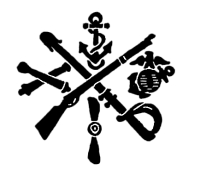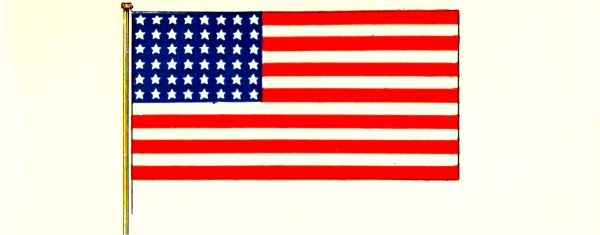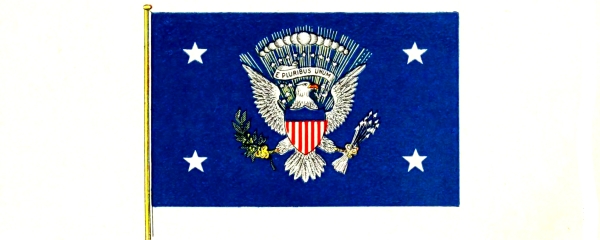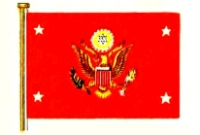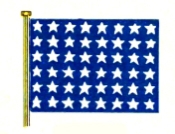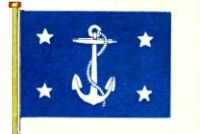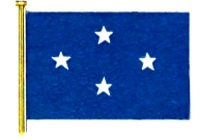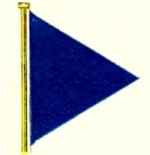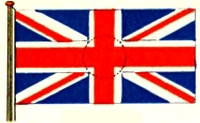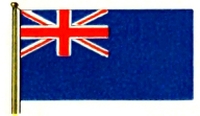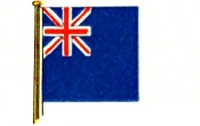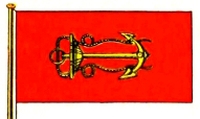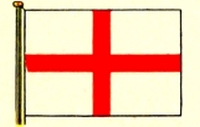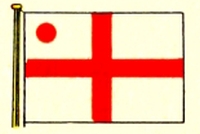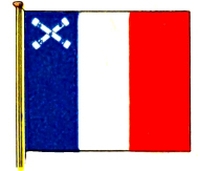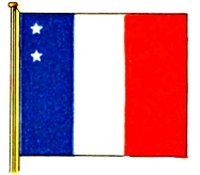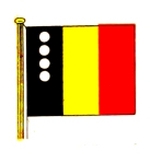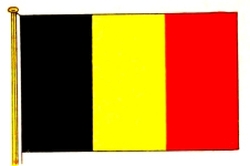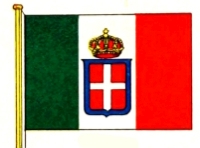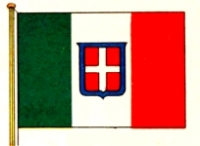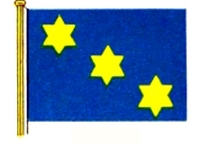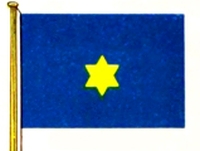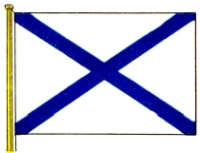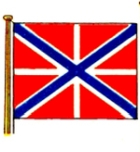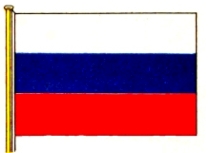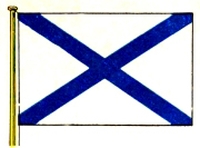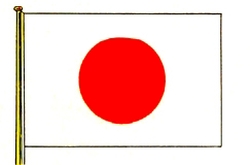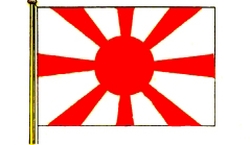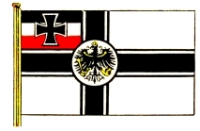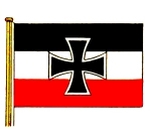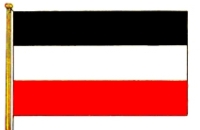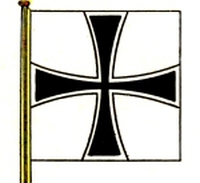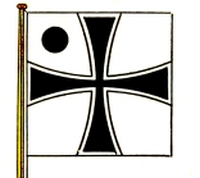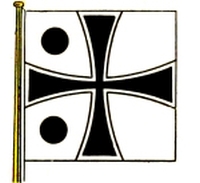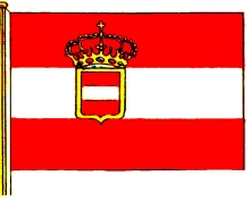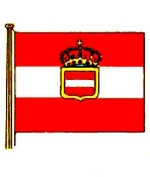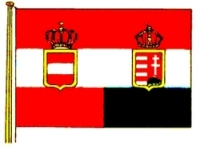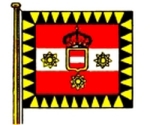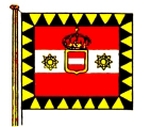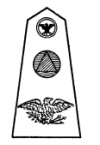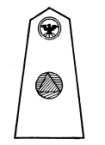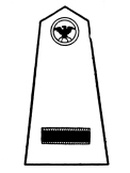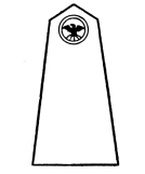Project Gutenberg's Army and Navy Uniforms and Insignia, by Dion Williams
This eBook is for the use of anyone anywhere in the United States and
most other parts of the world at no cost and with almost no restrictions
whatsoever. You may copy it, give it away or re-use it under the terms
of the Project Gutenberg License included with this eBook or online at
www.gutenberg.org. If you are not located in the United States, you'll
have to check the laws of the country where you are located before using
this ebook.
Title: Army and Navy Uniforms and Insignia
How to know Rank, Corps and Service in the Military and
Naval Forces of the United States and Foreign Countries
Author: Dion Williams
Release Date: August 12, 2020 [EBook #62909]
Language: English
Character set encoding: UTF-8
*** START OF THIS PROJECT GUTENBERG EBOOK ARMY AND NAVY UNIFORMS ***
Produced by deaurider, Paul Marshall and the Online
Distributed Proofreading Team at https://www.pgdp.net (This
file was produced from images generously made available
by The Internet Archive and HathiTrust Digital Library.)

Photograph by Zumbrun, Peking, China
International group of Army, Navy and Marine officers
in full dress uniform.
The nations represented are the United States, Great Britain, France,
Belgium, Italy, Japan, Russia, Holland, Austria and Germany.
Army and Navy
Uniforms and Insignia
How to know Rank, Corps and Service
in the Military and Naval Forces of the
United States and Foreign Countries
By
Colonel Dion Williams
United States Marine Corps
With Eight Illustrations in Color and One Hundred
and Thirty-Eight in Black and White
Revised and Enlarged Edition
New York
Frederick A. Stokes Company
Publishers
Copyright, 1918, by
Frederick A. Stokes Company
All rights reserved
CONTENTS
| CHAPTER |
|
PAGE |
| I. |
Origin and History of Uniform |
1 |
| II. |
Service, Corps and Rank |
17 |
| III. |
Ensigns, Flags and Pennants |
53 |
| IV. |
Uniforms and Insignia of the United States Army |
64 |
| V. |
Uniforms and Insignia of the United States Navy |
108 |
| VI. |
Uniforms and Insignia of the U. S. Marine Corps |
147 |
| VII. |
Uniforms and Insignia of the U. S. Coast Guard |
170 |
| VIII. |
Uniforms and Insignia of the U. S. Lighthouse Service |
|
| |
and U. S. Coast and Geodetic Survey |
182 |
| IX. |
Uniforms and Insignia of the U. S. Public Health Service |
188 |
| X. |
Medals, Badges and Ribbons |
201 |
| XI. |
Uniforms and Insignia of Foreign Armies and Navies |
216 |
| XII. |
Uniforms and Insignia of the American Red Cross |
292 |
| XIII. |
Uniforms and Insignia of the War Workers of the |
|
| |
Young Men’s Christian Association |
303 |
| XIV. |
Customs of the Services |
306 |
| XV. |
Honors and Distinctions |
314 |
| |
Index |
325 |
ARMY AND NAVY UNIFORMS
AND INSIGNIA
[Pg 1]
CHAPTER I
ORIGIN AND HISTORY OF UNIFORM
In its military sense the word “uniform,” as a noun, is specifically
used to denote the distinctive style of dress and equipment established
by governmental regulation and worn by any naval or military
organization in order that all of the individual elements of that
organization will present a homogeneous appearance. In general all
uniforms are divided into two principal classes, dress uniforms and
undress or service uniforms, the modern field uniforms belonging to the
latter class. Dress uniforms are for use on occasions of ceremony and,
as in the case of civilian attire, they are usually more ornate and
gaudy than the working service uniforms.
The use of some form of uniform dress for fighting men both on land
and sea is common to all civilized nations and this general custom has
resulted from a gradual growth during the whole Christian era. In this
growth military necessity, convenience, economical considerations and
sentiment have all played a part.
The famed Legions of Cæsar were by imperial order all garbed and armed
alike, which is one of the first recorded cases of the use of a uniform
for soldiers. Some of the regiments of Hannibal also wore distinctive
[Pg 2]
colors practically amounting to a uniform. The galley slaves of ancient
Rome, the “motive power” of the man-of-war of that day, were all garbed
in a costume of identical cut and color bearing the number of the
galley in which they served, but this should be looked upon more as a
badge of servitude than as a naval uniform.
As time went by the leaders in command of the land forces perceived
the necessity for some mark or badge to designate the members of their
forces and to distinguish them from the foe. This resulted in the use
of various distinctive badges, such as plumes of a certain color to be
worn upon the helmet, initials, numbers or devices in the nature of a
coat of arms to be worn upon the front of the helmet, on the breast
plate of armor, on the tops of the shoulders or upon the shield, a
custom which still prevails in the armies of to-day.
When Gustavus Adolphus, “the Whirlwind of the North,” swept down over
Europe with his victorious army of Sweden, he marked the brigades of
his army with sashes worn diagonally across the body from one shoulder,
a distinctive color for each brigade, and as a result history records
the valorous deeds of the “Red Brigade” or the “Green Brigade” of that
wonderful army. This species of uniform survives in the General’s sash
for the dress uniforms of the present time.
Early in the seventeenth century the King of France by royal decree
established a uniform dress for his army and regulations were issued
prescribing the color and style of the various articles of dress for
officers and men and the occasions on which they were to be worn. At
that time in England various princes and lords had armed forces of
retainers and each such force was dressed and armed according to the
individual taste of its overlord.
[Pg 3]
When the Great Rebellion in England resulted in the establishment of
the Commonwealth under Cromwell as Protector in 1653, the New Model
army was established as a national force and, while this force was
clothed in the style of the day, distinctive colors were ordered so
that the whole force was uniform in appearance. The hat of the period
was the high crowned, wide brimmed felt “slouch” hat, and in its
various shapes this head dress has been retained down to the present.
First its brim was pinned up on one side by a rosette of the colors of
the government of the date, then to add to its jauntiness it was pinned
up in three places resulting in the three-cornered “cocked hat” of the
American Revolutionary period, and to-day we see it again almost in its
original form in the modern “field hat” of the United States Army and
Marine Corps, a head dress which is also worn by the British Colonial
troops from Australia, Canada and New Zealand.
The wide brimmed hat was not suitable for wear at sea as it “carried
too much sail in a gale,” and the naval officers fastened it up against
the crown on both sides and crushed the crown together in a “fore and
aft” line. In this form the erstwhile “slouch hat” now appears as the
chapeau or cocked hat worn with dress uniforms by the officers of all
modern navies and by the general officers of the United States Army
with full dress uniform.
Cords of various colors were worn around the base of the crown of the
“slouch hat” when it was first adopted, and for ornamentation these
cords had tassels at the ends, while the different colors of the hat
cords indicated the regiment, corps or service of the wearer. These
[Pg 4]
cords in various colors, depending upon the service or corps of the
wearer, are now worn on the field hats of officers and men in the
United States Army and Marine Corps, as described later in this book,
and the tradition of the hat cord tassels is still kept in the cocked
hat of the naval officer by the gold bullion tassels at the front and
rear peaks. Likewise the influence of the original loop strap and
button for fastening up the brim of the original “slouch hat” is seen
in the United States naval officer’s cocked hat in the shape of the
gold lace strap and gilt button on the side of the crown.
When the Restoration in England brought Charles II to the throne in
1660 a royal army was organized in England, this action being due to
the fact that the success of the revolutionists under Cromwell had
proved the unreliability of the previous system. The standard colors
chosen by the king for his soldiers were red and blue, the colors
of the royal livery, and these colors survive to-day in the British
infantry full dress uniforms of red with blue facings.
As time went by various regiments of foot and horse were raised, the
men from any given regiment coming as a rule from one locality or
county. The officers of these troops were practically all drawn from
the nobility and upper classes, and it became common for the colonelcy
to be conferred upon the head of the local noble house. These colonels
chose many slight variations in uniform for their men in accordance
with their tastes in dress and style, in deference to some local habits
of dress or as might be limited by the length of their purse.
These regiments came to be known by the name of the county or city from
which they were recruited; a custom which still prevails in the British
service, and which to a great extent has been followed in the army of
[Pg 5]
the United States, especially with the volunteers of our former wars.
In England this brought about a condition as to uniform that was
apparently directly the opposite of uniform, as each territorial
regiment had its own distinctive dress and decorations. Gradually,
however, with the consolidation of all of the armed forces of the
United Kingdom into one national army, the regulars forming the first
line and the militia or “Territorials” forming the second line, or
reserve, a universal service uniform was adopted for active service and
came to be known as a “field” uniform. The older distinctive colors and
styles of regimental uniforms were preserved in the full dress uniforms
and reserved for peace time parade.
As a result of the use of heraldic devices for badges of the different
regiments and corps under the old territorial system, each regiment
has its own coat of arms, and in the later national army of Great
Britain these were retained as “regimental badges.” These badges bear
the coat of arms of some great colonel of the regiment, the name and
date of some famous victory in which the regiment won renown, or some
distinctive device appropriate to the county or colony from which the
men of the regiment are recruited.
Such regimental badges, founded largely upon sentiment but still
appealing mightily to the imagination of the young recruit that joins
the colors with the high heart of youth, are a great aid to discipline
and efficiency, since discipline means the implicit obedience on the
part of every one in the service to the orders from higher authority in
such a manner as to secure the greatest cohesion and coordination and
hence the greatest effect. These little metal badges bearing the symbols
[Pg 6]
and mottoes that bring daily to the minds of their wearers the valorous
deeds that their regiment has done in the past arouse the spirit of
emulation and competition, the desire to fight as well or better than
the old regiment fought on some other bloody field perhaps a century
ago, and help to create esprit de corps—the soul of an army.
In the United States services there are also distinctive regimental and
corps devices which, while indicating the branch and corps to which the
wearer belongs, also keep alive the glorious traditions of the past wars.
As France was the first country of modern times to establish by
governmental regulation and order a uniform dress for her armed forces
on shore, so has she been the most consistent of all countries in
dressing all branches of her service on much the same color scheme,
though here as in the other countries is sometimes seen the influence
of the native dress of the lands into which the French have extended
their colonial activities.
Until quite recently the common uniform of the French army consisted
of red trousers or breeches, blue coats and red caps. From the Barbary
coast of North Africa and especially the French colony of Algeria the
French colonial troops derived the style of dress known as “Zouave”
uniform, with baggy trousers, short braid decorated jacket and
tasselled turban. But even in these uniforms the general color scheme
of red trousers and blue coat with red head dress was carried out.
In the United States the influence of the Zouave uniform can be traced
to the same style of dress used by certain regiments of our great Civil
War of 1860-65. Notable among these regiments were the “Louisiana
[Pg 7]
Tigers” of the Confederate Army and the “Zouave Division” of the Union Army.
In the uniforms of Germany the influence of the many individual states
and principalities which went to form the greater Germany of to-day
is seen in the colors and styles of the various regiments. The dress
uniforms of the German Army still retain some of the distinctive
colors of the original armies of Prussia, Bavaria, Saxony, Wurttemburg
and Brandenburg, but for field service in war the whole army has a
uniform of dull gray color, the various territorial distinctions being
indicated by colored stripes and straps only.
The Italian troops have a number of distinctive uniforms for different
corps and services, but the universal full dress coat is of a dark
blue shade, the color of the trousers varying with the corps, and the
different colors are used as cuffs and facings to distinguish different
branches. Their field uniform is almost universally of a gray shade,
though the influence of the prevailing background upon the color of
uniform is seen in the white uniforms worn by the troops that must
fight in the snow covered mountains of the northern frontier, and the
use of khaki is becoming more common.
In Austria-Hungary the effect of the many different peoples that go
to make up that empire has resulted in a great variety of colors and
styles for uniforms, almost every color and shade being shown in the
dress uniforms of the different corps. But for the field uniforms
necessity has again ruled and dull shades of gray and green predominate.
Up to 1866 the Austrian regiments wore a great deal of white in their
uniforms, while the picturesque dress of the Hungarian civil population
[Pg 8]
was reflected in the gaudy uniforms of the Hussars, a style copied into
all of the cavalry troops of Europe to a greater or lesser extent.
In Russia there is a great variety in full dress uniforms, and the
effect of the long coat and turban of the Cossack on one hand and
the bright plumes and short jackets of the Central European cavalry
on the other is traceable. For field service uniforms dull shades of
gray-green have become almost universal, and the cold of the long
winters has naturally resulted in the use of long and heavy overcoats.
The Russian soldiers all wear top boots instead of the low topped
laced shoes common for foot troops in the armies of France, England
and America. In this respect the Germans follow the same custom as the
Russians.
The uniforms of the United States Army and Marine Corps have resulted
from an adoption of the styles of the older nations with such
modifications as were from time to time dictated by local conditions
or national sentiment. Before the Revolution of 1776 the colonial
troops naturally followed the example of the British expeditionary
troops serving in the Thirteen Colonies, with modifications to suit
the climate and the nature of the country occupied. During the War of
the Revolution the effect of the alliance with France was seen in the
adoption of certain features of the French uniform, and the service
of the Prussian generals Von Steuben and De Kalb also resulted in the
adoption of certain features of the Prussian armies of that date.
After the establishment of the United States Government the wars with
the Indians caused changes in the uniform of some of the troops by the
adoption of some of the articles of the frontiersman’s dress, such as
deer-skin jackets, coonskin caps and powder horns.
[Pg 9]
The original idea of the founders of the country was to have every
able-bodied man receive some training as a soldier, and from this
came the militia of early days and the volunteers that fought the War
of 1812. The militia of the different States and territories were
uniformed largely by each State or territory designating its own style
of military dress copied from the different armies abroad and with
trimmings and colors to distinguish the different arms of the service.
The establishment of a small regular army after the War of 1812 brought
with it a government regulation uniform for regular troops, which
was in turn followed to some extent by the state troops or militia,
but there were still many different styles of uniform in use through
the Mexican War and up to the breaking out of the Civil War in 1860.
Different units of the forces came to be known by the colors of their
uniforms, such as the “Richmond Blues,” the “Red Zouaves,” the “Blue
Zouaves,” the “Grays,” and many crack regiments of the militia, or as
it came to be known later, the National Guard of the different States,
had their own distinctive color and cut of uniform dress.
The great Civil War called such large bodies of men to the colors of
the two contending sides that the question of economy demanded that the
service uniforms for each side be made of one standard color and style,
the armies of the North wearing blue and those of the South wearing
gray. In each army, however, the different corps were distinguished
by a distinctive color for the trimmings or “facings,” a custom which
still prevails for the dress uniforms of our troops.
After the war with Spain in 1898 steps were taken to bring the uniforms
of the several State National Guards into general conformity with that
[Pg 10]
of the Regular Army, and, with the granting of national financial aid
to these state troops and the issue to them of government regulation
clothing and equipment, all of the armed forces of the country,
regular, state and volunteer, gradually came to wear the same uniform,
the different kinds of troops being distinguished by the design of the
buttons or by letters worn on the collars.
In one feature the United States troops of to-day, both in the Army and
the Marine Corps, still retain a relic of the “stock” of former times;
this is the close fitting, standing collar of the coats for both full
dress and service uniforms. The original idea of the stock was to make
the soldier hold his head up and stand stiffly erect, and it dates from
the time when Frederick the Great introduced mathematical precision
into every motion of drill and maneuver.
In the early days when the marines wore a leather stock the sailor in
his wide collared shirt dubbed the marine a “leatherneck,” a term still
applied to him in the slang phrase of the service.
Military necessity has often dictated the color of the clothing worn by
troops in the field. An early example of this was the adoption in 1755
of a dark green uniform by the British Royal American Regiment while
fighting against the French and Indians in the forest covered country
in the northwest of the original American colonies. The North American
Indian was an adept at “bush-whacking” and concealment in the forest,
and to meet him on anything like an equal footing it was necessary
for the British and colonial troops to wear a color suited to the
prevailing background. In later years this regiment’s name was changed
to “King’s Royal Rifles” and as an heirloom of its first service the
[Pg 11]
rifle regiments of the British Army still wear green coats for their
full dress uniform.
In the days when smooth-bore muskets were the arms of infantry,
the range of such weapons was very short and the opposing battle
lines approached each other so closely that the figures of the men
were plainly visible whatever the color of their clothing might be.
Histories of the wars of a century ago tell of the colonels’ commands
to “wait till you see the whites of their eyes before you fire” and
“hold your fire until you can count their coat buttons.”
Under such circumstances striking and distinctive uniforms of gaudy
colors bedecked with gold and silver braid and bright buttons were no
detriment, but with the great increase in the range and accuracy of
modern rifles it has become necessary to render the men on the battle
line as inconspicuous as possible, and, as a result, in all of the
great armies of the world dull colored uniforms of neutral shade have
replaced the brilliant reds, blues, yellows and greens of former times,
and brass buttons have given way to buttons of bronze, leather or iron,
the bright hued uniforms with their corresponding brass buttons and
braid being kept for full dress and peace time parade.
In the United States Army and Marine Corps the prevalent color for
the field service uniforms is some shade of the dull brown commonly
known as “khaki,” and the bright gilt and silver buttons, corps and
regimental devices and numbers and belt buckles have been replaced to a
great extent by dull bronze buttons and ornaments, insignia of rank for
officers only being still made of silver and gold.
[Pg 12]
“Khaki” (pronounced kar-key, with the accent on the second syllable)
is an East Indian word meaning “dust color” or “earth color.” In the
dry season in India the fields and vegetation turn brown and the roads
are heavy with dust which, carried by the winds, soon covers the
foliage of trees and shrubbery, so that the whole landscape presents a
somber aspect in one brown, dust-colored hue.
In the earlier days of the British occupation of India the British
and loyal Indian troops wore white cotton or duck uniforms in the hot
weather of the dry season, but these stood out so plainly against
the prevailing dust color of the roads and surrounding country as to
make their wearers distinct targets for the bush-whacking snipers of
the enemy tribesmen. Learning from bitter experience the necessity
for making themselves less conspicuous, the soldiers dipped their
uniforms in muddy pools and streams to give them the same color as the
background against which they must appear.
This expedient showed good results in reducing the casualty lists, and
dust-colored or “khaki” uniforms gradually replaced the white uniforms
with bright colored trimmings for summer service, and later for the
same reasons the same or a similar color was also adopted for the
winter field or “fighting” uniforms of the British Army.
Grim necessity gradually overcame the natural conservatism of the
military mind and the sentimental traditions that hung around the
colors of the uniforms that the troops had worn in famous campaigns,
until all of the great nations have now adopted “khaki” or other
dull colored uniforms for their troops in the field. This has taken
away from the battlefield much of its former picturesqueness and pomp;
gone from the battlefield is the “thin red line” of English poetry and
[Pg 13]
song, the red and blue of the French infantry, the gray and white of
the Austrians, and the blue, white and gold of the German Uhlans, while
the “American Boys in Blue” no longer charge with bayonets glittering
in the sun beneath the Stars and Stripes. To paraphrase a well-known
quotation, “It is not magnificent but it is war.”
In the naval services of the world the adoption of a regulation uniform
dress for officers and enlisted men came at a much later date than in
the armies, although the marines, being essentially “sea soldiers,”
followed the uniform regulations of the shore forces to a great extent
and were put in uniform much earlier than the sailors of the ships’ crews.
In the British Navy of Nelson’s time the officers wore uniforms
following certain prescribed styles, and the rank of the officer was
marked by insignia upon the epaulets and by sleeve and cuff decorations
as well, but the sailors who set and worked the sails and manned the
guns had no prescribed dress. It was the custom of those days for each
commodore and captain to prescribe a uniform dress for the crew of his
“barge” or “gig” (the “barge” being the special small boat propelled
by oars in which the admiral or commodore went from ship to shore and
vice versa, and the “gig” being the name for a similar boat used
especially by the captain of the ship).
These uniforms for the special boats’ crews were often fanciful in
design and gay in color schemes and served to enliven the landing
places at many a busy port.
During the Revolution the ships of the American Navy consisted at first
of merchantmen armed with a few guns and manned by the hardy seamen of
the merchant marine of the colonies. Later men-of-war were especially
[Pg 14]
built for that service and manned by duly commissioned officers and men
enlisted into the government service, but the British Navy was so large
that the colonials could make no headway against its strong fleets,
and a cruising and raiding warfare was resorted to for the purpose of
destroying as much British merchant shipping as possible. This warfare
was carried on principally by privateers, merchantmen armed and heavily
manned for the purpose and in some cases fast ships especially built
for such service. These privateers were officered by the splendid sea
captains of that date who were granted “letters of marque” by the
Colonial Government to carry the flag and prey upon the commerce of
the enemy, dividing the profits derived from the captured cargoes in
fixed proportion between the owners and crew of the privateers and the
Government.
Under such conditions there was no fixed uniform, and though the
officers frequently provided themselves with a dress patterned after
that of the French Navy with which they were allied, the men wore any
kind of clothing suited to their fancy.
After the Revolution the standing or regular army went out of
existence, but it soon became necessary to establish a regular navy
which consisted of a few fast, heavily gunned sailing frigates of the
type of the Constitution, Constellation and Chesapeake.
When the War of 1812 came on it was this small but remarkably efficient regular
navy that alone saved the United States from disaster and dishonor.
By 1812 a regulation uniform had been prescribed for the officers of
the Navy, but the men were still allowed to wear any kind of clothing
suited to their work. Long cruises in distant seas made it necessary,
however, for a supply of clothing for the members of the crew to be
[Pg 15]
carried by the purser (the paymaster of that day), and as a measure of
economy and convenience these clothes were all made in the same style,
a custom which gradually brought about a certain uniformity in the garb
of the enlisted personnel of the Navy.
Thus it came about that the accepted sailor uniform consisted of easy
fitting garments suited to the work of hauling on the ropes, working
aloft on the rigging, masts and spars of the sailing ships and pulling
at the oars of the small boats. From this beginning came the sailor
uniform of to-day, the bell-mouthed trousers that could be rolled up
quickly and easily when the barefooted sailors washed down the decks,
the easy-fitting, loose-necked shirt or “jumper,” the short overcoat
or “peacoat” for winter wear, and the loose-topped, brimless cap which
to give it a smarter appearance when going ashore “on liberty” (the
sailor term for leave of absence) was provided with a light ring or
“grommet” to stretch the crown out flat, resulting in the common sailor
“flat-hat” of to-day.
This sailor uniform was originally designed for wear aboard ships
driven by sail-power, and though it is not especially suited to
the great steam-driven dreadnaughts of the modern navy it is still
retained, partly on account of sentiment and tradition and partly on
account of the fact that the Navy is probably more conservative than
any other profession or calling.
The uniforms of both officers and enlisted men in the United States
Navy follow rather closely in style, color and cut those worn in the
British Navy, and some interesting traditions of the latter service may
be seen even in our naval service. For instance, the black neckerchief
worn alike by the British and American sailor was made black after
Trafalgar as an emblem of mourning for the Great Nelson, and the three
[Pg 16]
white stripes around the edges of the collar were so placed to commemorate
Nelson’s three great victories, Copenhagen, the Nile and Trafalgar.
In all countries naval uniforms follow much the same patterns and
practically all are of the same colors; dark blue, the so-called “navy
blue,” for winter wear, and white for summer wear.
The need of an inconspicuous uniform for naval officers and men is
not so apparent as it is in the case of the land forces, since in the
battles of ships at sea it is the ship which is the target and not the
personnel as in the battles on land.
Thus we see how tradition, sentiment and military necessity have each
played a part in the development of the uniforms worn by the fighting
forces of our country on land and sea.
[Pg 17]
CHAPTER II
SERVICE, CORPS AND RANK
The armed forces of the United States of America provided by
the statute law of the land pursuant to the provisions of the
Constitution are embraced within two grand divisions, the land forces
and the sea forces, under the supreme command of the President as
Commander-in-Chief.
These two grand divisions are subdivided into various services
according to the duties required of them and the laws establishing and
maintaining them.
The Land Forces.—The land forces of the United States are made up
of the regular army or as it is sometimes called the “standing army,”
the organized land militia when called into the service of the United
States which is practically the same as the so-called national guards
of the several states, and such volunteers and drafted men as may be
authorized by the Congress from time to time as occasion demands.
In times of peace the Army consists of the regular army, but in case
of an invasion or threatened invasion of the territory of the United
States or of rebellion or threatened war against the constituted
government of the nation, this force may be augmented by calling the
organized militia into service and further augmented if necessary by
the employment of volunteers or drafted men, with the authorization of
the Congress.
[Pg 18]
The land forces, however raised, are also divided into the Mobile
Army and the Coast Artillery. The mobile army is intended for active
offensive operations against the enemy and is so called on account
of the fact that for its duties it requires the greatest degree of
mobility possible, while the coast artillery is intended to man and
fight the fixed and movable elements of land and coast fortifications
including land mines, submarine mines and torpedo defenses pertaining
to the fortifications.
These two groups frequently assist each other, the mobile forces
protecting the flanks and approaches to the fixed defenses, and the
latter being used as turning points or supporting points to the lines
of the mobile forces.
The Army is divided into various arms or corps according to the duties
required, as follows: infantry, cavalry, field artillery, coast
artillery corps, engineer corps, signal corps including aviation
section, quartermaster corps, ordnance corps, judge advocate’s corps,
inspector general’s corps and medical corps. Each of these arms
or corps has a distinctive badge to be worn on all uniforms and a
distinctive color for the facings and trimmings of dress uniforms, as
described and illustrated in Chapter IV.
For purposes of administration and control under war conditions the
mobile land forces are organized into Field Armies, the basis of the
organization being the Division. The division as prescribed in the
United States Army is an organization containing all of the arms and
services necessary for independent action.
A field army may be divided into army corps, each such being composed
of two or more divisions.
Divisions are subdivided into brigades, which are in turn subdivided
into regiments. A regiment of infantry is usually composed of three
[Pg 19]
battalions of four companies each; a regiment of cavalry of three
squadrons of four troops each; and a regiment of field artillery of two
battalions of three batteries each. Engineers are formed into regiments
according to the special requirements of their duties. The Coast
Artillery is organized into companies, the number of companies in any
one command depending upon the size of the forts to be garrisoned.
Signal Corps troops are organized into companies and larger
organizations according to the duties assigned to them.
The Quartermaster Corps is charged with providing the supplies required
and with the transportation of both men and supplies.
The Medical Corps has charge of the hospitals and the personnel
required by them both at the permanent stations and in the field, and
for this purpose the corps is organized into ambulance companies and
field hospitals.
Chaplains are assigned to regiments and other organizations as
may be required.
Veterinarians, who are commissioned officers, are assigned to the
cavalry, field artillery and quartermaster transport trains, and
also have charge of such veterinary hospitals as may be required at
permanent posts or in the field.
The command of the Army is exercised by the President as
Commander-in-Chief through the medium of the Secretary of War and the
Chief of Staff, the latter officer having the rank of General and
taking the place of the former Commanding General of the Army.
The General Staff Corps of the Army, consisting of commissioned
officers detailed from the various branches of the Army for a term of
[Pg 20]
four years’ service, is charged with the duties of effecting under
the direction of the Chief of Staff the coordination and harmonious
cooperation of all branches of the military service, both line and
staff, in the execution of the military policies of the Government in
peace and war.
The administration of the Army and the War Department is effected under
the Secretary of War through the Chief of Staff by various bureaus or
offices, as follows: the Coast Artillery under a chief with the rank
of Major General; the Adjutant General’s Department under an Adjutant
General with the rank of Major General, which is the department of
records, orders and correspondence of the Army and the Militia; the
Judge Advocate General’s Department, under a Judge Advocate General
with the rank of Major General, which is the legal department of the
Army; the Inspector General’s Department under an Inspector General
with the rank of Major General; the Quartermaster Department, under a
Quartermaster General with the rank of Major General, which has charge
of supply and transportation; the Medical Department, under a Surgeon
General with the rank of Major General; the Corps of Engineers, under
a Chief of Engineers with the rank of Major General; the Ordnance
Corps, under a Chief of Ordnance with the rank of Major General; and
the Signal Corps, under a Chief Signal Officer with the rank of Major General.
The Sea Forces.—The sea forces of the United States consist of
the regular Navy, the Marine Corps, the Naval Militia of the several
States and territories when mustered into the service of the United
States, and the Coast Guard and Lighthouse Service when transferred to
the jurisdiction of the Navy Department in time of war or when war is
[Pg 21]
imminent, including in each case both the vessels and the personnel
pertaining to them, afloat and ashore. The vessels of the Coast and
Geodetic Survey and of the Bureau of Fisheries may also be transferred
to the jurisdiction of the Navy in time of war.
The vessels of the Navy are organized into fleets which are divided
for purposes of administration and tactics into forces, squadrons,
divisions, and sections.
A “Fleet” is an aggregation of vessels of various classes in one
organization under one command.
Fleets are subdivided into “Forces,” each “Force” being made up of the
vessels of a fleet that are of the same class or type that are assigned
to perform the same duty.
A “Force” is subdivided into “Squadrons,” and in turn, a “Squadron”
is subdivided into “Divisions,” and a “Division” is subdivided into
“Sections.”
A “Section” consists of two vessels of the larger classes or three
vessels of the smaller classes; a “Division” normally consists of two
“Sections,” and a “Squadron” usually consists of two “Divisions,”
although the numbers in each subdivision may be varied to suit special
occasions or duties.
A squadron of torpedo vessels is called a “Flotilla,” in deference to
long established custom.
A completely organized Fleet is composed of a Battleship Force, a Scout
Force, a Cruiser Force, a Destroyer Force, a Submarine Force, a Mine
Force and a Train Force, the latter consisting of the supply ships and
repair vessels and transports and being usually referred to as the “Train.”
The Navy is administered ashore by a bureau system, consisting of a
number of bureaus and offices having charge of the various activities
required for the building and upkeep of the fleets at sea, and all
[Pg 22]
directed by the Secretary of the Navy through the Office of Naval
Operations, the Chief of Naval Operations with the rank of Admiral
being the senior or ranking officer of the Navy.
The bureaus are the Bureau of Navigation, whose Chief has the rank of
Rear Admiral, and which has charge of the issuing and enforcing of
orders to officers and enlisted men and the keeping of the records; the
Bureau of Ordnance, whose Chief has the rank of Rear Admiral, and which
has charge of the design, manufacture and repair of guns, torpedoes and
ammunition; the Bureau of Construction and Repair, whose head is the
Chief Constructor of the Navy and has the rank of Rear Admiral, and
which has charge of the designing, construction and repair of all of
the vessels of the Navy; the Bureau of Steam Engineering, whose head
is the Engineer in Chief of the Navy, with the rank of Rear Admiral,
and which has charge of the designing, construction and repair of the
engines and boilers in the ships of the Navy; a Bureau of Supplies and
Accounts, whose head is the Paymaster General of the Navy, with the
rank of Rear Admiral, and which has charge of the purchase and issue
of supplies and provisions for the Navy and the paying of the officers
and enlisted men; the Bureau of Medicine and Surgery, whose head is the
Surgeon General of the Navy, with the rank of Rear Admiral, and which
has charge of the hospitals ashore, the hospital ships, and the health
and sanitation of the Navy both afloat and ashore; the Bureau of Yards
and Docks, whose Chief has the rank of Rear Admiral, and which has
charge of the designing and construction and repair of the buildings
and docks at the shore establishments of the Navy; and the Office of
the Judge Advocate General, whose head is the Judge Advocate General of
[Pg 23]
the Navy with the rank of Captain, and which has charge of the
courts-martial and legal affairs of the Navy.
For purposes of command and organization afloat and ashore the officers
of the Navy are divided into the “Line,” composed of the officers
holding the military command in the various ranks, and of a number of
“Staff Corps,” composed of officers who have charge of the various
coordinate duties.
These “Staff Corps” are the Medical Corps, the Pay Corps, the
Chaplains, the Corps of Naval Constructors, the Corps of Civil
Engineers and the Professors of Mathematics. Prior to 1899 there was
also a separate Corps of Engineers, but in that year this corps was
consolidated with the Line and since that time the only officers
holding the ranks of Chief Engineer, Passed Assistant Engineer and
Assistant Engineer in the Navy are officers of the old Engineer Corps
who are now carried on the Retired List of Officers.
The Marine Corps.—The Marine Corps is a distinct military
organization normally forming an integral part of the Navy, but when
the President so orders any portion of the corps may be detached for
service with the Army, and in every war in which the United States has
been engaged the marines have fought as a part of the crews of the
fighting ships of the Navy, as landing forces and expeditionary forces
with the Navy and also on detached service with the Army.
The Marine Corps is commanded by a Major General Commandant whose
station is at Headquarters of the Corps in Washington, and who
is assisted by a staff consisting of an Adjutant and Inspector’s
Department, a Quartermaster’s Department and a Paymaster’s Department,
each headed by a Brigadier General.
[Pg 24]
The officers of the Adjutant and Inspector’s Department perform the
duties that are performed in the Army by the Departments of the
Adjutant General and the Inspector General; the Quartermaster’s
Department has charge of the supplies, provisions, transportation
and the construction and maintenance of barracks and buildings; and
the Paymaster’s Department has charge of the accounts and pay of the
officers and enlisted men of the Corps.
Detachments of the marines are stationed at all of the Navy Yards and
Naval Stations of the United States both at home and abroad, and they
also serve as Legation Guards for American Legations in countries
where such guards are considered necessary, as expeditionary forces
with the Fleet and for the protection of Americans and their rights
in foreign countries during revolutions and disorders, on detached
duty with the Army as circumstances require in time of war, and aboard
the battleships and cruisers of the Navy as a part of the crew, their
special duties aboard ship being as crews for the Torpedo Defense
batteries of guns of intermediate caliber and rapid-fire guns.
The Marines of a Fleet are organized into a regiment for duty as
a landing force, the detachment from each ship forming one of the
companies, and the Colonel commanding the regiment serves on the Staff
of the Admiral in command of the Fleet.
When assigned to shore duty the Marines are organized into permanent
companies, these companies being combined into provisional battalions,
regiments and brigades according to the service or duty required.
The Marine Detachment or company serving on board a ship of the Navy
is paraded as the guard of honor when such a guard is turned out to
[Pg 25]
receive the President, the ruler of any foreign country, or any lesser
officer or official entitled to such honors.
The Coast Guard.—The Coast Guard was established by act of Congress
in January, 1915, which provided that the then existing Revenue-Cutter
Service and Life-Saving Service should be combined into one service
to be known as the Coast Guard, which shall constitute a part of the
military forces of the United States and which shall operate under the
Treasury Department in time of peace and operate as a part of the Navy,
subject to the orders of the Navy Department, in time of war, or at
other times when the President shall so direct.
In time of peace the Coast Guard is charged with the enforcement of
the revenue laws as applying to sea-borne commerce, with giving aid to
vessels in distress at sea, with the protection of the seal fisheries,
and with maintaining and operating the life-saving stations along the
coasts of the United States and its insular possessions. In time of war
or when so directed by the President it acts as a part of the Navy,
and the ships and personnel of the service become to all intents and
purposes a portion of the regular navy.
The Lighthouse Service.—This service is charged with the duties
of establishing and maintaining the lighthouses and other aids to
navigation, such as buoys and beacons and range marks on shore, that
are required for the safe navigation of the waters adjacent to our
coasts, the harbors and the channels leading to them, and the inland
waterways.
In normal times the Lighthouse Service is operated under the Department
of Commerce, but by act of Congress of August, 1916, the President is
authorized to transfer the stations, vessels, equipment and personnel
[Pg 26]
of the service, as may be required, to the jurisdiction of the Navy
Department or to that of the War Department.
When so transferred to the Navy Department or to the War Department,
the Lighthouse Service becomes for the time being a portion of the
Navy or of the Army, as the case may be, and its officers and men are
subject to the laws and regulations of the service to which it is so
transferred.
The Coast and Geodetic Survey.—This branch of the government service
is charged with surveying the harbors and waters contiguous to the
coasts of the United States and the insular possessions thereof and the
lakes and inland waterways contained therein, and with making charts
from such surveys for use in navigation.
The service is under the jurisdiction of the Department of Commerce,
but in time of war its vessels may be transferred to the Navy
Department and their crews taken into the naval service, in which case
they become subject to the laws and regulations of the Navy.
Rank, Title and Precedence
Rank in its military sense is the character or quality bestowed upon
the men of the military and naval services which carries with it the
eligibility to exercise command or authority over other members of the
services within the limits prescribed by law and regulation. Rank is
divided into many different grades to mark the relative positions of
the persons upon whom it is conferred and to limit the extent of the
authority carried with it.
In all of the services of the United States, “Commissioned Officers”
are those who have received a commission from the President “by and
[Pg 27]
with the advice and consent of the Senate of the United States”; and
“Appointed Officers” are those who are appointed by the President or by
his order but who are not “commissioned” and confirmed by the Senate.
In the Army the “Appointed Officers” are Aviators, Army Field Clerks,
Field Clerks Quartermaster Corps, and Cadets at the Military Academy.
In the Navy the “Appointed Officers” are Warrant Officers and
Midshipmen.
In the Marine Corps the “Appointed Officers” are Warrant Officers.
In the Army and Marine Corps “Noncommissioned Officers” are selected
enlisted men who are appointed to the various ranks of enlisted
authority by orders from their proper military commanders.
“Petty Officers” in the Navy are appointed enlisted men corresponding
to noncommissioned officers in the Army and Marine Corps.
The “Title” of an officer is the name of the rank or grade in which he
holds a commission, the formal term by which he is officially addressed
in communicating with him, although custom sanctions some variations
from this general rule.
In the Army and the Marine Corps all commissioned officers, line and
staff, have positive rank in the several grades, and it is customary
to address them when communicating orally with them by the name of
the rank they hold, the variations being that all General Officers
(Generals, Lieutenant Generals, Major Generals and Brigadier Generals)
are commonly addressed as “General,” that Lieutenant Colonels are
addressed as “Colonel,” and that all subalterns (First Lieutenants and
Second Lieutenants) are addressed as either “Lieutenant” or as “Mister.”
[Pg 28]
In the Navy it is customary to address officers of the Line (the
command branch of the service) by the name of their rank, and to
address officers of the Staff Corps either by the name of their rank
or as “Mister,” for all except officers of the Medical Corps, who are
usually addressed as “Doctor.” The exceptions to this rule are that
all Flag Officers (Admirals, Vice Admirals and Rear Admirals) are
usually addressed orally as “Admiral,” and that Lieutenant Commanders,
Lieutenants and Ensigns are often addressed as “Mister.”
It is customary to address the Warrant Officers of the Navy and Marine
Corps as “Mister.”
The precedence of the commissioned officers and other officers of the
Army, Navy and Marine Corps is determined first by the grade or rank
which the officers hold by virtue of their commissions or appointments,
and if of the same grade or rank, then by the date of commission or
appointment in the grade. There are certain exceptions to this latter
rule in the case of some grades in the Staff Corps of the Navy.
The precedence of the warrant officers, noncommissioned officers
and petty officers of all the services is determined upon the same
principle, the seniority of the different grades and the relative
seniority of the grades in different services being determined by
regulations and orders, and the precedence in each grade being
determined by the dates of the warrants or appointments.
The accompanying table shows the rank and title of each grade in the
Army, Navy, Marine Corps and Coast Guard, all of the grades having the
same relative rank being on the same horizontal line.
[Pg 29]
TABLE OF RELATIVE RANK OF OFFICERS IN THE NAVAL
AND MILITARY SERVICES OF THE UNITED STATES
| |
| COMMISSIONED OFFICERS |
| Army |
Navy |
Marine Corps |
Coast Guard |
Public Health Service |
| None |
Admiral of the Navy |
None |
None |
None |
| General |
Admiral |
None |
None |
None |
| Lieutenant General |
Vice Admiral |
None |
None |
None |
| Major General |
Rear Admiral |
Major General |
None |
None |
| Brigadier General[A] |
Commodore |
Brigadier General |
None |
Surgeon General |
| Colonel |
Captain |
Colonel |
Captain Commandant |
Assistant Surgeon
General |
| Lieutenant Colonel |
Commander |
Lieutenant Colonel |
Senior Captain |
Senior Surgeon |
| Major |
Lieutenant Commander |
Major |
Captain |
Surgeon Passed
Assistant |
| Captain |
Lieutenant |
Captain |
First Lieutenant |
Surgeon |
| First Lieutenant |
Lieutenant,
Junior Grade |
First Lieutenant |
Second Lieutenant |
Surgeon |
| Second Lieutenant |
Ensign |
Second Lieutenant |
Third Lieutenant |
None |
| |
Chief Boatswain,
Chief Gunner,
Chief Machinist,
Chief Carpenter,
Chief Sailmaker,
Chief Pharmacist,
Chief Pay Clerk |
|
|
|
| APPOINTED OFFICERS |
Aviator,
Signal Corps Cadet
at the Academy,
West Point |
Midshipman at the
Naval Academy,
Annapolis, Md. |
None |
Cadet and Cadet Engineer
at the Coast Guard
Academy,
New London, Conn. |
|
| WARRANT OFFICERS |
Army Field Clerk
Field Clerk
Quartermaster
Corps. |
Boatswain,
Gunner,
Machinist,
Carpenter,
Sailmaker,
Pharmacist,
Pay Clerk,
Mate |
Marine Gunner
Quartermaster
Clerk |
Boatswain,
Gunner,
Machinist,
Carpenter,
Keeper,
Master’s Mate |
Interne
Pharmacist
Clerk |
| |
[Pg 30]
The personnel of the Army, as provided by statute law, consists of
commissioned officers, appointed officers, noncommissioned officers and
privates as follows, according to grade or rank:
Officers
- COMMISSIONED OFFICERS
- 1. General.
- 2. Lieutenant General.
- 3. Major General.
- 4. Brigadier General.
- 5. Colonel.
- 6. Lieutenant Colonel.
- 7. Major.
- 8. Captain.
- 9. First Lieutenant.
- 10. Second Lieutenant.
-
- APPOINTED OFFICERS
- 11. Aviator, Signal Corps.
- 12. Cadet.
- 13. Field Clerk, Field Clerk Quartermaster Corps.
Enlisted Men
NONCOMMISSIONED OFFICERS AND PRIVATES
14. (a) Sergeant major, regimental; sergeant major, senior grade,
Coast Artillery Corps; (b) quartermaster sergeant, senior grade,
Quartermaster Corps; master hospital sergeant, Medical Department;
master engineer, senior grade, Corps of Engineers; master electrician,
Coast Artillery Corps; master signal electrician; band leader; (c)
hospital sergeant, Medical Department; master engineer, junior
grade, Corps of Engineers; engineer, Coast Artillery Corps.
[Pg 31]
15. Ordnance sergeant; quartermaster sergeant, Quartermaster Corps;
supply sergeant, regimental.
16. Sergeant major, squadron and
battalion; sergeant major, junior grade, Coast Artillery Corps; supply
sergeant, battalion.
17. (a) First sergeant; (b) sergeant, first class, Medical Department;
sergeant, first class, Quartermaster Corps; sergeant, first class,
Corps of Engineers; sergeant, first class, Signal Corps; electrician
sergeant, first class, Coast Artillery Corps; electrician sergeant,
Artillery Detachment, United States Military Academy; assistant
engineer, Coast Artillery Corps; (c) master gunner, Coast Artillery
Corps; master gunner, Artillery Detachment, United States Military
Academy; band sergeant and assistant leader, United States Military
Academy Band; assistant band leader; sergeant bugler; electrician
sergeant, second class, Coast Artillery Corps; electrician sergeant,
second class, Artillery Detachment, United States Military Academy;
radio sergeant.
18. Color sergeant.
19. Sergeant; supply sergeant, company; mess sergeant; stable
sergeant; fireman, Coast Artillery Corps.
20. Corporal.
21. (a) First Class Private; (b) Private.
The personnel of the Navy, pursuant to the provisions of the statute
law, consists of commissioned officers, appointed officers, warrant
officers, petty officers and seamen, in the various grades as follows:
[Pg 32]
Officers of the Navy
- COMMISSIONED OFFICERS OF THE LINE
- 1. Admiral of the Navy.
(This rank is now vacant. By
special act of Congress it was conferred upon Admiral George Dewey on
March 2, 1899, and held by him until his death on January 16, 1917. The
rank is the same as that of Admiral of the Fleet in foreign navies and
that of Field Marshal in foreign armies.)
- 2. Admiral.
- 3. Vice Admiral.
- 4. Rear Admiral.
- 5. Commodore.
(This rank was abolished for the active
list by act of Congress on March 3, 1899, and since that date has been held
by officers of that rank on the Retired List of the Navy only.)
- 6. Captain.
- 7. Commander.
- 8. Lieutenant Commander.
- 9. Lieutenant.
- 10. Lieutenant Junior Grade.
- 11. Ensign.
- 12. Chief Boatswain.
- Chief Gunner.
- Chief Machinist.
(The commissioned officers of these three
titles are of the same grade; they rank next after ensigns.)
- COMMISSIONED OFFICERS OF THE MEDICAL CORPS
- 1. Medical Director with the rank of Rear Admiral.
- 2. Medical Director with the rank of Captain.
- 3. Medical Inspector with the rank of Commander.
- 4. Surgeon with the rank of Lieutenant Commander.
[Pg 33]
- 5. Passed Assistant Surgeon with the rank of Lieutenant Commander.
- 6. Passed Assistant Surgeon with the rank of Lieutenant.
- 7. Assistant Surgeon with the rank of Lieutenant.
- 8. Assistant Surgeon with the rank of Lieutenant, Junior Grade.
- 9. Dental Surgeon with the rank of Lieutenant, Junior Grade.
- 10. Chief Pharmacist.
- COMMISSIONED OFFICERS OF THE PAY CORPS
- 1. Pay Director with the rank of Rear Admiral.
- 2. Pay Director with the rank of Captain.
- 3. Pay Inspector with the rank of Commander.
- 4. Paymaster with the rank of Lieutenant Commander.
- 5. Passed Assistant Paymaster with the rank of Lieutenant Commander.
- 6. Passed Assistant Paymaster with the rank of Lieutenant.
- 7. Passed Assistant Paymaster with the rank of Lieutenant, Junior Grade.
- 8. Assistant Paymaster with the rank of Lieutenant, Junior Grade.
- 9. Assistant Paymaster with the rank of Ensign.
- 10. Chief Pay Clerk.
- COMMISSIONED OFFICERS OF THE CORPS OF NAVAL CONSTRUCTORS
- 1. Naval Constructor with the rank of Rear Admiral.
- 2. Naval Constructor with the rank of Captain.
[Pg 34]
- 3. Naval Constructor with the rank of Commander.
- 4. Naval Constructor with the rank of Lieutenant Commander.
- 5. Naval Constructor with the rank of Lieutenant.
- 6. Assistant Naval Constructor with the rank of Lieutenant.
- 7. Assistant Naval Constructor with the rank of Lieutenant, Junior Grade.
- 8. Chief Carpenter.
- Chief Sailmaker.
- COMMISSIONED OFFICERS OF THE CORPS OF CIVIL ENGINEERS
- 1. Civil Engineer with the rank of Rear Admiral.
- 2. Civil Engineer with the rank of Captain.
- 3. Civil Engineer with the rank of Commander.
- 4. Civil Engineer with the rank of Lieutenant Commander.
- 5. Civil Engineer with the rank of Lieutenant.
- 6. Assistant Civil Engineer with the rank of Lieutenant.
- 7. Assistant Civil Engineer with the rank of Lieutenant, Junior Grade.
- 8. Assistant Civil Engineer with the rank of Ensign.
Chaplains hold the relative rank of Captain, Commander, Lieutenant
Commander, Lieutenant or Lieutenant, Junior Grade, according to length
of service.
Professors of Mathematics hold the rank of Captain, Commander,
Lieutenant Commander or Lieutenant according to length of service. This
corps was established to provide especially trained mathematicians for
duty as astronomers at the Naval Observatories and as Instructors at
[Pg 35]
the Naval Academy, but pursuant to the act of Congress of August 29,
1916, no further officers are to be commissioned in this corps.
In the days of sailing ships officers having the title of Sailmaker
were provided for the then important work of superintending the
manufacture of sails, but since the advent of steam and electricity
this branch has been discontinued and only a few are still borne on the
official register. The commissioned officers of this branch have the
title of Chief Sailmaker and relative rank the same as that of Chief
Boatswain, Chief Gunners, Chief Machinists, Chief Carpenters, Chief Pay
Clerks and Chief Pharmacists, that is, they rank with but next after Ensigns.
MIDSHIPMEN
Midshipmen are appointed officers undergoing the course of instruction
at the Naval Academy at Annapolis, Maryland. Each senator,
representative and delegate in Congress has the appointment of three
midshipmen to be at the Naval Academy at any one time, the President is
empowered to appoint two midshipmen and the Secretary of the Navy is
empowered to appoint one hundred midshipmen each year to be selected
from enlisted men of the Navy and Marine Corps who are not over the age
of twenty years.
The Corps of Midshipmen consists of four classes, the First Class
corresponding to “seniors” at universities, the Second Class
corresponding to “juniors,” the Third Class corresponding to
“sophomores,” and the Fourth Class corresponding to “freshmen.”
The regular course of study is four years although the President was
authorized by the act of Congress of March 4, 1917, to reduce the
[Pg 36]
course to three years for a period of two years from the passage of the act,
owing to the urgent need of more officers in the Navy.
WARRANT OFFICERS
Warrant officers form an intermediate class between the commissioned
officers and the enlisted personnel. They receive appointments from
the President but are not confirmed by the Senate. They are appointed
by selection from the most efficient and deserving enlisted petty
officers. After six years’ service as warrant officers, if found
qualified, they are commissioned by the President, “by and with the
advice and consent of the Senate,” as Chief Boatswains, Chief Gunners,
Chief Machinists, Chief Carpenters, Chief Sailmakers, Chief Pharmacists
and Chief Pay Clerks, as the case may be, to take rank with but next
after Ensigns.
| The Warrant Officers of the Line are as follows: |
| |
Boatswain |
|
| |
Gunner |
|
| |
Machinist |
|
The Warrant Officers of the Staff are as follows: |
| |
Carpenter |
|
| |
Sailmaker |
|
| |
Pharmacist |
|
| |
Pay Clerk |
|
All warrant officers take rank and precedence next after commissioned
officers, their relative rank among themselves being determined by date
of appointment.
Warrant officers are eligible to be commissioned as Ensigns after
passing the prescribed examination, in which case they are advanced
to higher rank in the same manner as other Ensigns commissioned after
[Pg 37]
graduation from the Naval Academy. In this manner a young man who
proves himself worthy of the honor may rise from the lowest enlisted
grade to be an Admiral.
Enlisted Men of the Navy
The highest grade of enlisted men in the U. S. Navy is that of Mate.
Mates are rated by authority of the Secretary of the Navy from seamen
of over two years’ service. They have no relative rank, but take
precedence over all other enlisted men. They wear a uniform like that
of warrant officers with a distinctive insignia as later described.
The classes of enlisted men in the Navy corresponding to the
“noncommissioned officers” of the Army and Marine Corps are styled
“Petty Officers.”
All of the enlisted men of the Navy are divided into branches according
to their principal duties, the different grades in these several
branches being as follows:
CHIEF PETTY OFFICERS
| |
| Seaman Branch |
Artificer Branch |
Special Branch |
| Chief Master-at-Arms |
Chief Machinist’s Mate. |
Chief Yeoman. |
| Chief Boatswain’s Mate. |
Chief Electrician. |
Hospital Steward. |
| Chief Gunner’s Mate. |
Chief Carpenter’s Mate. |
Bandmaster. |
| Chief Turret Captain. |
Chief Water Tender. |
Chief Commissary Steward. |
| Chief Quartermaster. |
|
[Pg 38] |
| |
PETTY OFFICERS, FIRST CLASS
| |
| Seaman Branch |
Artificer Branch |
Special Branch |
| Master-at-Arms, first class. |
Machinist’s Mate, first class. |
First Musician. |
| Boatswain’s Mate, first class. |
Electrician, first class. |
Yeoman, first class. |
| Turret Captain, first class. |
Boilermaker. |
Commissary Steward. |
| Gunner’s Mate, first class. |
Coppersmith. |
Ship’s Cook, first class. |
| Gun Captain, first class. |
Blacksmith. |
Baker, first class. |
| Quartermaster, first class. |
Plumber and Fitter. |
|
| |
Sailmaker’s Mate. |
|
| |
Carpenter’s Mate, first class. |
|
| |
Water Tender. |
|
| |
Ship Fitter, first class. |
|
| |
Painter, first class. |
|
| |
PETTY OFFICERS, SECOND CLASS
| |
| Seaman Branch |
Artificer Branch |
Special Branch |
| Masters-at-Arms, second class. |
Machinist’s Mates, second class. |
Yeoman, second class. |
| Boatswain’s Mates, second class. |
Electricians, second class. |
Ship’s Cooks, second class. |
| Gunner’s Mates, second class. |
Carpenter’s Mates, second class. |
|
| Gun Captains, second class. |
Printers. |
|
| Quartermasters, second class. |
Oilers. |
|
| |
Ship Fitters, second class. |
|
| |
Painters, second class. |
[Pg 39] |
| |
PETTY OFFICERS, THIRD CLASS
| |
| Seaman Branch |
Artificer Branch |
Special Branch |
| Masters-at-Arms, third class. |
Electricians, third class. |
Yeoman, third class. |
| Coxswains |
Carpenter’s Mates, third class. |
Hospital Apprentices, first class. |
| Gunner’s Mates, third class. |
Painters, third class. |
|
| Quartermasters, third class. |
|
|
| |
SEAMEN, FIRST CLASS
| |
| Seaman Branch |
Artificer Branch |
Special Branch |
| Seaman Gunners. |
Firemen, first class. |
Musicians, first class. |
| Seamen. |
|
Ship’s Cooks, third class. |
| |
|
Bakers, second class. |
|
|
|
| |
SEAMEN, SECOND CLASS
| |
| Seaman Branch |
Artificer Branch |
Special Branch |
| Ordinary Seamen. |
Firemen, second class. |
Musicians, second class. |
| |
Shipwrights. |
Buglers. |
| |
|
Hospital Apprentices. |
| |
|
Ship’s Cooks, fourth class. |
| |
[Pg 40]
SEAMEN, THIRD CLASS
| |
| Seaman Branch |
Artificer Branch |
Special Branch |
| Apprentice Seamen. |
Coal Passers. |
Landsmen. |
| |
Landsmen. |
|
| |
MESSMAN BRANCH
| |
| Stewards to Commanders in Chief. |
Wardroom Cooks. |
| Cooks to Commanders in Chief. |
Steerage Stewards. |
| Stewards to Commandants. |
Steerage Cooks. |
| Cooks to Commandants. |
Warrant Officers’ Stewards. |
| Cabin Stewards. |
Warrant Officers’ Cooks. |
| Cabin Cooks. |
Mess Attendants, first class. |
| Wardroom Stewards. |
Mess attendants, second class. |
| |
Mess Attendants, third class. |
| |
The personnel of the Marine Corps, in accordance with the provisions of
the statute law, consists of commissioned officers, warrant officers,
noncommissioned officers and privates, in the various grades as follows:
Officers of the Marine Corps
- COMMISSIONED OFFICERS OF THE LINE AND STAFF
- 1. Major General Commandant.
- 2. Brigadier General.
- 3. Colonel.
- 4. Lieutenant Colonel.
- 5. Major.
- 6. Captain.
- 7. First Lieutenant.
- 8. Second Lieutenant.
[Pg 41]
- WARRANT OFFICERS
- Marine Gunner.
- Quartermaster Clerk.
Enlisted Men of the Marine Corps
- 1. Sergeant Major.
- Quartermaster Sergeant.
- 2. First Sergeant.
- Gunnery Sergeant.
- 3. Drum Major.
- 4. Leader of Band.
- 5. Second Leader of Band.
- 6. Sergeant.
- 7. Corporal.
- 8. Principal Musician.
- 9. Musician first class.
- 10. Musician second class.
- 11. Musician third class.
- 12. Drummer.
- Trumpeter.
- Private.
The personnel of the Coast Guard, in accordance
with the statute law, consists of commissioned officers, appointed
officers, warrant officers, petty officers and seamen as follows:
Officers of the Coast Guard
- COMMISSIONED OFFICERS OF THE LINE
- 1. Captain Commandant.
- 2. Senior Captain.
- 3. Captain.
- 4. First Lieutenant.
- 5. Second Lieutenant.
- 6. Third Lieutenant.
[Pg 42]
- COMMISSIONED OFFICERS OF ENGINEERS
- 1. Engineer in Chief.
- 2. Captain of Engineers.
- 3. First Lieutenant of Engineers.
- 4. Second Lieutenant of Engineers.
- 5. Third Lieutenant of Engineers.
- COMMISSIONED OFFICERS OF CONSTRUCTION BRANCH
- 1. Constructor (with rank of first lieutenant).
- APPOINTED OFFICERS
- Cadet
- Undergoing three years course
- of instruction at the
- Coast Guard Academy at
- New London, Connecticut.
- Cadet Engineer.
- WARRANT OFFICERS
- Master’s Mate.
- Keeper. (In charge of Life-Saving Station).
- Boatswain.
- Gunner.
- Machinist.
- Carpenter.
- Sailmaker.
Enlisted Men of the Coast Guard
The enlisted men of the Coast Guard have ratings, or grades, similar to
those of the Navy, as follows:
[Pg 43]
| |
| Seaman Branch |
Artificer Branch |
Special Branch |
| Master-at-Arms. |
Electrician. |
Yeoman. |
| No. 1 Surfman. |
Electrician, first class. |
Ship’s Writer. |
| Signal Quartermaster |
Machinist, first class. |
Bayman (nurse). |
| Wheelman. |
Carpenter, first class. |
Cabin Steward. |
| Assistant Master-at-Arms. |
Sailmaker, first class. |
Wardroom Steward. |
| Quartermaster. |
Oiler, first class. |
Cook. |
| Coxswain. |
Blacksmith, first class. |
Cadet’s Cook. |
| Seaman. |
Plumber, first class. |
Steerage Cook. |
| Surfman. |
Painter, first class. |
Bugler. |
| Ordinary Seaman. |
Electrician, second class. |
Boy, first class. |
| |
Carpenter, second class. |
Boy, second class. |
| |
Oiler, second class. |
|
| |
Electrician, third class. |
|
| |
Fireman. |
|
| |
Coal Heaver. |
|
| |
The personnel of the Lighthouse Service pursuant to statute law
consists of the officers and enlisted men in the following grades:
FOR SERVICE AFLOAT IN LIGHTSHIPS AND TENDERS
| Captain |
|
| Master |
Mess attendant |
| Master and Pilot |
Chief Engineer |
| First Officer |
Engineer |
| Second Officer |
Assistant Engineer |
| Third Officer |
First Assistant Engineer |
| Cadet Officer |
Second Assistant Engineer |
| Mate |
Cadet Engineer |
| Second Mate |
Wireless Operator |
| Mate and Carpenter |
Machinist |
| Quartermaster |
Oiler |
| Seaman |
Fireman, first class |
| Deck hand |
Fireman, second class |
| Shipkeeper |
|
| Steward |
|
| Cook |
[Pg 44] |
FOR SERVICE ASHORE AT LIGHTHOUSES |
| Keeper |
Assistant Keeper |
| Laborer |
Assistant Laborer |
Command
Since rank and grade carry with them the corresponding responsibilities
and duties appropriate to the office it is necessary to know the
commands to which the various grades are ordinarily assigned in order
to properly understand the meaning of rank and grade.
In the Army the commands considered appropriate
for the officers of the various grades are as follows:
COMMISSIONED OFFICERS
| |
| General |
Two or more Field Armies operating together. |
| Lieutenant General |
A Field Army. |
| Major General |
A Corps or a Division. |
| Brigadier General |
A Brigade. |
| Colonel |
A Regiment. |
| Lieutenant Colonel |
Second in Command of a Regiment. |
| Major |
A Battalion of Infantry or Artillery |
| |
or a Squadron of Cavalry. |
| Captain |
A Company of Infantry, a Battery |
| [Pg 45] |
of Artillery or a Troop of Cavalry. |
| First Lieutenant |
 |
Junior Officers of a Company, |
| Second Lieutenant |
Battery or Troop. |
NONCOMMISSIONED OFFICERS
| Sergeant Major, Regimental |
The senior or highest noncommissioned officer of a regiment. |
| Sergeant Major, Battalion |
The senior noncommissioned officer of a battalion
of infantry or artillery or of a squadron of cavalry. |
| or Squadron |
| First Sergeant |
The senior noncommissioned officer of a company,
battery or troop. |
| Color Sergeant |
The noncommissioned officer who carries the national
flag, or colors, of a regiment. |
| Sergeant |
The noncommissioned officer who acts as the right and
left guide of a company, battery or troop, or of a
subdivision of such a unit. |
| Corporal |
The noncommissioned officer who acts as a squad leader. |
The duties of the corresponding grades of
noncommissioned officers as given in the list on pages 30 and 31
are explained to a great extent by their titles.
[Pg 46]
The Privates are the enlisted men of the rank and file who form the
great body of the fighting force of the Army in all of its arms and branches.
In the Navy the commands usually assigned to the Line
officers of the various grades are as follows:
COMMISSIONED OFFICERS
| Admiral |
Command of a Fleet. |
| Vice Admiral |
Second in command of a Fleet. |
| Rear Admiral |
Command of a Force or a Division. |
| Captain |
Command of a First Class ship. |
| Commander |
Command of a Second Class ship or Second
in command of a First Class ship. |
Lieutenant
Commander |
Command of a large Destroyer or a Gunboat, second in command of a
Second Class ship, or head of a Department in a First Class ship. |
| Lieutenant[Pg 47] |
Command of a small Destroyer or a river Gunboat, second in command of a
large Destroyer or a Gunboat, or Division Officer of a First or Second Class ship. |
| Lieutenant, Junior Grade |
Command of a Torpedo Boat or Submarine, or Division
Officer of a First or Second Class ship. |
| Ensign |
Command of a small submarine, Division Officer of a First or
Second Class ship or Destroyer, or Junior Officer on a Ship. |
WARRANT OFFICERS
The duties assigned to the Commissioned Warrant Officers and Warrant
Officers aboard ship are as follows:
The Chief Boatswain or Boatswain attached to a ship has general charge
of all of the rigging, anchors, chains, hawsers, boat gear and tackles
of the ship and is responsible for the condition of such stores.
The Chief Gunner or Gunner attached to a ship is assigned to ordnance
duty under the Gunnery Officer and has charge of the ordnance stores
and ammunition and the repairs to guns and their gear.
The Gunner assigned to Electrical duty has general charge of the
electrical plants and wiring of the ship and the stores pertaining
thereto.
The Chief Carpenter or Carpenter attached to a ship has charge of the
repairs to the structure of the ship which are made by the ship’s force
and the stores for this purpose, including paint.
The Chief Sailmaker or Sailmaker has charge of the sails and awnings
and the repairs to them.
[Pg 48]
The Chief Pay Clerk or Pay Clerk is the assistant to the Paymaster in
the Commissary and Supply Department of the ship.
The Chief Pharmacist or Pharmacist is attached to the Medical
Department of a ship and has charge of the medical stores and their
issue under the orders of the Surgeon.
PETTY OFFICERS
Petty Officers in the Navy correspond to the noncommissioned officers
of the Army, and they are divided into three general Branches, the
Seaman Branch consisting of the deck force which mans the guns of the
battery and performs the strictly “sailor” duties; the Artificer Branch
composed of the engineering force, the electricians, the carpenters and
the painters; and the Special Branch made up of yeomen, or clerical
force, the commissary stewards, cooks and bakers, the hospital nurses
and the bandsmen.
As a rule the special duties of each of the Petty Officers are
indicated by their titles, or “ratings,” as it is styled in the Navy,
as given in the list on pages 37-40, but a few
words of explanation may not be amiss.
Masters-at-Arms are the policemen of the ship; boatswain’s mates are
the petty officers who assist the boatswain and see that the orders
of the officer of the deck are carried out in the different parts of
the ship; turret captains are the petty officers who have charge of
the turret guns crews under the Division Officer; gunner’s mates are
the petty officers who assist the gunner and see to the repairs of the
guns of the battery and have charge of the issue of powder and shell
from the magazines to the guns; gun captains are the petty officers in
charge of the individual gun crews; quartermasters are the petty
[Pg 49]
officers who stand the watch at the wheel and steer the ship under the
orders of the Officer of the Deck; machinist’s mates are the petty
officers on duty at the engines and machinery; water tenders see that
the proper amount of water is kept in the boilers, and the duties of
the other petty officers are as indicated by their “ratings.”
The ordinary enlisted men are apportioned to the three branches in
the same manner as the petty officers, the Seaman Branch having seamen
gunners especially trained for duty at the guns, seamen, ordinary
seamen and apprentice seamen under training; the Artificer Branch
having firemen who tend the fires under the boilers, coal passers who
transfer the coal from the bunkers to the firerooms and landsmen or
untrained men; and the Special Branch having the musicians of the band
and buglers, and the lower ratings of cooks, bakers and hospital men.
In the Marine Corps the commands considered appropriate for the
officers of the different grades are as follows:
COMMISSIONED OFFICERS
| Major General Commandant |
In command of the Marine Corps, at Headquarters, Washington, D. C. |
| Brigadier General |
A Brigade. |
| Colonel[Pg 50] |
A Regiment of Infantry or Artillery, or as Fleet Marine Officer of a
Fleet. (In command of the Fleet Regiment of Marines when it is landed
for service on shore). |
| Lieutenant Colonel |
Second in Command of a Regiment of Infantry or
Artillery, or as Fleet Marine Officer. |
| Major |
A Battalion of Infantry or Artillery. |
| Captain |
A Company of Infantry or a Battery of Artillery, or
in command of a Marine Detachment of a First Class ship. |
| First Lieutenant |
Junior Officer of a Company or Battery, or in command
of a Marine Detachment of a Second Class ship. |
| Second Lieutenant |
Junior Officer of a Company or Battery or of a
Marine Detachment of a First Class ship. |
WARRANT OFFICERS
Marine Gunners perform duty in the Marine Corps analogous to that
performed by Gunners in the Navy.
Quartermaster Clerks perform duties as assistants to the officers
of the Paymaster and Quartermaster Departments of the Marine Corps
corresponding to the duties of Pay Clerks in the Navy.
NONCOMMISSIONED OFFICERS
The noncommissioned officers of the Marine Corps perform duties ashore
similar to those performed by noncommissioned officers of infantry and
[Pg 51]
artillery in the Army and also perform duties aboard ship similar to
those performed by certain of the petty officers of the Navy.
The Marine Detachments assigned to some of the smaller ships of the
Navy are commanded by First Sergeants.
Gunnery Sergeants are assigned duties afloat similar to those performed
by Gunner’s Mates in the Navy, while on shore their duties are normally
in connection with the care and repair of the guns of the artillery,
both heavy and light.
In the Coast Guard in times of peace when the
service is operating under the Treasury Department the duties of the
various grades of officers are as follows:
COMMISSIONED OFFICERS
| Captain Commandant |
In charge of the service at the Headquarters in Washington, D. C. |
| Senior Captain |
In charge of a Division of the Service. |
| Captain |
Command of a Cruising Cutter. |
| First Lieutenant |
Command of a Harbor Cutter or Executive
Officer of a Cruising Cutter. |
| Second Lieutenant |
 |
Watch Officer on a Cruising Cutter. |
| Third Lieutenant |
Engineer Captains and Lieutenants perform engineering duty on the
cruising and harbor cutters in accordance with their rank.
[Pg 52]
WARRANT OFFICERS
Keepers are in charge of the Life-Saving stations all along the coast
of the United States, while the other warrant officers, Boatswains,
Gunners, Machinists and Carpenters, perform duties of the same nature
as the corresponding ranks in the Navy.
The petty officers and seamen perform the duties as indicated by their
“ratings,” similar to those performed by men of like “ratings” in the Navy.
In the Lighthouse Service the appropriate commands and duties performed
by the officers and men in the various ranks and ratings are as
indicated by their titles and ratings, these duties in general being
similar to those performed by the officers and men of various grades in
the other Sea Services in so far as these duties apply to the peculiar
needs of the Lighthouse Service afloat and ashore.
[Pg 53]
CHAPTER III
ENSIGNS, FLAGS AND PENNANTS
The National Flag of a country is the flag which bears the device of
the nation, the emblem by which the nationality of the state is shown.
An Ensign is the flag or insignia used to show the nationality of the
armed forces of a nation; more properly speaking, it is the colors
displayed by a ship of war or carried by a regiment of soldiers.
In some countries flags of different designs from those of their
national flags are prescribed to be carried by the troops of the armies
or displayed as “colors” by the ships of war, but in the United States
of America the National Flag, the “Stars and Stripes,” is carried by
the Army and displayed as the colors by all ships of the Navy.
The flag of the United States was authorized by a resolution of
Congress of June 14, 1777, reading as follows:
Resolved, That the flag of the thirteen
United States be thirteen stripes, alternate red and white; that the
union be thirteen stars, white in a blue field, representing a new
constellation.
For the design of the flag made in accordance with this resolution
it was decided to make the stripes of equal width and the stars five-pointed.
[Pg 54]
Vermont was admitted as a State in 1791 and Kentucky was admitted in
1792, and as a result an act of Congress approved on January 13, 1794,
provided:
That from and after the first day of May, Anno
Domini one thousand seven hundred and ninety-five, the flag of the
United States be fifteen stripes, alternate red and white. That the
union be fifteen stars, white in a blue field.
The rapid increase in the number of States in the succeeding years
caused much confusion regarding the exact design of the flag and there
came to be a great diversity as to the numbers of stars and stripes. In
order to clear up all doubt the Fifteenth Congress passed an act, which
was approved by the President on April 4, 1818, entitled,
An Act to Establish the Flag of the United States
Be it enacted by the Senate and House of Representatives of the
United States of America in congress assembled, That from and after
the fourth day of July next, the flag of the United States be thirteen
horizontal stripes, alternate red and white; that the union be twenty
stars, white in a blue field.
Section 2. And be it further enacted,
That on the admission of every new state into the Union, one star
be added to the union of the flag; and that such addition shall
take effect on the fourth day of July then next succeeding such
admission.
In accordance with this law there are at present forty-eight stars
in the union of the flag. The proportions of the national flag as
prescribed by the Presidential Executive Order No. 1637, dated October
29, 1912, are as follows:
| Hoist (or width) of flag |
1 |
| Fly (or length) of flag |
1.9 |
| Hoist (or width) of union |
⁷/₁₃ |
| Fly (or length) of union |
.76 |
| Width of each stripe |
¹/₁₃ |
ENSIGNS, FLAGS AND PENNANTS.
[Pg 55]
There is an exception made in these proportions in the case of the
flags carried by the troops, in which case the sizes are established by
special orders for the Army and Navy.
For the small flags flown by the small boats and launches of the ships
of war and other government ships the executive order places the
number of stars in the union at thirteen on account of the fact that
the identity of the several stars would be lost if the whole number of
forty-eight were used.
The Union Jack is a flag consisting of the union of the national flag,
and it is flown at the jackstaff in the bow of ships of war. Its size
should be the same as that of the union of the flag with which it is flown.
A pennant is triangular shaped, in some cases having a V-shaped notch
cut in the outer end of the fly.
The “commission pennant” is long and narrow, the portion next the
hoist, or mast, having a blue field with thirteen white stars and the
remainder being divided longitudinally into two parts, red and white.
It is flown at the mainmast head of all ships in commission which
have no officer on board above the rank of Captain in the Navy, and
indicates that the ship carrying it is “in commission,” or on active
service.
On ships of war carrying an officer senior in rank to a Captain the
prescribed distinctive flag for such officer is flown at the mainmast
head in place of the commission pennant, and the ship is known as a “Flagship.”
[Pg 56]
Naval officers above the rank of Captain in the Navy
are called “Flag Officers.”
These distinctive flags of higher command are shown in the
illustrations. When two or more flag officers of the same grade are in
the same fleet the senior one flies the blue flag of his grade and all
the others fly the red flag of the grade.
On any one ship of war only the distinctive flag of the senior
officer of flag or higher rank is flown; thus, if the President is
aboard an Admiral’s flagship the flag of the President is flown but not
that of the Admiral.
In former times the flag was carried into the front line of battle
by the troops who used it as their rallying point, but in the battles
of to-day, where every attempt is made to disguise and screen the lines
of troops from the enemy, the flags and standards of the brigades and
regiments would serve to mark the exact position of the lines and thus
convey valuable information to the enemy and enable him to concentrate
the fire of artillery and machine guns upon them. Therefore the flags
are kept far in the rear to be carried in parades and ceremonies only
or when the victorious troops march in triumph through the streets of
cities captured from the enemy.
In the accompanying illustrations the ensigns, flags and pennants
of the principal maritime nations are shown, the national flag and the
ensigns carried by the land troops being indicated in each case.
In addition to the flags of the United States shown in the
illustrations special flags are provided as distinguishing insignia
for the Naval Reserve, the Naval Militia of the several States and
territories, and for the merchant ships operated under the United
States Shipping Board.
ENSIGNS, FLAGS AND PENNANTS.
[Pg 57]
The Naval Reserve Flag.—This flag is a “swallow-tailed” pennant of
blue bunting bearing a design in the center consisting of two crossed
anchors surcharged by a shield of the United States and surmounted by
a spread eagle, the design being in white, the thirteen stars on the
shield being blue and the bars on the shield being alternate white
and red. This flag may be flown as an insignia on private vessels or
vessels of the merchant service commanded by officers of the Naval
Reserve Force, but shall not be flown in lieu of the national ensign.
The Naval Militia Flag.—This flag is flown as a distinguishing flag
by ships of the Naval Militia of the several States and territories
when not in the service of the United States. It has a blue field with
a yellow diamond in the center and a blue vertical foul anchor in the
center of the diamond. These ships of the Naval Militia also fly a
pennant at the mainmast, the part next the mast being white with the
yellow diamond and blue foul anchor design upon it and the remainder of
the pennant is divided longitudinally into two equal stripes of blue
and yellow.
The Shipping Board Flag.—This flag is flown as a distinguishing
flag, or “house flag,” by the merchant ships operated under the United
States Shipping Board, and consists of a white flag bearing a shield
of the United States in the center supported by a blue anchor with the
letters “U. S. A.” above the design and the letters “S. B.” below it.
The shield has a blue field with thirteen white stars and the thirteen
stripes are alternate white and red.
The National Ensign carried by each regiment of United States troops is
4 feet 4 inches in height and 5 feet 6 inches long, on a pike or staff
9 feet long, with the edges trimmed with knotted yellow silk fringe 2½
[Pg 58]
inches wide and a cord and two tassels of red, white and blue silk strands.
In addition to the National Ensign each regiment carries a Regimental
Standard of the same dimensions as the National Flag, this standard
being of the distinctive color for the arm of the service to which the
regiment belongs, and bearing the corps insignia and the number of the
regiment.
In the Army the Regimental Standards are as follows:
Regiments of Engineers, of scarlet silk having embroidered upon it in
proper colors the Coat of Arms of the United States, with below it the
insignia of the Corps of Engineers and a scroll bearing the inscription
“5 U. S. Engineers” (the number being that of the regiment)
embroidered in white silk, trimmed around the edges with white silk
fringe and having a cord and tassels of white and scarlet silk strands.
Coast Artillery Corps, of scarlet silk having embroidered upon it in
proper colors the Coat of Arms of the United States, with below it two
cannons crossed embroidered in yellow silk and a scroll bearing the
inscription “U. S. Coast Artillery Corps” embroidered
in red silk, trimmed around the edges with yellow silk fringe and having a
cord and tassels of red and yellow silk strands.
Infantry Regiments, of blue silk having embroidered upon it in proper
colors the Coat of Arms of the United States, with below it a scroll
bearing the inscription “24 U. S. Infantry” (the number
being that of the regiment) embroidered in white silk, trimmed around the
edges with yellow silk fringe and having a cord and tassels of blue and
white silk strands.
[Pg 59]
Cavalry Regiments, of yellow silk having embroidered upon it in
proper colors the Coat of Arms of the United States, with below it a
scroll bearing the inscription “7 U. S. Cavalry” (the
number being that of the regiment) embroidered in yellow silk, trimmed around
the edges with yellow silk fringe.
Field Artillery Regiments, of scarlet silk having embroidered upon
it in proper colors the Coat of Arms of the United States, with below it a
scroll bearing the inscription “8 U. S. Field Artillery”
(the number being that of the regiment) embroidered in red silk, trimmed
around the edges with yellow silk fringe.
Signal Corps Battalions, of orange silk having embroidered upon it
in proper colors the Coat of Arms of the United States, with below it
the insignia of the Signal Corps and a scroll bearing the inscription
“4 Battalion Signal Corps” (the number being that
of the Battalion) embroidered in white silk, trimmed around the edges with
white silk fringe.
The United States Navy Regimental Standard, carried by infantry
regiments of sailors when landed for shore operations, is of blue silk
with a white diamond in the center and a vertical blue anchor upon the
white diamond.
The United States Navy Regimental Standard, carried by artillery
regiments of sailors when landed for shore operations, is of red silk
with a white diamond in the center and a vertical red anchor upon the
white diamond.
The United States Naval Militia Regimental Standards are of the
same design as those for the regular Navy except that the diamond in the
center is yellow.
The United States Marine Corps Regimental Standard is of blue silk
having embroidered upon it in the center the Marine Corps insignia in
[Pg 60]
shades of white, gold and gray silk to represent silver and gold, with
above it a scroll in red silk bearing the designation of the regiment
in white silk embroidery, and below it a scroll of red silk bearing the
inscription “U. S. Marine Corps,” trimmed around the
edges with yellow silk fringe and having a cord and tassels of yellow and red
silk strands.
Each regimental National Ensign and Regimental Standard has upon the
staff beneath the flag a silver plate for each battle in which the
regiment has been engaged, the name and date of the battle being
engraved thereon.
Flags are provided for the use of general officers of the United States
Army to be flown from a staff in the bow of a boat when making official
trips by water, or from a staff at the front of an automobile; these
flags being of red bunting bearing four white stars for a general,
three white stars for a lieutenant general, two white stars for a major
general and one white star for a brigadier general.
The flag for the Chief of Staff of the United States Army is of scarlet
and white silk, divided diagonally from the lower left hand corner to
the upper right hand corner, bearing in the center a large five-pointed
star embroidered in white silk surcharged with the coat of arms of the
United States embroidered in proper colors. In the upper left hand
corner on the scarlet silk is a large five-pointed star embroidered
in white and in the lower right hand corner a large five-pointed star
embroidered in red.
For a coast defense district commander a red flag bearing two cannon,
crossed, in yellow, is authorized, and for a post commander a pennant,
the third next the staff being blue bunting with thirteen white stars
and the remainder being of red bunting.
ENSIGNS, FLAGS AND PENNANTS.
[Pg 61]
For the general officers and post commanders of the United States
Marine Corps flags and pennants of similar design, but with the
addition of the Marine Corps insignia in white added, are provided.
A Guidon is a small flag or pennant carried by each troop of cavalry,
company of mounted engineers, battery of field artillery, mounted
company of the signal corps, field hospital, ambulance company and
motor truck company, to designate the unit which carries it.
The cavalry guidon is made up of two horizontal stripes, the upper
one red and the lower one white, the outer end being notched or cut
“swallow-tailed,” with the number of the regiment in white on the upper
stripe and the letter of the troop in red on the lower stripe.
The field artillery guidon is of the same shape and colors as the
cavalry guidon with the addition of two cannons crossed in the center,
the cannons and the regimental number and battery letter being in yellow.
The guidon for a company of mounted engineers is of the same shape as
the cavalry guidon, of scarlet with the corps insignia of the engineers
in the center, the word “MOUNTED” above it and
the number of the company below it, the insignia, letters and numbers being
in silver embroidery.
The guidon for a mounted company of the signal corps is of the same
shape as the cavalry guidon, of orange with two flags crossed of white
with red centers in the center and the letter of the company in white
above them.
Each aero squadron carries a guidon of orange silk with the insignia of
[Pg 62]
the signal corps in white and red in the center, the number of the
squadron above the insignia in white and a white eagle with wings
spread below the insignia.
Each telegraph company carries a guidon similar to the one for the
aero squadron except that in place of the eagle there is a design
representing forked lightning.
The guidon for each field hospital organization and ambulance company
is of the same shape as the cavalry guidon, of maroon color, having in
the center the insignia of the hospital corps, a caduceus, in white,
with the number of the organization above the insignia and the initials
“F. H.” for field hospital or “A. C.” for ambulance company in white
below the insignia.
The guidon for a motor truck company is a pennant, triangular in shape,
of red, white and blue, the white portion being diamond shaped with one
of the horizontal points at the staff and the other at the outer end
of the pennant, the triangular portion above the white diamond next to
the staff being red and the corresponding triangular portion below the
white diamond being blue, with the quartermaster corps insignia in blue
at the center of the white diamond.
The flag of the Geneva Convention, to be used in connection with the
national flag in time of war with a country which was a signatory
of that convention, is a white flag having a red Greek cross in the
center. It is used to mark hospitals, hospital ships, field hospitals,
ambulances and ambulance vessels and boats. The size prescribed to mark
general hospitals in the United States Army is 5 feet hoist (high) by 9
feet fly (wide) with the red cross 4 feet high and 4 feet wide and the
arms of the cross 16 inches wide. The smaller Geneva Convention flags
are of the same general proportions.
[Pg 63]
An interesting development of warfare resulting from the increasing use
of aircraft in war is the use of distinguishing marks for the aircraft
of the different nations. At first the national flags were used for
this purpose, but it was found that they would not serve to identify
the nationality of the aeroplane or dirigible airship when viewed from
all directions and another system of distinguishing marks has been adopted.
These aircraft distinguishing marks for the aircraft of the
principal nations are shown in the accompanying
illustration. In order that the aircraft carrying them may be
distinguished both from above and below these marks are painted on the
upper side of each upper wing and on the lower side of each lower wing
of aeroplanes and on both the upper and lower sides of the gas bags
of dirigible airships and balloons. The marks are also carried on the
sides of the fusilage near the bow and on the sides of the vertical
rudders of aeroplanes in many cases.
These distinguishing marks are necessary for
the aircraft employed in war in order that friend may be distinguished
from foe by the airmen and by the gunners and riflemen afloat and ashore.
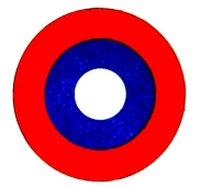 |
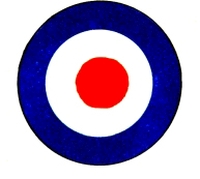 |
| UNITED STATES |
GREAT BRITAIN |
| |
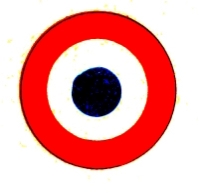 |
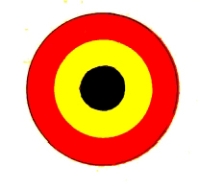 |
| FRANCE |
BELGIUM |
| |
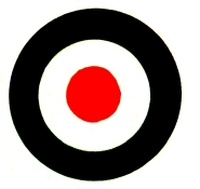 |
 |
| ITALY |
RUSSIA |
 |
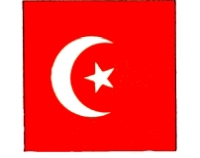 |
| GERMANY AND AUSTRIA |
TURKEY |
AIRCRAFT DISTINGUISHING MARKS
[Pg 64]

SEAL OF THE U. S. WAR DEPARTMENT
CHAPTER IV
UNIFORMS AND INSIGNIA OF
THE UNITED STATES ARMY
The uniforms for the officers and enlisted men of the United States
Army are made of blue cloth for wear on dress occasions and of
olive-drab colored material for wear on general service and field
service occasions, and in addition the officers have uniforms of white
linen or cotton duck for wear as a dress uniform in the tropics or
during hot weather.
The service uniforms of the olive-drab color are made of woolen cloth
or serge for cold weather and of cotton duck for hot weather, the
latter being usually known as “khaki” uniforms, though the regulation
color is of a somewhat darker shade than that universally known as “khaki.”
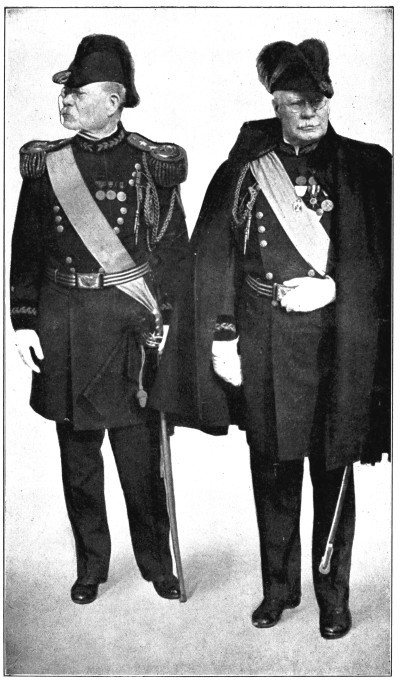
Copyright by Underwood & Underwood
General Tasker H. Bliss, Chief of Staff, U. S. Army,
and Major General Hugh L. Scott, U. S. Army
[Pg 65]
It is a general rule that the officers serving with the troops in
garrison or in the field must appear in the same style of uniform as
that prescribed for the enlisted men.
During peace times officers serving on detached duty or in the offices
of the Departments where there are no enlisted men on duty ordinarily
wear civilian clothes, but in time of war all officers and enlisted
men are required to wear the olive-drab service uniform at all times
except when the full dress and dress uniforms are prescribed for some
appropriate special occasion. Officers ordered on active field service
are required to carry with them only the service uniforms.
UNITED STATES ARMY OFFICERS’ UNIFORMS
Commissioned officers of the Army are required to have complete outfits
of service uniform (woolen olive-drab for temperate and cold weather
and cotton olive-drab or “khaki” for the tropics and hot weather),
dress uniform, full dress uniform, white uniform and special evening
dress uniform, and for wear on certain occasions in the evening a mess
dress uniform of blue and one of white is optional.
The occasions upon which these uniforms are usually worn are given in
the regulations as follows:
TABLE OF OCCASIONS FOR UNIFORMS
| |
| Occasions. |
Uniform. |
1. For habitual garrison wear at all times when under arms,
and until sundown when not under arms. |
Service uniform, woolen or cotton depending upon the temperature. |
2. For duty in the field. |
3. For ordinary wear after retreat by officers not under arms. |
Dress uniform (in the Tropics and during
hot weather in other places the white uniform may be worn).
[Pg 66] |
4. For social uses before retreat. |
5. When off post, except that when riding or taking
physical exercise the service uniform may be worn. |
6. When on duty with enlisted men for whom dress uniform is prescribed. |
7. When on duty with enlisted men for whom mounted dress uniform is prescribed. |
Dress uniform (mounted). |
8. When riding off the reservation. |
9. State occasions at home or abroad. |
Full dress uniform. |
10. When receiving the President of the United States. |
11. When receiving or calling officially upon the President,
sovereign or a member of the royal family of another country. |
12. Ceremonies and entertainments when it is desired
to do special honor to the occasion. |
13. When full dress, dismounted, is prescribed for
enlisted men. |
14. Special or official functions of a general nature,
when prescribed. |
15. When on duty with enlisted men for whom full dress,
mounted, is prescribed. |
Full dress uniform (mounted).
[Pg 67] |
16. Social or official functions of a general
nature when prescribed. |
On the following occasions when officers
are required to be mounted. |
17. State occasions at home or abroad. |
18. When receiving the President of the United States. |
19. When receiving or officially calling upon the President,
sovereign or a member of the royal family of another country. |
20. Ceremonies or entertainments when it is desired
to do special honor to the occasion. |
21. Social or official functions of a general nature
occurring in the evening. |
Special evening dress uniform. |
22. For private formal dinners and other private
formal social functions occurring in the evening. |
23. For ordinary evening wear when desired. |
24. For private formal dinners and other private formal
social functions occurring in the evening. |
Blue mess dress uniform. In the Tropics
and at other places in hot weather, the white mess dress uniform may be worn. |
25. For ordinary evening wear when desired. |
In the Tropics. |
White uniform. |
26. Until sundown when prescribed. |
27. For ordinary wear after retreat. |
28. For official occasions, under arms, when prescribed. |
In the United States in warm weather. |
29. For ordinary wear after retreat. |
30. For social use after retreat. |
31. When off the post, or reservation. |
| |
Throughout the military and naval services of the United States when
officers of the Army, Navy and Marine Corps appear together in uniform
upon occasions of ceremony the following are the uniforms designated
for each of the three services:
[Pg 68]
| |
Designation of
Uniform |
Composition of Uniforms for |
| Army |
Navy |
Marine Corps |
| Uniform A |
Full dress |
Special full dress, or white special full dress. |
Special full dress (with full dress trousers if in line
with troops), or white special full dress. |
| Uniform B |
Dress |
Undress, or white undress. |
Undress or white undress. |
| Uniform C |
Full dress or evening dress. |
Full dress or Evening full dress; or evening full dress without
swords or belts, and with blue caps; or dinner dress. |
Special full dress, or mess dress. |
| |
The service uniform consists of a single-breasted sack coat extending
to one-third of the distance from the point of the hip to the knee,
fitting tightly at the waist, with a standing collar, buttoned down the
front with a row of five army buttons of dull finish bronze, having
four patch pockets closed by pocket flaps buttoned with small size
army buttons of bronze, one pocket on each breast and one on each side
of the front below the waist, the shoulders having straps of the same
material as the coat extending from the shoulder seam to the base of
the collar secured with a small size bronze button at the collar end
(the insignia of rank are worn on these straps), and the sleeves being
trimmed with one row of half-inch braid three inches above the end of
the sleeve, the braid being black for officers of the General Staff
Corps and brown for all other officers; breeches of the same color and
material as the coat; tan leather shoes and tan leather strap puttee
leggings; the service hat, commonly known as the “campaign hat,” a
wide brimmed drab felt hat worn to a peak at the center of the crown
and having the officers’ hat cord around the base of the crown; or the
service cap, a bell-crowned cap of the same material as the coat with a
sloping visor of tan leather and a one-half inch tan leather chin strap
above the visor secured by a bronze button at each end of the visor.
Olive-drab woolen gloves are worn with this uniform when required.
For garrison wear a white shirt, collar and cuffs are worn with this
uniform, but in the field a flannel olive-drab shirt is worn.
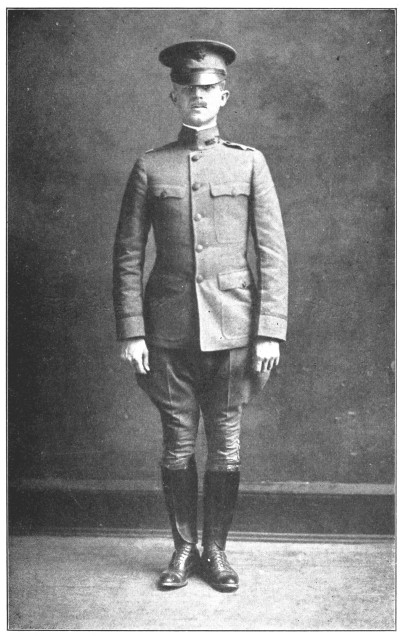
Copyright, Harris & Ewing, Washington, D. C.
U. S. Army officer
Olive-drab service uniform
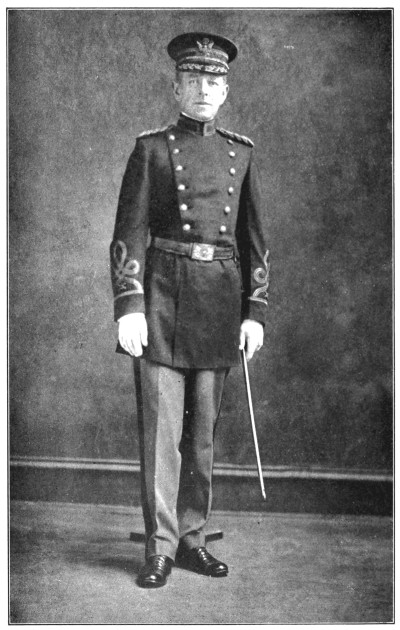
Copyright, Harris & Ewing, Washington, D. C.
U. S. Army. Officer, full dress uniform
Rank: Major, indicated by the three stripes in the sleeve decorations
Corps: Coast Artillery, indicated by the Corps
insignia on the sleeves below the knot decoration
[Pg 69]
In garrison the saber is worn suspended by tan leather slings from a
tan leather waist-belt, but for war service in the field the saber
is worn with a wide tan leather belt having a suspender strap of tan
leather worn from the right shoulder diagonally across the body to
rings in the belt in front and in rear of the left hip. This belt was
recently adopted from the British Army and is known as the “Sam Browne”
belt. In the trenches and on ordinary duty in the field, officers of
the Army wear the pistol belt on which the service automatic pistol is
carried in a leather or webbing holster.
Insignia of dull bronze metal indicating the arm of the service or the
staff corps to which the wearer belongs are worn upon both sides of the
collar of the service coat and the insignia of rank in bright metal, silver
or gold according to rank are worn upon each shoulder strap of the coat.
For certain drills and for service in the field the coat may be dispensed
with, in which case the olive-drab flannel shirt is worn and the corps insignia
and insignia of rank are then worn upon the collar of the shirt.
The hat cord worn on the service hat by General Officers is a double
[Pg 70]
cord of gold bullion with acorns of the same material at the ends, and
that worn by other commissioned officers is the same except that it has
black silk intermixed with the gold.
Army Field Clerks and Field Clerks Quartermaster Corps wear hat cords
made of black and silver twisted strands.
Members of the Officers Training Corps undergoing training in the camps
provided for that purpose wear a hat cord made of red, white and blue
twisted strands.
The overcoat is worn with the service uniform when necessary.
Mounted officers wear tan boots, spurs and drab leather riding gloves
with the service uniform.
The dress uniform consists of a dark blue cloth, single-breasted coat
extending to one-third of the distance from the point of the hip to the
knee; blue cloth trousers (the shade depending upon the rank and corps
of the wearer as later described); a bell-crowned cap, of dark blue
cloth having the coat of arms of the United States embroidered in gold
on the front of the crown at the center, with a sloping visor of black
patent leather and a chin strap of gold braid three-eighths of an inch
in width and eight inches long attached above the visor by a small gilt
Army button at each end of the visor; black shoes; white shirt, collar
and cuffs; and white gloves.
The dress coat for General officers (officers of the rank of General,
Lieutenant General, Major General and Brigadier General) is double
breasted with a standing and falling collar, two rows of buttons down
the front as follows: for a General twelve buttons in each row arranged
in three groups of four, for a Lieutenant General ten in each row
arranged in three groups, the upper and lower groups of three and the
[Pg 71]
central group of four, for a Major General nine in each row arranged in
three groups of three each, and for a Brigadier General eight in each
row arranged in groups of two; and the cuffs trimmed with three small
size gilt army buttons on each back seam. The collar has on each side
the proper insignia indicating staff corps, and on each shoulder there
is a shoulder strap four inches long and one and seven-eighths inches
wide with a border of raised gold embroidery three-eighths of an inch
wide, the field of the strap being of dark blue cloth and bearing the
stars indicating the rank of the General officer. These shoulder straps
are worn with one of the sides touching the shoulder seam of the sleeve.
The dress coat for all other officers is a single-breasted sack coat
of dark blue cloth, with a standing collar, closed in front by buttons
or hooks concealed by a fly, having a vertical opening on each side at
the hip six inches high, the collar, front edges, bottom edge of the
coat and the vertical side openings being trimmed with lustrous black
mohair braid one and one-half inches wide. On each shoulder a shoulder
strap of the same size as that described for General officers is worn,
the field of the strap being the distinctive color of the arm of the
service to which the wearer belongs and having the insignia of rank
embroidered upon it. On each side of the collar the corps insignia are
worn to indicate the corps or branch of the service to which the wearer
belongs.
The dress trousers for General officers (except Chief of Coast
Artillery, Chief of Engineers, Quartermaster General and General
Officers of the Quartermaster Corps) are made of dark blue cloth
without stripes or other trimming. For the General officers excepted in
[Pg 72]
the last sentence the trousers are of dark blue cloth trimmed down the
outer leg seams with stripes as follows:
Chief of Coast Artillery.—Stripes of scarlet cloth one and
one-half inches wide.
Chief of Engineers.—Stripes of scarlet cloth one and one-half inches
wide with a one-eighth inch piping of white cloth in the center of each stripe.
Quartermaster General and General Officers of the Quartermaster
Corps.—Stripes of buff cloth one and one-half inches wide.
For officers below the rank of Brigadier General the dress trousers
are of blue cloth with stripes of cloth one and one-half inches wide
down the outer leg seams, the color of the cloth for the trousers and
stripes depending upon the corps of the officer as follows:
Officers having permanent appointments in the Staff Corps and
Departments (except Engineer and Quartermaster officers), dark blue
cloth without any stripes.
Officers of the Engineer Corps.—Dark blue cloth with scarlet stripes
having a one-eighth inch piping of white through the center of each stripe.
Officers holding permanent appointments in the Quartermaster
Corps.—Dark blue cloth with buff stripes.
Officers of cavalry.—Sky-blue cloth with stripes of yellow.
Officers of Artillery.—Sky-blue cloth with stripes of scarlet.
Officers of Infantry.—Sky-blue cloth with stripes of white.
The dress cap for General officers (except the Quartermaster General,
Brigadier Generals of the Quartermaster Corps and the Chief of Coast
Artillery) has a band of blue-black velvet one and three-quarters inches
[Pg 73]
wide, upon which is embroidered in gold a design of oak leaves, and
upon the visor there are two sprays of oak leaves embroidered in gold.
The dress caps for the Quartermaster General and Brigadier Generals of
the Quartermaster Corps and for the Chief of Coast Artillery are the
same as for other General officers except that the cap for the Chief
of Coast Artillery has the band of scarlet velvet and that for the
Quartermaster General and Brigadier Generals of the Quartermaster Corps
have the band of buff velvet.
The dress cap for Field officers (Colonels, Lieutenant Colonels and
Majors) of all branches is the same as that for General officers,
except that the band is decorated with two bands of gold lace braid
one-half an inch wide, one at the top and one at the bottom of the
band with a strip of cloth three-quarters of an inch in width between
the two gold bands, the color of the cloth being the distinctive color
of the arm of the service or staff corps to which the wearer belongs,
these distinctive colors being the same as those for the “facings” of
the uniforms.
When the saber is worn with the dress uniform the belt is worn under
the coat, with full dress slings.
The overcoat is worn with the dress uniform when necessary, and the
cloak, or blue cape, may be worn when the officer is not on duty with
troops under arms.
When mounted officers in dress uniform wear dress breeches of cloth of
the same color as their dress trousers and with the same stripes, black
boots, white leather gloves and spurs.
The full dress uniform consists of a double-breasted coat of dark
blue cloth extending to about three-fourths of the distance from the
point of the hip to the knee, with a standing collar, two rows of large
[Pg 74]
gilt buttons down the front between the line of the collar and the
waist; epaulets or shoulder knots, as ordered, for General officers and
shoulder knots for all other officers; dark blue cloth trousers for
General officers, chaplains and officers holding permanent appointments
in the Staff Corps (except officers of the Quartermaster Corps),
and the same as dress trousers for all other officers; a chapeau or
the dress cap for General officers and the dress cap for all other
officers; black shoes; white shirt, collar and cuffs; white gloves;
full dress belt and saber.
The full dress coat for General officers (except the Chief of
Engineers, the Quartermaster General and the Brigadier Generals of the
Quartermaster Corps) has collar and cuffs of blue-black velvet, the
collar being ornamented with a band of oak leaves embroidered in gold,
and the cuffs having a band of oak leaves embroidered in gold near the
top. The full dress coat for the Chief of Engineers has a narrow piping
of scarlet velvet down the front, that for the General officers of the
Quartermaster Corps has buff collars and cuffs. The rank of the General
officer is indicated by the insignia of rank (the appropriate number of
stars) upon the cuffs.
The buttons on the front of the full dress coat for General officers
are arranged in groups as described for the dress coat.

Copyright, 1908, by Brig. Gen. J. B. Aleshire, Qr.-Master General, U. S. A.
U. S. Army.
Officers’ winter uniforms
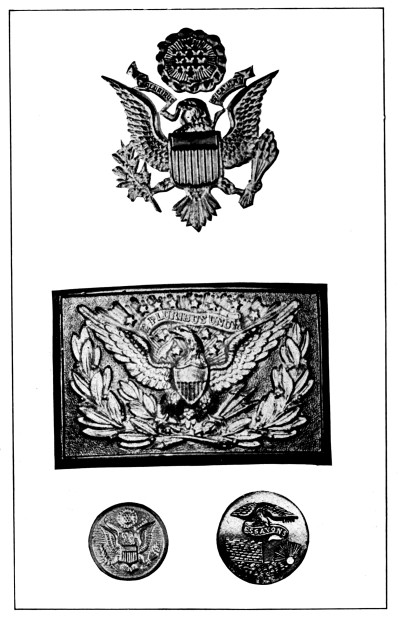
U. S. Army Officers
| 1. |
Insignia worn on caps |
| 2. |
Full dress belt clasp |
| 3. |
Service buttons (Except for Engineers) |
| 4. |
Service buttons, Engineers |
[Pg 75]
The full dress coat for all officers below the rank of Brigadier
General (except officers of Engineers and officers holding permanent
appointments in the Quartermaster Corps) has two rows of large size
gilt army buttons down the front, nine in each row equally spaced,
two rows of one-half inch gold lace braid around the collar, one at
the top and one at the bottom, with the distinctive color of the
“facings” of the corps, department or arm of the service filling the
space between the two rows. Officers of Engineers have a narrow piping
of scarlet cloth down the front of the full dress coat and officers
holding permanent appointments in the Quartermaster Corps have this
piping of buff cloth and also cuffs of buff cloth two and one-half
inches deep. For all officers below the rank of Brigadier General the
full dress coat has one row of one-half inch gold lace braid around the
sleeve two and one-half inches from the bottom and above this the gold
braided designs indicating the rank of the wearer. These ornamentations
are in the form of three loops, one large vertical loop with two
smaller horizontal loops below it. The insignia indicating the corps,
department or arm of the service to which the wearer belongs are worn
in the angle at the bottom of the knot.
These knots are made up of from one to five rows of gold soutache braid
one-eighth of an inch wide, the number of rows of braid indicating the
rank of the wearer.
When mounted all officers wear the breeches described for dress
uniform, black boots, white leather gloves and spurs.
The white uniform consists of a single-breasted sack coat of white
duck of the same general design as the blue dress coat but trimmed with
white braid and having straps of the same material as the coat upon the
shoulders reaching from the shoulder seams to the base of the collar,
white trousers and a white cap. The insignia indicating the corps,
department or arm of service are worn upon the collar of the coat
in bright metal and the insignia of rank are worn upon the shoulder
straps. The white cap is of the same design and description as the dress cap
except that the crown is made of white duck and the band is of white braid.
[Pg 76]
The special evening dress uniform consists of a dark blue cloth coat
cut on the lines of the civilian evening dress coat, having regulation
gilt buttons and the sleeves decorated as described for the full dress
coat; trousers of dark blue cloth for officers of cavalry, artillery
and infantry and full dress trousers for all other officers; white
shirt, collar and cuffs; black silk necktie; white evening dress
waistcoat with regulation gilt buttons; the dress cap; and black shoes.
The blue mess uniform consists of a dark blue mess jacket cut like
the special evening dress coat but without tails, the collar and lapels
being faced with silk of the color of the “facings” prescribed for
the corps, department or arm of the service and the sleeves trimmed
as described for the full dress coat; dress trousers for officers of
infantry, cavalry, artillery, quartermaster corps and engineers, and
full dress trousers for all other officers; white or blue waistcoat
with small regulation gilt buttons; dress cap; white shirt, collar and
cuffs; black silk necktie; and black shoes.
The white mess uniform consists of a white mess jacket cut on the
same design as the blue mess jacket but with the sleeve trimmings of
white braid; white waistcoat; white trousers; white shirt, collar and
cuffs; the white cap; and white shoes.
The overcoat for officers is a double-breasted ulster of olive-drab
cloth extending to about ten inches below the knee (overcoats reaching
to the knee only are authorized for field service), with pleated back
and a wide rolling collar, buttoning to the neck, with two rows of
large flat horn buttons of the same color as the coat, five in each
row, having a pocket with vertical opening on each side at the waist.
The rank of the wearer is indicated by the trimmings on the sleeves.
The overcoat for General officers has a band of black mohair braid
one and one-quarter inches wide around the sleeve two and one-half
inches above the end and another band of black mohair braid one-half
of an inch wide placed one and one-half inches above the lower band.
The overcoats for officers below the rank of Brigadier General have
the ornamentations indicating rank as shown by the accompanying
illustrations. For officers of the General Staff Corps the bands of
black braid below the sleeve knot are seven-eighths of an inch wide.

U. S. Army. Officers’ overcoat sleeve braiding (in black) indicating rank
| 1. |
All General Officers |
2. |
Colonel |
| 3. |
Lieutenant Colonel |
4. |
Major |
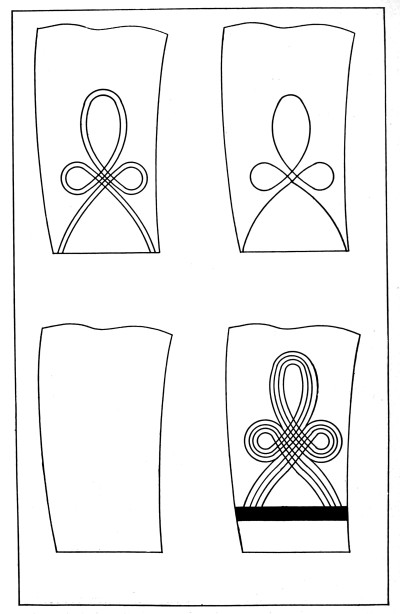
U. S. Army. Officers’ overcoat sleeve braiding indicating rank
Black braid for all except Second Lieutenant
| 1. |
Captain |
2. |
First Lieutenant |
| |
|
|
Second Lieutenant (brown braid) |
| 3. |
Field clerk |
4. |
Lieutenant Colonel, General Staff Corps |
[Pg 77]
The cape for officers is of dark blue cloth, extending to the knee,
with a blue-black velvet rolling collar, lined with cloth depending
upon the corps or arm of the service as follows:
| General officers and officers of the Staff Corps and Departments |
|
| (except Quartermaster General) |
Dark blue. |
| Officers of the Quartermaster Corps |
Buff. |
| Officers of Infantry |
Light blue. |
| Officers of Artillery |
Scarlet. |
| Officers of Cavalry |
Yellow. |
| Chaplains |
Black. |
The chapeau for General officers is a cocked hat of black silk plush,
having on the right side a rosette of black silk five inches long and
three inches wide with a strip of gold lace in the center, the coat of
arms of the United States being embroidered upon the upper end of the
strip. Over the center of the chapeau two black ostrich plumes extend from
front to rear, and there are gold bullion tassels at the front and back.
Aiguilettes of braided gold cord three-sixteenths of an inch in
diameter are worn by officers of the General Staff Corps, officers of
[Pg 78]
the Adjutant General’s and Inspector General’s Departments, officers
of the Bureau of Insular Affairs, aides-de-camp, regimental adjutants,
adjutants of Artillery Districts, the Adjutant of the Military Academy
at West Point, and Military Attaches at American Embassies and
Legations in foreign countries.
Full dress belts for Major Generals are of red Russia leather with
three stripes of gold embroidery, for Brigadier Generals of black
webbing, for Field Officers (Colonels, Lieutenant Colonels and Majors)
of black enamel leather with one wide stripe of gold lace, for officers
holding permanent appointments in the staff corps and departments below
the rank of major (except Engineers) of black enamel leather covered
with a wide stripe of gold lace interwoven with three narrow stripes of
black silk, for officers of Engineers the same but with gold stripes
interwoven with three narrow stripes of scarlet silk, and for officers
of cavalry, infantry and artillery below the rank of major the same
but with the gold stripes interwoven with three narrow stripes of silk
of the distinctive color of the arm of the service, cavalry yellow,
infantry light blue and artillery scarlet.
A sash of buff silk is worn by General officers, the one for
Brigadier Generals being worn around the waist over the belt and the
ones for all Generals of higher rank being worn across the right
shoulder under the epaulet or shoulder knot and diagonally across the
body to the left side at the waist and terminating in heavy tassels
which hang below the belt.
Epaulets, worn by General officers with full dress uniform, are of
gold with heavy gold fringe. On the top is the coat of arms of the
United States and the stars indicating rank.
Shoulder knots worn by all officers with full dress uniforms are five
[Pg 79]
and one-half inches long and two and one-half inches wide, made of
plaited gold cord and bearing the insignia of rank upon the upper surface.
The sword for officers of the Army is a saber with a slightly curved
bright steel blade, a half-basket hilt with the guard of bright steel,
and an ebony grip. The scabbard is of bright steel with two plain bands
and rings for attaching the saber to the slings.
The saber knot worn on the hilt of the saber for attaching the sword
to the wrist, for wear with full dress uniform is of heavy gilt cord
ending in a gilt braided acorn for General officers and for other
officers a strap of flat gold braid with a row of black silk interwoven
in it near each edge; and for wear with service uniform it is made of
plaited leather cord ending in a leather tassel.
INSIGNIA OF RANK AND CORPS
The rank of an officer of the Army is indicated in two ways, first, by
insignia of rank placed upon the epaulets and shoulder knots worn with
full dress uniform, upon the shoulder straps worn with dress uniform,
upon the cloth shoulder straps of the service coats and white coats
and upon the collar of the olive-drab flannel shirt when it is worn
without the coat; second, by the insignia upon the sleeves of the full
dress coat, the special evening dress coat, the overcoat and the blue
and white mess jackets, this braiding being of gold on the full dress
coat, special evening dress coat and blue mess jacket, black upon the
overcoat and white upon the white mess jacket.
The insignia of rank referred to above for the various ranks of
officers, as shown in the illustrations, are as follows:
[Pg 80]
General—Four silver stars.
Lieutenant General—One large silver star and
two smaller ones, one on each side of the larger star.
Major General—Two silver stars, one inch in
diameter.
Brigadier General—One silver star, one inch in
diameter.
Colonel—A silver spread eagle, three-quarters
of an inch high and two inches from tip to tip of wings.
Lieutenant Colonel—A silver oak leaf, one inch
high and one inch wide.
Major—A gold oak leaf, one inch high and one
inch wide.
Captain—Two silver bars, one inch long and
one-quarter of an inch wide.
First Lieutenant—One silver bar, one inch long
and one-quarter of an inch wide.
Second Lieutenant—One gold bar, one inch long
and one-quarter of an inch wide.
The insignia of rank upon the sleeves of the full dress coat,
special evening dress coats, and blue mess jacket, are as follows:
General—A band of oak leaves in gold at the top
of the cuff and four silver stars below the band.
Lieutenant General—A band of oak leaves in gold
at the top of the cuff and one large silver star and two smaller silver
stars, one on each side of the large star, below the band.
Major General—A band of oak leaves in gold at
the top of the cuff and two silver stars one inch in diameter, below
the band.
Brigadier General—A band of oak leaves in gold
at the top of the cuff and one silver star one inch in diameter, below
the band.
Colonel—A gold band one-half of an inch wide
around the sleeve with a knot of three loops, one large loop placed
vertically and two smaller loops placed horizontally at each side
below the large loop, the knot being placed above the gold band, the
dimensions of the knot being height eight inches and width six and
three-quarters inches. The knot for the rank of colonel is composed of
five rows of braid one-eighth of an inch wide spaced one-quarter of an
inch apart. The insignia indicating the corps, department or arm of the
service is worn in the center of the space formed by the lower curves
of the knot and the gold band around the sleeve. For chaplains this
insignia is a Latin cross of silver.
Lieutenant Colonel—The same as for a colonel
except that the knot is composed of four rows of braid.
Major—The same as for a colonel except that the
knot is composed of three rows of braid.
Captain—The same as for colonel except that the
knot is composed of two rows of braid.
First Lieutenant—The same as for a colonel
except that the knot is composed of one row of braid.
Second Lieutenant—There is no knot, the
one-half inch band of gold braid around the sleeve with the insignia
indicating the corps, department or arm of the service being the only
ornamentation on the sleeves.
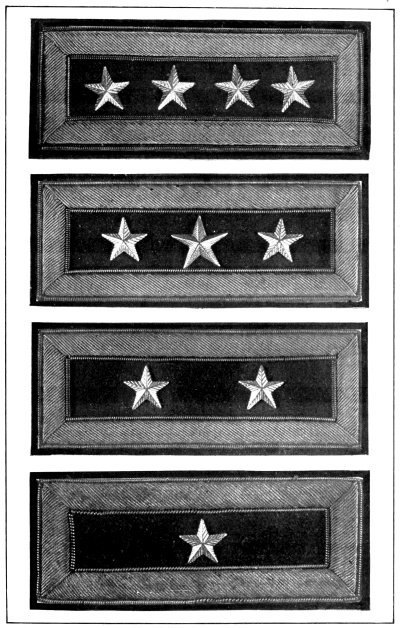
U. S. Army. Officers’ shoulder straps worn on blue dress coats
| 1. |
General |
2. |
Lieutenant General |
| 3. |
Major General |
4. |
Brigadier General |
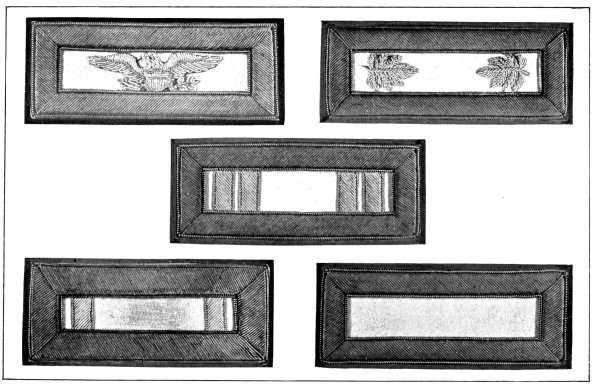
U. S. Army. Officers’ shoulder straps worn on blue dress coats
| 1. Colonel |
|
2. Lieutenant Colonel (Silver leaf) |
| |
3. Captain |
Major (Gold leaf) |
| 4. First Lieutenant |
|
5. Second Lieutenant |
[Pg 81]
The sleeves of the white mess jackets have the same insignia to
indicate rank and corps as those of the full dress coat but the band
around the sleeve and the knot are made of white braid.
The rank of General officers is indicated on the overcoat by silver
stars placed between the two bands of black braid on each sleeve.
The corps, department or arm of the service to which an officer
belongs is shown in two ways; first, by the color of the “facings,” or
distinctive color trimmings of the uniform, and second, by the insignia
of the different corps, departments and arms of the service worn upon
the collars and also upon the sleeves of the full dress coat, special
evening dress coat, mess jackets and overcoat.
Facings.—The facings or distinctive colors for the various corps,
departments and arms of the service are as follows:
[Pg 82]
| General Officers |
dark blue. |
| (except the Quartermaster General and Brigadier |
| Generals of the Quartermaster Corps) |
| Quartermaster General and Brigadier |
buff. |
| Generals of the Quartermaster Corps |
| Adjutant General’s Department |
dark blue. |
| Inspector General’s Department |
dark blue. |
| Judge Advocate General’s Department |
dark blue. |
| Quartermaster Corps |
buff. |
| Ordnance Department |
black piped with scarlet. |
| Signal Corps |
orange piped with white. |
| Medical Corps |
maroon. |
| Corps of Engineers |
scarlet piped with white. |
| Cavalry |
yellow. |
| Artillery |
scarlet. |
| Infantry |
light blue. |
| Chaplains |
black. |
The insignia to designate the corps, department or arm of the service
to which an officer belongs, as shown in the illustrations, are made of
bright metal, gold or silver according to the corps, for blue and white
uniforms and dull finish bronze for service uniforms. They are worn on
the sleeves of the full dress coat, special evening dress coat, blue
mess jacket and white mess jacket, and on each side of the collars of
the dress coat, service coats and olive-drab flannel shirt.
The bright metal insignia are as follows:
All officers.—The letters “U. S.” in Gothic design, five-eighths
of an inch high, each letter followed by a period, are worn on each
side of the collar of the dress and service coats. For officers of
the Reserve Corps the letter “R” is added and for officers of the
Volunteers the letter “V” is added. These letters are of gold except
for officers of the Engineer Corps who wear them in silver.
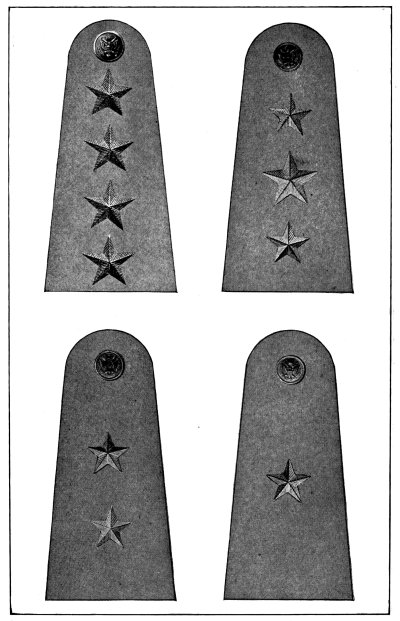
U. S. Army. Officers’ insignia indicating rank
Shoulder straps worn on the olive-drab service coats
and the white coat
| 1. |
General |
2. |
Lieutenant General |
| 3. |
Major General |
4. |
Brigadier General |

U. S. Army. Officers’ insignia indicating rank
Shoulder straps worn on the olive-drab service coats
and the white coat
| 1. Colonel |
2. Lieutenant Colonel (Silver leaf), |
| |
Major (Gold leaf) |
| 3. Captain. |
4. First Lieutenant (Silver Bar), |
| 5. Field Clerk |
Second Lieutenant (Gold Bar) |
[Pg 83]
General Staff Corps.—A gold five-pointed star one and a quarter
inches in diameter surmounted by the coat of arms of the United States
in gold and enamel.
Corps of Engineers.—The letters “U. S.” of silver and a turretted
castle of silver.
Chaplains.—A silver Latin cross.
Adjutant General’s Department.—A gold shield one inch high.
Inspector General’s Department.—A sword and fasces of gold, crossed
and surmounted by a gold wreath with the inscription “Droit et Avant”
in blue enamel on the wreath.
Judge Advocate General’s Department.—A sword and pen crossed and
surmounted by a wreath, all of gold.
Quartermaster Corps.—A sword and a key crossed on a wheel surmounted
by an eagle, in gold except the rim of the wheel which is in blue
enamel set with thirteen gold stars.
Medical Corps.—A caduceus of gold.
Medical Reserve Corps.—The same surmounted by the letters “R. C.”
in bronze.
Sanitary Corps.—The same surmounted by the letters “S. C.”
Dental Surgeons.—The same surmounted by the letters “D. C.” in
bronze.
Acting Dental Surgeons.—The same in silver with gold letters.
Ordnance Department.—A flaming spherical shell of gold.
Signal Corps.—Two crossed signal flags with a vertical torch at the
center, all of gold.
[Pg 84]
Cavalry.—Two sabers of gold crossed with the number of the regiment
in the angle above them.
Field Artillery.—Two field guns of gold crossed with the number of
the regiment in the angle above them.
Coast Artillery.—Two gold cannons crossed, surmounted at the center
by an oval of red enamel with a gold projectile point up.
Infantry.—Two gold rifles crossed with the number of the regiment in
the angle above them.
Philippine Scouts.—The same as for infantry but with the letter “P”
in the angle above the crossed rifles.
Porto Rico Regiment.—The same but with the letters “P. R.”
Aides-de-camp.—A shield of the United States surmounted by a spread
eagle of gold, the stripes of the shield red and white and the field
blue enamel with gold stars, the number of which correspond to the rank
of the General officer upon whose staff the aide-de-camp is serving.
Regimental Staff Officers.—Regimental adjutants and quartermasters
have the devices of the insignia of the Adjutant General’s Department
or of the Quartermaster Corps respectively in the angle below the
insignia of their arm of the service.
Veterinarians.—An insignia consisting of a caduceus surcharged with
the letters V. C.
Assistant Inspectors of small arms practise for regiments of the
Organized Militia wear the insignia of the arm of the service to which
the regiment belongs with the number of the regiment above it and a
bursting shell below it.
Officers’ Buttons.—The design for Engineers is an eagle with the
motto “Essayons” above a fort and rising sun, and for other officers it
is the U. S. coat of arms.

U. S. Army. Officers’ collar insignia indicating
arm of the Service, Corps or Department
| 1. All officers of the Regular Army |
2. All officers of the National Army |
| 3. All officers of the Reserve |
4. All officers of the National Guard |
| 5. Quartermaster Corps |
6. Signal Corps |
| 7. Inspector General’s Department |
8. Judge Advocate General’s Department |

U. S. Army. Officers’ collar insignia indicating
arm of
the Service, Corps or Department
| 1. Adjutant General’s Department |
2. General Staff Corps |
| 3. Medical Corps |
4. Sanitary Corps |
| 5. Veterinary Corps |
6. Chaplain |
[Pg 85]
Uniform and Insignia of the Cadets at the
U. S. Military Academy,
West Point, N. Y.
The Corps of Cadets at the U. S. Military Academy at West Point, N. Y.,
is organized into Battalions of four companies each. The Corps of
Cadets is commanded by an officer of the Army especially detailed for
this duty, who, unless of actual higher rank, has the local rank and
pay of a Lieutenant Colonel while performing this duty.
The Battalions are commanded by officers of the Army detailed from the
Department of Tactics of the Military Academy and while performing the
duty of Battalion Commanders they have the rank and pay of Majors.
The other officers of the Corps of Cadets are selected from the cadets
at the Academy, the grades of rank being as follows:
- Captain.
- Adjutant.
- Quartermaster.
- Lieutenant.
- Sergeant Major.
- Quartermaster Sergeant.
- First Sergeant.
- Company Quartermaster Sergeant.
- Sergeant.
- Corporal.
- Privates First Class, according to class standing.
- Privates Second Class, according to class standing.
- Privates Third Class, according to class standing.
- Privates Fourth Class, according to class standing.
The insignia of these various ranks, worn on the full dress coat, are
as follows:
[Pg 86]
Captains.—Chevrons of four stripes of single gold lace braid on a
black background, on each arm above the elbow, points up.
Adjutant.—Chevrons of three stripes of single gold lace braid on a
black background with three arcs of the same braid beneath, on each arm
above the elbow, points up.
Quartermaster.—Chevrons of three stripes of single gold lace braid
with three horizontal stripes of the same braid beneath on a black
background, on each arm above the elbow, points up.
Lieutenants.—Chevrons of three stripes of single gold lace braid on
a black background, on each arm above the elbow, points up.
Sergeant Major.—Chevrons of two stripes of single gold lace braid
with two arcs of the same braid beneath on a black background, on each
arm above the elbow, points up.
Quartermaster Sergeant.—Chevrons of two stripes of single gold lace
braid with two horizontal stripes of the same braid beneath on a black
background, on each arm above the elbow, points up.
First Sergeants.—Chevrons of two stripes of single gold lace
braid with a diamond shaped lozenge in the angle beneath, on a black
background, on each arm above the elbow, points up.
Company Quartermaster Sergeants.—Chevrons of two stripes of single
gold lace braid with one horizontal stripe beneath, on a black
background, on each arm above the elbow, points up.
Sergeants.—Chevrons of two stripes of single gold lace braid on a
black background, on each arm above the elbow, points up.
Color Bearer.—Chevrons the same as for sergeants with a star in the
angle beneath.
Corporals.—Chevrons of two stripes of single gold lace braid on a
black background, on each arm below the elbow, points up.
Color Corporals.—Chevrons the same as for corporals
with a star in the angle beneath.
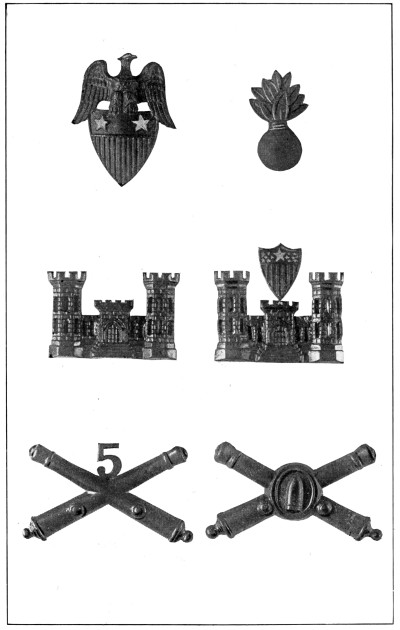
U. S. Army. Officers’ collar insignia indicating
arm of
the Service, Corps or Department
| 1. Aide-de-camp to General Officer |
2. Ordnance Corps |
| 3. Engineer Corps |
4. Adjutant of Engineer Corps |
| 5. Field Artillery |
6. Coast Artillery |
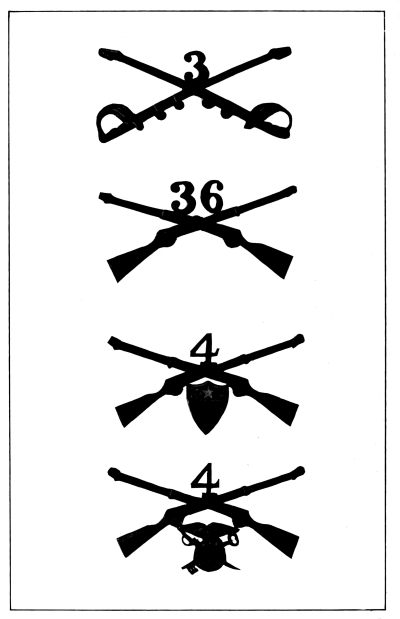
U. S. Army. Officers’ collar insignia indicating
arm of
the Service, Corps or Department
| 1. Cavalry |
| 2. Infantry |
| 3. Adjutant of Infantry |
| 4. Quartermaster of Infantry |
[Pg 87]
On the dress coats and overcoats the chevrons worn by the Cadet
Officers are of the same designs as those above described for the
full dress coats except that they are made of black cloth on a gray
background and those worn on the overcoats are of only one-third the
size of those for the full dress and dress coats.
The Cadets are divided into four classes according to the year’s course
they are pursuing, the first class corresponding to the seniors at a
college, the second class corresponding to the juniors, the third class
corresponding to the sophomores and the fourth class corresponding to
the freshmen.
The class to which a Cadet belongs is indicated by stripes worn upon
the sleeves of the full dress and dress coats and the overcoat, three
stripes for the first class, two stripes for the second class, one
stripe for the third class and none for the fourth class, thus each
stripe shows one year of service as a Cadet.
On the sleeves of the full dress coat these stripes are of gold
soutache braid placed diagonally across the outer side between the
wrist and the elbow; on the sleeves of the overcoat they are the same
as for the full dress coat except that they are made of black soutache
braid; and for the dress coat the stripes are of black soutache braid
placed across the outer side of the sleeve parallel to the broad black
braid on the cuff.
[Pg 88]
Cadets who are classed as “Distinguished” on account of high standing
in their studies and drills wear a five-pointed gold star on each side
of the collar of the full dress and dress coats.
The uniforms of the West Point cadets are of gray cloth for wear during
the winter and of white duck for wear during the summer, the color of
the winter uniforms being that which is usually known as “cadet gray.”
Each cadet is required to have complete outfits of full dress, dress
and white uniforms.
Their full dress uniform consists of a full dress coat, gray or
white trousers, full dress hat, black leather shoes, white waist-belt and
white cross-belts. Cadet officers wear a plume of black feathers in the
hat, a white sword belt and a red silk sash. The Cadet Sergeant Major,
Cadet Quartermaster Sergeant and Cadet First Sergeants wear a white
sword belt and a red silk sash.
The full dress coat is of gray cloth, fitting closely, single-breasted,
with three rows of gilt bell buttons down the front, eight buttons in
each row, one row in the center and one row on each side, the coat
being cut away just below the waist line across the front and having
short skirts behind. The skirts of the coat have twelve gilt bell
buttons, three down the plait of each skirt, the upper one at the
waist, and three placed lengthwise on each skirt. The coat has a square
standing collar with one bell button on each side. Each cuff has three
bell buttons. The collar, front of the coat, the cuffs and the skirt of
the coat are trimmed with black silk cord in designs as shown in the
illustration.
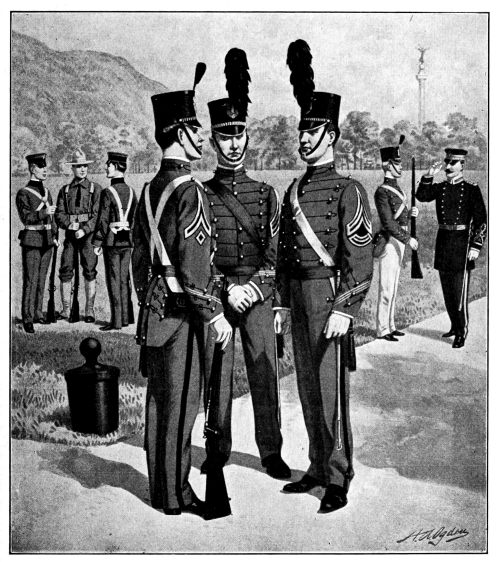
Copyright, 1908, by Brig. General J. B. Aleshire,
Qr. Master General. U. S. A.
Cadets, U. S. Military Academy
Full dress, dress and service uniforms
| 1. Cadet, Sergeant (Dress) |
| 2. Cadet, Private (Campaign Uniform) |
| 3. Cadet, Corporal (Dress) |
| 4. Cadet, First Sergeant (Full Dress) |
| 5. Cadet, Captain (Full Dress) |
| 6. Cadet, Adjutant (Full Dress) |
| 7. Cadet, Private (Full Dress) |
| 8. Captain of Infantry (Full Dress) |
The trousers for winter wear with both the full dress
and dress uniforms are of gray cloth with black stripes one and one-half inches
wide down the outer seams.
[Pg 89]
The full dress hat is of black felt, bell-crowned, six inches high,
with a sloping visor. It is trimmed with gilt decorations, bears the
insignia of the Military Academy on a gilt plate in front, has a black
pompon set in a gilt socket on the front at the center (a black plume
being worn by cadet officers, instead of the pompon), and a gilt scale
chain strap worn above the visor.
When mounted the cadets wear gray cloth breeches and riding
leggings instead of trousers.
The dress uniform of the cadets consists of a dress coat, dress cap,
gray or white trousers, black leather shoes, white waist-belt and white
cross-belts and leather gloves. Cadet officers wear a white sword belt
and a worsted sash.
The dress coat is of gray cloth, single-breasted, with a straight
standing collar, closed down the center of the front by buttons
concealed beneath a fly, the coat reaching to about nine inches below
the waist. The coat is trimmed around the collar, down the front,
around the bottom edge and up the side seams of the back with black
mohair braid one inch wide, the braid down the front being double.
There is also one stripe of the same braid around each sleeve two and
one-half inches from the lower edge of the cuff.
The dress cap is of gray cloth, bell-crowned, three and one-half inches
high, with a band of black mohair braid one and three-quarter inches
wide and a sloping visor of black patent leather. In the front and
center of the cap is worn the insignia of the United States Military
Academy in gilt metal one and three-quarter inches high.
The overcoat is of gray kersey, double-breasted, with six buttons on
each side down the front, coat to reach within ten inches of the ground
when the wearer is standing. It has a stand and fall collar five inches
[Pg 90]
deep. There are also two buttons at the hip and one at the bottom of
each plait behind. All of the buttons are gilt, seven-eighths of an
inch in diameter, and bear the arms of the U. S. Military Academy with
the word “Cadet” around the margin at the top and the letters “U. S. M.
A.” around the margin at the bottom. There is also a cape of the same
material as the coat, cut circular, extending to the hip buttons. The
coat and cape are lined with gray woolen material.
The raincoat is a sleeveless sack overcoat of gray waterproof
material with a cape attached to the coat, the skirts of the coat
extending to within eight inches of the ground.
The cadets are also furnished with a gray woolen shirt which is
sometimes worn at drills without the coat.
At certain of the drills and exercises a service hat of felt similar to
the “campaign hat” is worn.
UNIFORM AND INSIGNIA OF FIELD CLERKS,
U. S. ARMY
By the Act of Congress of August 29, 1917, the grades of Army Field
Clerk and Field Clerk Quartermaster Corps were established in the
United States Army. These officers are appointed by the Secretary
of War and take precedence in rank next after Cadets and before all
noncommissioned officers, so that their position is similar in relative
rank to that of Warrant officers in the United States Navy and Marine Corps.
The Army Field Clerks belong to the Adjutant General’s Department and
the Field Clerks Quartermaster Corps are a part of that corps.
They wear the same uniform as commissioned officers, omitting all
insignia of rank and the brown bands of braid around the cuffs of the
service coat. On their service hats they wear a hat cord of black and
silver twisted strands.
[Pg 91]
Army Field Clerks wear on each side of the collar of the service coat a
bronze insignia consisting of two quill pens crossed with a miniature
adjutant general’s shield in the lower angle.
Field Clerks Quartermaster Corps wear on each side of the collar of the
service coat a bronze insignia consisting of two quill pens crossed
with a miniature Quartermaster Corps insignia in the lower angle.
ENLISTED MEN’S UNIFORMS, U. S. ARMY
The enlisted men of the Army are required to have complete outfits
of service uniform for winter and summer, dress uniform and fatigue
uniform, and in addition cooks and bakers, members of the Hospital
Corps and members of the general recruiting service have white uniforms.
The occasions upon which the different uniforms are worn are given in
the regulations as follows:
TABLE OF OCCASIONS FOR UNIFORMS
| |
| Occasion. |
Uniform. |
1. For habitual garrison wear until retreat,
when not under arms. |
Service uniform with the service cap.
[Pg 92] |
2. For habitual garrison wear under arms. |
3. For inspection and guard mounting,
when ordered by the commanding officer. |
4. For all other ceremonies when the weather or climate will
not permit the wearing of dress or full dress. |
5. When changing station by rail or water. |
6. For field duty. |
Service uniform with the service hat.
In the trenches the steel helmet is worn. |
7. For habitual wear in garrison after retreat and when on leave. |
Dress uniform.
In the Tropics and in hot weather the cotton service uniform
(khaki) is worn instead. |
8. For parade and ceremonies except inspection and
guard mounting, when weather and climate permit. |
9. For parade and other ceremonies garrison
(except inspection and guard mounting when ordered. |
Full dress uniform. |
10. For all ceremonies other than garrison when ordered. |
11. For cooks and bakers when at work in kitchen or bakery. |
White uniform. |
12. For Hospital Corps men on duty in hospital wards, operating rooms, etc. |
13. For members of the general recruiting service when on duty
at recruiting stations, etc., when prescribed. |
14. On fatigue duty in stables, at mountain battery drills,
at work or drill at emplacements of the Coast Artillery. |
Fatigue uniform. |
| |
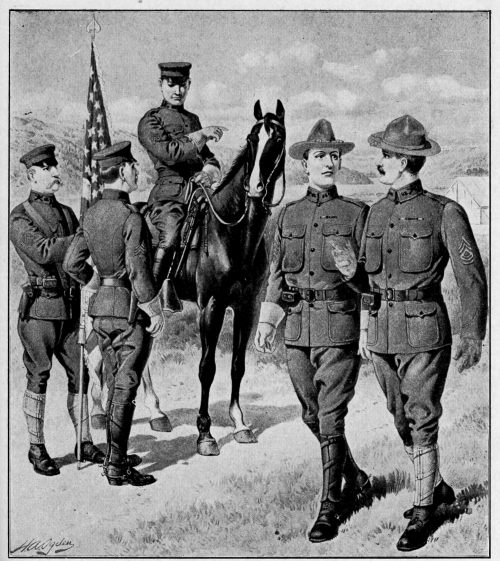
Copyright, 1908, by Brig. Gen. J. B. Aleshire,
Qr. Master General, U. S. A.
U. S. Army. Noncommissioned officers, olive-drab service uniform
| 1. Color Sergeant, Infantry |
2. First Sergeant, Field Artillery |
| 3. Company Quartermaster |
|
| Sergeant, Cavalry |
4. Sergeant, Signal Corps |
| 5. Sergeant Major, Infantry |
|
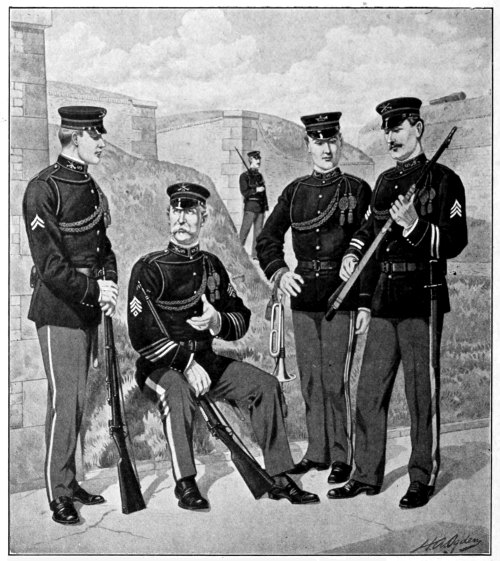
Copyright, 1908, by Brig. General J. B. Aleshire.
Qr. Master General, U. S. A.
U. S. Army. Enlisted men, Infantry full dress uniform
| 1. Corporal |
2. First Sergeant |
| 3. Private |
4. Musician |
| 5. Sergeant |
|
[Pg 93]
The service uniform for enlisted men of the Army consists of a single
breasted sack coat of olive-drab woolen or cotton material, extending
to about ten inches below the waist, with a standing collar, buttoned
down the front with one row of five regulation bronze buttons, having
four outside patch pockets, one on each breast and on each side below
the waist line, each pocket being closed with a shield shaped flap
buttoned by a small regulation button, and a strap of the same material
as the coat on each shoulder sewed in at the shoulder seam and buttoned
at the collar end by a small regulation button; breeches of the same
material as the coat, khaki-colored canvas leggings, tan leather shoes;
and a service cap or service hat. The service cap is a bell-crowned cap
with a sloping tan leather visor and a tan leather chin strap across
the front above the visor secured by a small bronze button at each
end of the visor. The service hat is the brown felt wide brimmed hat
universally called the “campaign hat” and is worn with what is known as
the “Montana peak,” that is, brought to a point at the center of the
top of the crown by making four dents in the top of the crown. A hat
cord of the distinctive color of the corps or arm of the service to
which the wearer belongs is worn around the base of the crown of the
service hat. During war the steel helmet is worn when on duty in the
trenches or on the battle line. In garrison the tan leather belt is
worn with the service uniform, and in the field the webbing cartridge
belt of the same color as the uniform is worn.
Mounted men wear spurs and tan leather leggings with this uniform.
In the tropics and in hot weather the service uniform of cotton
material is worn, and at drills and in the field, the coat is sometimes
dispensed with and the olive-drab flannel shirt is worn.
The overcoat and gloves of olive-drab wool are worn when the weather
requires.
During time of war this is the only uniform worn by the men or carried
by them into the field of operations.
The dress uniform for enlisted men consists of a single-breasted coat
[Pg 94]
of dark blue cloth, extending to about ten inches below the waist,
with a standing collar, buttoned down the front with one row of six
gilt regulation buttons and having a strap of dark blue cloth on each
shoulder; the dress cap of dark blue cloth; sky-blue cloth trousers; a
white collar; and tan leather shoes. When under arms in this uniform
white gloves are worn except when the overcoat is worn, in which case
olive-drab gloves are worn. The dress coat is trimmed around the top
and base of the collar and down the front edges of the collar, around
the edges of the shoulder straps and around each sleeve four inches
from the bottom edge by a narrow piping of the distinctive color of the
arm of the service or corps to which the wearer belongs, and there are
three small regulation gilt buttons on each cuff and one at the collar
end of each shoulder strap.
The trousers of noncommissioned officers have stripes of the same
distinctive color down the outer leg seams, the stripes for corporals
being one-half inch wide and those for higher noncommissioned officers
being one and one-quarter inches wide, those for musicians being
double, each part one-half inch wide.
The dress caps for enlisted men are made of a dark blue cloth with a
bell crown, a black patent leather sloping visor and a half-inch chin
strap of patent leather worn above the visor and secured by a gilt
button at each end of the visor. There is one stripe around the band of
the cap at the upper edge of the band and one at the lower edge of the
band, each stripe being one-half inch in width and of the distinctive
color of the corps or arm of the service to which the wearer belongs,
these distinctive colors being those as given for the “facings.”
The tan leather or garrison belt is worn with the dress uniform.
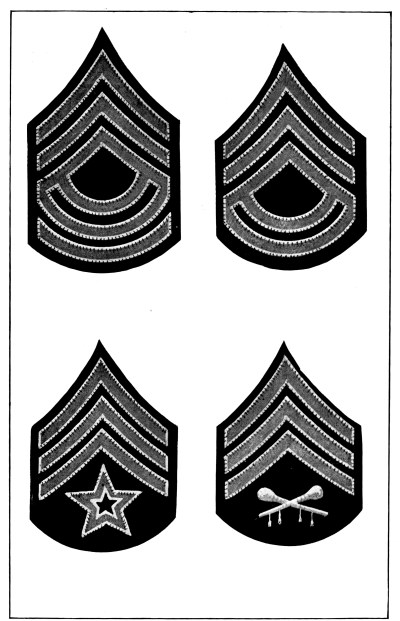
U. S. Army. Noncommissioned officers’ chevrons
| 1. Regimental Sergeant Major |
| 2. Battalion or Squadron Sergeant Major |
| 3. Color Sergeant |
| 4. Drum Major |
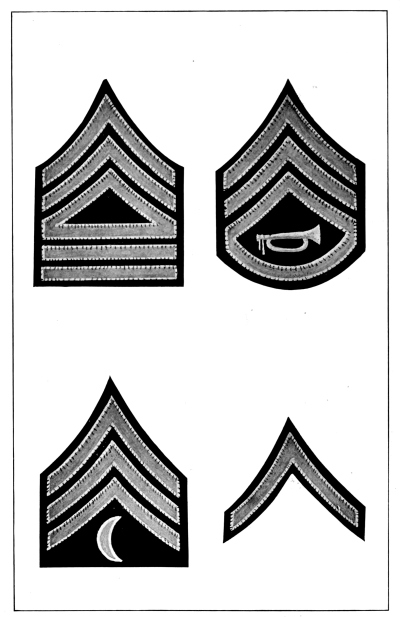
U. S. Army. Noncommissioned officers’ chevrons
| 1. Regimental Supply Sergeant |
| 2. Sergeant of Field Music |
| 3. Mess Sergeant |
| 4. Lance Corporal |
[Pg 95]
The overcoat is worn with it when the weather requires it.
Mounted men wear breeches with this uniform, the color and trimmings
being the same as for the trousers, and riding gloves, riding leggings
and spurs.
The full dress uniform for enlisted men is the same as their dress
uniform with the addition of a breast cord of the distinctive color of
the corps or arm of the service to which they belong. This breast cord
is a double plaited loop of round cord worn from one shoulder to the
other across the breast with a single cord passing across the back and the
front loop ending on the right side in two plaited plates and two tassels.
The fatigue uniform consists of brown canvas or duck working coat
and trousers. This is a working uniform. A fur cap is furnished for wear in
very cold weather.
The overcoat for enlisted men is a double-breasted ulster made
of olive-drab cloth, extending eight to ten inches below the knee
(overcoats extending to the knee are authorized for wear in the field),
buttoning to the neck with two rows of large flat buttons of the same
color as the coat, and having a wide rolling collar. It has a pleat
down the center of the back.
Rain clothes for enlisted men are olive-drab waterproof coats or
the poncho or rubber blanket worn in the fashion of a cape. Rubber boots
are used when required, as in wet trenches.
INSIGNIA OF RANK FOR ENLISTED MEN
The rank of the various noncommissioned officers of the United States
Army and Marine Corps and the rating of the corresponding petty
[Pg 96]
officers of the Navy is usually indicated by chevrons, a form of badge
derived from the days when heraldry played a great part in the world’s
affairs.
“Chevron” is an architectural term denoting the rafters of a roof
meeting at an angle at the upper apex, and it is derived from the
French word “chevre,” a goat, and so used on account of the fancied
resemblance of a pair of such rafters to the horns of a goat.
The chevron in heraldry was employed as a badge of honor to mark the
main supporters of the head of the clan, “the top of the house,” and it
came to be used in various forms as an emblem of rank for the knights
and men-at-arms in feudal days, and from this resulted its common use
as an insignia of rank in the armies and navies of the present day.
In some countries chevrons are used as insignia of rank for
commissioned officers as well as for noncommissioned officers, but in
the United States service the use of chevrons is confined to the latter
class.
In the United States Army and Marine Corps the chevrons are worn with
the point up but in the Navy they are worn with the point down.
The chevrons indicating the rank of noncommissioned officers are worn
midway between the shoulder and the elbow on both sleeves of the
service coats, full dress coat and overcoat.
The chevrons for the dress coat are 3¼ inches wide made of stripes of
cloth of the distinctive color of the corps, department or arm of the
service, each stripe being ⅜ of an inch wide.
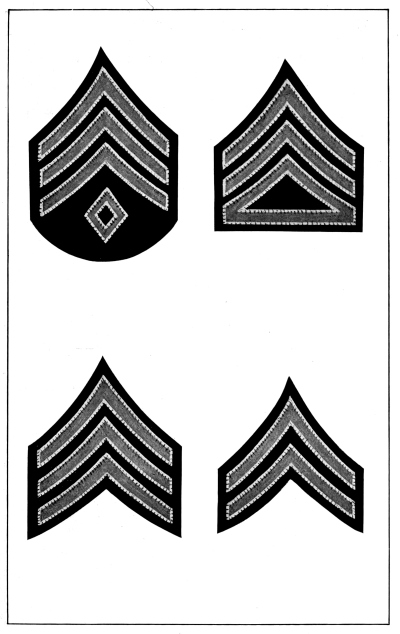
U. S. Army. Noncommissioned officers’ chevrons
| 1. First Sergeant |
2. Company Supply Sergeant |
| 3. Sergeant |
4. Corporal |
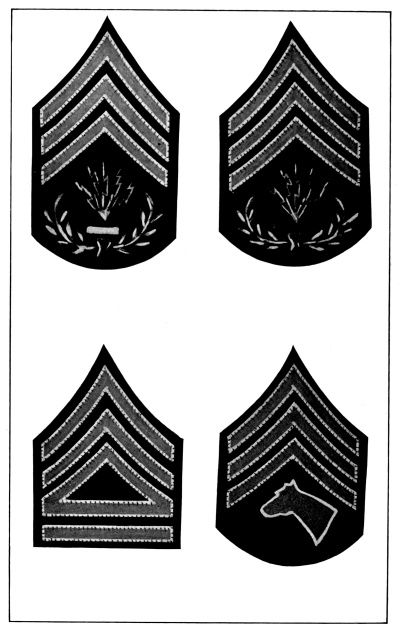
U. S. Army. Noncommissioned officers’ chevrons
| 1. Electrician Sergeant, First Class |
| 2. Electrician Sergeant, Second Class |
| 3. Battalion Supply Sergeant |
| 4. Stable Sergeant |
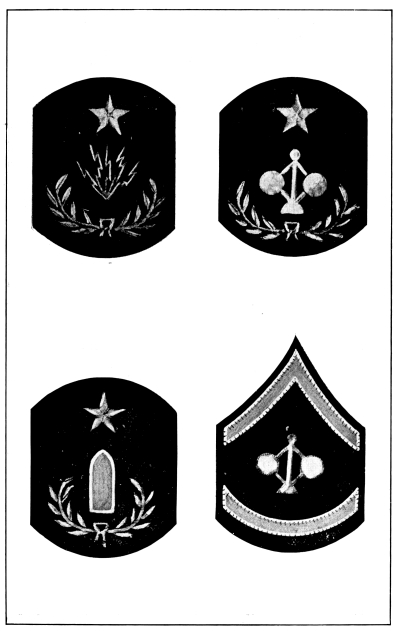
U. S. Army. Noncommissioned officers’ chevrons
Coast Artillery Corps
| 1. Master Electrician |
| 2. Engineer, Coast Artillery Corps |
| 3. Master Gunner |
| 4. Fireman, Coast Artillery Corps |

U. S. Army. Noncommissioned officers’ chevrons
Coast Artillery Corps
| 1. Gun Commander |
| 2. Gun Pointer |
| 3. Casemate Electrician |
| 4. Chief Planter and Chief Loader |
| 5. First Class Gunner |
| 6. Second Class Gunner |
| 7. First Class Observer and Plotter |
| 8. Second Class Observer |
[Pg 97]
These distinctive colors for the chevrons for noncommissioned officers
of the various corps, departments and arms of the service are:
| Field Artillery and Coast Artillery |
scarlet. |
| Cavalry |
yellow. |
| Infantry |
white. |
| Engineers |
scarlet piped with white. |
| Ordnance |
black piped with white. |
| Hospital Corps |
maroon piped with white. |
| Quartermaster Corps |
buff. |
| Army Service Detachment, |
|
| U. S. Military Academy |
green piped with white. |
| Army Service School Detachment |
green. |
The chevrons for the service coats, the
overcoat and the olive-drab shirt are of the same size and design
as those for the dress coat except that they are made of olive-drab
material, the shade being slightly darker than that of the coat.
There are also a number of special badges to designate certain men
assigned to special duties, such as cook, chief mechanics, artificer,
farrier, saddler, horseshoer, first and second class gunners, electricians,
engineer, gun commander and gun pointer. These special badges are of the
same color as the chevrons and are worn in the same manner.
The chevrons and special badges for the different ranks and duties in
the various corps, departments and arms of the service are as follows:
Regimental Sergeant Major—Chevron of three
stripes and three arcs of a circle below them.
Sergeant Major Senior Grade, Coast Artillery—The
same.
Quartermaster Sergeant, Senior Grade—The
Quartermaster Corps insignia with a wreath below and a star above
it.
Master Hospital Sergeant—The caduceus insignia of
the Medical Corps with a wreath below and a star above it.
Master Engineer, Senior Grade—The castle insignia
of the Engineer Corps with a wreath below and a star above it.
Master Electrician, Coast Artillery—A design
representing forked lightning with a wreath below it and a star above.
[Pg 98]
Master Electrician, Signal Corps—A wreath with
forked lightning at the top and the Signal Corps insignia in the
center.
Master Electrician, Quartermaster Corps—A wreath
with forked lightning at the top and the Quartermaster Corps insignia
in the center.
Band Leader—Chevron of three stripes and two arcs
of a circle below them with a trumpet in the center.
Hospital Sergeant, First Class—Chevron of three
stripes and one arc of a circle below them with a caduceus in the
center.
Hospital Sergeant—Chevron of three stripes with a
caduceus below them.
Engineer Coast Artillery Corps—A design
representing an engine governor with a wreath below it and a star above.
Ordnance Sergeant—Chevron of three bars with one
arc below it and the insignia of the Ordnance Corps in the center.
Sergeant Quartermaster Corps—Chevron of three
stripes with the insignia of the Quartermaster Corps below them.
Supply Sergeant, Regimental—Chevrons of three
stripes with three horizontal bars below them.
Battalion or Squadron Sergeant Major—Chevron of
three stripes with two arcs of a circle below them.
Sergeant Major Junior Grade, Coast
Artillery—Chevron of three stripes with two arcs of a circle below them.
Supply Sergeant, Battalion—Chevron of three
stripes with two horizontal bars below them.
First Sergeant—Chevron of three stripes with a
diamond shaped lozenge below them.
Sergeant First Class, Medical Department—Chevron
of three stripes and an arc below them with the caduceus device in the
center.
Sergeant, First Class, Quartermaster
Corps—Chevron of three stripes with one horizontal stripe below and the
Quartermaster Corps insignia in the center.
Sergeant, First Class, Corps of Engineers—Chevron
of three stripes with one arc of a circle below them and the Engineer
Corps insignia in the center.
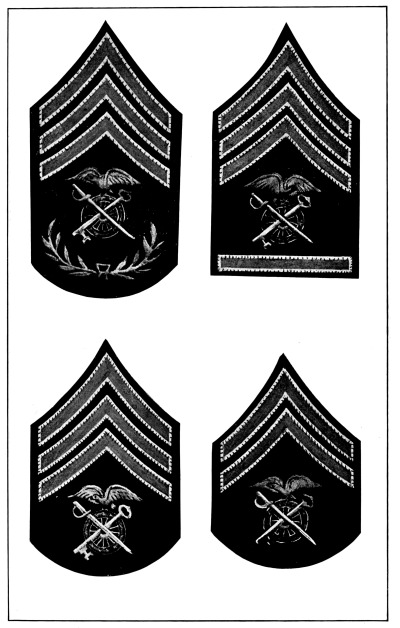
U. S. Army. Noncommissioned officers’ chevrons
Quartermaster Corps
| 1. Quartermaster Sergeant |
2. Sergeant, First Class |
| 3. Sergeant |
4. Corporal |
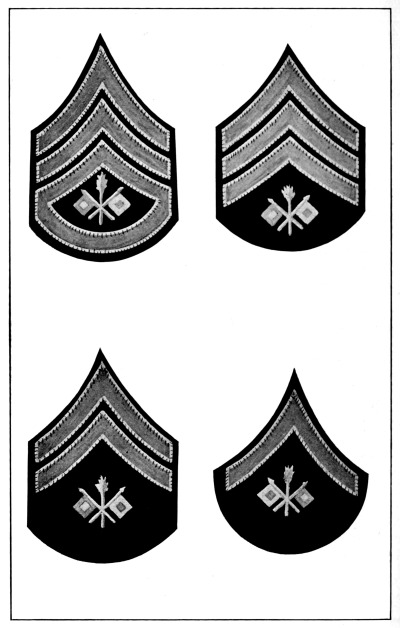
U. S. Army. Noncommissioned officers’ chevrons
Signal Corps
| 1. Sergeant, First Class |
2. Sergeant |
| 3. Corporal |
4. Lance Corporal |
[Pg 99]
Sergeant First Class, Signal Corps—Chevron of
three stripes with one arc of a circle below and the Signal Corps
insignia in the center.
Electrician Sergeant, First Class, Coast
Artillery—Chevron of three stripes with a wreath below it and a device
representing forked lightning in the center and a short stripe between
the wreath and the lightning.
Assistant Engineer, Coast Artillery—A device
representing an engine governor with a wreath below it.
Master Gunner, Coast Artillery—A projectile
placed vertically with a wreath below it and a star above it.
Band Sergeant and Assistant Leader of U. S.
Military Academy Band—Chevron of three stripes and two arcs of a circle
below them and a lyre in the center.
Assistant Band Leader—Chevron of three stripes
and one arc of a circle below them and a trumpet in the center.
Sergeant Bugler—Chevron of three stripes with a
bugle below them.
Electrician Sergeant Second Class, Coast
Artillery—Chevron of three stripes with a wreath below them and a
device representing forked lightning in the center.
Radio Sergeant—Chevron of three stripes with a
device representing forked lightning below them.
Color Sergeant—Chevron of three stripes with a
star below.
Sergeant—Chevron of three bars.
Company Supply Sergeant—Chevron of three stripes
with one horizontal bar below them.
Mess Sergeant—Chevron of three stripes with a
crescent below them.
Stable Sergeant—Chevron of three stripes with a
horse’s head below them.
Fireman, Coast Artillery—Chevron of one stripe
with one arc of a circle below it and a device representing the
governor of an engine in the center.
Corporal—Chevron of two stripes.
Lance Corporal (Acting Corporal)—Chevron of one stripe.
[Pg 100]
Chief Mechanic—Two hammers crossed with a wreath
below them.
Cook—A device representing a cook’s hat.
Artificer—Two hammers crossed.
Horseshoer—A horseshoe, toe up.
Mechanic—Two hammers crossed.
Saddler—A saddler’s round knife, edge up.
Wagoner—An eight spoke wheel.
Musician—A lyre.
Trumpeter—A bugle.
First class Private of Engineers—The castle
insignia of the Engineer Corps.
First class Private, Signal Corps—The Signal
Corps insignia, two crossed flags and a vertical torch.
First class Private Ordnance Corps—The Ordnance
Corps insignia, a bursting spherical shell.
First class Private Hospital Corps—The Hospital
Corps insignia, a caduceus.
First class Private, Quartermaster Corps—The
insignia of the Quartermaster Corps.
Casemate Electrician, Coast Artillery—A mine case
with a bar below it, enclosed in a circle.
Badge for Excellence at Target Practice, Coast
Artillery—The figure “1.”
Chief Planter, Coast Artillery—A mine case
enclosed in a circle.
First class Gunner, Gun Company, Coast
Artillery—A projectile, point up, with a bar below it.
Second class Gunner, Gun Company, Coast
Artillery—A projectile, point up.
First class Gunner, Mine Company, Coast
Artillery—A mine case with a bar below it.
Second class Gunner, Mine Company, Coast
Artillery—A mine case.
Gun Commander, Coast Artillery—Two crossed cannon
with a bar below, enclosed in a circle.
Gun Pointer, Coast Artillery—Two crossed cannon
enclosed in a circle.
Observer and plotter, Coast Artillery—An
equilateral triangle with a bar below it, enclosed in a circle.
Observer, Second Class, Coast Artillery—An
equilateral triangle enclosed in a circle.
First Class Private, Signal Corps—The crossed
flags and torch device of the Signal Corps.
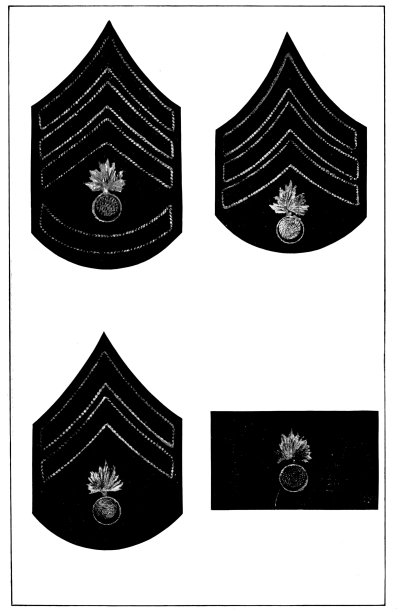
U. S. Army. Noncommissioned officers’ chevrons
Ordnance Corps
| 1. Ordnance Sergeant |
2. Sergeant of Ordnance Corps |
| 3. Corporal of Ordnance Corps |
4. First Class Private of |
| |
Ordnance Corps |
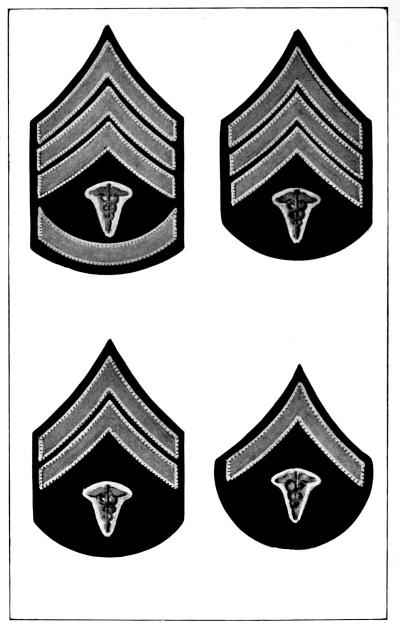
U. S. Army. Noncommissioned officers’ chevrons
Medical Corps
| 1. Sergeant, First Class |
2. Sergeant |
| 3. Corporal |
4. Lance Corporal |
[Pg 101]
Cap Insignia.—The insignia for the front of the caps of all enlisted
men are circular disks one and one-half inches in diameter with a
raised rim encircling the coat of arms of the United States, made of
gilt metal for dress caps and of bronze metal for service caps.
Collar Insignia.—The corps, department or arm of the service of
enlisted men of the U. S. Army is shown by insignia on the coat collars.
For blue dress and white coats these insignia, of gilt metal, worn
on each side of the neck opening, consist of block letters and special
devices in rear of the letters. The letters “U. S.” for Regular Army,
“U. S. V.” for Volunteer Army, “U. S. R.” for Enlisted Reserve Corps,
“U. S.” with “N. G.” superimposed for National Guard drafted into the
Federal service and “U. S.” with “N. A.” superimposed for National
Army. The special devices are:
Band Musician—A lyre with the numbers or
letters surcharged upon the face indicating the corps or regiment to
which the band belongs; for the Coast Artillery the number of the band,
for Engineer bands a castle, for Infantry, Cavalry and Field Artillery
bands the number of the regiment, for the Military Academy band the
letters “M. A.,” for bands of the Native Troops in the Philippines the
letter “P,” for the band of the Porto Rico regiment the letters “P. R.,”
for bands of Disciplinary Barracks the letters “D. B.” and for the
Recruiting Service bands the letters “R. S.”
Cavalry—Two sabers in their scabbards crossed
with the edges up, with the number of the regiment in the upper angle
and the letter of the troops in the lower angle.
Coast Artillery—Two cannon crossed with the
muzzles up, without the number of the company.
[Pg 102]
Field Artillery—Two cannon crossed with the
muzzles up, the number of the regiment in the upper angle and the letter
of the battery in the lower angle.
General Recruiting Service.—The letters “R. S.”
enclosed in a wreath with number of company below.
Electricians—A symbol representing forked
lightning.
Engineers—The turretted castle device of the
Engineer Corps with the number of the regiment above it and the letter
of the company on the face of the device.
Hospital Corps—The caduceus device.
Infantry—Two rifles crossed with muzzles up,
the number of the regiment in the upper angle and the letter of the
company in the lower angle, for the Porto Rico regiment the letters “P. R.”
in the upper angle and for Philippine Native Troops the letter “P.”
in the upper angle.
Ordnance Corps—A spherical shell flaming
at the top.
Quartermaster Corps—A sword and key crossed
on a wheel surmounted by an eagle.
Signal Corps—Two signal flags crossed
with a torch.
Service Schools and Military Academy
Detachments—Two disks with raised rim encircling on one a hammer
and quill crossed and one the letters “U. S.”
U. S. Military Academy Artillery Detachment—Two
cannon crossed with the letters “M. A.” in the upper angle and “D. E.
T.” in the lower angle.
U. S. Military Academy Cavalry Detachment—Two
sabres in their scabbards crossed with the letters “M. A.” in the upper
angle and “D. E. T.” in the lower angle.
U. S. Military Academy Engineer Detachment—The
turretted castle device of the Engineer Corps with the letters “M. A.”
above it and “D. E. T.” across the face.
Headquarters Company, Infantry, Cavalry and
Field Artillery—The distinctive insignia of the regiment to which
it belongs with the number of the regiment in the upper angle and the
letters “H. Q.” in the lower angle.
Machine Gun Company, Infantry, Cavalry and Field
Artillery—The distinctive insignia of the regiment to which it belongs
with the number of the regiment in the upper angle and the letters “M. G.”
in the lower angle.
Supply Company, Infantry, Cavalry and Field
Artillery—The distinctive insignia of the regiment to which it belongs
with the number of the regiment in the upper angle and the letter “S”
in the lower angle.
U. S. Army Disciplinary Barracks Guard—The
letters “D. B. G.” in gothic design enclosed in a wreath with the
letter of the company below.
Noncommissioned Officers of Disciplinary
Battalions—The letters “D. B.” in gothic design enclosed in a wreath
with the letter of the company below.
Noncommissioned Staff Officers of Engineers—The
turretted castle device of the Engineer Corps with the number of the
regiment above it.
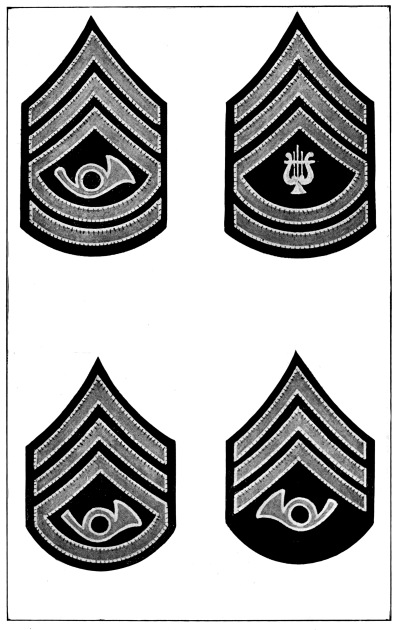
U. S. Army. Noncommissioned officers’ chevrons
| 1. Band Leader |
2. Assistant Leader, West Point Band |
| 3. Chief Trumpeter |
4. Sergeant, Band |
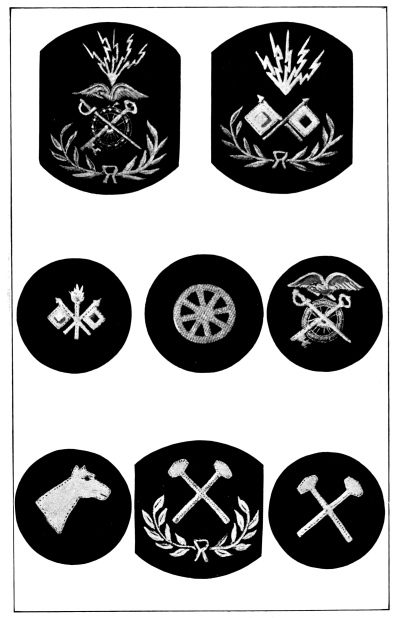
U. S. Army. Noncommissioned officers’ chevrons
| 1. Master Electrician, Quartermaster Corps |
| 2. Master Signal Electrician |
| 3. First Class Private, Signal Corps |
| 4. Wagoner |
| 5. First Class Private, Quartermaster Corps |
| 6. Farrier |
| 7. Chief Mechanic |
| 8. Mechanic or Artificer |
[Pg 103]
For Service coats the collar insignia consist of bronze metal disks
with a raised rim, worn on each side one inch from the neck opening.
The disk on the right side bears the letters “U. S.” with the number
of the regiment or, where there is no regimental organization, the
number of the unit if there is one. To designate men of the Volunteers,
Reserves, National Guard and National Army the letters “U. S.” have
superimposed upon them the letters “V,” “R,” “N. G.” or “N. A.”
respectively. The disk on the left side bears the special device of the
corps, department or arm of the service with the letter of the company,
battery or troop below it, except for the Engineers where the letter is
above the device. The special devices referred to are the same as the
gilt ones already described with the following exceptions:
Corps of Interpreters—The letters “INT.”
Machine Gun Battalions or Squadrons—The letters
“M. G.” in the upper angles of the crossed rifles or sabers.
Corps of Intelligence Police—The letters “I. P.”
Headquarters of Brigades and Higher Units—The
letter “H.”
Headquarters of Trains—The letter “T.”
[Pg 104]
General Recruiting Service—The letters “RS.”
Disciplinary Barracks Guard—The letters “DBG.”
Trench Mortar Organizations—Crossed cannon with the
letters “TM” in the upper angle.
Anti-aircraft Artillery—Crossed cannon with the
letters “AA” in the upper angle.
ARMY AVIATION SERVICE INSIGNIA
For officers these insignia are worn on the left breast and are as
follows:
Military Aviator—Two wings with a shield
between bearing the letters “U. S.” and a star above, embroidered
in silver on a blue background except the letters which are in gold
thread.
Junior Military Aviator and Reserve Military
Aviator—The same, omitting the star.
Military Aeronaut—Two wings with a balloon
between bearing the letters “U. S.” and a star above, embroidered in
white on a blue background except the letters which are in gold.
Junior Military Aeronaut and Reserve Military
Aeronaut—The same, omitting the star.
Observer—A letter “O” with a single wing on the
left of it embroidered in white on a blue background.
For enlisted men the insignia are embroidered in white on a blue sleeve
cap let in at the shoulder seam and extending down the sleeve 5½ inches:
Enlisted Aviator—Two wings with crossed
propellers between them and the number of the squadron above.
Aviation Mechanician—A circle enclosing crossed
propellers with the number of the squadron above.
Other Enlisted Men—The same,
omitting the circle.
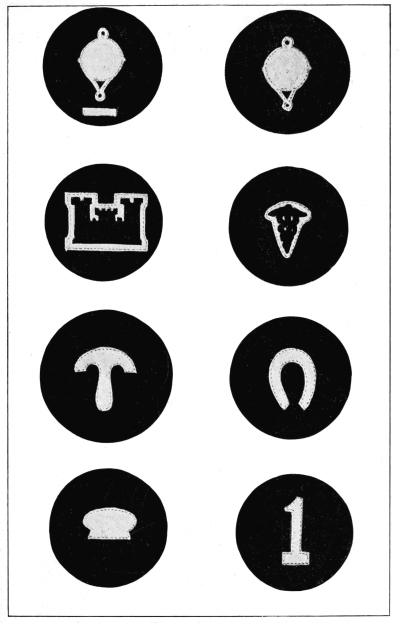
U. S. Army. Noncommissioned officers’ chevrons
| 1. First Class Gunner, Mine Company |
| 2. Second Class Gunner, Mine Company |
| 3. First Class Private, Engineer Corps |
| 4. First Class Private, Hospital Corps |
| 5. Saddler, Cavalry |
| 6. Horseshoer, Cavalry |
| 7. Cook |
| 8. Badge for Excellence in Target Practice, Coast Artillery |
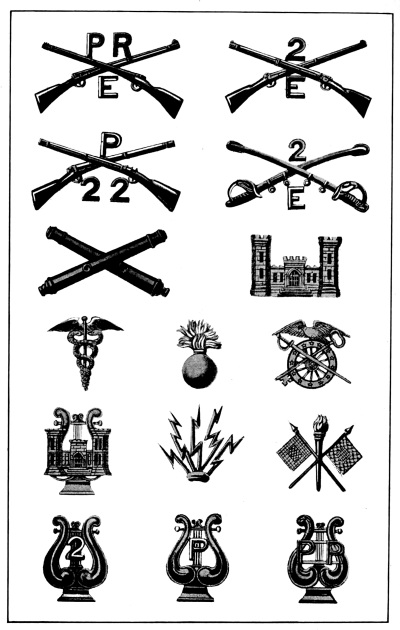
U. S. Army. Enlisted men’s insignia worn on dress coat collars
indicating arm of the Service, Corps or Department
| 1. Infantry, Porto Rico Regiment |
| 2. Infantry |
| 3. Native Philippine Troops |
| 4. Cavalry |
| 5. Artillery |
| 6. Engineer Corps |
| 7. Hospital Corps |
| 8. Ordnance Corps |
| 9. Quartermaster Corps |
| 10. Band Musician, Engineers |
| 11. Electrician |
| 12. Signal Corps |
| 13. Band Musician |
| 14. Band, Philippines |
| 15. Band, Porto Rico |
[Pg 105]
Brassards are bands of cloth worn on the sleeves to
designate officers and men assigned to special duties.
Red Cross Brassard.—In time of war with signatories of the Geneva
Convention all persons in the military services who are rendered
neutral by the terms of that convention wear upon the left arm above
the elbow a brassard of white cloth bearing upon it a Geneva cross
in red cloth while on duty in the field of operations. The persons
entitled to wear this brassard are surgeons, members of the hospital
corps, nurses, chaplains and the personnel engaged exclusively with the
removal and transportation of the sick and wounded.
Brassards worn on the right upper arm are of the following
distinctive colors: blue for agents and signalmen, green for guides
and scouts, red for orderlies and messengers, white for trench
cleaners, yellow for members of parties carrying munitions, material,
food or water, khaki with the word “Salvage” in red letters for
members of salvage parties, and blue with the letters “M. P.” outlined
in white thread for members of the Military Police.
Field Clerk’s Brassard.—Field clerks of Engineers wear upon the left
arm above the elbow a brassard of maroon colored cloth with white edges.
Service Stripes.—All enlisted men of the Army who have served one or
more enlistments in the Army, Navy or Marine Corps wear one stripe for
each such enlistment on each sleeve of the dress coat midway between
the wrist and the elbow. These service stripes are three-eighths of an inch
in width and are placed diagonally across the outside of the sleeve.
The color of the stripe is that of the branch of the service in which
the enlistment that it represents was served, as follows:
[Pg 106]
- Cavalry, yellow.
- Artillery, scarlet.
- Engineers, scarlet piped with white.
- Infantry, white.
- Hospital Corps, maroon piped with white.
- Ordnance, black piped with scarlet.
- Signal Corps, orange piped with white.
- Quartermaster Corps, buff.
- Service School Detachment, green.
- Service Detachment, Military Academy, green piped with white.
- U. S. Navy, scarlet piped with yellow.
- U. S. Marine Corps, yellow piped with scarlet.
Buttons.—The buttons worn by enlisted men of the Army on the dress
coat are of gilt metal and bear the coat of arms of the United States
in relief; those worn on the service coats are of the same size and
design but are made of dull finish bronze metal, and those worn on the
overcoat are large bronze flat buttons of the same design.
Identification Tag.—Each officer and enlisted man of the U. S. Army
is required to wear two aluminum identification tags about the size
of a silver half dollar whenever the field kit is worn, one tag to be
suspended from the neck underneath the clothing by a cord or thong
of leather passed through a hole in the tag, the second tag being
suspended from the first one by a cord or thong. Each tag bears stamped
upon it the name, rank, company, regiment and corps of the wearer. This
tag is for use in identifying the wearer in case of death or serious
wounds. In case of death one tag is buried with the body and the
duplicate is kept with the record of the place of burial and the cause
and date of death.
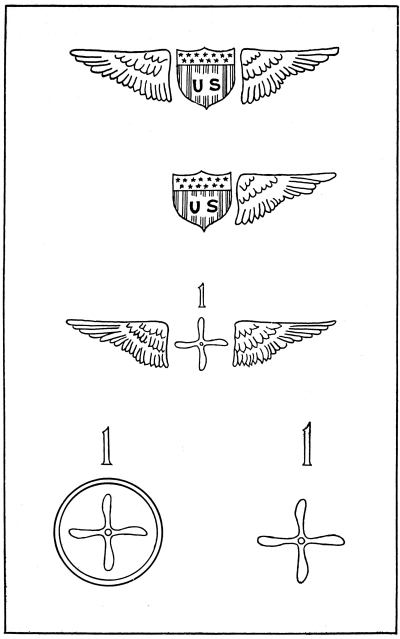
U. S. Army. Aviation Corps Insignia
1. Aviator (Regular aviators have a silver star above the shield.
Junior and Reserve aviators have no star) |
| |
| 2. Observer |
3. Enlisted Aviator |
| 4. Aviation Mechanic |
5. Other enlisted men |
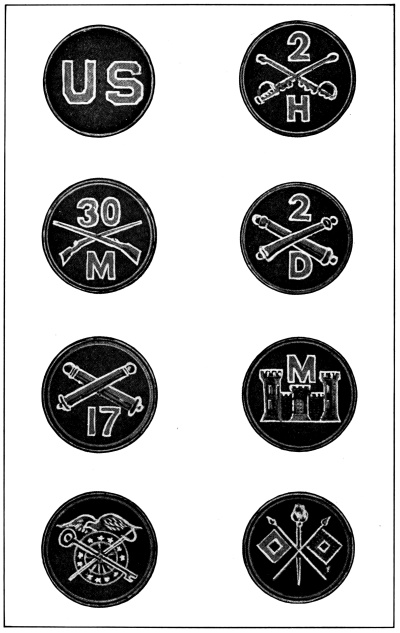
U. S. Army. Enlisted men’s insignia worn on collars of service coats
| 1. All enlisted men, right side of collar |
2. Cavalry |
| 3. Infantry |
4. Field Artillery |
| 5. Coast Artillery |
6. Engineer Corps |
| 7. Quartermaster Corps |
8. Signal Corps |
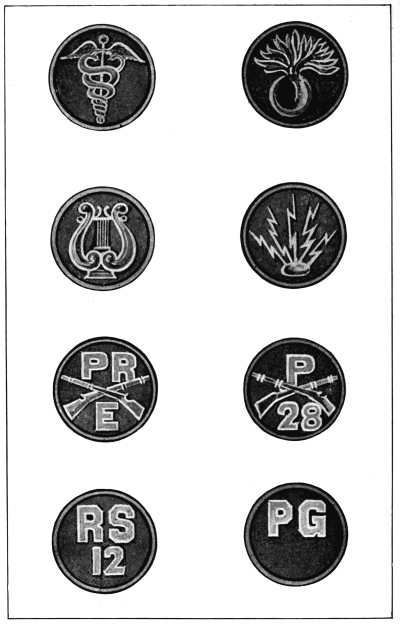
U. S. Army. Enlisted men’s insignia worn on collars of service coats
| 1. Hospital Corps |
2. Ordnance Corps |
| 3. Band Musician |
4. Electrician |
| 5. Infantry, Porto Rico Regiment |
6. Infantry, Native Troops, Philippines |
| 7. Recruiting Service |
8. Prison Guard |
[Pg 107]
Identification Patch.—In order that the men in an advance line of
attack upon the battlefield may be recognized by the officers who
are controlling their advance and accurately placing the curtain of
shrapnel fire ahead of them, it has become necessary to prescribe
identification patches upon the backs of the men’s coats between the
shoulders. These identification patches are of different designs
and colors to mark the different regiments and brigades, circles,
triangles, squares and other shapes being used. The shape and color of
these patches is not laid down in uniform regulations in the United
States Army, but these details are prescribed from time to time in
orders from Headquarters of the Field Armies.
United States Guards, National Army, are organized into battalions
for guard duty in the United States during the period of the existing
emergency. Their prescribed uniform is the blue dress uniform of the
regular army with blue overcoats and the customary insignia.
Citizen’s Training Camps.—The uniform for members of these camps
consist of olive-drab shirt, breeches and coat, canvas leggings, russet
shoes, and field hat with red, white and blue hat cord. The bronze
letters “U. S. T. C.” are worn on the collar, and on the left forearm a
badge with the same letters.
Reserve Officers’ Training Corps.—The uniforms are olive-drab or
“Cadet gray.” Insignia of rank are of white metal for cadet officers
and gilt for instructors; Colonel, three diamonds; Lieutenant
Colonel, two diamonds; Major, one diamond; Captain, three disks;
First Lieutenant, two disks, Second Lieutenant, one disk. Sergeants
and corporals wear chevrons prescribed for the Regular Army. On the cap
is a wreath enclosing the letters “R. O. T. C.” in bronze and the same
letters are worn on the collar. On the left arm is a badge with “R. O.
T. C.” embroidered in the color of the arm of the service.
[Pg 108]
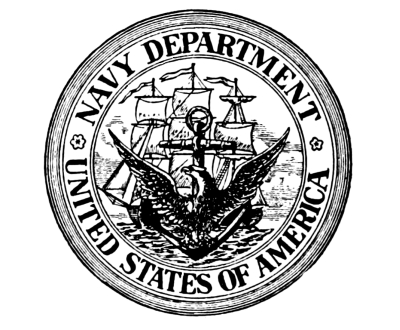
SEAL OF THE U. S. NAVY DEPARTMENT
CHAPTER V
UNIFORMS AND INSIGNIA
OF THE U. S. NAVY
The uniforms of the officers and enlisted men of the United States Navy
are made of dark blue cloth for wear in cold or temperate weather and
of white duck for wear in hot or tropical weather.
U. S. NAVAL OFFICERS’ UNIFORMS

Copyright, G. V. Buck, Washington, D. C.
Admiral William S. Benson
Chief of Naval Operations, United States Navy
Commissioned officers of the Navy are required
to have complete outfits of special full dress, evening dress, full
dress, undress, blue service dress and white service dress uniforms;
the occasions upon which the various uniforms are required to be
worn by officers of the Navy and the Marine Corps being given in the
official regulations as follows:
[Pg 109]
| |
| Occasion. |
Uniform. |
1. State occasions, at home or abroad. |
NAVY.—Special full dress, or white special full dress.
MARINE CORPS.—Special full dress (with full dress trousers, if in
line with troops), or white special full dress. |
2. Receiving or being received by the President, an ex-President, the
Vice President, or the Secretary of the Navy of the United States,
or the sovereign, chief executive or ruler of any country, or any
member of a royal family, or an ambassador of the United States or
of any country, at home or abroad. |
3. At ceremonies, solemnities, or entertainments, when desirable
to do special honor to the occasion. |
4. At general inspection on the first Saturday in the month.
In inclement weather, service dress may be prescribed. |
5. First visits to officers of flag rank, or exchanging
visits of ceremony with foreign officials. |
Navy.—Full dress, or white full dress.
Marine Corps.—Special full dress (with full dress
trousers, if in line with troops), or white full dress. |
6. Ceremonies, solemnities, or entertainments
where dress uniform is not sufficient.
[Pg 110] |
7. Reception of— |
Navy.—Dress, or white dress.
Marine Corps.— Special full dress (with full dress
trousers, if in line with troops), or white undress. |
(a) Assistant Secretary of the Navy. |
(b) Member of the President’s Cabinet other than the Secretary of the Navy. |
(c) Chief Justice of the United States. |
(d) Governor general of islands or groups of islands occupied by
the United States, visiting a ship or station officially,
within the waters or limits of his government. |
(e) Governor of one of the States or Territories of the United States,
visiting a ship or station within the waters or limits of his government. |
(f) President of the Senate. |
(g) Speaker of the House of Representatives. |
(h) Committee of Congress. |
(i) Envoy extraordinary and minister plenipotentiary, minister
resident, or other diplomatic representative of or above the
rank of chargé d’affaires, within the waters of the nation
to which he is accredited. |
(j) Flag officer going aboard his flagship to assume command;
also when he relinquishes command. |
8. First visit in port to commanding officers,
and ordinary occasions of duty and ceremony on shore. |
Navy.—Dress, or white dress.
Marine Corps.—Special full
dress (with full dress trousers, if in line with troops), or white undress. |
9. At Saturday morning inspection, except the first in the month. In inclement
or hot weather, service dress or white service dress may be prescribed,
in either case with swords. |
10. Reporting for duty. |
Navy.—Undress, or white undress.
Marine Corps.—Undress, or white undress. |
11. Serving as member of a general court-martial,
court of inquiry, examining or retiring board. |
Navy.—Undress, or white undress.
Marine Corps.—Undress,
or white undress, or field dress. |
| |
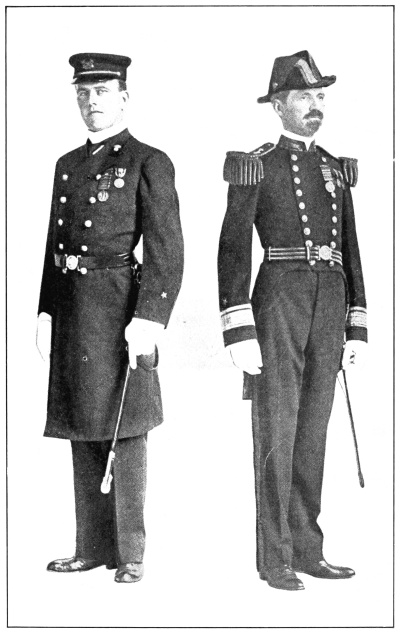
U. S. Naval officers’ special full dress uniform
GunnerRear Admiral

U. S. Naval officer. Full dress uniform
Rank: Lieutenant, indicated by the stripes on
the sleeve; the tops of the epaulets also bear the insignia of rank.
Corps: The Line of the Navy, indicated by the
star on the sleeve.
[Pg 111]
| |
| Occasion. |
Uniform. |
12. Serving as member of a summary court-martial. |
Navy and Marine Corps.—The
uniform of the day with side arms. |
13. Serving as judge advocate of a general court-martial, or court of inquiry,
recorder of a summary court-martial, deck court officer, member of a board|
other than an examining or retiring board, witness before a court or
board, counsel for the accused. |
Navy and Marine Corps.—The uniform of the day. |
14. Upon occasions of special ceremony, by officers on duty with enlisted
men under arms on shore, when the uniform prescribed for other officers|
is special full dress or full dress. |
Navy.—Undress with leggings,
or white undress with leggings.
Marine Corps.—Full dress, or white undress.
(No leggings ever to be worn with full dress.) |
15. Visiting foreign officers other than commanding officers. |
Navy.—Undress, or white undress, without swords.
Marine Corps.—Undress or white undress, without swords. |
16. At informal daytime receptions, to which officers are invited in their
official capacity, when frock coats are appropriate. |
17. At all times not otherwise provided for.
[Pg 112] |
Navy.—Service dress
or white service dress when suitable).
Marine Corps.—Undress
(or white undress when suitable) without swords. |
18. On duty with enlisted men under arms ashore,
except as specified in No. 14. |
Navy.—Service dress,
blue or white, as prescribed, and leggings, with swords (or revolvers or both).
Marine Corps.—Undress,
or field dress, with or without leggings, as prescribed; revolvers also if prescribed. |
19. When prescribed by the senior officer present. |
Navy.—White service
dress with blue trousers.
Marine Corps.—White undress
with blue undress trousers, without swords. |
20. At the option of and under restrictions imposed by the commanding officer,
when the uniform of the day is white service dress; to be worn only by officers
on board their own ship or at exercise in boats. |
21. Ceremonies in the evening to which officers are invited in their
official capacity, such as public balls, dinners, and evening receptions.
In hot weather, and in other circumstances where appropriate, dinner dress
may be prescribed. |
Navy.—Evening full dress.
Marine Corps.—Special full dress or mess dress. |
22. At informal evening occasions to which officers are
invited in their official capacity. In hot weather, or in other circumstances where
appropriate, mess dress may be prescribed. |
Navy.—Evening dress.
Marine Corps.—Mess dress. |
| |
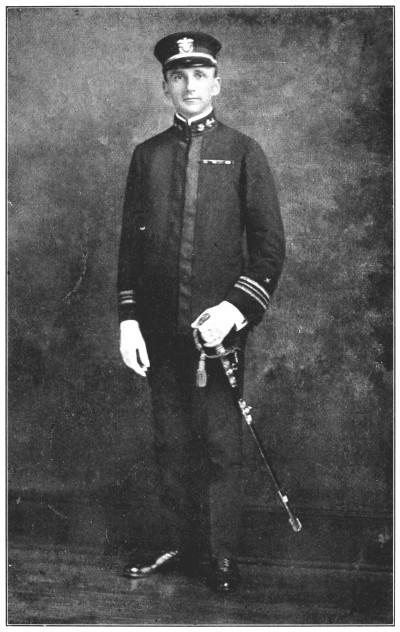
Photo by Harris & Ewing, Washington, D. C.
U. S. Naval officer. Blue service uniform
Rank: Lieutenant Commander, shown by the gold leaf on the collar
and the stripes on the sleeve.
Corps: Line of the Navy, shown by the anchor on the collar and
the star on the sleeve.
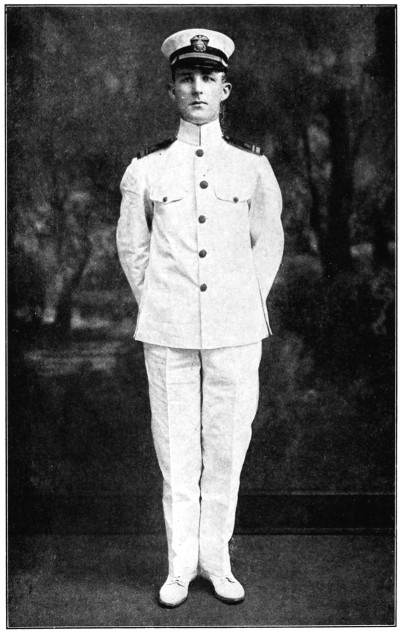
Photo by G. V. Buck, Washington, D. C.
U. S. Naval officer. White service uniform
Rank: Lieutenant Junior Grade, indicated by the stripes
on the shoulder marks.
Corps: The Line of the Navy, indicated by the stars
on the shoulder marks.
[Pg 113]
| |
| Occasion. |
Uniform. |
23. On occasions of ceremony, as in No. 19, or in hot weather and other
circumstances where appropriate, as a substitute for Uniform C. |
Navy.—Dinner dress.
Marine Corps.—Mess dress, with white mess jacket. |
24. On ordinary social occasions in the evening to which
officers are invited in their official capacity, and where hot weather and other
circumstances make it appropriate. |
Navy.—Mess dress.
Marine Corps.—Mess dress, with white mess jacket.
White trousers may be prescribed for both Navy and Marine Corps. |
25. When authorized under No. 21 by the commanding officer. |
| |
In time of war the uniform prescribed for all ordinary occasions of duty
is service dress, blue or white depending upon the temperature and weather.
The special full dress uniform consists of the cocked hat, a double
breasted coat with tails at the back only as is the case in the
ordinary civilian evening dress coat, trousers with gold stripes down
the outer leg seams, black shoes, gold epaulets and the sword carried
from a belt and slings of black cloth having gold stripes through it.
The full dress uniform consists of the same trousers, cocked hat,
sword and belt as for special full dress, with a double-breasted frock
coat with a rolling collar and lapels, and gold epaulets.
The evening dress uniform consists of a dark blue cloth evening dress
coat and a white waistcoat cut after the prevailing style for civilian
[Pg 114]
evening dress but fitted with gilt navy buttons, plain dark blue
trousers, black patent leather shoes and the blue or white cap.
Epaulets and full dress trousers (with the gold stripes on them) may be
prescribed, in which case the uniform is known as evening full dress
and the cocked hat is worn with it. For wear in hot weather a mess
jacket of white is prescribed, cut after the fashion of the evening
dress coat but without tails. The shoulder marks are worn with the mess
jacket to indicate corps and rank, and either white or blue trousers
may be worn with it.
The undress uniform consists of the frock coat without epaulets,
plain dark blue or white trousers, the blue or white undress cap, black
shoes and the sword carried from a black leather belt and slings.
The blue service dress uniform consists of a dark blue single
breasted coat extending to about eight inches below the waist, with
standing collar, buttoned up the front with the buttons concealed by a
fly-front, and trimmed around the collar, down the front, around the
bottom and up the side seams of the back with one and a quarter inch
black mohair braid, the undress cap, plain dark blue trousers and black
shoes. The white cap and white trousers are sometimes worn with the
blue service dress coat.
The white service dress uniform consists of a single-breasted
white duck coat extending to about eight inches below the waist, with
standing collar, buttoned up the front with five large size gilt navy
buttons, with a patch pocket on each breast closed by a flap at the
top buttoned by a small size gilt navy button, without braid trimming,
and having on each shoulder a shoulder strap (known in the service as
a “shoulder mark”) about five inches long and two and a quarter inches
wide bearing the insignia which indicates the corps or branch of the
Navy to which the wearer belongs and his rank as an officer, plain
white trousers, white cap and white shoes.
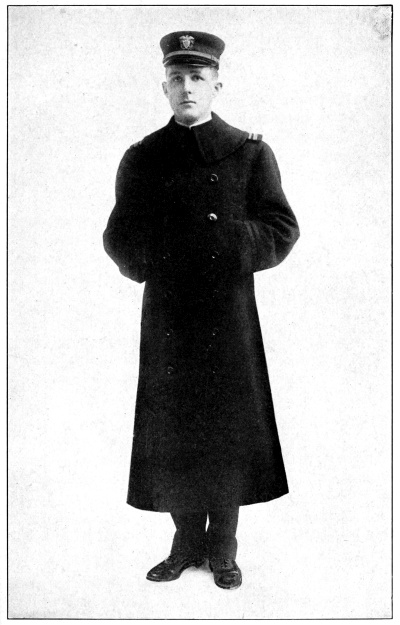
Photo by G. V. Buck, Washington, D. C.
U. S. Navy. Officer in overcoat
Rank: Lieutenant, indicated by the stripes
on the shoulder marks and on the sleeves
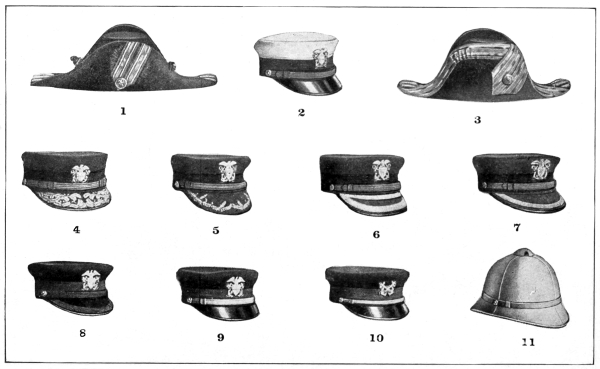
U. S. Naval officers’ cocked hats and caps
| 1. Cocked hat, commissioned officers below Flag rank. |
| 2. White cap, officers below rank of Commander. |
| 3. Cocked hat, Flag officers. |
| 4. Flag Officers’ cap. |
| 5. Cap, Captain and Commander. |
| 6. Cap, Staff Officers of Flag rank. |
| 7. Staff Officers, rank of Captain and Commander. |
| 8. Chaplain, rank of Captain and Commander. |
| 9. Cap of officers below rank of Commander. |
| 10. Cap, Warrant Officers. |
| 11. Tropical helmet (not worn at present). |
[Pg 115]
The winter service aviation uniform consists of a cap, coat, breeches
and spiral wrap puttees of forestry-green woolen cloth, and tan leather
shoes. The cap is exactly the same design and style as the white
service cap except that the material of the crown above the black
mohair band is of forestry-green cloth. The coat is the same as the
white service uniform coat except that the material is forestry-green
cloth. Standard navy gilt buttons are worn on this coat and the rank is
shown by shoulder marks the same as those worn with the white service coat.
NAVAL AVIATION CORPS INSIGNIA
The Naval Aviation Corps insignia consist of a vertical foul
anchor surcharged with a shield of the United States with eagle’s
wings extending to the right and left of it as shown in the above
illustration. These insignia are made of gilt metal and are worn upon
the left breast by all Aviators in the Naval Service, that is by
all officers and enlisted men of the Navy and Marine Corps who have qualified
as Aviators and are detailed to duty with the Naval Aviation Corps.
[Pg 116]
The summer service flying uniform for officers of the Navy detailed
for aviation duty and for officers of the Naval Reserve Flying Corps
consists of a khaki coat of the same style as the white service coat,
with which the shoulder marks indicating rank are worn, khaki breeches,
woolen wrap puttees of drab color, tan shoes, and a khaki cap of the
same style as the white cap.
The working uniform for officers detailed for aviation duty and for
officers of the Naval Reserve Flying Corps is a one-piece overall suit
of khaki-colored cotton duck, canvas or moleskin.
Dungarees (or overalls), consisting of a blue denim jacket and pair
of trousers, are worn by officers when working in engine and firerooms
and in turrets and magazines.
When the sword is worn with the service dress uniforms the belt is worn
under the coat unless the pistol is worn on the belt, in which case the
belt is worn outside of the coat.
White gloves are worn with all uniforms on dress occasions or when the
sword is worn except at battle drills or with landing forces on shore
expeditions.
The overcoat is a dark blue ulster-coat, reaching about midway from the
knee to the foot, double-breasted, buttoning to the neck with seven
large flat black buttons on each side, with a wide rolling collar, with
a pocket having a vertical opening on each side above the waist, and
fitted with waist straps at the back. Shoulder marks of the same design
as those for the white service coat are worn with the overcoat and the
rank of the wearer is indicated by stripes of black mohair braid on the
lower part of the sleeve. The overcoat is lined with black, and a hood
is provided to be worn over the head in very cold weather.
[Pg 117]
A boat cloak or cape of dark blue cloth, cut full, with a rolling
collar of black velvet is also provided for officers of the Navy.
The rain coat is a black mackintosh with a cape reaching to the tips
of the fingers when the arms hang naturally; and in rainy and wet
weather at sea officers usually wear rubber boots, oilskin coats and
“sou-wester” hats.
The cocked hat for officers of flag rank (admirals, vice admirals,
rear admirals and commodores) is of black silk beaver trimmed with gold
lace braid as shown in the illustration, figure 3;
and for all other commissioned officers, except chaplains and chief warrant
officers, it is trimmed around the outer edge of the top of the crown with
black silk lace braid as shown by figure 1.
The blue cap for flag officers is shown by figure 4,
and for captains and commanders by figure 5, the cap for officers of the Staff Corps
of the rank of rear admiral is shown by figure 6, and for
the same classes of officers of the ranks of captain and commander by figure 7.
The decorations on the visor shown in the illustrations are embroidered in
gold, with the exception of caps for chaplains of the ranks of captain
and commander, which have black embroidered bands as shown by figure 8.
The chin strap for all commissioned officers except chaplains is of
black leather covered with gold lace braid one-half inch wide; for
chaplains it is made of lustrous black mohair, as shown by figure 8.
The chin strap for warrant officers’ caps is one-quarter of an inch in
width, figure 10.
The cap device embroidered on the center and front of the caps of all
commissioned officers consists of a silver shield emblazoned paleways
of thirteen pieces, with chief strewn with stars, surmounted by a
silver spread eagle, the whole placed upon two crossed foul anchors in
[Pg 118]
gold, as shown by the illustration. The cap device for warrant
officers’ caps consists of the two crossed foul anchors in gold, as
shown by figure 10.
The blue cap for all commissioned officers below the rank of commander
has a plain black patent leather visor, figure 9.
The white caps for all officers are similar in shape to the blue caps,
the band, cap devices, chin straps and visor decorations for the
different corps and ranks being the same as for the blue caps of the
same officers, figure 2.
The cap for Warrant officers is the same as that for commissioned
officers except that the device worn on the front consists of two
gold foul anchors crossed and the chin strap of gold braid is but
one-quarter of an inch wide, figure 10.
INSIGNIA OF RANK AND CORPS
The rank of officers of the Navy is indicated in four ways: first, by
stripes upon the sleeves of the special full dress coat, frock coat,
evening dress coat, blue service coat and overcoat; second, by rank
insignia on each side of the front opening of the collar of the blue
service coat; third, by stripes upon the shoulder marks (or straps)
worn on the white service coat, the mess jacket and the overcoat; and
fourth, by rank insignia on the upper surface of the epaulets worn
with special full dress, full dress and evening dress. These stripes
indicating rank encircle the sleeves, the lower one being two inches
above the edge of the sleeve and parallel to it; on all blue coats
except the overcoat they are of gold lace braid, except for chaplains
who wear black braid stripes; and on the overcoats of all commissioned
officers they are of black mohair braid.
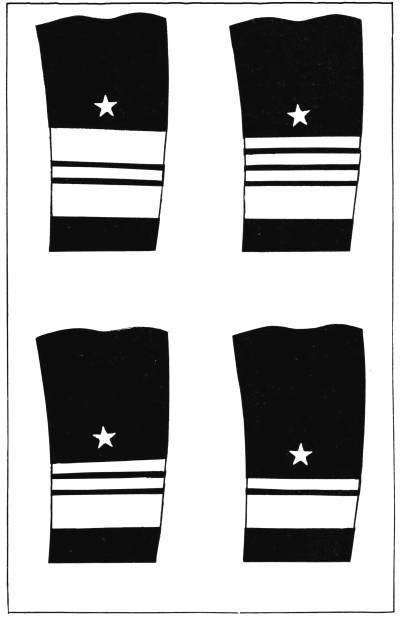
U. S. Navy. Officers’ sleeve braiding indicating rank
Gold braid on special full dress, full dress, evening dress and blue
service coats. Black braid on overcoats, without the stars
| 1. Admiral of the Navy |
2. Admiral |
| 3. Vice Admiral |
4. Rear Admiral |
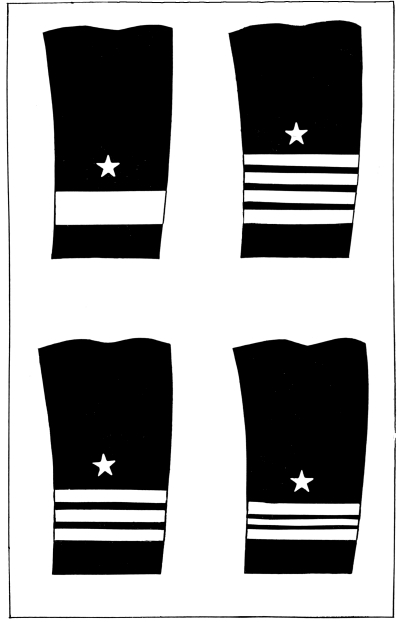
U. S. Navy. Officers’ sleeve braiding indicating rank
Gold braid on special full dress, full dress, evening dress and blue
service coats. Black braid on overcoats, without the stars
| 1. Commodore |
2. Captain |
| 3. Commander |
4. Lieutenant Commander |
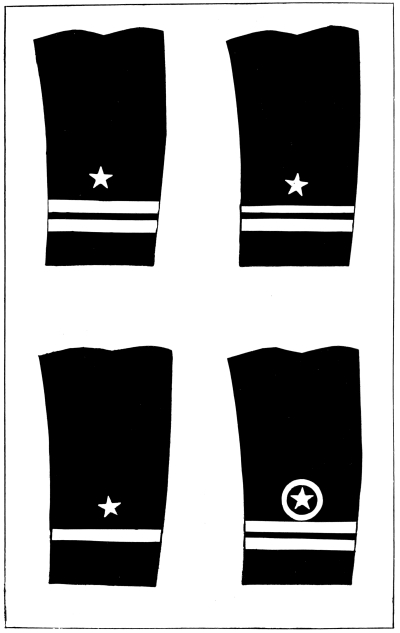
U. S. Navy. Officers’ sleeve braiding indicating rank
Gold braid on special full dress, full dress, evening dress and blue
service coats. Black braid on overcoats, without the stars
| 1. Lieutenant |
2. Lieutenant, Junior Grade |
| 3. Ensign |
4. Lieutenant, Naval Militia |
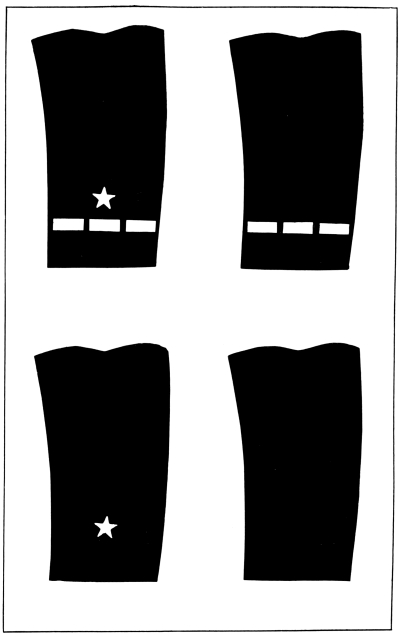
U. S. Navy. Officers’ sleeve braiding indicating rank
Gold braid on special full dress, full dress, evening dress and blue
service coats. Black braid on overcoats, without the stars
| 1. Chief Boatswain, Chief Gunner, Chief Machinist |
| 2. Chief Carpenter, Chief Sailmaker, Chief Pharmacist, Chief Pay Clerk |
| 3. Boatswain, Gunner, Machinist |
| 4. Carpenter, Sailmaker, Pharmacist, Pay Clerk, Mate |
[Pg 119]
The number, width and arrangement of the sleeve stripes indicating the
rank of officers, as illustrated, are as follows:
Admiral of the Navy, two stripes two inches wide with one stripe one
inch wide between them, the stripes being one-quarter of an inch apart.
Admiral, one stripe two inches wide with three stripes one-half an inch
wide above it, the stripes being one-quarter of an inch apart.
Vice Admiral, one stripe two inches wide with two stripes one-half an
inch wide above it, the stripes being one-quarter of an inch apart.
Rear Admiral, one stripe two inches wide with one stripe one-half an
inch wide above it, the stripes being one-quarter of an inch apart.
Commodore, one stripe two inches wide.
Captain, four stripes each one-half of an inch wide, set one-quarter of
an inch apart.
Commander, three stripes each one-half of an inch wide, set one-quarter
of an inch apart.
Lieutenant Commander, two stripes one-half of an inch wide with one
stripe one-quarter of an inch wide between them, the stripes being set
one-quarter of an inch apart.
Lieutenant, two stripes one-half of an inch wide set one-quarter
of an inch apart.
Lieutenant Junior Grade, one stripe one-half of an inch wide with one
stripe one-quarter of an inch wide set one-quarter of an inch above it.
Ensign, one stripe one-half of an inch wide.
The sleeve stripes for Chief Boatswain, Chief Gunner, Chief Machinist,
Chief Carpenter, Chief Sailmaker, Chief Pay Clerk and Chief Pharmacist
of the rank of Lieutenant Junior Grade or Ensign are of the same number
[Pg 120]
and widths as those prescribed for Lieutenants Junior Grade or Ensign,
except that when made of gold they are woven with dark blue silk thread
for widths of one-half inch at intervals of two inches.
The Corps or branch of the service to which the officer belongs is
indicated in connection with the rank stripes on the sleeves as follows:
All Line Officers wear a star embroidered in gold, one and one-eighth
inches in diameter, on the outside of each sleeve of the special full
dress coat, frock coat, evening dress coat and blue service coat, one
quarter of an inch above the rank stripes.
For Line Officers of the Naval Militia the gold star is surrounded by a
gold circle one and three-eighths inches in diameter.
Staff Officers wear the same sleeve rank stripes as those worn by the
Line Officers of the same rank but they do not wear the gold star. The
Corps to which Staff Officers belong is indicated by bands of colored
cloth around the sleeves filling the intervals between the gold rank
stripes, the colors and material of the stripes for the different corps
being as follows:
- Medical Officers—dark maroon velvet.
- Pay Officers—white cloth.
- Professors of Mathematics—olive green cloth.
- Naval Constructors—dark violet cloth.
- Civil Engineers—light blue velvet.
- Medical Reserve Officers—crimson cloth.
- Dental Officers—orange colored velvet.
When but one stripe is worn, that is for officers of the rank of
ensign, the colored cloth is made to show one-quarter of an inch on
each side of the stripe.
For Staff Officers of the Naval Militia the colored corps stripes are
broken for a distance of one and one-quarter inches at the center of
the front of the sleeve.
[Pg 121]
The rank and corps of officers is shown on the blue service coat in two
ways: first, by the stripes on the sleeves as above described; second,
by rank and corps insignia worn on each side of the standing collar, to
the right and left of the front opening at the neck.
These collar insignia are as illustrated, and consist of the insignia
of rank in combination with the device indicating the corps of the
wearer.
The Corps device or insignia, indicating to what corps or branch of the
service the officer belongs, are:
Line Officers: a silver foul anchor, one and five-eighths inches
long over all, one inch wide from tip to tip.
Medical Corps Officers: a silver acorn embroidered upon a gold spread
oak leaf, stem to tip one and three-quarters inches, width one inch.
Pay Corps Officers: a silver oak sprig of three leaves and three
acorns, one and three-quarters inches long by one inch wide.
Professors of Mathematics: a silver oak leaf and an acorn,
one and three-quarters inches long and one inch wide.
Naval Constructors Corps: a gold sprig of two live-oak leaves and
an acorn, one and five-eighths inches long and one and three-eighths
inches wide.
Civil Engineers Corps: two crossed silver sprigs, each of two
live-oak leaves and an acorn, one and three-quarter inches long and one
inch wide.
Chaplains: a Latin cross embroidered in silver.
Medical Reserve Corps: a gold acorn embroidered upon a silver spread
oak leaf, one and three-quarters inches long and one inch wide.
[Pg 122]
Dental Corps: a gold spread oak leaf with a silver acorn on either
side of the stem, one and three-quarter inches long and one inch wide.
The rank insignia, indicating the rank of the wearer, are practically
the same as those for the Army and the Marine Corps, and are as follows:
- Admiral—four silver stars.
- Vice Admiral—three silver stars.
- Rank of Rear Admiral—two silver stars.
- Rank of Commodore—one silver star.
- Rank of Captain—a silver spread eagle.
- Rank of Commander—a silver oak leaf.
- Rank of Lieutenant Commander—a gold oak leaf.
- Rank of Lieutenant—two silver bars.
- Rank of Lieutenant Junior Grade—one silver bar.
- Rank of Ensign—no insignia.
- Midshipman—a gold anchor.
The insignia indicating the rank and corps of officers are worn on each
side of the collar of the blue service coat as illustrated; for Line
Officers they are as follows:
Admiral of the Navy—four silver stars, the two end stars being
surcharged upon gold foul anchors.
Admiral—four silver stars, the star nearest the back being
surcharged upon a gold foul anchor.
Vice Admiral—three silver stars with a silver foul anchor in
rear of them.
Rear Admiral—two silver stars with a silver foul anchor in
rear of them.
Commodore—one silver star with a silver foul anchor in rear of it.
Captain—a silver spread eagle with a silver foul anchor in
rear of it.
Commander—a silver oak leaf with a silver foul anchor in rear of it.
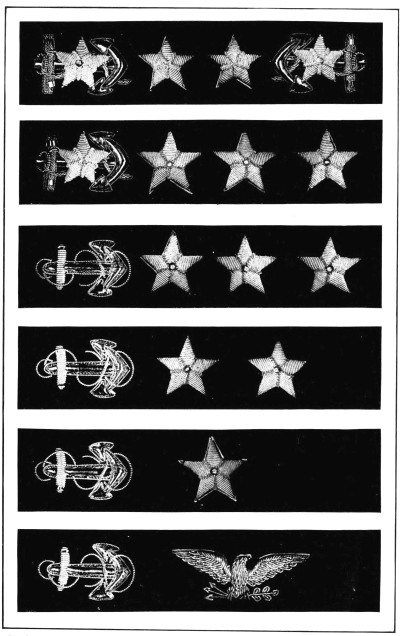
U. S. Navy. Officers’ insignia of rank and Corps on collar
of blue service coat, showing right side of collar
| 1. Admiral of the Navy |
2. Admiral |
| 3. Vice Admiral |
4. Rear Admiral |
| 5. Commodore |
6. Captain |
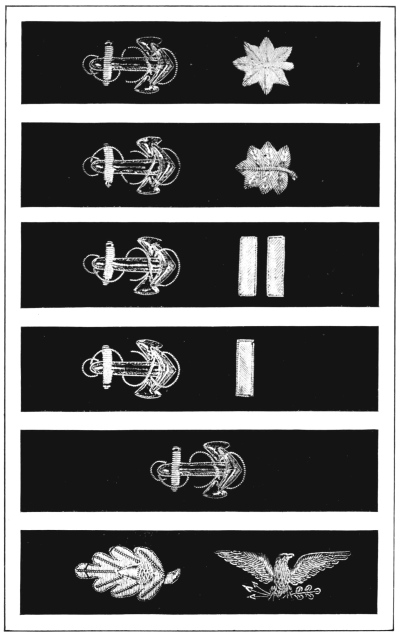
U. S. Navy. Officers’ insignia of rank and Corps on collar
of blue service coat, showing right side of collar
| 1. Commander (Silver leaf) |
2.Lieutenant Commander (Gold leaf) |
| 3. Lieutenant |
4. Lieutenant, Junior Grade |
| 5. Ensign |
6. Medical Officer with the rank of Captain |
[Pg 123]
Lieutenant Commander—a gold oak leaf with a silver foul anchor in
rear of it.
Lieutenant—two silver bars vertical with a silver anchor
in rear of them.
Lieutenant, Junior Grade—one silver bar vertical with a
silver foul anchor in rear of it.
Ensign—a silver foul anchor.
Staff Officers of all ranks wear the Corps device or insignia
indicating the particular corps to which they belong (as described
on page 121) in place of the silver foul anchor above described and
the same rank insignia for the different ranks as described for Line
Officers. Thus, a Medical Director with the rank of Captain wears the
silver spread eagle indicating the rank and the Medical Corps device
of the silver acorn upon the gold leaf indicating the Medical Corps;
a Pay Director with the rank of Captain wears the silver spread eagle
indicating the rank and the silver oak sprig of three leaves and three
acorns indicating the Pay Corps; a Chaplain with the rank of Commander
wears the silver leaf indicating the rank and the silver Latin cross
indicating his corps; a Professor of Mathematics with the rank of
Commander wears the silver leaf indicating the rank and the silver
oak leaf and acorn indicating the corps; a Naval Constructor with the
rank of Commander wears the silver leaf indicating the rank and the
silver two live-oak leaves and acorn indicating the Construction Corps;
a Civil Engineer with the rank of Commander wears the silver leaf
indicating the rank and the silver crossed live-oak leaves indicating
the Corps of Civil Engineers; and a Dental Surgeon with the rank of
Lieutenant wears the two silver bars indicating the rank and the gold
oak leaf and silver acorns indicating the Dental Corps.
[Pg 124]
The insignia showing the corps of the Chief Boatswain, Chief Gunner,
Chief Machinist, Chief Carpenter, Chief Sailmaker, Chief Pharmacist and
Chief Pay Clerk consist of devices worn on each side of the collar of
the frock coat just above the V notch in the lapel, as follows:
Chief Boatswain—two foul anchors crossed, embroidered in silver,
surcharged at the center by a gold five-pointed star.
Chief Gunner—a flaming spherical shell, embroidered in silver,
surcharged at the center by a gold five-pointed star.
Chief Machinist—a three-bladed propeller embroidered in silver,
surcharged at the center by a gold five-pointed star.
Chief Carpenter—a carpenter’s square, embroidered in silver with
the point down.
Chief Sailmaker—a diamond embroidered in silver.
Chief Pharmacist—a caduceus, embroidered in silver.
Chief Pay Clerk—an oak sprig of three leaves and three acorns,
embroidered in silver.
The Corps of Warrant Officers is also shown by corps devices worn on
each side of the collar of the frock coat just above the V notch in the
lapel, as follows:
Boatswain—two foul anchors crossed, embroidered in gold, surcharged
at the center by a silver five-pointed star.
Gunner—a flaming spherical shell, embroidered in gold, surcharged
at the center by a silver five-pointed star.
Machinist—a three-bladed propeller, embroidered in gold, surcharged
at the center by a silver five-pointed star.
Carpenter—a carpenter’s square embroidered in gold with the point down.
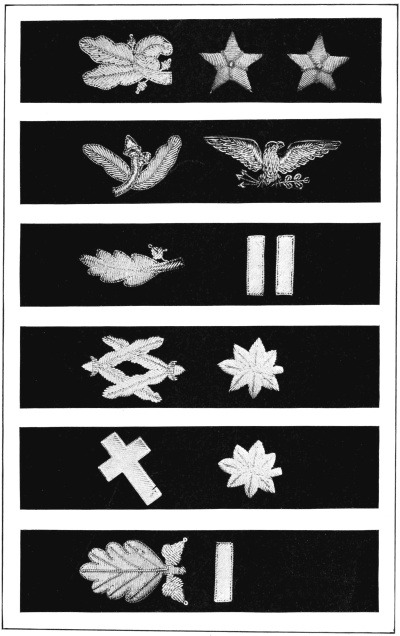
U. S. Navy. Officers’ insignia of rank and Corps on collar
of blue service coat, showing right side of collar
| 1. Officer of the Pay Corps with the rank of Rear Admiral |
| 2. Naval Constructor with the rank of Captain |
| 3. Professor of Mathematics with the rank of Lieutenant |
| 4. Civil Engineer with the rank of Commander |
| 5. Chaplain with the rank of Commander |
| 6. Dental Surgeon with the rank of Lieutenant, Junior Grade |
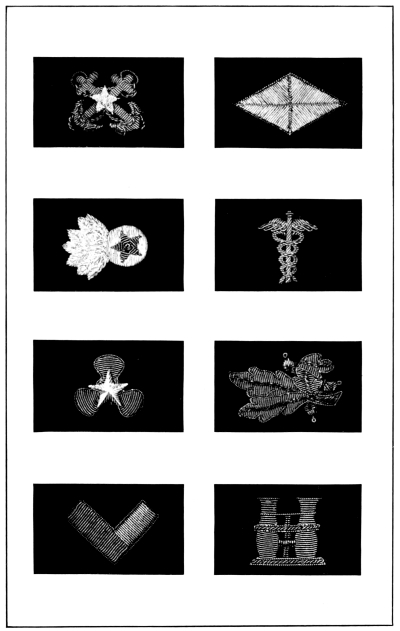
U. S. Navy. Officers’ insignia of rank and Corps on collar
of blue service coat, showing right side of collar
| 1. Chief Boatswain and Boatswain |
| 2. Chief Sailmaker and Sailmaker |
| 3. Chief Gunner and Gunner |
| 4. Chief Pharmacist and Pharmacist |
| 5. Chief Machinist and Machinist |
| 6. Chief Pay Clerk and Pay Clerk |
| 7. Chief Carpenter and Carpenter |
| 8. Mate |
[Pg 125]
Sailmaker—a diamond embroidered in gold.
Pharmacist—a caduceus embroidered in gold.
Pay Clerk—an oak sprig of three leaves and three acorns embroidered
in gold.
Mate—a binocular glass, embroidered in gold for a Mate of less than
twenty years’ service and in silver for a Mate of over twenty years’ service.
Chief Boatswains, Chief Gunners and Chief Machinists, being Line
Officers, wear the gold star above the sleeve stripes; while Chief
Carpenters, Chief Sailmakers, Chief Pharmacists and Chief Pay Clerks,
being Staff Officers, do not wear the star on the sleeve.
Boatswains, Gunners and Machinists, being Warrant Officers of the
Line wear the gold star on the sleeve, but no stripes. Carpenters,
Sailmakers, Pharmacists and Pay Clerks have the sleeves of the coat
without decoration or insignia.
Chief Boatswains, Chief Gunners, Chief Machinists, Chief Carpenters,
Chief Sailmakers, Chief Pharmacists and Chief Pay Clerks wear on the
collars of their blue service coats the same devices showing their
corps as those already described to be worn upon the collars of their
frock coats; and the same is true of the Warrant Officers, Boatswains,
Gunners, Machinists, Carpenters, Sailmakers, Pharmacists, Pay Clerks
and Mates.
Shoulder marks for officers are worn on the white service coat, mess
jacket and overcoat to indicate the corps and rank of the wearer. These
marks are of dark blue cloth lined with black silk, stiffened so as
to lie flat, 4½ to 5¼ inches long and 2¼ inches wide, finished with a
triangular point and a gilt Navy button at the collar end, and they are
worn on the top of each shoulder extending from the base of the collar
to the shoulder seam.
[Pg 126]
The designs for the different ranks are as shown in the illustrations.
For officers of the Line they are as follows:
Admiral of the Navy—covered with gold lace braid two inches wide,
with four silver stars, the two end stars being surcharged upon gold
foul anchors.
Admiral—covered with gold lace braid two inches wide, with four
silver stars, the one nearest the collar end being surcharged upon a
gold foul anchor.
Vice Admiral—covered with gold lace braid two inches wide, with a
silver foul anchor and three silver stars, the anchor being nearest the
collar end.
Rear Admiral—covered with gold lace braid two inches wide, with two
silver stars and a silver foul anchor between them.
Commodore—covered with gold lace braid two inches wide, with one
silver star and a silver foul anchor, the anchor being nearest the
collar end.
Captain—a gold star at the collar end and four stripes of gold lace
braid one-half of an inch wide, set one-quarter of an inch apart.
Commander—a gold star and three stripes of gold lace braid one-half
of an inch wide, set one-quarter of an inch apart.
Lieutenant Commander—a gold star and two stripes of gold lace braid
one-half of an inch wide with one such stripe one-quarter of an inch
wide, between them, stripes set one-quarter of an inch apart.
Lieutenant—a gold star and two stripes of gold lace braid one-half
of an inch wide, set one-quarter of an inch apart.
Lieutenant Junior Grade—a gold star and one stripe of gold lace
braid one-half of an inch wide and one stripe one-quarter of an inch
wide, set one-quarter of an inch apart.
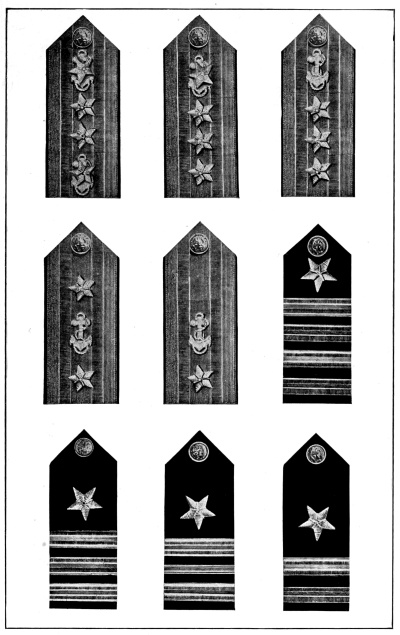
U. S. Navy. Officers’ shoulder marks indicating rank.
Worn on the white service uniform coat,
the white mess
jacket and the overcoat
| 1. Admiral of the Navy |
2. Admiral |
3. Vice Admiral |
| 4. Rear Admiral |
5. Commodore |
6. Captain |
| 7. Commander |
8. Lieutenant Commander |
9. Lieutenant |

U. S. Navy. Officers’ shoulder marks indicating rank.
Worn on the white service uniform coat,
the white mess
jacket and the overcoat
| 1. Lieutenant, Junior Grade |
2. Ensign |
3. Chief Boatswain |
| 4. Chief Gunner |
5. Chief Machinist |
6. Chief Carpenter |
| 7. Chief Pharmacist |
8. Chief Pay Clerk |
9. Chief Sailmaker |
[Pg 127]
Ensign—a gold star and one stripe of gold lace braid one-half of an inch wide.
For officers of the Staff Corps of the rank of Rear Admiral or
Commodore the shoulder marks are the same as those for Rear Admiral or
Commodore of the Line, except that in place of the silver anchor the
corps device indicating the corps to which the officer belongs is used.
For officers of the Staff Corps below the rank of Commodore the
stripes for the different ranks are the same as those described for
officers of the Line but the star is omitted, the Corps to which the
officer belongs being indicated by stripes of colored cloth filling the
spaces between the gold stripes, the colors and materials being as follows:
- Medical Corps Officers—dark maroon velvet.
- Pay Corps Officers—White cloth.
- Professors of Mathematics—olive green cloth.
- Naval Constructors—dark violet cloth.
- Civil Engineers—light blue velvet.
- Medical Reserve Officers—crimson cloth.
- Dental Officers—orange colored velvet.
The shoulder marks for Chief Boatswain, Chief Gunner, Chief Machinist,
Chief Carpenter, Chief Sailmaker, Chief Pharmacist and Chief Pay Clerk,
bear the gold stripes indicating their rank of the same width and
position as in the case of other officers of their rank, except that
the gold stripe is broken at the center by a section of one-half of an
[Pg 128]
inch embroidered in dark blue silk, and the corps is shown by the
insignia as described for each on page 124 to be worn
on the collars of the frock coats. The insignia in each case are placed on
the center of the strap above the stripe.
The shoulder marks for Warrant Officers, Boatswains, Gunners,
Machinists, Carpenters, Sailmakers, Pharmacists and Pay Clerks, bear
the same insignia indicating the corps of the wearer as those for the
Chief Boatswains, Chief Gunners, Chief Machinists, Chief Carpenters,
Chief Sailmakers, Chief Pharmacists and Chief Pay Clerks, but the gold
stripes indicating rank are omitted.
The shoulder marks for Mates bear a binocular glass embroidered
in gold for mates of less than twenty years’ service and in silver for
those of over twenty years’ service.
The rank and corps of officers of the Navy is shown upon the gold
epaulets worn with special full dress, full dress and evening full
dress uniforms by the regular rank and corps insignia placed upon the
top of the epaulet. These insignia are the same for the different ranks
or grades as those worn on the collars of the blue service coats.
For Officers of the Staff the epaulets have the same insignia
for indicating the rank as in the case of the corresponding rank of
officers of the Line, but to indicate the particular corps to which the
wearer belongs the proper Corps insignia or devices are substituted in
the place of the silver foul anchors worn by officers of the Line.
The gilt buttons worn by officers of the Navy upon the coats for which
they are prescribed bear in relief an eagle with wings lifting above an
anchor placed horizontal; surrounded by thirteen five-pointed stars and
a plain circle.
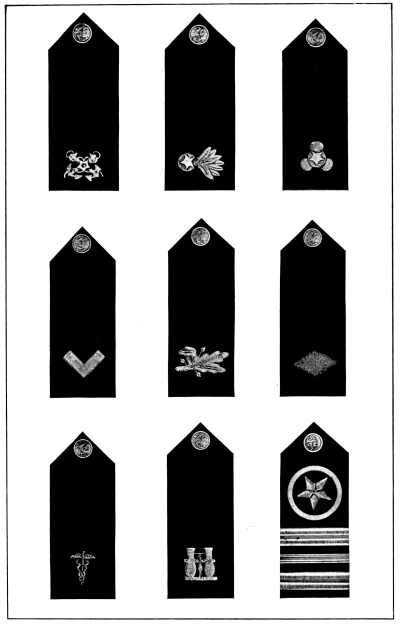
U. S. Navy. Officers’ shoulder marks indicating rank.
Worn on the white service uniform coat,
the white mess
jacket and the overcoat
| 1. Boatswain |
2. Gunner |
3. Machinist |
| 4. Carpenter |
5. Pay Clerk |
6. Sailmaker |
| 7. Pharmacist |
8. Mate |
9. Lieutenant Commander, |
| |
|
Naval Militia |

U. S. Navy. Cap insignia
| 1. Commissioned officers |
2. Warrant officers |
Service Buttons for Officers |
| 3.U. S. Navy |
4. U. S. Naval Reserve |
| 5. U. S. Coast Guard |
6. U. S. Public Health Service |
| |
7. Collar insignia, Lieutenant, U. S. Naval Reserve,
showing left side of collar |
[Pg 129]
Aiguilettes worn by Naval Officers are loops of plaited blue and gold
cord terminating in gilt metal ornaments decorated with silver anchors.
They are worn by personal aids to the President and the Secretary of
the Navy, aides at the White House, members of the personal staff of a
Flag Officer in command of a fleet or subdivision of a fleet, and by
aides to the Commandants of Naval Stations and the Superintendent of
the Naval Academy.
The personal aides to the President wear the aiguilettes on the right
side and all other officers for whom they are prescribed wear them on
the left side.
They are worn with all uniforms to indicate the special duty of the
wearer as an aide entitled to convey the orders of the officer to whose
staff he is assigned.
The Sword knot for naval officers is a loop of gold braid ending in
a bullion tassel, worn on the hilt of the sword. The original purpose
of this loop was to wear it around the right wrist when the sword was
carried in the hand to prevent the loss of the sword if it should be
accidentally dropped or knocked from the hand in combat. The sword knot
is worn by commissioned officers only.
Officers of the Line and of the Staff Corps of the Naval Reserve
Force wear the same rank marks as those described for the officers
of the regular Navy, but, instead of the silver anchor for the Line
Officers and the various Corps devices and insignia to indicate the
Corps or branch of the service of the Staff officers of the Staff of
the regular Navy, they wear the Naval Reserve Force device on the
collar of the blue service coat.
[Pg 130]
The Naval Reserve Force Device or insignia is of the same design as the
device worn on the front of the cap by commissioned officers of the
Navy. It is one inch in height, made of metal, the shield and eagle
being of silver and the crossed anchors of gold.
The gilt buttons worn by officers of the Naval Reserve Force are of the
same sizes as those worn by the officers of the regular service but
the design is different, and by this design the fact that an officer
is a member of the Naval Reserve Force is shown when he is wearing any
uniform having gilt buttons. The Naval Reserve Force gilt button for
officers bears a plain vertical anchor and the letters U. S. N. R., as
illustrated.
UNIFORMS AND INSIGNIA OF MIDSHIPMEN
The Corps of Midshipmen at the Naval Academy is organized into a
regiment of four battalions of four companies each for military
formations and drills, with Midshipmen Officers and Petty Officers, as
follows:
| Midshipman Commander |
Commanding the Regiment. |
| Midshipman Lieutenant Commander |
Commanding a Battalion. |
| Midshipman Lieutenant |
Regimental Adjutant and Company Commander. |
| Midshipman Junior Lieutenant |
Regimental Commissary and Regimental Signal Officer,
Battalion Adjutant, and junior Company officer. |
| Midshipman Ensign |
Regimental Aide, Battalion Commissary,
and junior Company officer. |
| Midshipman Regimental Staff Petty Officer. |
| Midshipman Battalion Staff Petty Officer. |
| First Petty Officer. |
| Second Petty Officer. |
| First-Class Petty Officer. |
| Second-Class Petty Officer. |
[Pg 131]
The Midshipmen are provided with uniform as follows:
Full dress—consisting of a dark blue double-breasted jacket cut to
reach just below the waist, roached at the sides over the hips, pointed
at front and back, with standing collar and two rows of gilt buttons
down the front and three gilt buttons on each cuff; dark blue trousers,
a blue cap similar to that worn by other naval officers, white gloves
and black shoes.
Service dress—consisting of a dark blue blouse coat similar in
cut and design to the blue service coat of other officers; dark blue
trousers, the blue cap and black shoes.
White service dress—consisting of a white duck coat with gilt
buttons similar in cut and style to the white service coat of other
officers, white duck trousers, white cap and white shoes.
Khaki undress—consisting of a khaki blouse, trousers and cap.
Working dress—consisting of khaki blouse and trousers and white hat.
Working undress—consisting of khaki shirt and trousers and white hat.
The overcoat is an ulster of dark blue cloth, double-breasted,
buttoning to the neck with two rows of gilt buttons on the front with a
wide rolling collar.
The insignia of the Corps of Midshipmen are a gold anchor worn on the
full dress jacket and blue service coat on each side of the collar near
the front. All Midshipmen attaining above 85 per cent in standing also
wear a gold star on each side of the collar.
[Pg 132]
The rank of Midshipman Officers is indicated by stripes of gold braid
one-eighth of an inch wide sewn around the sleeves of the full dress
jacket, service coat and overcoat, the lower stripe being about two
inches from the lower edge of the sleeve, the number of stripes for the
different grades being:
| Midshipman Commander |
Five stripes one-quarter of an inch apart. |
| Midshipman Lieutenant Commander |
Four stripes one-quarter of an inch apart. |
| Midshipman Lieutenant |
Three stripes one-quarter of an inch apart. |
| Midshipman Junior Lieutenant |
Two stripes one-quarter of an inch apart. |
| Midshipman Ensign |
One stripe. |
All Midshipman Officers also wear a gold star one inch in diameter
three-fourths of an inch above the upper stripe on each sleeve.
The rank of Midshipman Petty Officers is indicated by devices
embroidered in gold upon the sleeves, above the elbow, of the full
dress jacket, undress coat and overcoat, indicating the different
grades as follows:
Regimental staff petty officer—an eagle and an anchor, surmounted by
three stars placed pyramidally, with a chevron of three stripes below
the anchor.
Battalion staff petty officer—the same as for regimental staff petty
officer except there are but two stars.
First and Second Petty Officers—the same as for staff petty officers
except there is but one star.
First-class Petty Officer—the same as for first and second petty
officers except that the chevrons are omitted.
Second-class Petty Officer—the same as for first-class petty
officers except that the star is omitted.
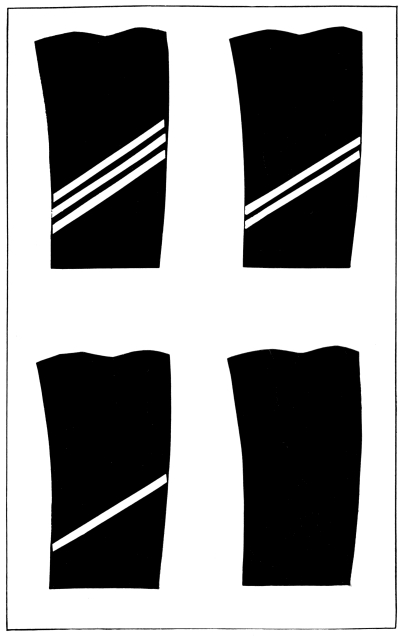
U. S. Navy. Midshipmen. Sleeve stripes indicating class
Gold stripes on the sleeves of the dress coat,
undress coat and overcoat
| 1. First Class |
2. Second Class |
| 3. Third Class |
4. Fourth Class |
[Pg 133]
The midshipmen are divided into four classes, according to the
year’s course, the first class corresponding to seniors at college,
the second class corresponding to juniors at college, the third
class corresponding to sophomores at college and the fourth class
corresponding to freshmen at college.
To distinguish the class to which they belong all midshipmen, except
Midshipman Officers and petty officers and fourth classmen, wear
service stripes of gold braid one-eighth of an inch wide diagonally
across the outside of each sleeve of the full dress jacket, service
coat and overcoat from front seam to rear seam, each stripe indicating
one year of service at the Naval Academy; thus, the first classmen have
three stripes, the second classmen two stripes, the third classmen one
stripe, and the fourth classmen plain sleeves with no stripes.
ENLISTED MEN’S UNIFORMS, U. S. NAVY
Enlisted men of the Navy are required to have complete outfits of blue
dress, white dress, blue undress, white undress and working dress.
Dungaree suits are prescribed for the engineers force and for men of
the Artificer Branch. Rain clothes are allowed for the deck force and
men who are required to do duty where they would require them.
The occasions upon which the different uniforms of the United States
Navy and Marine Corps are worn by the enlisted men are laid down in the
regulations as follows:
1. Occasions of ceremony, parades or reviews, unless otherwise ordered. |
Navy.—Dress.
Marine Corps.—Dress. |
2. On liberty or leave.
[Pg 134] |
Navy.—Dress.
Marine Corps.—Dress or field dress. |
3. On ordinary occasions, either on or off duty. |
Navy.—Undress.
Marine Corps.—Dress or field dress. |
4. At battery drills, and by details of men or individuals
engaged in work for which this dress is necessary. |
Navy.—Working dress.
Marine Corps.—Field dress. |
5. When prescribed for physical and battery drills, boat
exercise under oars, or handling stores or ammunition alongside. |
Navy.—Undress without jumpers.
Marine Corps.—Dress or field dress,
without coats, with flannel shirts. |
6. In the Tropics in isolated anchorages, or at sea, when prescribed. |
Navy.—White undress without jumpers.
Marine Corps.—Dress or field dress, without coats. |
The blue dress uniform for chief petty officers and for officers’
cooks and stewards consists of a double-breasted blue cloth coat
with rolling lapel collar and two lower and one breast pocket with
flaps, the coat to be worn buttoned, blue cloth trousers, black shoes,
a dark blue cloth cap with patent leather visor, white shirt and
collar and black bow tie, as illustrated. For all other enlisted men
(except bandsmen whose uniform is described later), the blue dress
uniform consists of a blue overshirt with a rolling collar, blue
cloth trousers, blue flat cap, black neckerchief and black shoes,
as illustrated. The overshirt collar falls down the back about nine
inches for a width of from fourteen to eighteen inches and is trimmed
around the edges with three stripes of narrow white braid and a white
five-pointed star in each corner. The overshirt is cut to fit loosely
with a shield shaped yoke at the top and a draw string at the waist,
the length being such that when the draw string is tightened at the
waist the shirt will fall two to four inches below it. The sleeves
have tight buttoned cuffs and these are trimmed with stripes of narrow
white braid, three stripes for petty officers of the first, second
and third classes and men of the seaman first class; two stripes for
men of the seaman second class, and one stripe for men of the seaman
third class and mess attendants, the men of these different classes
being enumerated in the table in Chapter II. The trousers for chief
petty officers are cut after the style for civilian trousers, but for
other enlisted men they are made to fit snug over the hips with a black
ribbon lacing at the back, closed in front by a square flap front with
small black buttons at the sides and top, and cut bell shaped at the
bottom in order that they may be rolled up easily. The blue cap for all
enlisted men except chief petty officers, officers’ stewards and cooks,
and bandsmen, is of the style known as the “flat cap.” It has a band
two inches wide around which is sewn a black silk cap ribbon bearing
the name of the ship or station of the wearer in plain gold letters,
the ribbon being tied in a double-bow knot at the left side. Above the
band the crown is about four inches greater in diameter than the band
and is stretched out flat by a “grommet” or ring worn inside of the
edge of the crown.
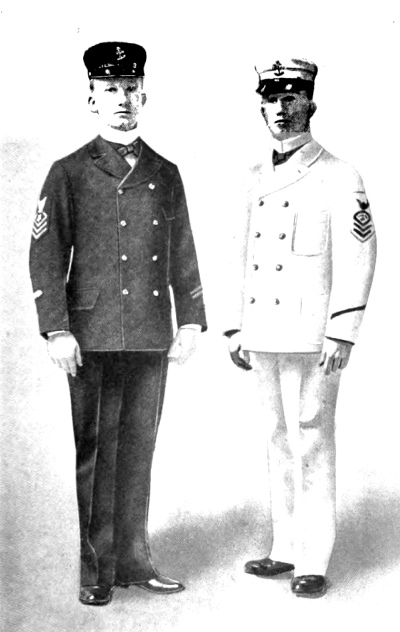
U. S. Navy. Chief petty officer
| Blue dress uniform |
White dress uniform |
Seaman Branch, indicated by rating
badge on right arm |
Artificer Branch, indicated
by rating badge on left arm |
Ex-apprentice, indicated by mark on right arm below elbow |
Second Enlistment, indicated by one
enlistment stripe on left arm |
Third Enlistment, indicated
by two enlistment stripes on left arm |
|

U. S. Navy. Enlisted men
| Blue dress uniform |
White dress uniform |
Rating, Petty officer first class, indicated
by rating badge with chevron of three stripes |
Rating, Seaman first class,
indicated by three stripes on cuffs |
Seaman Branch, indicated by rating badge
being on right arm shoulder seam |
Seaman Branch, indicated by branch
mark being on right |
[Pg 135]
The white dress uniform for chief petty officers and officers’
stewards and cooks consists of a white duck coat, white duck trousers,
white cap, white shirt and collar, black tie and white shoes, the coat
and trousers being made after the same style as the blue dress coat,
and the cap having a black visor and band and a white crown. For all
other enlisted men (except bandsmen) the white dress uniform consists
of a white dress “jumper” shirt with blue cloth collar and cuffs, white
trousers, black neckerchief, black shoes and a white hat. The white
[Pg 136]
dress jumper is not tightened at the waist like the blue overshirt but is
cut off square about six inches below the waist and allowed to hang free.
The blue undress uniform for chief petty officers and officers’
stewards and cooks is the same as the blue dress uniform for these men
except that the material of which it is made is blue serge and a blue
flannel shirt may be worn. For all other enlisted men (except bandsmen)
the blue undress uniform consists of a blue undress jumper, blue cloth
or flannel trousers, blue cap or white hat and black shoes. The blue
undress jumper is the same as the overshirt except that there are no
stripes of braid or stars on the collar or cuffs and the sleeves are
not buttoned at the cuff but cut off square and hemmed.
The white undress uniform for chief petty officers and officers’
stewards and cooks is the same as the white dress for these men. For
all other enlisted men (except bandsmen) it consists of a white undress
jumper of the same style as the blue undress jumper and white trousers
and white hat, the jumper and trousers being made of white navy drill.
The working dress uniform, blue or white, for all enlisted men is
the same as undress, blue or white as the case may be, except that chief
petty officers and officers’ stewards and cooks may go without the coat
and wear the blue flannel shirt if in blue, and other enlisted men do
not wear the neckerchief and may wear the watch cap when in blue. The
watch cap is a dark blue knitted cap without visor or brim that may be
pulled down over the ears for cold weather.
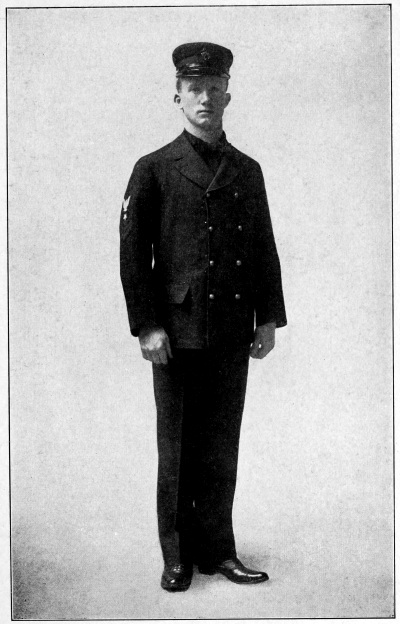
U. S. Navy. Chief petty officer
Blue working dress uniform
Rank: Chief Master-at-Arms
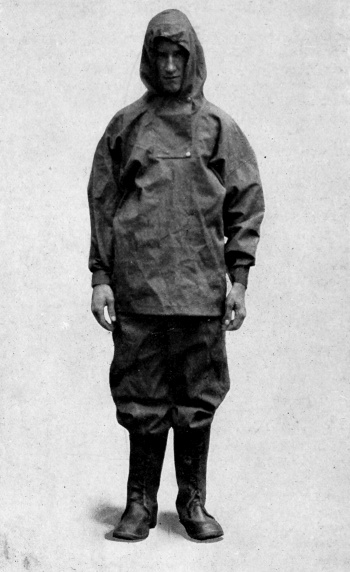
U. S. Navy. Winter uniform
Wind and rain proof uniform worn by crews of U. S. Destroyers
and Patrol Vessels during winter in northern waters
[Pg 137]
Winter Service Uniform.—At various times in the past when vessels
of the Navy have been detailed for long periods of duty in the Arctic
regions or where the weather conditions are particularly cold and
severe, special uniforms have been authorized to be worn by the
officers and enlisted men making up the personnel of such expeditions.
For the Arctic expeditions these special uniform suits have usually
been made of fur similar in pattern to the garments worn by the natives
of the Far North.
The conditions under which the Destroyer Flotillas and Patrol Squadrons
must operate off the coasts of Northern Europe during the severe
weather of the winter months has necessitated the design of a special
uniform for their crews. This winter storm uniform consists of heavy
waterproof boots of the style known as “Arctics”; wind and rain proof
trousers of heavy material; an overshirt of specially heavy wool with a
hood; and a wind and rain proof coat with a hood to be worn over all.
While the appearance of a sailor dressed in this uniform is very
different from that which we are accustomed to see upon the decks
of the trim and smart vessels of the United States Navy, it is made
necessary by the severe conditions of the service demanded and adds to
efficiency in that it serves to keep the men dry and warm and able to
perform their duties when the little vessels of the patrol fleet are
swept by heavy seas and chilling gales.
Dungaree suit consists of a jumper and trousers made
of blue denim drill.
Gloves for enlisted men are made of dark gray wool.
Bathing trunks of dark blue material are required to be worn by all
men bathing “over the side” from a ship.
Pajamas consisting of a shirt and trousers of light weight white
cotton drill are provided for enlisted men.
[Pg 138]
Overcoats for chief petty officers are of dark blue cloth, double
breasted, buttoning to the neck with two rows of large black buttons,
with a rolling collar, two vertical breast pockets and two lower side
pockets with flaps. For all other enlisted men (except bandsmen) the
overcoat is the same style but reaches only to the tips of the fingers
when the arms hang at the sides.
Uniforms for bandsmen of the navy consist of a blue dress coat, white
dress coat, sky-blue trousers, white trousers, blue cap, and white cap,
all of the same design and cut as those for the enlisted men of the U.
S. Marine Corps (described in Chapter VI) except that
navy buttons are worn instead of marine corps buttons, a lyre device
is worn on the cap, instead of the marine corps device, and the navy
“rating badges” are worn by the bandmaster and first musicians instead
of the chevrons worn by the noncommissioned officers of the marine
corps.
The overcoat for bandsmen is of sky-blue cloth, double-breasted,
buttoning to the neck with two rows of gilt navy buttons, lined with
red flannel, falling collar five inches deep, cut to reach about six
inches below the knee, and provided with a circular cape of the same
color.
The rank and special duty (or “rating” as it is styled in the navy) of
the petty officers of the first, second and third classes, as given in
the table on page 38, is shown by a “rating badge”
which is worn on the right sleeve between the elbow and the shoulder by
petty officers of the Seaman Branch and in the corresponding position
on the left sleeve by all other petty officers.
[Pg 139]
The rating badge consists of a spread eagle above a “specialty mark”
showing the duty and a chevron showing the “class” or rank of the
wearer. These badges are three and one-quarter inches broad.
The chevrons are made of stripes of cloth three-eighths of an
inch wide, placed one-quarter of an inch apart as shown in the
illustrations. A peculiarity of the navy chevrons is that they are
worn with the apex of the angle formed by the two bars of each stripe
pointing down instead of up as in the army and marine corps.
The specialty marks are placed in the center of the angle formed by the
upper stripe of the chevron and the spread eagle is placed just above
the specialty mark.
For use on blue clothing the chevrons are made of scarlet cloth and the
eagle and specialty marks are embroidered in white; while for white
clothing the chevrons are of blue cloth and the specialty marks and
eagle are embroidered in blue.
For petty officers holding three consecutive good-conduct badges
(namely, the good-conduct medal and two bars, representing three full
enlistments served with efficiency and good conduct) the chevrons
are made of gold lace braid and the eagle and specialty marks are
embroidered in silver.
The specialty marks indicating the different ranks or “ratings” are, as
shown in the illustrations, as follows:
NUMBER OF
FIGURE IN
ILLUSTRATION. |
RANK OR “RATING.” |
| 1. |
Master-at-arms. |
| 2. |
Boatswain’s mate, or coxswain. |
| 3. |
Quartermaster. |
| 4. |
Blacksmith, or shipfitter. |
| 5.[Pg 140] |
Sailmaker’s mate. |
| 6. |
Printer. |
| 7. |
Carpenter’s mate, plumber and fitter, painter. |
| 8. |
Turret captain. |
| 9. |
Gunner’s mate. |
| 10. |
Storekeeper. |
| 11. |
Yeoman. |
| 12. |
Electrician. |
| 13. |
Machinist’s mate, boiler maker, water tender, coppersmith, oiler. |
| 14. |
Hospital corps (red cloth Geneva cross). |
| 15. |
Bandmaster, musician. |
| 16. |
Commissary steward. |
| 17. |
Ship’s cook and baker. |
| 18. |
Bugler, worn on the left arm above the elbow. |
Petty officers detailed to duty in the Naval Aviation Corps wear rating
badges of the same design as those worn by other petty officers, the
number of stripes in the chevron showing the class, three stripes with
an arc of a circle above for chief petty officer class, three stripes
for first class, two stripes for second class and one stripe for third
class, and the specialty marks showing the various classes of duty
being as follows:
| Quartermaster Aviation |
A steering wheel with one eagle’s wing to
the right of it and one to the left of it. |
| Machinist’s Mate Aviation |
A two-bladed airplane propeller with one eagle’s wing
to the right of it and one to the left of it. |
| Carpenter’s Mate Aviation |
Two axes crossed with one eagle’s wing to
the right of it and one to the left of it. |

U. S. Navy. Petty officers’ rating badges worn on sleeves
of uniform coats, overshirts and jumpers. The special detail is
indicated by the specialty mark worn in the angle of the chevron
| 1. Chief Master-at-Arms |
2. Boatswain’s Mate, First Class |
| 3. Gunner’s Mate, Second Class |
4. Quartermaster, Third Class |
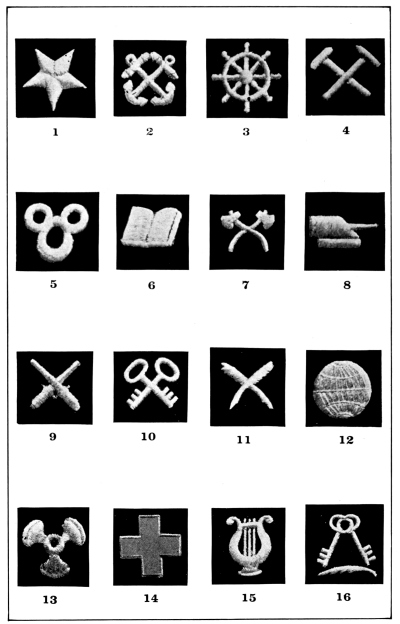
U. S. Navy
Petty officers’ specialty marks
[Pg 141]
These specialty marks measure 2½ inches from tip to tip of the eagle’s wings.
“Distinguishing marks” are worn by certain enlisted men
to indicate special duties or stations to which they are detailed or to show
certain qualifications. These marks are embroidered in white silk for
blue clothing and in blue silk for white clothing and, as illustrated,
are as follows:
NUMBER OF
FIGURE IN
ILLUSTRATION. |
DUTY OR STATION. |
| 19. |
Seaman gunner mark, worn below
the chevron by petty officers and in place of the rating badge
by other men who have qualified as seaman gunners. |
| 20. |
Gun captain mark, worn by men detailed
by the commanding officer as gun captains, on the opposite arm
to that on which the rating badge is worn. |
| 21. |
Gun pointer mark, worn by men who have qualified as gun pointers on the opposite
arm to that on which the rating badge is worn; gun pointers of the first class
wear the mark with a star above it (Figure 22). |
| 23.[Pg 142] |
The Navy “E,” worn by members of the turret, gun and torpedo crews
that make exceptionally high scores on record target practice, and men
of the Engineer Division of the ship winning the trophy in the annual
engineering competition.
Expert rifleman’s mark, worn by enlisted men of the Navy, Marine Corps
and Naval Militia qualified as expert riflemen on the left sleeve
midway between the wrist and the elbow, and consisting of a square, one
inch, containing target rings three-quarters of an inch and one-half
of an inch in diameter and a bull’s-eye one-quarter of an inch in
diameter, embroidered in blue on white for white clothing, in white on
blue for blue clothing and in gray on khaki for khaki-colored clothing. |
| 24. |
Radio operator, worn by electricians who are radio
operators below the rating badge. |
| 25. |
Torpedoman mark, worn by gunner’s mates who have qualified
in torpedoes and mines below the rating badge. |
| 7. |
Shipwright’s mark, worn by shipwrights in the same place as the rating badge. |
| 14. |
Hospital Corps mark (the Geneva cross), worn by hospital
apprentices on the left arm above the elbow. |
| 17. |
Ship’s cook of the third and fourth classes, bakers of the second class
and officers’ stewards and cooks, worn on the left arm above the elbow. |
| 3. |
Signalmen, first and second class, worn on the arm
above the elbow in place of the rating badge. |
| 15. |
Musician’s mark, worn by musicians of the first and
second class on the left arm above the elbow. |
| 26. |
Ex-apprentice mark, worn by all men who have passed through the rating
of apprentice in the navy; worn on the front of the overshirt and
jumper just below the neck opening and on the sleeve of petty officers’
coats on the same side as the rating badge, between the wrist and the elbow. |

U. S. Navy
Enlisted men’s specialty marks, distinguishing marks and buttons
[Pg 143]
The Branch of the Navy to which all enlisted men not petty officers
belong is shown by a branch mark, a stripe of braid three-eighths of
an inch wide around the top of the sleeve at the shoulder seam.
For the Seaman Branch the branch mark is worn on the right arm, in
blue for white clothing and white for blue clothing; for the artificer
branch, engineer force, the branch mark is worn on the left arm in red.
Hospital apprentices, shipwrights, musicians, buglers, commissary and
messmen wear no branch mark.
Service stripes.—To show the number of enlistments that a man has
served all enlisted men who have served one or more enlistments of
three or four years wear service stripes, three-eighths of an inch
wide, diagonally across the outer side of the left sleeve of the blue
coat, white coat, overshirt or jumper. These service stripes are of
scarlet cloth on blue clothing and of blue cloth on white clothes. One
service stripe is worn for each enlistment of three or four years that
the wearer has completed. For petty officers who hold three consecutive
good-conduct badges the service stripes are made of gold lace braid.
Neckerchief.—The neckerchief worn by enlisted men with the blue
overshirt and white dress jumper is of black silk thirty-six inches
square, worn around the neck under the collar, tied in a square knot
just below the collar opening in front.
Leggings.—For duty with landing forces ashore enlisted men of the
navy wear khaki-colored canvas leggings.
ENLISTED MEN OF THE NAVAL MILITIA
Enlisted men of the Naval Militia wear the same uniforms as
those prescribed for the regular Navy with the addition of the
distinguishing mark for the Naval Militia, consisting of a vertical
[Pg 144]
foul anchor enclosed in a diamond shaped lozenge. This mark being
embroidered in white on a blue ground for blue clothing and in blue on
a white ground for white clothing. It is worn on overshirts and jumpers
just below the neck opening and on coats (except overcoats) on the same
sleeve as the rating badge midway between the wrist and the elbow.
The cap ribbon worn by enlisted men of the Naval Militia bears the
words “Naval Militia” followed by the authorized abbreviation for the
state or territory to which they belong thus, for the Naval Militia of
Massachusetts,
NAVAL MILITIA, MASS.
When United States ships are assigned for the use of the Naval Militia
of any state such men of the organization as the Governor of the state
may designate may wear on their cap ribbons the name of the ship so
assigned with the distinguishing mark for the naval militia before and
after the name of the ship.
The Naval Reserve enlisted men wear the same uniform as that
prescribed for the various grades of the regular service, with the
exceptions that all gilt buttons worn on the uniforms are of the
special design prescribed for the Naval Reserve, that is, having upon
them in relief a plain vertical anchor surrounded by the letters U. S.
N. R., and the cap ribbons bear the words
U. S. NAVAL RESERVE FORCE
The Navy Sword.—The sword carried by all officers of the Navy has
a bright steel cut and thrust blade from twenty-six to thirty-two inches
long depending upon the height of the wearer, having a half-basket hilt
[Pg 145]
and a grip covered with white shark skin wrapped with a spiral of gilt
wire, the hilt being of brass gilded. It is carried in a scabbard of
black leather with gilded tip ferrule and gilded straps and rings for
attaching the slings which attach it to the belt.
The belt for naval officers is closed at the front and center by a
circular belt plate ornament with a raised design of a wreath enclosing
a circle of rope one inch in diameter inside of which is an American
eagle on a horizontal anchor above a pyramid of cannon balls, the space
between the rope circle and the eagle and anchor design having thirteen
stars in a circle.
Identification tag.—Every officer and enlisted man of the U. S.
Navy on active duty is required to wear an identification tag, which
consists of an oval plate of monel metal, one and one-quarter inches
by one and one-half inches in size, suspended from the neck by a monel
metal wire encased in a cotton sleeve.
On one side of the tag is etched the finger print of the right index
finger of the officer or man wearing the tag and on the other side, for
officers the letters “U. S. N.,” the surname and initials, the rank and
the date of commission or appointment; for enlisted men the letters “U.
S. N.,” the surname and initials, the month, day and year of enlistment
expressed in numerals thus “1.5.1916.” and the month, day and year of
birth similarly expressed.
A copy of the finger print of each officer and enlisted man in the
Naval Service is also kept on file at the Bureau of Navigation of the
Navy Department in Washington, D. C.
These tags are for the purpose of identification in case of death or
wounds so serious as to produce unconsciousness.
[Pg 146]
UNIFORMS OF ENROLLED WOMEN,
U. S. NAVAL RESERVE FORCE
Women are enrolled in the U. S. Naval Reserve Force in the ratings of
Chief Yeoman, Yeoman, First, Second or Third Class, and Landsman for
Training, and assigned clerical duties on shore. They are required to
wear blue or white uniforms consisting of a Norfolk style coat and
tailor-made skirt of blue navy serge or white drill, a white beach
cloth shirt-waist and black navy neckerchief, black hose and shoes with
blue skirt and white ones with white skirt, and a flat brimmed blue
felt or white straw sailor hat with the regulation Naval Reserve cap
ribbon.
The coat has a rolling lapel collar, four medium navy gilt buttons
down the front and three small ones on each cuff, two-inch vertical
plaits from shoulders to lower edge at front and back, a one and
three-quarter inch belt, and on each side below the waist a pocket with
a buttoned flap.
The skirt reaches to within eight inches of the floor and has on each
side of the front a pocket with buttoned flap.
The waist is plain tailored, opens down the front with collar to
admit of being worn buttoned high or folded back, and has one plain
patch pocket on the left side.
Rating badges for Chief Yeoman and for
Yeoman, First, Second or Third Class are worn on the left sleeve
above the elbow; on the blue coat the chevrons are scarlet, eagles
and specialty marks white, and on the white coat chevrons, eagles and
specialty marks are all blue.
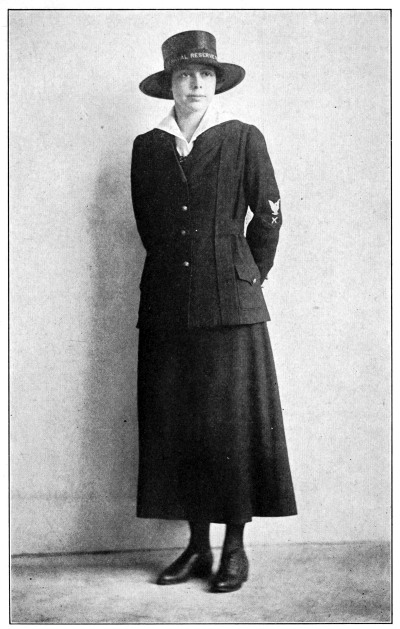
Photo. Harris & Ewing, Washington, D. C.
Enrolled Women, U. S. Naval Reserve Force.
Blue service uniform
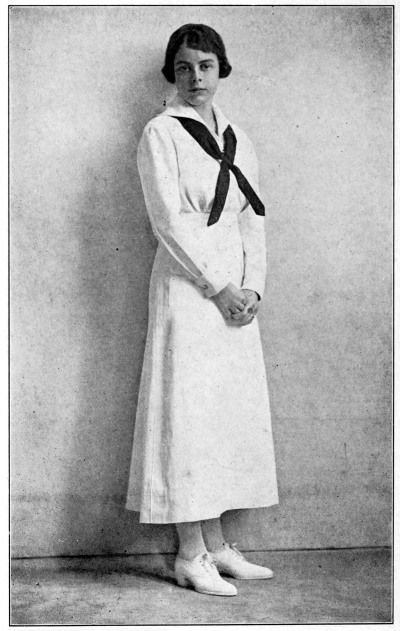
Photo. Harris & Ewing, Washington, D. C.
Enrolled Women, U. S. Naval Reserve Force.
White service uniform
[Pg 147]
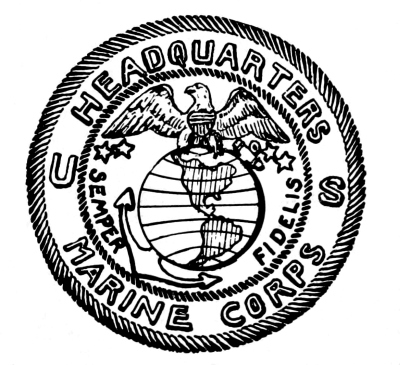
SEAL OF THE U. S. MARINE CORPS
CHAPTER VI
UNIFORMS AND INSIGNIA OF THE
U. S. MARINE CORPS
The marines serve both on ship and ashore, while aboard ship their
duties closely approximate those of the sailor in the line of the navy
and while serving ashore their duties are of the same nature as those
of the army soldier, but their uniform is distinctly military in style
and appearance.
Both officers and enlisted men have uniforms of blue cloth
corresponding to those of the navy and worn upon the same occasions,
and the officers have white uniforms to be worn upon the occasions when
officers of the navy wear white, while the enlisted men have no white
uniform coats but wear uniforms of khaki-colored cotton material upon
[Pg 148]
the occasions when enlisted men of the navy wear white. This khaki
uniform is officially known as “summer field” uniform, but commonly
called “khaki.”
Both officers and men are also provided with a “winter field” uniform
for wear upon active service in the field whenever the weather is too
cold for the khaki uniform. The winter field uniforms and the overcoats
for officers and men are made of woolen cloth of a shade known as
“forestry-green,” a grayish olive green.
In time of war the special full dress, full dress and mess dress
uniforms are not worn unless especially ordered for a particular occasion.
UNIFORMS FOR OFFICERS OF THE MARINE CORPS
The commissioned officers of the Marine Corps are required to have
complete outfits of special full dress, full dress, undress, white
undress, mess dress, summer field and winter field uniforms.
The warrant officers of the Marine Corps are required to have the same
uniforms with the exception of special full dress, full dress and mess
dress.
The occasions upon which these uniforms are worn are given in the table
of occasions for uniforms for officers of the Navy and Marine Corps,
page 109, and the composition of the various uniforms is as follows:
Special Full Dress Uniform.—For officers of
the Line, a double-breasted frock coat of dark blue cloth, extending
to about one foot below the waist, with two rows of gilt Marine Corps
buttons down the front from the line of the collar to the waist, the
buttons being arranged in groups of threes for the rank of Major
General Commandant, in groups of twos for the rank of Brigadier
General and equally spaced for all other ranks; with a standing collar
embroidered with gold oak leaves for general officers and covered with
gold lace braid for other ranks, the cuffs bearing ornamentations of
gold embroidery to indicate the rank of the wearer (see illustrations
at page 155), the cuffs for general officers being of dark blue velvet;
dark blue cloth trousers, trimmed down the outer leg seams with one
and a quarter inch wide gold lace braid having a quarter inch scarlet
silk stripe through the center; a bell-crowned cap of dark blue cloth
with a sloping visor with a gold chin strap above it and the silver
and gold Marine Corps device at the center of the front of the crown,
gold epaulets, black shoes, white gloves, and the Marine Corps sword
suspended from a belt by slings, belt and slings covered with gold lace braid.
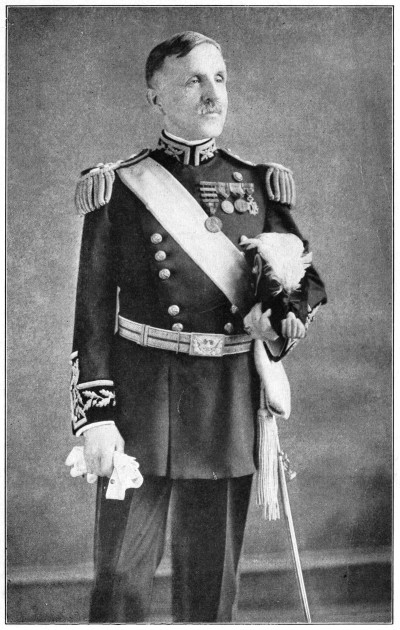
Copyright, Harris & Ewing, Washington, D. C.
Major General George Barnett
Major General Commandant of the
United States Marine Corps
[Pg 149]
For officers of the Staff, the same as for officers of the Line except
that the coat is single-breasted with one row of buttons and gold
shoulder knots are worn instead of epaulets, and aiguilettes of plaited
gold cord are worn.
For the Major General Commandant, and officers of the Staff, there
may be worn with this uniform a chapeau or “cocked hat” of black silk
beaver with a two-inch strap of gold lace on the right side upon which
is the silver and gold Marine Corps device and a plume of cock’s
feathers extending over the top of the crown from front to rear, the
plume to be canary-yellow for the Major General Commandant and scarlet
for officers of the Staff.
The Major General Commandant also wears with this uniform a sash of
buff silk with bullion tassels diagonally across the body from the
right shoulder to the waist at the left side, the tassels hanging below
the belt.
Brigadier Generals wear with this uniform a sash belt with a bow at the
left side, of two and a half inch gold lace with a three-eighths inch
[Pg 150]
scarlet stripe through the center, from which the sword is suspended by
gold lace trimmed slings.
When mounted, officers wear full dress breeches and black boots with
this uniform.
The full dress cap for the Major General Commandant has a band of
blue-black velvet decorated with gold embroidered oak leaves, and a
wreath of oak leaves around the Marine Corps device.
The full dress cap for Brigadier Generals is the same as for the Major
General Commandant, except that the wreath of oak leaves around the
corps device is omitted.
The full dress cap for all other commissioned officers has a band of
gold lace braid with a three-eighths inch scarlet stripe through the
center, the visor being covered with dark blue cloth decorated with
sprays of oak leaves for field officers (Colonels, Lieutenant colonels
and Majors) and with plain black patent leather for company officers
(Captains, First Lieutenants and Second Lieutenants).
Full dress uniform.—The same coat as worn with special full dress,
full dress trousers, gold shoulder knots, full dress cap, white
gloves, and black shoes. The same sash and belt for the Major General
Commandant, the same sash for Brigadier Generals and the same belt for
other commissioned officers as those worn with the special full dress
uniform.
The full dress trousers for the Major General Commandant and Brigadier
Generals are of dark blue cloth with a stripe of black mohair braid
one and one-half inches wide down the outer leg seams; for all Line
officers below the rank of Brigadier General they are of sky-blue cloth
with a stripe of scarlet cloth one and one-half inches wide down each
outer leg seam; and for Staff officers below the rank of Brigadier
General they are of dark blue cloth with a stripe of scarlet cloth one
and one-half inches wide down each outer leg seam.
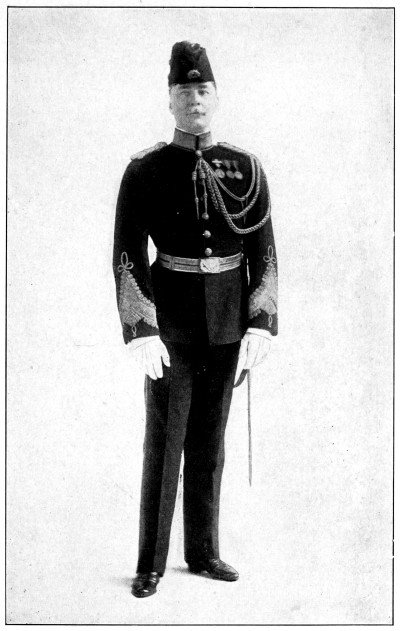
Photo by Harris & Ewing, Washington, D. C.
U. S. Marine Corps. Officer, special full dress uniform
Rank: Lieutenant Colonel of the Staff
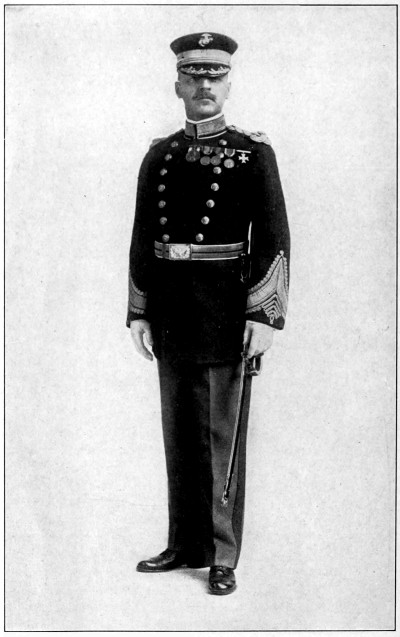
Photo by Harris & Ewing, Washington, D. C.
U. S. Marine Corps. Officer, full dress uniform
Rank: Major of the Line
[Pg 151]
The chapeau may be worn with this uniform by the Major General
Commandant and officers of the Staff.
When mounted officers wear full dress breeches and black boots with
this uniform, the breeches being of the same color and with the same
stripes as the full dress trousers.
Undress uniform.—The blue undress coat, undress trousers (white
trousers may be worn), undress cap (white undress cap may be worn),
black shoes (white shoes with white trousers), white gloves, the sword
worn suspended from a tan leather belt and slings. When mounted undress
breeches and black boots are worn.
The undress coat for all officers is a single-breasted sack coat of
dark blue cloth or serge extending to about ten inches below the waist,
with a standing collar, buttoned down the front by five Marine Corps
gilt buttons. On the front it has four outside patch pockets, one on
each breast and one on each side below the breast pockets with their
tops at the waist line, all the pockets being closed by pointed flaps
buttoned by small Marine Corps gilt buttons. On the shoulders there
are shoulder straps of the same material as the coat extending from
the shoulder seam to the base of the collar, the insignia of rank
being worn thereon. The Marine Corps device indicating the corps and
the staff corps device or aide-de-camp’s device for indicating the
staff corps or special assignment of officers being worn on the collar
on each side of the neck opening in front. The sword belt is worn
underneath this coat.
[Pg 152]
The undress trousers for General officers are of dark blue cloth with
stripes of black mohair braid down the outer leg seams, for Line
officers below the rank of Brigadier General they are of sky-blue
cloth or serge with one and a half inch scarlet stripes down the outer
leg seams, and for Staff officers below the rank of Brigadier General
they are of dark blue cloth or serge with one and a half inch scarlet
stripes down the outer leg seams.
The undress cap is of dark blue cloth with a sloping visor having the
same ornamentation for General officers and Field officers as the full
dress cap, the Marine Corps device in the center of the front and a
chin strap above the visor made of gold braid three-eighths of an inch
wide with a narrow scarlet stripe through the center of it. For General
officers the band of the cap is of blue-black velvet and for all other
officers it is of black mohair braid.
The white undress cap is made of white duck and white braid of the same
style as the blue undress cap and provided with the same visor, corps
device and chin strap as the blue undress cap.
Undress breeches, worn when mounted, are of the same color as undress
trousers and have the same stripes.
White undress uniform.—The white undress coat, white trousers, white
cap, white shoes, white gloves and sword with tan leather sword belt
and slings. The white undress coat is made of white duck or drill after
the same style and design as the blue undress coat and bears the same
rank, corps and staff devices.
Mess dress uniform.—Blue mess jacket, special full dress trousers,
white dress waistcoat with gilt buttons, gold shoulder knots, full
dress cap, white shirt and collar, black necktie, black patent leather
shoes. The white mess jacket is worn in hot weather and white trousers
may be worn with it, in which case the white cap is worn.
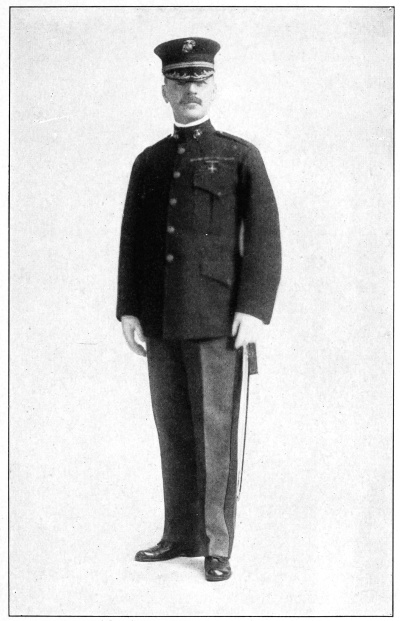
Photo by Harris & Ewing, Washington, D. C.
U. S. Marine Corps. Officer, blue undress uniform
Field officer of the Line

U. S. Marine Corps. Officers’ headdress
| 1. Full dress cap, Major General Commandant |
| 2. Full dress cap, field officers |
| 3. Chapeau, Major General Commandant |
| 4. Undress cap, company officers |
| 5. Winter field cap, all officers |
[Pg 153]
The mess jacket is a round shell jacket of dark blue cloth, with
standing collar, extending to the points of the hip bones at the sides
and curving downward slightly to the front and back. The jacket is
worn hooked at the collar but open down the front which has one row of
sixteen small Marine Corps gilt buttons. The collar is covered with
gold lace braid and the sleeves bear the same ornamentations indicating
rank as those worn on the full dress coat.
The white mess jacket is of the same style as the blue mess jacket but
has no sleeve ornamentation, and is provided with shoulder straps of
the same material as the jacket, upon which the insignia of rank are
worn in the same manner as on the shoulder straps of the undress coats.
The mess dress is worn on occasions when naval officers wear their
evening dress uniform.
Summer field uniform.—The summer field uniform is made of khaki
colored cotton drill and consists of a coat of the same style and
design as the white undress coat, breeches, field hat or khaki-colored
cap of the same style as the white cap, tan leather shoes, tan leather
strap puttee leggings, and the sword suspended from the tan leather
belt and slings, the belt being worn outside of the coat. Mounted
officers may wear tan leather boots.
The field hat is the wide brimmed brown felt hat worn with the peaked
crown, commonly known as the “campaign hat.” It has the Marine Corps
device on the front of the crown to indicate the corps, and in the case
[Pg 154]
of officers a hat cord woven of gold and red and finished at the ends
with gold and red acorns is worn around the base of the crown.
The rank marks worn with the summer field coat are the same as those
worn with the white undress, but all corps and staff devices and
buttons are of dull finished bronze to make them less conspicuous.
Winter Field Uniform.—The winter field uniform is made of cloth
or serge of the shade known as “forestry-green,” a grayish olive green,
and consists of a coat made in the same general style as the summer
field coat except that the lower pockets are larger and are of the
“bellows” type, breeches (trousers are worn sometimes), the field hat
or winter field cap, tan leather strap puttee leggings, tan shoes,
sword suspended from tan leather belt and slings, the belt being worn
outside of the coat. Mounted officers may wear tan leather boots.
The insignia indicating rank, corps and staff department and the
buttons are the same as those worn on the summer field uniform.
In the field or at drills when it is considered appropriate the coat of
the field uniform is not worn, in which case the flannel shirt, of the
same color as the field uniform, is worn with the insignia of rank on
the collar on each side of the front opening.

Photo by Harris & Ewing, Washington, D. C.
U. S. Marine Corps. Officer, winter field uniform
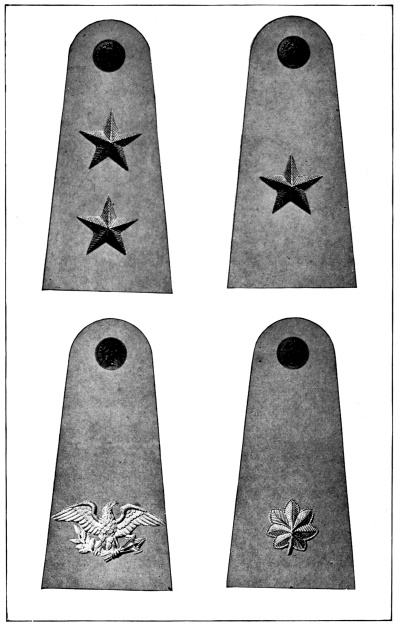
U. S. Marine Corps. Officers’ insignia indicating rank
Shoulder straps of blue and white undress coats, summer
and winter field coats, white mess jacket and overcoat
| 1. Major General Commandant |
| 2. Brigadier General |
| 3. Colonel |
| 4. Lieutenant Colonel (Silver Leaf) |
[Pg 155]
The overcoat for all officers is a double-breasted ulster made of
cloth of the same “forestry-green” color as the winter field uniform
extending to about ten inches below the knee, buttoned to the neck with
two rows of large size bronze Marine Corps buttons, with a deep rolling
collar, and shoulder straps on the shoulders bearing the insignia of
rank in bright metal and the insignia indicating the Staff corps and
aides-de-camps in bronze. The sleeves bear ornamentations indicating
the rank of the wearer of the same size and design as those for the
full dress coat but of the same color as the cloth of the overcoat.
There is a double box pleat down the center of the back and straps
across the back to button the coat in at the waist. On each side below
the waist there is a pocket with a vertical opening.
The cloak for all officers is of dark blue cloth lined with scarlet
cloth, cut to three-fourths of a circle so as to hang full, and having
a rolling collar of black velvet.
For wear in rainy weather each officer is provided with a raincoat and
a rain cape of waterproof material, of the same color as the winter
field uniform, and extending to about eight inches below the knee.
Shirts and collars for wear with special full dress, full dress,
undress and mess dress uniforms are of plain white linen, and those
for wear with field uniforms are of flannel of the color of the field
uniform.
Warrant officers (Marine Gunners and Quartermaster Clerks) are not
required to have special full dress, full dress or mess uniforms.
INSIGNIA OF RANK, CORPS
AND STAFF DEPARTMENTS
The rank of officers of the Marine Corps is indicated in three ways:
first, by rank insignia worn upon the shoulder straps of the blue and
white undress coats and summer and winter field coats; second, by rank
insignia worn upon the tops of the epaulets and shoulder knots worn
with special full dress, full dress and mess dress coats, and third, by
the ornamentations worn upon the sleeves of the full dress coat, mess
jacket and overcoat.
The insignia of rank, indicating the rank of the wearer, are
practically the same as those for the corresponding ranks of the Army
and Navy, and are as follows:
[Pg 156]
| Major General Commandant—two silver stars. |
| Brigadier General—one silver star. |
| Colonel—a silver spread eagle. |
| Lieutenant Colonel—a silver oak leaf. |
| Major—a gold oak leaf. |
| Captain—two silver bars. |
| First Lieutenant—one silver bar. |
| Second Lieutenant—one gold bar. |
| Marine Gunner and |
 |
no insignia of rank, the |
| Quartermaster Clerk |
shoulder strap being plain. |
The insignia of rank worn on the shoulder straps of the blue undress
coat and the winter field coat are embroidered in silver thread, with
the exception of the Major’s gold leaf which is embroidered in gold
thread, and those worn on the white undress coat, summer field coat,
white mess jacket and overcoat are of metal, silver for all except the
major’s leaf and second lieutenant’s bar which are of gold.
The insignia of rank worn on the tops of the epaulets and shoulder
knots are of the same size but are embroidered upon scarlet cloth to
show one-sixteenth of an inch all around.
The sleeve ornamentations indicating the rank of officers of the Marine
Corps are as shown in the illustrations. On the full dress coat and
mess jacket for the Major General Commandant and the Brigadier Generals
they are embroidered in gold upon cuffs of dark blue velvet and on
the overcoat they are embroidered in thread of the same color as the
overcoat. For Line officers below the rank of Brigadier General they
are made of gold lace braid on a backing of scarlet cloth on the full
dress coat and mess jacket while for officers of the Staff the scarlet
cloth backing is omitted. On the overcoats for all officers below the
rank of Brigadier General they are made of mohair braid of the same
color as the overcoat.
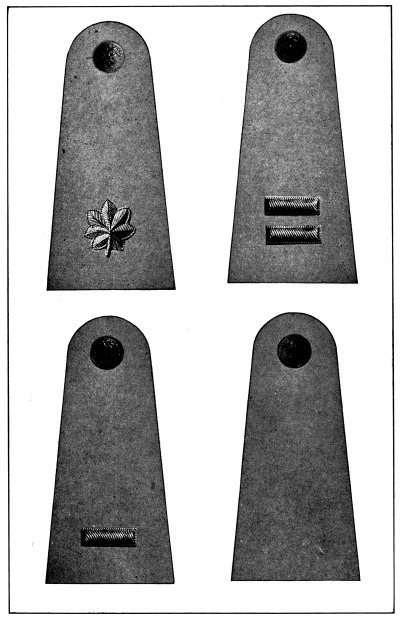
U. S. Marine Corps. Officers’ insignia indicating rank
Shoulder straps of blue and white undress coats, summer
and winter field coats, white mess jacket and overcoat
| 1. Major (Gold leaf) |
2. Captain |
| 3. First Lieutenant (Silver bar), |
4. Warrant officer |
| Second Lieutenant (Gold bar) |
|
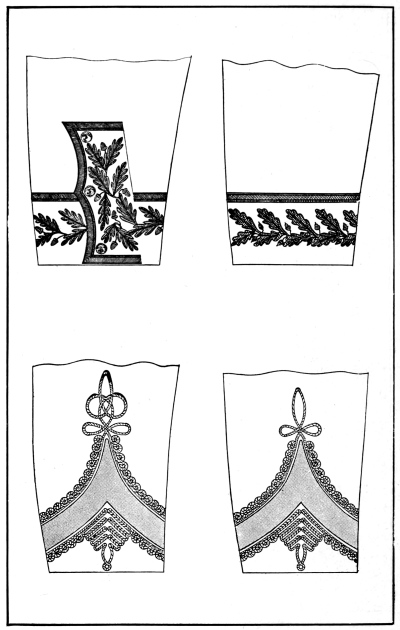
U. S. Marine Corps. Officers’ decorations on sleeves indicating rank.
In gold braid and embroidery on sleeves of full dress coat and blue
mess jacket. In forestry-green braid and embroidery on sleeves of overcoat.
| 1. Major General Commandant |
| 2. Brigadier General |
| 3. Colonel |
| 4. Lieutenant Colonel |
[Pg 157]
It may be noted that the design of the sleeve ornaments for Field
officers (Colonels, Lieutenant Colonels and Majors) is in the form of
a chevron, while that for company officers (Captains, and First and
Second Lieutenants) is a knot known to seamen as a “carrick bend,” to
artillerymen as a “prolong knot”; and to the civilian as the “True love
knot” representing faithfulness on account of the fact that it does not
readily slip or pull apart. It was on this account that this particular
form of knot was first used as a military emblem to denote faithfulness
or loyalty.
The fact that an officer belongs to the Marine Corps is shown by the
Marine Corps device or insignia worn upon the front of all caps and
field hats, upon the right side of the chapeau, on the top of epaulets
and shoulder knots, and upon the collars of the blue and white undress
coats, summer and winter field coats and mess jackets.
The Marine Corps device for full dress and undress caps is a fretted
silver Western Hemisphere with chased parallels and the continents of
North and South America in gold, resting upon a foul anchor in gold,
and surmounted by a spread eagle of silver. The shank of the anchor is
set at an angle of thirty degrees from the horizontal. The dimensions
are, diameter of hemisphere seven-eighths of an inch, height of eagle
one-half of an inch, length of anchor one and three-quarter inches. The
Corps device worn on epaulets and shoulder knots is of the same size
and design but is made entirely of silver. The Marine Corps devices
worn on the field hat and on the summer field and winter field caps are
[Pg 158]
of the same design and size as those worn on the undress caps but are
made entirely of bronze metal.
The Corps devices worn on the collars of the blue undress coat, white
undress coat and white mess jacket are of silver and gold and of the
same design as those worn on caps but of only three-fourths the size.
Those worn on the collars of the summer field and winter field coats
are of the same design and size as those worn on the undress coats but
are made entirely of dull finish bronze metal.
The aides-de-camp on the personal staff of a General officer wear
a distinctive device consisting of a shield of the United States
three-quarters of an inch high surmounted by an eagle one-half of an
inch high. This device is worn in the center of the sleeve ornament of
the full dress coat and mess jacket and on the collars of the undress
and field coats and white mess jackets in rear of the corps devices,
and on the shoulder straps of the overcoat. For the full dress, undress
and mess dress uniforms the device has the shield in enamel of proper
colors, stripes of red and white, field blue with gold stars indicating
the rank of the general officer on whose staff the aide-de-camp is
serving, two stars for Major General and one star for Brigadier
General. For the field coats and the overcoat the device is of the same
design but made of dull finish bronze metal.
In order to designate the different departments to which the officers
of the Staff of the Marine Corps belong distinctive Departmental
Devices are provided to be worn with all uniforms.
Adjutant and Inspector’s Department.—The distinctive device for
this department consists of a miniature Marine Corps sword and fasces
crossed in gold surmounted by a wreath in silver, in the center of
which is a shield of thirteen bars of red and white enamel with the
field in blue enamel containing one large and twelve small gold stars;
the dimensions being, length of sword and fasces one and three-eighths
inches, diameter of wreath three-quarters of an inch.
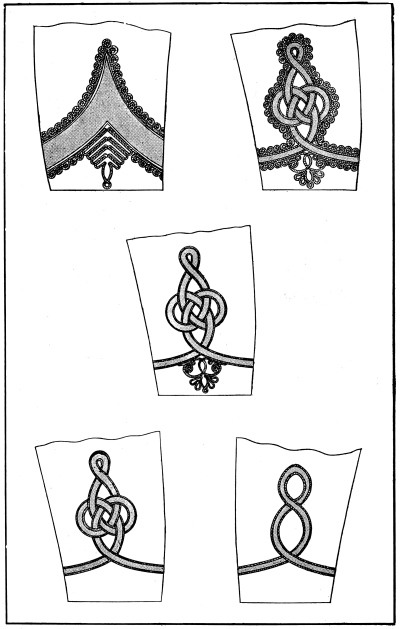
U.S. Marine corps. Officers’ decorations on sleeves
indicating rank. In gold braid and embroidery on sleeves
of full dress coat and blue mess jacket. In forestry-green
braid and embroidery on sleeves of overcoat.
| 1. Major |
2. Captain |
| 3. First Lieutenant |
| 4. Second Lieutenant |
5. Warrant Officer |

U. S. Marine Corps
| 1. Corps insignia worn on caps and hats |
| 2. Corps insignia worn on coat collars |
| 3. Distinctive mark for Aide-de-camp |
| 4. Departmental insignia, Adjutant and Inspector’s Department |
| 5. Departmental insignia, Quartermaster’s Department |
| 6. Departmental insignia, Paymaster’s Department |
| 7. Marine Corps button |
[Pg 159]
Quartermaster’s Department.—The distinctive device of this
department consists of a miniature Marine Corps sword and a key crossed
in gold surmounted by a gold wheel with a blue enamel rim set with
thirteen gold stars, the dimensions being, length of sword and key one
and three-eighths inches, diameter of wheel three-quarters of an inch.
Paymaster’s Department.—The distinctive device for this department
consists of a miniature Marine Corps sword and a quill pen crossed in
gold surmounted by an oak leaf and two acorns in silver, the dimensions
being, length of sword and quill one and three-eighths inches, length
of leaf one and one-eighth inches.
With special full dress, full dress and blue mess dress uniforms these
distinctive devices of the Staff Departments are worn on the top of the
shoulder knot at the center; with white mess dress, blue undress, white
undress, summer field and winter field uniforms they are worn on each
side of the collar in rear of the corps device; and with the overcoat
they are worn on the shoulder straps above the insignia of rank.
For wear with the summer field and winter field uniforms and with the
overcoat the Departmental devices are of the same size and design as
for the other uniforms above described but are made of dull finish
bronze metal.
Aiguilettes consisting of loops of plaited round gold cord
terminating in gilded pencil ornaments are worn with special full
dress, full dress, and mess dress by officers of the Staff Departments,
[Pg 160]
and with special full dress, full dress, mess dress, blue undress and
white undress uniforms by Aides-de-camp to General officers and Aids on
the personal staff of a Flag Officer of the Navy.
Warrant Officers’ Distinctive Insignia.—Marine Gunners wear as a
distinctive device a bursting spherical shell three-quarters of an inch
in diameter with a flame five-eighths of an inch high made of silver
for the blue undress and white undress coats and of dull finish bronze
metal for the summer field and winter field coats and the overcoat.
Quartermaster Clerks wear the distinctive device of the Quartermaster’s
Department, in gold and enamel for the blue and white undress coats and
in dull finish bronze for the summer field and winter field coats and
the overcoat.
These devices are worn on both sides of the collar of the undress and
field coats and on the shoulder straps of the overcoat.
Marine Corps Sword.—The sword carried by all officers of the
Marine Corps has a steel blade, slightly curved, from twenty-eight to
thirty-two inches in length, with a scroll on each side bearing the
words “United States Marines.” The grip is of the Mameluke type and is
made of white ivory and the guard is a straight bar of gilded metal,
the ends terminating in acorn designs. The scabbard is of polished
silver with two gilded bands and rings for attaching it to the belt
slings and a gilded ferrule at the lower end.
The Belt Plate for officers’ full dress belts is of gilt metal,
oblong in shape, two and one-eighth inches high by three and one-eighth
inches wide, decorated with a silver wreath encircling the Arms of the
United States in silver.
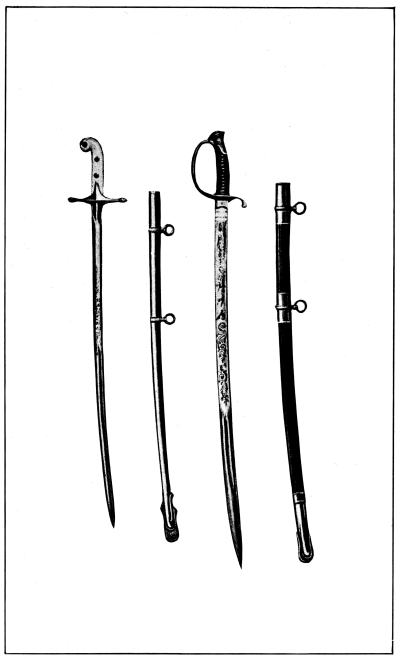
U. S. Marine Corps swords
1. Commissioned officers
2. Noncommissioned officers
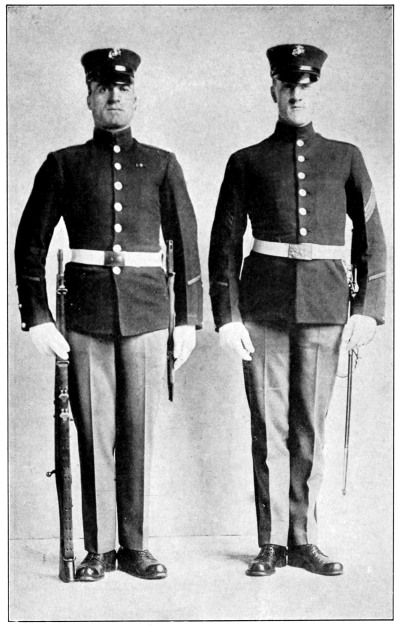
Photo by Harris & Ewing, Washington, D. C.
U. S. Marine Corps
Enlisted men in dress uniform
Private First Sergeant
[Pg 161]
The Sword Knot worn on the hilt of the Marine Officers’ sword is a
loop of round cord ending in a tassel, made of gold and scarlet for
full dress and of plaited leather for other uniforms.
Buttons.—The Marine Corps buttons bear a design consisting of a
foul anchor placed diagonally with an American eagle above it, surrounded
by thirteen stars and a narrow circular band. The buttons for blue and
white uniforms are of gilded metal and those for the field uniforms and
the overcoat are of dull bronze metal.
Spurs are worn by all officers when mounted.
The uniform for the officers of the Marine Corps Branch of the
Naval Militia of the several states and territories is the same as
that for the officers of the regular service with the addition of a
distinctive mark showing the state or territory to which they belong.
This distinctive mark is the authorized abbreviation for the state or
territory in metal block letters one-half of an inch high and is worn
in rear of the Marine Corps device on each side of the collar of the
blue undress, white undress, summer field and winter field coats, on
the shoulder straps of the overcoat and on the front of the field hat,
gold for the undress coats and bronze for the field coats, overcoat and
field hat.
When sworn into the service of the United States the Naval Militia
becomes a part of the National Naval Volunteers and the officers wear
a metal letter V in place of the state or territory letters described
above.
Officers of the Marine Corps Reserve wear the same uniforms as the
officers of the regular service with the addition of a letter R worn as
prescribed for the state letters of the Marine officers of the Naval
Militia organizations.
[Pg 162]
UNIFORMS OF THE ENLISTED MEN
OF THE MARINE CORPS
The enlisted men of the Marine Corps are required to have complete
outfits of dress uniform, summer field uniform, winter field uniform
and an overcoat.
The occasions upon which the different uniforms are worn is as stated
in the table of occasions for the uniforms of enlisted men of the Navy
and Marine Corps on page 133.
The different uniforms are as follows:
Dress Uniform.—A single-breasted coat of dark blue cloth extending
to about ten inches below the waist, with a standing collar, buttoned
down the front with a single row of seven Marine Corps gilt buttons,
shoulder straps sewn down on the shoulders with a gilt button at the
collar end, and a three-pointed strap with three gilt buttons on each
sleeve cuff. The top and bottom edges of the collar, the front and
bottom edges of the coat and the edges of the shoulder straps are
trimmed with a piping of scarlet cloth one-eighth of an inch wide.
Sky-blue trousers, those for noncommissioned officers having a one inch
scarlet stripe down the outer leg seams and those for the other men
being plain. A dark blue bell-crowned cap with a sloping visor of black
patent leather, the top and bottom welts of the band being trimmed with
a piping of scarlet cloth one-eighth of an inch wide. Just above the
visor there is a chin strap of black patent leather one-half of an inch
wide, attached by a small Marine Corps gilt button at each end of the
visor. White trousers may be prescribed for wear with this uniform, in
which case a white cover is worn fitting tightly over the crown of the
cap. The Marine Corps device in bright gilt metal is worn on the front
of the cap. Black shoes are worn with this uniform except when the
men wear leggings in which case the shoes are of tan leather. A white
leather dress belt closed with a flat polished gilt belt plate is worn
when on duty, and white gloves are worn when under arms. For active
duty the tan leather belt and cartridge box may be worn.
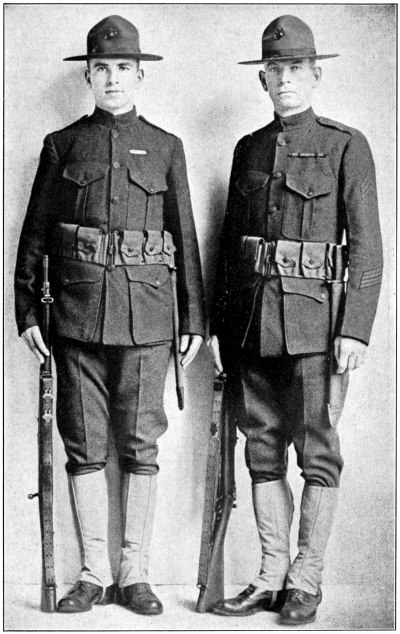
Photo by Harris & Ewing, Washington, D. C.
U. S. Marine Corps
Enlisted men in winter field uniform
Private Sergeant
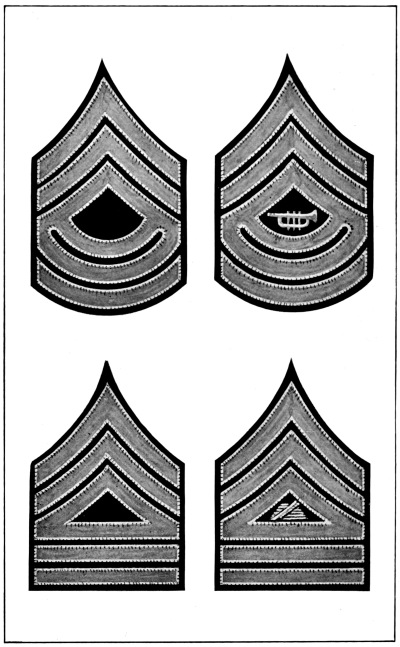
U. S. Marine Corps. Noncommissioned officers’ chevrons
| 1. Sergeant Major |
| 2. Second Leader of Band |
| 3. Quartermaster Sergeant |
| 4. Quartermaster Sergeant, Pay Department |
[Pg 163]
Summer Field Uniform.—A single-breasted coat made of khaki-colored
cotton material, extending to about ten inches below the waist, with
standing collar, buttoned with one row of seven bronze metal Marine
Corps buttons, with a patch pocket and buttoned flap on each breast and
a strap on each shoulder buttoned down at the collar end by a small
bronze button; khaki-colored trousers of the same material as the
coat; tan shoes; khaki-colored canvas leggings; and the field hat of
the shape worn by officers, or a khaki-colored cover fitting tightly
over the dress cap may be worn aboard ship or on other appropriate
occasions. The Marine Corps device in dull finish bronze metal is worn
on the front of the field hat and cap, and in addition the number of
the company in bronze metal letters is worn on the field hat below
the Marine Corps device. Tan leather shoes are always worn with this
uniform. The tan leather belt or the cartridge belt of webbing is worn
with field uniform. In the field or at drills afloat or ashore the coat
is sometimes dispensed with and the khaki-colored flannel shirt is worn.
Winter Field Uniform.—This uniform is made of the same “forestry
green” colored cloth as that worn by officers for winter field uniforms
and consists of a single-breasted coat of the same general style as the
summer field khaki coat but with the addition of an outside pocket on
each side below the waist; trousers or breeches of the same material as
[Pg 164]
the coat, khaki-colored leggings, tan shoes, woolen gloves of the
same color as the coat when needed, the held hat or a cap of the same
material as the coat and the same design as the dress cap but with a
dark tan leather visor and bronze buttons and corps device. The buttons
on the coat of this uniform are also of bronze. At drills and on field
duty the coat may be dispensed with and in that case the flannel shirt
is worn. The tan leather belt or the webbing cartridge belt is worn
with this uniform.
The Overcoat for enlisted men of the Marine Corps is of the same
style and design as the overcoat for officers with a pointed cuff
instead of the officers’ sleeve ornaments.
Rain Clothes for enlisted men consist of a rubber coat, hat and
boots, or the khaki-colored rubber poncho may be worn in the fashion of
a cape.
For wear in very cold climates a turn-down cap of dark brown fur is
provided.
Dungarees are provided for artisans and men requiring them.
Pajamas are provided for all enlisted men.
The rank of the Noncommissioned officers is indicated by chevrons worn
with the point up upon the sleeves of all coats and the flannel shirt
midway between the shoulder and the elbow.
The chevrons for the dress coat are made of stripes of yellow silk
braid one-half of an inch wide on a backing of scarlet cloth, the total
width of the chevron being eight inches.
The chevrons for the summer field coat and for the flannel shirt are
made of cloth of a darker shade than the coat, the stripes being
three-eighths of an inch in width and the whole chevron being three and
one-half inches wide.
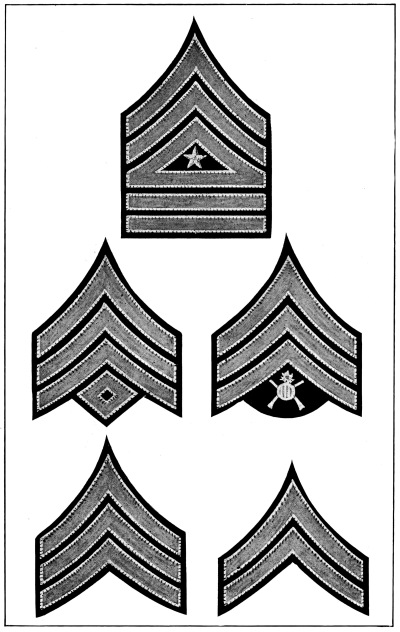
U. S. Marine Corps. Noncommissioned officers’ chevrons
| 1. Drum Major |
| 2. First Sergeant |
3. Gunnery Sergeant |
| 4. Sergeant |
5. Corporal |
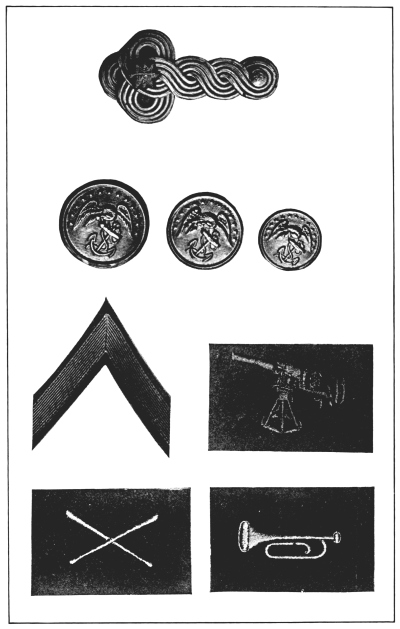
U. S. Marine Corps
| 1. Officers’ shoulder knot |
| 2. Service buttons |
| 3. Chevron for Lance Corporal |
4. Gun Pointer’s sleeve mark |
| 5. Drummer’s sleeve mark |
6. Trumpeter’s sleeve mark |
[Pg 165]
The chevrons for the winter field coat and for the overcoat are made
of the same material as the coat on a backing of scarlet cloth, the
dimensions being the same as for those on the summer field coat.
The chevrons for the flannel shirt are the same as those for the summer
field coat.
The descriptions of the chevrons indicating the different ranks are, as
illustrated, as follows:
Sergeant Major |
Three bars with three arcs of a circle under the bars. |
Second Leader of the Band |
Three bars with three arcs and a cornet in the center. |
Quartermaster Sergeant |
Three bars and three straight ties under the bars. |
Quartermaster Sergeant of the Paymaster Department |
Three bars with three ties and a pile of
coins crossed by a quill pen in the center. |
Gunnery Sergeant |
Three bars with a device of a bursting bomb
and two crossed rifles in the center. |
Drum Major |
Three bars with three straight ties under the
bars and a five-pointed star in the center. |
Sergeant |
Three bars. |
Corporal |
Two bars. |
Lance Corporal (Acting corporal) |
One bar, on the right sleeve only. |
Enlisted men of the Marine Corps who have regularly qualified as
gun pointers aboard ships of the Navy wear a design representing a
six-pounder gun and mount on the right sleeve midway between the wrist
and the elbow, the design to be in scarlet on blue cloth for blue coat
and in drab linen thread for the field coats and flannel shirt.
[Pg 166]
Enlisted men detailed as gun captains aboard ships of the Navy wear the
navy gun captain’s mark on the right sleeve midway between the wrist
and the elbow.
Enlisted men who have qualified as expert riflemen in the navy rifle
target firing course wear a design representing a small arms target
about four inches above the bottom of the sleeve of the dress coat,
field coats, flannel shirt and overcoat, the design showing a target
one inch square with two circles and a bull’s-eye inside of it.
Drummers and trumpeters wear their distinctive marks on each sleeve of
the dress coat, field coats, overcoat and flannel shirt midway between
the shoulder and the elbow; the mark for the drummer being a pair of
drum sticks crossed and that for the trumpeter being a trumpet worn
horizontal, embroidered in yellow thread on blue coats and in gray
thread on the other coats and the shirt.
Service Stripes are worn by all enlisted men who have served
faithfully for one or more enlistment terms in any branch of the
Government service, one stripe being worn for each enlistment; they
are worn on the dress coat, winter field coat and overcoat diagonally
across each sleeve between the wrist and the elbow. For the blue
dress coat these stripes are of yellow silk braid eight inches long
and one-half of an inch wide edged with one-eighth of an inch of
scarlet cloth. For the winter field coat and overcoat they are of the
same material as the coats, three and three-quarters inches long and
three-eighths of an inch wide edged with one-eighth of an inch of
scarlet cloth.
Enlisted men of the Marine Corps Branch of the Naval Militia wear the
same uniforms as the enlisted men of the regular Marine Corps with the
addition of the letters indicating the state or territory to which they
[Pg 167]
belong worn on the collars of the dress coat and field coat, on the
shoulder straps of the overcoat and on the front of the field hat, the
letters being gilt for the dress coat and bronze for the field coat,
overcoat and field hat.
When the Naval Militia is sworn into the service of the United States
in time of war it becomes the National Naval Volunteers and the letter
V is worn in place of the letters indicating the state or territory.
Enlisted men of the Marine Corps Reserve wear the letter R on the dress
cap beneath the Marine Corps device and on the field hat below the
right edge of the Marine Corps device, the company numeral being worn
in a corresponding position below the left edge of the corps device. These
letters are in gilt for the dress cap and in bronze for the field hat.
THE MARINE BAND
The Marine Band, consisting of a Leader, second leader and seventy
musicians, is stationed at the Headquarters Barracks of the Corps in
Washington, D. C., and one of its principal duties is to furnish music
for the official functions at the White House, hence it is popularly
known as the “President’s Band.”
The Leader of the Marine Band wears blue undress, white undress, summer
field and winter field uniforms, cloak, sword and overcoat of the same
material, colors and design as those worn by commissioned officers of
the Line, substituting a lyre one inch high for the insignia of rank,
the lyre being of silver for the undress uniforms and of dull finish
bronze for the field uniforms. His special full dress uniform is the
same as that for a Captain of the Staff, with the addition of seven
rows of gold braid across the front each terminating in a double loop
at either side, and the substitution of a silver lyre one inch high in
[Pg 168]
place of the insignia of rank. His full dress coat is a single-breasted
tunic of scarlet cloth trimmed across the front with seven rows of
black mohair braid of the same design as for the special full dress
coat, and having an ornament consisting of three loops of black braid
on each cuff, and a piping of white cloth around the edges of the
coat; the gold shoulder knots and aiguilettes are worn with this coat.
The trousers worn with this coat are the same as those worn with the
special full dress, dark blue cloth with gold lace stripes down the
outer leg seams.
The special full dress for the second leader and musicians is a single
breasted sack coat of scarlet cloth extending to about ten inches below
the waist, with a standing collar, trimmed with piping of white cloth
around the edges of the coat, the collar and the straps on the shoulder
being of black cloth, the sleeves for the second leader being trimmed
with three loops of black mohair braid and the musicians having pointed
cuffs of black cloth, trousers of sky-blue cloth trimmed down the outer
leg seams with a one-inch stripe of scarlet cloth having a piping of
white cloth one-eighth of an inch wide through the center; a cap of the
same design as that for other enlisted men but made of scarlet cloth
with a black band.
The full dress uniform for the second leader and musicians consists of
a coat of scarlet cloth of the same design as the special full dress
coat with the addition of seven rows of black mohair braid across
the front and shoulder knots and aiguilettes, these being white for
musicians and of gold cord for the second leader; trousers and cap the
same as for special full dress.
The undress, summer field and winter field uniforms and the overcoat
are the same as those worn by other enlisted men of the Marine Corps.
[Pg 169]
The chevrons for the dress uniforms of the musicians of the band are
three and a half inches wide by five inches long and are made of yellow
silk with a lyre embroidered in the center in yellow silk. The chevrons
for the second leader and the drum major are of the same size and
design, but are made of gold lace braid, the second leader having a
cornet embroidered in the center and the drum major a star.
The chevrons for the field uniforms and the overcoat are the same
as for other noncommissioned officers of the Marine Corps with the
addition of the cornet for second leader, the star for drum major and
the lyre for musicians.
The chevrons for the special full dress and full dress coats are of the
same size and design as for the dress coat but are made of white braid
and embroidery.
Identification Tag.—Every officer and enlisted man of the U. S.
Marine Corps on active duty is required to wear an identification tag,
which consists of a round plate of white metal, one and three-eighths
of an inch in diameter, suspended from the neck by a monel metal wire
encased in a cotton covering.
These tags are stamped as follows; for officers, full name and rank;
enlisted men, full name and date of first enlistment in the Marine
Corps. The tags for both officers and men also have the letters “U. S.
M. C.” plainly stamped upon them.
These tags are for the purpose of identification in case of death or
wounds so serious as to produce unconsciousness.
[Pg 170]
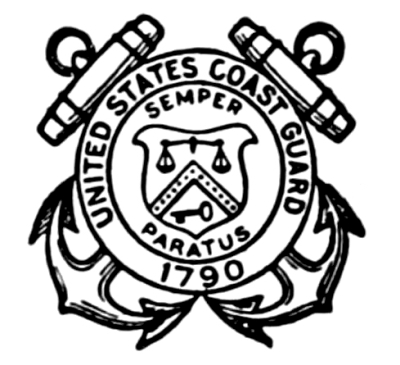
SEAL OF THE U. S. COAST GUARD
CHAPTER VII
UNIFORMS AND INSIGNIA OF
THE U. S. COAST GUARD
The uniforms and insignia of the officers and enlisted men of the U. S.
Coast Guard are very similar to those of the Navy, and they are made
of dark blue cloth for wear in cold or temperate weather and of white
duck for wear in the tropics or in hot weather. A variation from this
general rule is found in the case of the Keepers and surfmen on duty
at the Life-Saving Stations who have uniforms of khaki or olive-drab
cotton duck instead of the white uniforms of the seagoing men of the
Coast Guard.
UNIFORMS OF OFFICERS OF THE U. S. COAST GUARD
Commissioned officers of the Coast Guard are required to have complete
outfits of full dress, dress, evening dress, blue service dress and
white service dress uniforms; the occasions for wearing the various
uniforms being as follows:
[Pg 171]
TABLE OF OCCASIONS FOR UNIFORMS
| |
| Occasion. |
Uniform. |
1. State occasions at home and abroad. |
Full dress. |
2. Receiving or calling officially upon the President of the United States
or the president or sovereign or a member of the royal family of any country. |
3. At ceremonies and entertainments where it is desired
to do special honor to the occasion. |
4. At general muster on the first Sunday of each month. |
5. When receiving an ex-President of the United States, the
Vice President or the Secretary of the Treasury. |
6. When receiving an Assistant Secretary of the Treasury. |
Dress uniform.
[Pg 172] |
7. When receiving a member of the President’s Cabinet
other than the Secretary of the Treasury. |
8. When receiving the Chief Justice of the United States,
the President of the Senate, the Speaker of the House of
Representatives, or a Committee of Congress. |
9. When receiving the Governor of an island or group of islands occupied
by the United States, or a Governor of one of the States or Territories
of the United States, when within the waters of the state or territory
or islands of which he is governor. |
10. When receiving a Diplomatic Representative of the United States
above the rank of Charge d’affaires when within the waters of the
country to which he is accredited. |
11. When receiving a military or naval officer of or
above the rank of Brigadier General or Commodore. |
12. When making the first visit in port to commanding
officers and on occasions of ceremony and duty on shore where such uniform
would be appropriate. |
13. When serving upon Coast Guard service courts. |
14. At muster on Sundays other than the first Sunday of each month. |
15. On all occasions of ordinary duty and service. |
Service dress or white service dress. |
16. On occasions of ceremony in the evening to which officers are invited in
their official capacity, such as public balls, dinners and evening receptions. |
Evening dress uniform. |
| |
When serving as a part of the Navy during war the uniform prescribed
for all ordinary occasions of duty is service dress, blue or white
depending upon the temperature and weather.
The Full Dress Uniform consists of a frock coat of dark blue cloth;
trousers of dark blue cloth with a stripe of gold lace braid down each
outer leg seam, the stripe being one inch wide for all officers above
the rank of Third Lieutenant and one-half inch for Third Lieutenant;
gold shoulder knots; full dress cap; white gloves; black shoes; and the
sword suspended by slings from a full dress belt, the belt and slings
being covered with gold lace braid, the belts for all lieutenants and
officers of corresponding rank having four stripes of dark blue silk
woven through the gold braid.
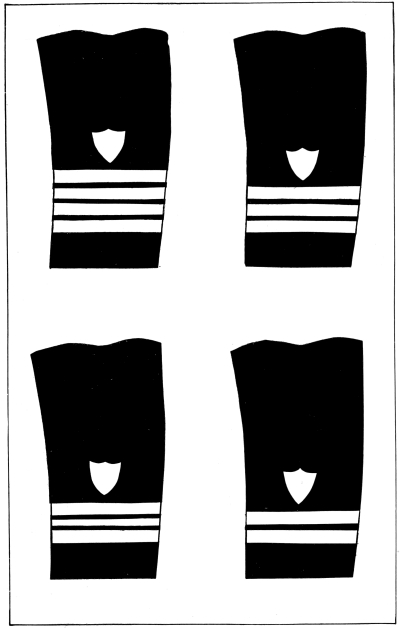
U. S. Coast Guard. Officers’ sleeve braiding indicating rank
Gold braid on full dress, dress, evening dress and blue service coats.
Black braid on overcoats, without the shields
| 1. Captain Commandant |
2. Senior Captain |
| 3. Captain |
4. First Lieutenant |
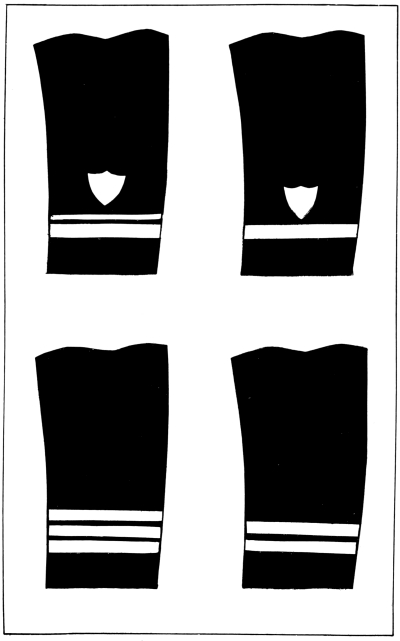
U. S. Coast Guard. Officers’ sleeve braiding indicating rank
Gold braid on full dress, dress, evening dress and blue service coats.
Black braid on overcoats, without the shields
| 1. Second Lieutenant |
2. Third Lieutenant |
| 3. Engineer in Chief |
4. Lieutenant of Engineers |
[Pg 173]
The full dress coat extends nearly to the knee, is double-breasted with
two rows of gilt Coast Guard buttons, nine in each row, has a standing
collar trimmed with gold lace braid, the braid being one-half inch wide
for officers of the rank of Third Lieutenant and one inch wide for
officers above that rank. The sleeves are trimmed with stripes of gold
braid as shown in the illustrations, the number of stripes for officers
of the Line being as follows:
Captain Commandant.—Four stripes one-half inch wide, the lower
stripe two inches above the edge of the cuff, and a gold embroidered
shield one inch high above the stripes.
Senior Captain.—Three stripes of one-half inch wide with the gold
shield above.
Captain.—Two stripes one-half inch wide with one stripe one-quarter
of an inch wide between them and the gold shield above.
First Lieutenant.—Two stripes one-half inch wide with the gold
shield above.
Second Lieutenant.—One stripe one-half inch wide with one stripe
one-quarter inch wide above it and the gold shield above.
Third Lieutenant.—One stripe one-half inch wide and the gold
shield above.
Engineer Officers wear the same stripes as prescribed for officers of
the Line of corresponding rank, but not the gold shield.
Constructors and District Superintendents wear the same stripes
as officers of the Line of corresponding ranks with the addition of
[Pg 174]
stripes of distinctive color between the gold stripes; these
distinctive stripes being of light brown velvet for Constructors and of
light green cloth for District Superintendents.
The shoulder knots are made of gold wire cord and consist of a twisted
strap terminating in an oval pad. The Corps insignia of the Coast Guard
consisting of a silver foul anchor one and five-eighths inches long
surcharged with a gold shield and the insignia of rank are embroidered
upon the gold lace in the center of the pad.
The full dress cap for commissioned officers is made of dark blue
cloth, bell-crowned, with a sloping visor of leather covered with dark
blue cloth, the visors for Captain Commandant, Senior Captain and
Captains being decorated with a design of oak leaves and those for
the Engineer in Chief and Captains of Engineers being decorated with
a one-half inch gold band around the edge. The Coast Guard insignia
are embroidered on the fronts of the caps and consist of a gold spread
eagle with a silver shield upon his breast, the talons of the eagle
resting upon a silver foul anchor. Across the front of the cap just
above the visor is a chin strap of one-half inch gold braid secured by
a small gilt button at each end of the visor. The full dress cap for
the Captain Commandant only has a narrow welt of gold braid around the
upper edge of the crown.
The full dress belt for the Captain Commandant, Senior Captains,
Captains and Staff officers of corresponding rank is covered with gold
lace braid and that for Lieutenants and Staff officers of corresponding
rank is covered with gold lace braid having four narrow stripes of dark
blue silk woven through it.
The Dress Uniform.—Is the same as the full dress except that plain
trousers of dark blue or white are worn.
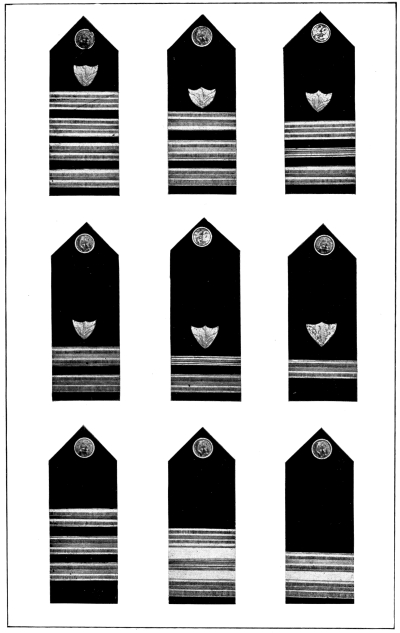
U. S. Coast Guard. Officers’ shoulder marks indicating rank
Worn on the white service uniform coat and the overcoat. The shields
above the stripes indicate Line officers. Gold stripes without the
shields indicate Engineer officers. Light brown stripes between the
gold stripes. Constructors. Light green stripes between the gold
stripes, District Superintendent.
| 1. Captain Commandant |
2. Senior Captain |
3. Captain |
| 4. First Lieutenant |
5. Second Lieutenant |
6. Third Lieutenant |
| 7. Engineer Officers |
8. Staff Officers |
9. Staff Officers |
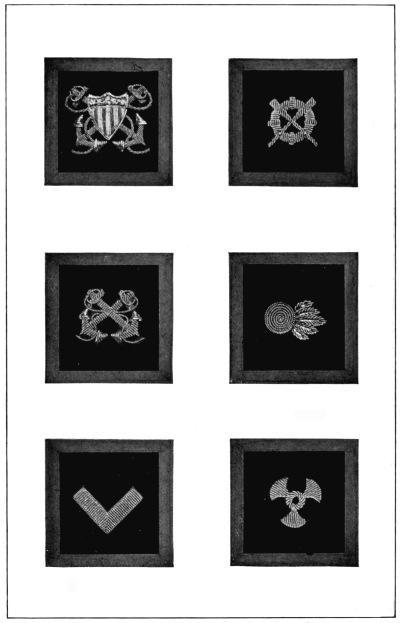
U. S. Coast Guard. Warrant officers’ collar insignia
| 1. Master’s Mate |
2. Keeper |
| 3. Boatswain |
4. Gunner |
| 5. Carpenter |
6. Machinist |
[Pg 175]
The Service Dress Uniform consists of the blue or white service coat,
plain blue or white trousers and the blue or white service cap, black
shoes being worn with the blue uniform and white shoes with the white
uniform. When the sword is worn with this uniform it is suspended from
a belt of black leather worn under the coat.
The Blue Service Coat is made of dark blue cloth or serge, with a
standing collar, single-breasted, extending to about ten inches below
the waist, trimmed around the collar, down both front edges, around the
bottom and up the side seams of the back with black mohair braid one
and one-quarter inches wide. The sleeves bear the same gold stripes
indicating the rank of the wearer as those on the full dress coat, and
on both sides of the collar are embroidered the insignia of rank with
the insignia indicating Line or Staff in rear of it.
These insignia for commissioned officers of the Line are as follows:
| Captain Commandant |
A silver spread eagle with a shield upon his breast. |
| Senior Captain |
A silver oak leaf. |
| Captain |
A gold oak leaf. |
| First Lieutenant |
Two silver bars. |
| Second Lieutenant |
One silver bar. |
| Third Lieutenant |
No insignia of rank, the Coast Guard insignia only being worn. |
The Coast Guard insignia worn on the collar by commissioned officers of
the Line consist of a silver foul anchor surcharged with a gold shield.
Officers of the Staff Corps (Engineers and Constructors) wear the
[Pg 176]
insignia of rank of their corresponding rank in the Line and instead
of the Coast Guard insignia worn by the Line officers they wear the
insignia of their corps, as follows:
Engineer Officers.—A silver foul anchor surcharged with four gold
oak leaves.
Constructors.—A silver foul anchor surcharged with a branch of
gold leaves.
The White Service Coat for commissioned officers is a single-breasted
coat of the same length as the blue service coat, with standing collar,
buttoned with a single row of five Coast Guard gilt buttons, and having
on each breast a pocket with a flap buttoned by a small gilt button.
Shoulder marks indicating the rank and corps of the wearer are worn
with this coat.
Shoulder Marks.—The shoulder marks worn on the shoulders of the
white service coat and also upon the shoulders of the overcoat to
indicate the rank and corps of the wearer are five inches long and two
and a quarter inches wide, covered with dark blue cloth, and decorated
with gold stripes and corps insignia to indicate the rank and corps of
the wearer, these stripes and insignia being the same for the various
ranks and corps as those worn on the sleeves of the full dress coat as
previously described.
The Blue Service Cap is of the same shape and design as the full
dress cap except that the braid around the band is of black mohair
and the visor is made of black patent leather, the decorations on the
visor for the Captain Commandant, Senior Captains, Captains, Engineer
in Chief and Captains of Engineers being of gold embroidery the same as
for the full dress cap.
The White Service Cap is of the same shape and description as the
blue service cap except that the sides and crown above the band are of
white duck.
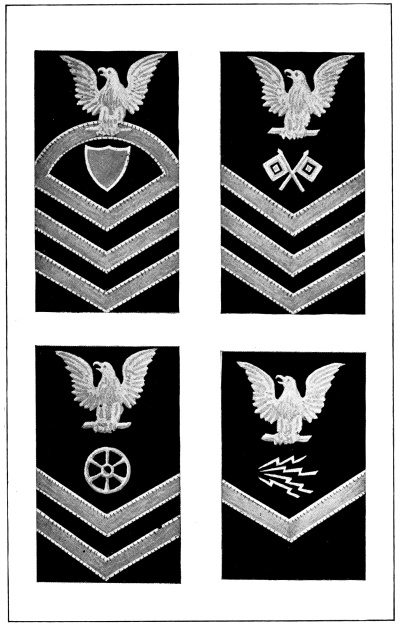
U. S. Coast Guard. Petty officers’ chevrons
| 1. Master-at-Arms |
2. Signal Quartermaster |
| 3. Water Tender |
4. Electrician, Third Class |

U. S. Coast Guard. Petty officers’ specialty marks
| 1. Wheelman |
2. Electrician |
3. Coxswain |
| 4. Sailmaker |
5. Carpenter, Plumber, Painter |
6. Yeoman |
| 7. Blacksmith |
8. Bayman |
9. Bugler |
[Pg 177]
The Sword and Sword Knot are the same as those for the officers of
the U. S. Navy except that the letters “U. S. C. G.” are etched upon
one side of the blade.
The Overcoat for Commissioned Officers of the Coast Guard is the same
as that for officers of the U. S. Navy (see page 116),
the rank and corps being indicated by the shoulder knots the same as those worn
on the white service coat, and the rank also being indicated by stripes
of black braid upon the sleeves, the number and widths of the stripes
being the same as for the full dress and blue service coats.
The Cloak for Commissioned Officers is the same as that for officers
of the U. S. Navy (see page 117).
The Warrant officers of the U. S. Coast Guard are required to have
complete outfits of blue dress, blue service dress, and for all except
the Keepers of Life-Saving Stations, white service uniforms. The
Keepers of Life-Saving Stations are required to have an olive-drab
cotton service uniform in lieu of the white service uniform required
for other warrant officers.
The Blue Dress Uniform for Warrant officers is the same as the blue
service uniform for commissioned officers except that in place of the
gold braid on the sleeves of the coat there is one stripe of black
mohair braid one inch in width, and on each side of the collar the
insignia of rank are worn, these insignia being for the various ranks
as follows:
| Master’s Mate |
Two gilt foul anchors crossed surcharged with a silver shield. |
| Keeper |
A gilt life buoy surcharged with two gilt oars crossed. |
| Boatswain |
Two gilt foul anchors crossed. |
| Gunner |
A gilt spherical shell bursting into flame. |
| Carpenter |
A gilt carpenter’s square. |
| Machinist |
A gilt propeller wheel. |
[Pg 178]
The Blue Service Uniform is the same as the blue dress uniform.
The White Service Uniform for Warrant officers is the same as that
for the commissioned officers except that the shoulder marks are not
worn on the coat, the rank being indicated by metal insignia worn on
the collar as described for the blue service coat, and the insignia
worn upon the cap being two gilt foul anchors crossed and surmounted by
a silver shield.
The Olive-drab Service Uniform worn by the Keepers of Life-Saving
Stations is of the same design as the white service uniform worn by
other warrant officers but the buttons and insignia worn with it are of
dull finish bronze metal.
The Overcoat for Warrant Officers is the same as that for
commissioned officers except that there are no stripes on the sleeves
and the shoulder marks are not worn with it.
The Sword and Belt worn by warrant officers is the same as that worn
by commissioned officers with service uniform.
UNIFORMS OF ENLISTED MEN OF
THE COAST GUARD
The uniforms of the enlisted men of the Coast Guard are practically the
same in style and design as those worn by the enlisted men of the U. S.
Navy with minor differences in the buttons and insignia of rank and the
rating badges and specialty marks.
The uniforms of the Chief Petty Officers have the buttons of the Coast
Guard design on the coats and the insignia on the caps consisting of a
vertical gilt foul anchor surmounted by a silver shield.
For Surfmen stationed at Life-Saving Stations the summer uniform is
[Pg 179]
made of olive-drab cotton duck and the buttons and insignia worn upon
the coats and caps are of dull finish bronze metal.
The insignia of rank or rating for Petty Officers are worn upon the
right sleeve of the coat or shirt midway between the shoulder seam and
the elbow, and consist of a chevron with a spread eagle above it and a
specialty mark below the eagle in the upper angle of the chevron.
The chevron is worn with the point down and is made of stripes of cloth
three-eighths of an inch wide set one-quarter of an inch apart, these
stripes being of scarlet cloth for blue coats and shirts and of blue
cloth for white and olive-drab coats and shirts.
The eagle and the specialty marks are embroidered in white silk for
blue coats and shirts and in blue silk for white and olive-drab coats
and shirts.
The chevron for Chief Petty Officers consists of three stripes with an
arc of a circle connecting the ends of the upper stripe; that for First
class petty officers of three stripes, that for Second class petty
officers of two stripes and that for Third class petty officers of one
stripe, as illustrated.
The Specialty Marks indicating the particular duty or assignment of
the petty officers and of certain other men having special duties are,
as shown in the illustrations, as follows:
Master-at-Arms.—An upright shield.
No. 1 Surfman.—A circular life buoy surmounted by two oars crossed.
Signal Quartermaster.—Two flags crossed diagonally.
Wheelman.—A ship’s steering wheel with eight spokes.
Coxswain.—A vertical anchor crossed by a horizontal arrow.
[Pg 180]
Electrician.—A hemisphere on a vertical axis.
Electricians, First, Second and Third Class.—A device representing
forked lightning, four streaks.
Sailmakers.—A closed clew iron with two eyes.
Blacksmith.—Two sledges crossed diagonally.
Yeoman and Ships Writer.—Two quill pens crossed diagonally.
Machinist and Oiler.—A ship’s propeller with three blades.
Water Tender.—A valve wheel with six spokes.
First and Second Class Carpenters, Plumbers and Painters.—Two axes
crossed diagonally.
Bayman (Hospital Nurse).—A red Geneva cross.
Service Stripes.—For each three years service in the Coast Guard or
U. S. Navy an enlisted man of the Coast Guard wears one service stripe.
These stripes are three-eighths of an inch wide and eight inches long
and are worn diagonally across the outer side of the left sleeve of the
coat or shirt. They are made of scarlet cloth for blue coats and shirts
and of blue cloth for white and olive-drab coats and shirts.
Branch Marks.—All enlisted men of the Coast Guard except buglers
and mess attendants wear a narrow stripe around the shoulder seam of
the right sleeve of the uniform shirts to indicate the branch of the
service to which they belong; the stripe being red for the Engineer’s
force and for all others white on blue shirts and blue on white shirts.
Buttons.—The metal buttons for the Coast Guard have a plain outer
rim with an inner rim of rope design enclosing a design in relief, this
design consisting of a vertical foul anchor surmounted by an eagle with
the wings lifting with a wreath of laurel on one side of the anchor and
[Pg 181]
a wreath of oak leaves on the other side. The buttons are of bright
gilt for blue and white clothes and of dull finish bronze for olive
drab clothes.
Enlisted men of the Coast Guard wear a black silk cap ribbon on the
blue flat cap, the ribbon for men serving aboard ship having the name
of the ship and the letters “C. G.,” thus,
U. S. S. ALGONQUIN, C. G.
and the ribbon for men serving at shore stations having the inscription,
U. S. COAST GUARD.
Leggings.—When on landing duty or guard duty ashore officers and
enlisted men wear leggings of olive-drab similar to those worn in the U. S. Navy.
Gloves of iron gray wool are worn by enlisted men in cold weather.
[Pg 182]
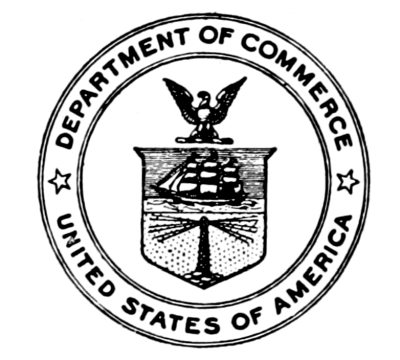
SEAL OF THE DEPARTMENT OF COMMERCE
CHAPTER VIII
UNIFORMS AND INSIGNIA OF THE U. S. LIGHTHOUSE SERVICE
AND U. S. COAST AND GEODETIC SURVEY
The United States Lighthouse Service is administered under the
Department of Commerce and consists of three divisions; first, the
officers and crews of the lighthouse tenders; second, the officers and
crews of the lightships; and third, the keepers of the lighthouses and
depots on shore.
The lighthouse tenders are steamers which plant and maintain all of the
buoys which mark the channels and courses for ships of various sizes in
the navigable waters of the United States, including the bays, harbors,
lakes and navigable rivers. The lighthouse tenders also carry supplies
to the lightships and many of the shore lighthouses.
Lightships are vessels carrying powerful lights anchored in places
where it is necessary to have lights to aid in the navigation of
seagoing craft but where it would be impossible or impracticable to
build lighthouses.
[Pg 183]
The Depots of the Lighthouse Service are shore establishments where
buoys, lights and lightships may be overhauled and repaired and where
supplies may be kept in stock.
UNIFORMS OF OFFICERS AND ENLISTED MEN
OF LIGHTHOUSE TENDERS
The officers are provided with a blue uniform for cold and temperate
weather and a white uniform for hot weather.
The blue uniform consists of a single-breasted sack coat of navy blue
cloth extending to about ten inches below the waist, with a standing
collar, buttoning down the front by buttons concealed under a fly, the
collar, front and bottom edges being trimmed with black mohair braid
one and one-quarter inches wide; plain trousers of dark blue cloth;
and a cap of navy blue cloth with a sloping visor of patent leather, a
band of black mohair braid one and one-half inches wide, a chin strap
of one-half inch gold braid secured above the visor by means of a small
gilt button at each end of the visor. The insignia of the Lighthouse
Service, a lighthouse, are embroidered in silver on the front of the
cap, surrounded by a wreath embroidered in gold.
The rank of the officer is indicated by stripes of black mohair braid
around the sleeves, the number and width of the stripes for the
different grades being as follows:
Captain.—Four stripes, the two outer ones one-half inch and the
two inner ones one-quarter inch wide.
Chief Engineer.—Three stripes, the two outer ones one-half inch and
the inner one one-quarter inch wide.
[Pg 184]
Master of Tender.—Four stripes one-quarter of an inch wide.
First Officer and Engineer of Tender.—Three stripes one-quarter of an inch wide.
First Officer and First Assistant Engineer of Tender.—Two stripes one-quarter inch wide.
Third Officer and Second Assistant Engineer of Tender.—One stripe one-quarter inch wide.
Insignia indicating the department to which an officer belongs are
worn on each side of the collar, a gold anchor for deck officers
(corresponding to Line officers in the Navy) and a gold three-bladed
propeller for Engineer Officers.
The white uniform is similar in style and design to the blue uniform,
the braid being white and the insignia on the coat collar of gilt metal.
The Overcoat for Officers is double-breasted, made of dark blue
cloth, extending to three inches below the knee, with two rows of black
flat buttons down the front, six in each row and a wide rolling collar.
It bears no stripes or insignia.
Quartermasters and machinists wear a blue uniform consisting of a
double-breasted sack coat of dark blue cloth, with five gilt buttons on
each side, turn-down collar and lapels, two side pockets with flaps;
plain dark blue cloth trousers; and a cap of the same pattern as that
worn by officers, but having a black patent leather chin strap, and the
letters “U. S. L. H. S.” embroidered in gold around the base of the
silver lighthouse insignia instead of the gold wreath on the front of
the officers’ cap.
The insignia indicating the rank, worn on each sleeve midway between
the shoulder seam and the elbow, consist of a ship’s steering wheel
embroidered in white for quartermaster and a three-bladed propeller
embroidered in red for machinist.
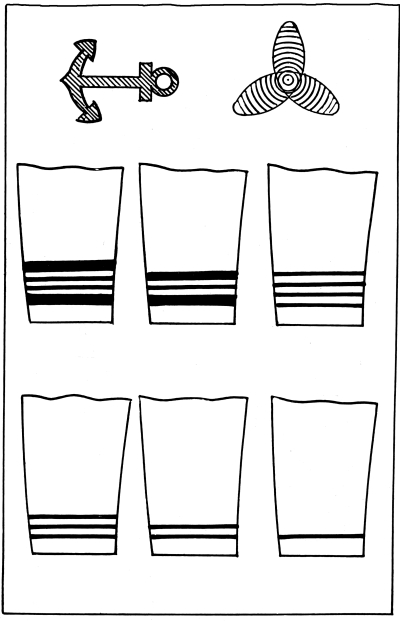
U. S. Lighthouse Service.
Officers’ collar insignia and sleeve braiding
Collar insignia (Gold embroidery)
| 1. Deck Officers |
|
2. Engineer Officers |
| Sleeve braiding (Black mohair braid) |
| 3. Captain |
4. Chief Engineer |
5. Master of Tender |
| 6. First Officer, |
7. Second Officer, |
8. Third Officer |
| Engineer, |
First Asst. Engineer, |
Second Asst. Engineer |
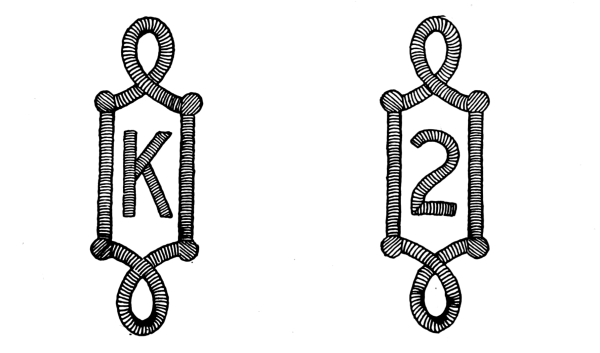
Insignia for Lighthouse Keepers and Watchmen
Light Stations and Depots
Keepers of lighthouses
K for keeper
| 1 for first assistant keeper |
| 2 for second assistant keeper |
| 3 for third assistant keeper |
| 4 for fourth assistant keeper |
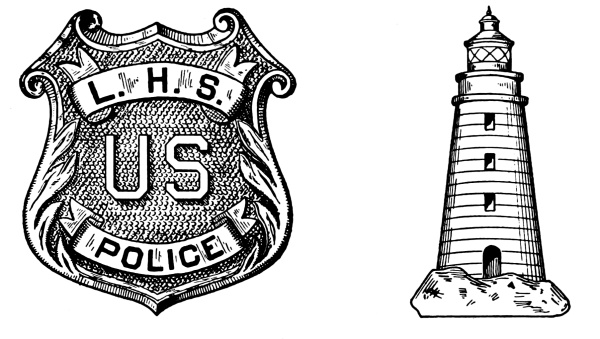
Watchmen at general depot
U. S. Lighthouse Service
[Pg 185]
For hot weather a uniform of white duck is provided, the design and the
insignia being the same as for the blue uniform except that the sleeve
stripes are of white braid.
Seamen of the crew wear blue and white uniforms similar to the working
uniforms for the enlisted men of the United States Navy, and the
firemen wear a blue dungaree uniform of the same pattern.
Stewards, cooks and mess attendants wear a cap similar to the officers’
cap but without ornaments or braid; a plain single-breasted coat with
standing collar and plain trousers. The coats for steward have gilt
buttons, the cooks and mess attendants plain buttons.
UNIFORMS AND INSIGNIA FOR OFFICERS AND
ENLISTED MEN OF LIGHTSHIPS
The officers wear a uniform of navy blue cloth for winter and of navy
blue serge or flannel for summer, consisting of a double-breasted sack
coat with turn-down collar and lapels, with five gilt buttons on each
side; a single-breasted waistcoat with a rolling collar and five small
gilt buttons; plain trousers; and a cap the same as described for
officers of lighthouse tenders.
Insignia are worn on the lapels of the coat, a gold anchor for deck
officers and a gold three-bladed propeller for engineer officers.
Stripes of black mohair braid are worn on each sleeve, as follows:
Master.—Three stripes one-quarter inch wide.
First Mate.—Two stripes one-quarter inch wide.
[Pg 186]
Second Mate.—One stripe one-quarter inch wide.
Engineer.—Two stripes one-quarter inch wide.
Assistant Engineer.—One stripe one-quarter inch wide.
The overcoat is the same as that for officers of Lighthouse Tenders.
The enlisted men of the lightships wear the same uniforms as those
described for the enlisted men of the lighthouse tenders.
UNIFORM AND INSIGNIA OF LIGHTHOUSE
AND DEPOT KEEPERS
Keepers of lighthouses and depots wear uniforms similar to those for
Masters of lightships, except that no braid is worn on the sleeves
and the ratings are shown by the letter “K” or numbers on the collar,
while Watchmen wear the letter “W” and a Police shield, as shown in the
illustrations.
The regulation buttons for the Lighthouse service are gilt and have a
design consisting of a lighthouse surrounded by a circle of rope.
UNIFORMS AND INSIGNIA OF THE U. S. COAST
AND GEODETIC SURVEY
Whenever in his judgment a national emergency requires it the President
may transfer the ships and personnel of the U. S. Coast and Geodetic
Survey from the Department of Commerce to the War Department or Navy
Department. When so transferred the commissioned officers take relative
rank as follows:
Grade 1. Hydrographic and Geodetic Engineers with and after Colonels in
the Army and Captains in the Navy.
Grade 2. Hydrographic and Geodetic Engineers with and after Lieutenant
Colonels in the Army and Commanders in the Navy.
Grade 3. Hydrographic and Geodetic Engineers with and after Majors in
the Army and Lieutenant Commanders in the Navy.
Grade 4. Hydrographic and Geodetic Engineers with and after Captains in
the Army and Lieutenants in the Navy.
Grade 5. Junior Hydrographic and Geodetic Engineers with and after
First Lieutenants in the Army and Lieutenants Junior Grade in the Navy.
Grade 6. Aides with and after Second Lieutenants
in the Army and Ensigns in the Navy.
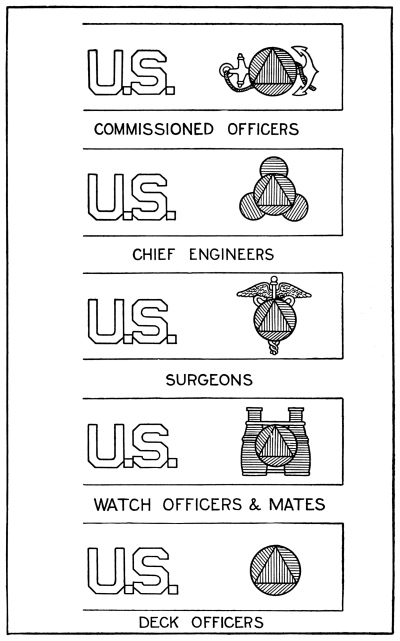
U. S. Coast and Geodetic Survey
Officers’ collar insignia, showing branch of the service
[Pg 187]
Chief Engineers, surgeons, watch officers, mates and deck officers have
relative rank with and after commissioned officers of the same rates of
pay and when transferred they are given commissions in the Army Reserve
or Naval Reserve Force according to their qualifications.
All officers are required to have blue service dress, white service
dress and field uniforms and an overcoat.
The blue service dress uniform consists of a coat, trousers and
cap of dark blue cloth, black shoes and white gloves, the style and
trimming being practically the same as for officers of the U. S.
Navy. Rank is indicated by stripes of gold lace around the sleeves,
the branch of the service by insignia embroidered on the collar and
the service insignia is embroidered on the front of the cap, as
illustrated. Commissioned officers wear a gold triangle on a circular
silver base on each sleeve above the rank stripes and the branch of
other officers is shown by stripes of colored velvet between the rank
stripes, the distinctive colors being light blue for Chief Engineers,
dark maroon for Surgeons and dark brown for Mates and Watch Officers.
The white service uniform consists of a single-breasted coat of white
duck or drill, with a stand and fall collar, five gilt service buttons
down the front, two breast pockets and two lower pockets with flap and
gilt button and a strap on each shoulder from the shoulder seam to
the base of the collar. Rank is shown by bright metal insignia on the
shoulder straps as illustrated.
The field uniform is identical with the white uniform except that
the color is khaki and the buttons and collar ornaments are of bronzed metal.
The overcoat is of the same pattern as that worn by officers of the
U. S. Navy, rank and branch being shown by gold stripes and color
stripes as on the sleeves of the blue service coat.
The sword and belt are of the U. S. Navy pattern with the letters
U.S.C. & G.S. on the blade.
[Pg 188]
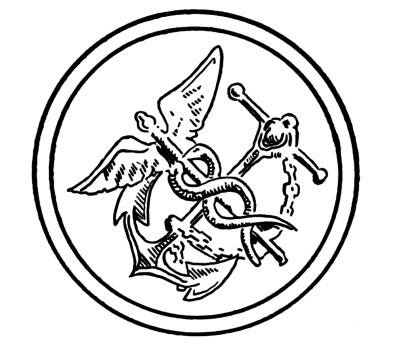
SEAL OF THE U. S. PUBLIC HEALTH SERVICE
CHAPTER IX
UNIFORMS AND INSIGNIA OF
THE U. S. PUBLIC HEALTH SERVICE
The U. S. Public Health Service, operated as a Bureau of the Department
of the Treasury, has charge of the enforcement of the quarantine
regulations for the prevention of the introduction of contagious and
infectious diseases into the United States from abroad or from one
state or territory to another; the care of sick and disabled seamen
of the merchant marine, and of scientific research at home and abroad
regarding diseases of man which may affect the general public health
and welfare.
This service was formerly known as the Public Health and Marine
[Pg 189]
Hospital Service, but by an Act of Congress dated August 14, 1912, the
name of the service was changed to the Public Health Service and its
duties were increased and its powers and responsibilities much enlarged.
The Public Health Service is administered under a Surgeon General
stationed at the National Capital, the various duties being assigned to
seven divisions.
The Division of Scientific Research, as its name implies, is charged
with studies of various diseases such as typhoid, malarial, typhus and
yellow fevers, leprosy, tuberculosis, trachoma, pellagra, sanitation
and hygiene, water supply and sewage and public health administration
in states and cities in cooperation with the local authorities. This
division conducts a Hygienic Laboratory at Washington and a number
of field laboratories where intensive studies in these subjects are
conducted. Through this division the Surgeon General of the Service
enforces the laws for the regulation of the sale of viruses and serums
and calls annual and special conferences of the health authorities of
the several states and territories for the purpose of cooperation in
the suppression of preventable diseases and the general improvement of
the public health.
The Division of Foreign and Insular Quarantine and Immigration is
charged with the execution of the national quarantine laws, this being
accomplished at fifty Federal Quarantine Stations in the United States,
with additional stations at Panama, Porto Rico, the Virgin Islands,
Hawaii and the Philippines. There are also medical officers under this
division detailed at various Consular stations of the United States
in foreign countries to assist in the prevention of the introduction
of contagious or infectious diseases into the United States or its
[Pg 190]
possessions. This division also conducts the physical and mental
examinations of all aliens entering the territory of the United States
at any of its ports.
The Division of Domestic and Interstate Quarantine has charge of the
enforcement of the laws for the prevention of the spread of contagious
or infectious diseases from one state or territory to another.
The Division of Sanitary Reports and Statistics has cognizance of the
collection and publication of information relative to the diseases which
may threaten the public health of the United States and foreign countries.
The Division of Marine Hospitals has charge of twenty-two Marine
Hospitals and about one hundred and twenty-five smaller relief stations
at the different ports and cities of the country.
At these stations and hospitals the sick and disabled officers and
seamen of the Coast Guard and Lighthouse Services, the Mississippi
River Commission, the Engineer Corps of the Army at work upon rivers
and harbors works, and the registered and licensed ships of the United
States merchant marine are given necessary medical and surgical
treatment. This division also furnishes the medical officers for the
vessels of the Coast Guard.
The Division of Personnel and Accounts has charge of the record of the
officers and men of the service and of the expenditures of the moneys
appropriated for the service from the public funds.
The Miscellaneous Division issues the various annual reports, public
health reports and other publications of the service, including the bulletins
of the results of research at the Hygienic Laboratory at Washington.
The officers of the Public Health Service have titles corresponding to
[Pg 191]
their duties and rank assimilated to that of the Army and Navy, the
different grades being as follows:
- COMMISSIONED OFFICERS
- Surgeon General.
- Assistant Surgeon General.
- Senior Surgeon.
- Surgeon.
- Professor of Hygienic Laboratory.
- Passed Assistant Surgeon.
- Assistant Surgeon.
- Quarantine Inspector.
- Acting Assistant Surgeon.
- Chaplain.
- WARRANT OFFICERS
- Interne.
- Pharmacist.
- Clerk.
- ENLISTED MEN
- Station Engineer.
- Pilot.
- Marine Engineer.
- First Cook.
- Cooks.
- Coachman.
- Carpenter.
- Yardman.
- Messenger.
- Laundryman.
- Surgical Nurse.
- Female Nurse.
- Night Watchman.
- Ship Keeper.
- Boatswain.
- Coxswain.
- Ordinary Seaman.
- Fireman.
- Coal Passer.
- Boy.
[Pg 192]
COMMISSIONED OFFICERS’ UNIFORMS
The commissioned officers of the service are required to have complete
outfits of full dress, dress, olive-drab service, white service and
evening dress uniforms.
The Full Dress Uniform consists of a double-breasted frock coat
of dark blue cloth with two rows of gilt buttons down the front, and a
standing collar trimmed with gold lace braid; dark blue cloth trousers
with gold stripes down the outer leg seams, one and three-quarter
inches wide for Surgeon General, one and one-half inches wide for
Assistant Surgeon General and one inch wide for other officers; a blue
cloth cap with black patent leather visor; black patent leather shoes,
white gloves, and full dress sword belt and sword.
The blue cap has a bell crown, the band being of gold braid one and
one-half inches wide with a narrow stripe of maroon silk through the
center of it and the chin strap worn across the front just above the
visor being of gold braid five-eighths of an inch wide with a narrow
stripe of maroon silk through the center. The edge of the visor is
decorated with gold embroidery, and on the front and center of the cap
the distinctive device of the Public Health Service is embroidered.
The Surgeon General wears gold epaulets on the shoulders of the
[Pg 193]
full dress coat with the service insignia and the insignia of his rank,
one silver star, embroidered on the top, and the other commissioned
officers have shoulder straps of maroon colored broadcloth on the
shoulders, these straps being trimmed around the edges with a stripe
of gold braid three-quarters of an inch wide and having on them at the
center the insignia of the Public Health Service and between this and
the shoulder end the insignia of rank.
On the sleeves of the full dress coat are stripes of gold lace braid to
indicate the rank of the wearer as follows:
The Surgeon General.—One band two inches wide, gold-thread lace
around each sleeve, two inches from lower edge of cuff, with one band
one-half inch gold-thread lace one-fourth inch above; the bands being
interspaced with maroon broadcloth.
Assistant Surgeon General.—Four bands of gold-thread lace one-half
inch wide; distance between bands one-fourth inch; the bands being
interspaced with maroon broadcloth.
Senior Surgeon.—Same as for Assistant Surgeon General, omitting
uppermost band.
Surgeon.—Two bands of gold-thread lace one-half inch wide, with one
band one-fourth inch wide between; distance between bands one-fourth
inch; the bands being interspaced with maroon broadcloth.
Passed Assistant Surgeon.—Same as for surgeon, omitting one-fourth
inch band; distance between bands to be one-fourth inch.
Assistant Surgeon.—Same as for passed assistant surgeon,
substituting one-fourth-inch band for upper band.
The Dress Uniform consists of the blue cap as prescribed for
[Pg 194]
full dress; dark blue serge trousers with a two-inch welted stripe of
the same material down the outer leg seam; black leather shoes; white
gloves; and a single-breasted sack coat of dark blue serge buttoned
down the front by five gun-metal service buttons, with a standing
collar. On each shoulder there is a strap of the same material as the
coat extending from the shoulder seam to the collar where it is secured
by a small service button and on the center of this strap is worn the
insignia of rank. There are four patch pockets on the front of the coat
each one having a shield shaped flap secured by a small service button,
one pocket being on each breast and one on each side below the waist.
The Service Uniform is of the same design as the dress uniform but
it is made of olive-drab serge or khaki-colored cotton drill and tan
leather shoes are worn. The cap is of olive-drab serge with a russet
leather visor and chin strap, a band of olive-drab mohair braid and the
service insignia of gun-metal.
The white Service Uniform is of the same design as the olive-drab
service uniform but the material is white linen, and white shoes are
worn. The white cap has a black patent leather visor, black mohair band
and the same service insignia as worn on the blue cap.
The Blue Evening Dress Uniform is of dark blue cloth, cut after the
prevailing style for civilian’s evening dress, but having gilt service
buttons on the coat and waistcoat, and the same shoulder straps and
rank stripes on the sleeves as prescribed for the full dress coat.
The White Evening Uniform consists of a dinner coat, waistcoat and
trousers cut after the prevailing style for civilian’s clothing, but
having gilt buttons on the coat and waistcoat and shoulder straps of
the same material as the coat.
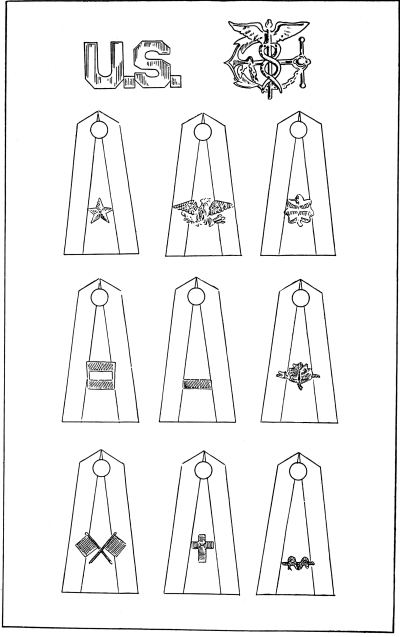
U. S. Public Health Service
| 1. Letters worn on collar |
|
2. Public Health Service insignia |
| Shoulder straps of dress and service coats |
| 3. Surgeon General |
4. Assistant Surgeon General |
5. Senior Surgeon and Surgeon |
| 6. Passed Assistant Surgeon |
7. Assistant Surgeon |
8. Professor, Hygienic Laboratory |
| 9. Quarantine Inspector |
10. Chaplain |
11. Interne |
[Pg 195]
The Overcoat for Officers is a single-breasted ulster of dark blue
cloth extending to within twelve inches of the ground, closed down the
front by a row of five large flat black buttons, with a standing and
falling collar, and having the stripes indicating the rank the same as
for the full dress coat except that they shall be of black mohair braid.
Insignia of Service and Rank.—The insignia of the Public Health
Service consist of a foul anchor crossed by a caduceus. The distinctive
device worn on the blue cap consists of a gold shield seven-eighths
of an inch in height, emblazoned palewise with thirteen pieces with a
chief strewn with thirteen stars, surmounted by a gold spread eagle
five-eighths of an inch in height and one and five-eighths from tip
to tip of wings, the whole being placed upon the service insignia in
gold, the staff of the caduceus and the anchor each being one and
seven-eighths inches long.
The insignia of rank for commissioned officers are as follows:
The Surgeon General.—One silver star of five rays, of such size
that the points of the rays will fill a circle one inch in diameter,
to be five-eighths of an inch from one point of the star to the next
alternate point. One ray of the star to point toward the collar.
Assistant Surgeon General.—A silver spread eagle, 2¼ inches wide
between the tips of wings; distance from tips of wings to center of
talon on each side, 1¼ inches; from top of head to bottom of design, 1¼
inches. The insignia for the right side has in the right talon an olive
branch and in the left a bundle of arrows. The extreme width from tip
of arrowhead to olive branch is 1⁹/₁₆ inches. These insignia are made
in pairs, rights and lefts, and the eagle faces to the front on each shoulder.
[Pg 196]
Senior Surgeon.—A seven-pointed silver oak leaf with stem; 1⅛ inches
long from the tip of the stem to the tip of the leaf; 1¹/₁₆ inches wide
at the widest point. The top of the leaf points toward the collar.
Surgeon.—A gold oak leaf of the same size and design, and worn in
the same manner as for senior surgeon.
Passed Assistant Surgeon.—Two gold bars, each bar 1⅛ inches long and
three-eighths inch wide; the bars being parallel, and three-eighths
of an inch apart. The bars are worn with the long axis in a line from
front to rear.
Assistant Surgeon.—One gold bar of the same size and worn in the
same manner as for passed assistant surgeon.
Professor, Hygienic Laboratory.—A gold oak leaf superimposed upon a
silver flaming torch one and one-half inches long.
Quarantine Inspector.—Two crossed flags embroidered in gold, one and
one-half inch staff and flags one inch hoist by five-eighths of an inch fly.
Acting Assistant Surgeon.—The same as for Assistant Surgeon except
that the rank insignia is silver instead of gold.
Chaplain.—A silver Latin cross one inch high.
The insignia of rank for Warrant Officers are as follows:
Interne.—A rod of Esculapius with a single serpent entwined about
it, in silver.
Pharmacist.—No rank insignia on shoulder straps. On the sleeves
of the dress and service coats five inches above the edge there is a
“cachet” indicating the rank. This consists of a circular piece of
maroon broadcloth one-half inch in diameter surrounded by a circle of
gold embroidery one-eighth of an inch wide. For the white service and
khaki uniforms the “cachet” is made of enameled metal. Pharmacists of
the third class wear one such mark, those of the second class two and
those of the first class three.
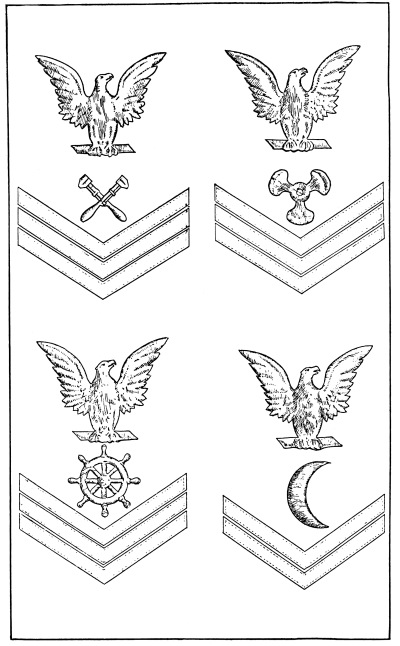
U. S. Public Health Service
Chevrons worn on the sleeves by petty officers
to indicate rank and duty
| 1. Station Engineer |
2. Marine Engineer |
| 3. Pilot |
4. First Cook |
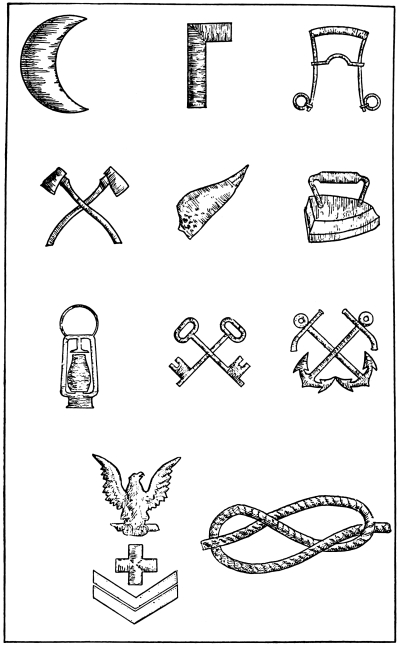
U. S. Public Health Service
Specialty marks worn on the sleeves by
petty officers and special detail men
to indicate rank or duty
1. Worn by Cooks
other than first cooks |
2. Carpenter |
3. Coachman |
| 4. Yardman |
5. Messenger |
6. Laundryman |
| 7. Night Watchman |
8. Shipkeeper |
9. Boatswain |
| 10. Surgical Nurse 11. Coxswain |
[Pg 197]
Clerk.—Two crossed pens one and a quarter inches in length,
embroidered in maroon silk on the dress and service coats and made of
enameled metal for the white and khaki coats.
Collar Ornaments.—The collar ornaments for the dress and service
coats are the letters “U. S.” in metal in Gothic design, five-eighths
of an inch high, and the service insignia in metal. For the dress and
olive-drab and khaki service uniforms these ornaments are of gun-metal
and for the white coat they are of gilt metal.
Buttons.—The buttons worn by officers of the Public Health Service
are of metal and bear the insignia of the service, a foul anchor
crossed by a caduceus, the anchor being horizontal and the staff of the
caduceus vertical.
Sword and Belts.—The sword for commissioned officers has a straight
blade, of diamond shape, 29 to 32 inches long, Hilt pommel, inverted
frustrum of a cone with corps device chased on one side and star on the
other. Grip, white sharkskin wrapped with gilt wire. Front guard bears
corps device; spring back guard, with trophy device. Black leather
scabbard with gilt bands, a five-pointed star on each; upper band to
have two rings. Tip to be 5 inches long, with laurel branch engraved
on the right side. The belt for full dress is one and three-quarters
inches wide, with two sling straps three-fourths of an inch wide,
covered with gold lace braid and closed by a gilt buckle clasp
[Pg 198]
consisting of a wreath of laurel leaves surrounding a design similar to
the service button.
The service uniform belt is the same as the full dress belt but it is
made entirely of black grain leather. The sword knot is a strap of
one-half inch gold lace twenty-four inches long.
Leggings.—Leggings for wear with olive-drab and khaki service
uniforms are of tan colored pigskin.
WARRANT OFFICERS’ UNIFORMS
The uniforms for Warrant Officers are of the same style and design as
those prescribed for commissioned officers, omitting the full dress
uniform and the sword.
EMPLOYEES’ AND ENLISTED MEN’S UNIFORMS
The employees at the hospitals and stations of the Public Health
Service are provided with blue and white uniforms.
The Blue Uniform consists of a double-breasted sack coat of dark
blue serge, with notched rolling collar; cut square at the bottom; length
one inch below the crotch; with five gun-metal service buttons on each
side down the front; trousers of the same material as the coat; black
leather shoes; and a blue cap similar to that worn by commissioned
officers but having the band of black mohair braid, the visor and chin
strap of plain black patent leather and the service insignia in gilt
metal on the center of the front.
The white Uniform is of the same pattern as the blue uniform but made
of white cotton drill.
The Overcoat is a double-breasted ulster of dark blue cloth, buttoned
to the collar by two rows of large size service buttons, with rolling collar.
[Pg 199]
The uniforms for ordinary seamen, firemen, coal passers, cooks and
boys at Quarantine stations is similar in cut and style to that worn
by enlisted men of the U. S. Navy, and is of blue cloth for winter
and white duck for summer wear. The cap ribbon bears the words “U. S.
QUARANTINE” embroidered in gilt thread.
The marks indicating the ratings and duties of the various employees
and enlisted men are worn on the sleeves midway between the elbow and
the shoulder and are embroidered in maroon colored silk. They are:
(1) Station Engineer.—Spread eagle, above two crossed monkey
wrenches, and a chevron of three stripes of maroon broadcloth.
(2) Pilot.—The same as for station engineer, substituting a steering
wheel for the crossed monkey wrenches.
(3) Marine Engineer.—The same as for pilot, substituting a propeller
for the steering wheel.
(4) First Cook.—The same as for pilot, substituting a crescent for
the steering wheel, and with a chevron of two stripes.
(5) Other Cooks.—The same as for first cook, omitting all marks
except the crescent.
(6) Coachman.—A curb bit.
(7) Carpenter.—A carpenter’s square.
(8) Yardman.—Two crossed axes.
(9) Messenger.—A single wing.
(10) Laundryman.—A flatiron.
(11) Surgical Nurse.—A spread eagle, Geneva cross,
chevron with two bars.
(12) Night Watchman.—A lantern.
(13) Ship Keeper.—Two crossed keys.
(14) Boatswain.—Two crossed anchors.
(15) Coxswain.—Figure-of-eight knot, 2 inches long.
[Pg 200]
UNIFORM FOR FEMALE NURSES
The female nurses at the hospitals wear a uniform consisting of a white
organdie nurse’s cap, a one-piece dress of white cotton cloth, having
a simple waist with plain three-quarter length sleeves with reversed
cuffs two and one-half inches wide, a flat rolling collar two inches
wide with a wide opening at the neck in front; a four-piece skirt from
two to two and one-half yards in circumference at the bottom, reaching
to within three inches of the floor; top turned in and stitched to the
waist with a double-welt seam. The waist and shirt are buttoned down
the front with one row of plain 35-ligne white pearl buttons. Upon the
left arm midway between the shoulder and the elbow there is a Geneva
cross of maroon colored broadcloth. The shoes and stockings are white.
Service Stripes.—All members of the personnel of the service
below the grade of Pharmacist wear a service stripe of maroon cloth
three-eighths of an inch wide diagonally across the sleeve below the
elbow for each period of five years service.
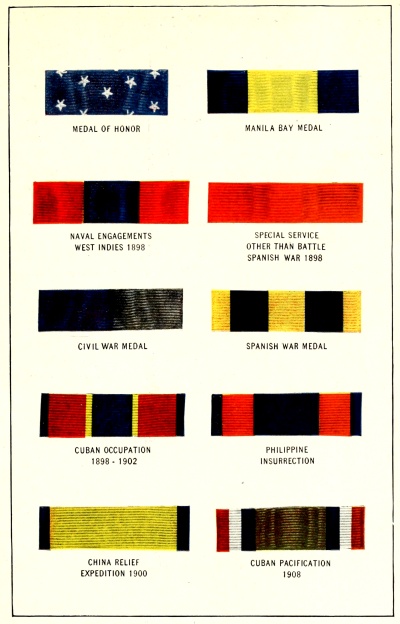
Bars of distinctive ribbons of United States Government medals.
Worn by officers and men upon whom the medals have been conferred with dress,
undress, service dress and evening dress uniforms.
[Pg 201]
CHAPTER X
MEDALS, BADGES AND RIBBONS
In all of the nations of the world it is customary to recognize special
acts of gallantry upon the field of battle, marked devotion to duty in
the service of the country and long and faithful service in the armies
and navies by promotion, by granting special honors or orders, or by
the conferring of medals and decorations.
In the military and naval service of the United States there are a
number of authorized medals and badges presented to the officers and
enlisted men in recognition of their gallant services and deeds in the
wars in which our country has been engaged.
In addition to the medals conferred for war service there are medals
for long and faithful service with the colors and special badges
awarded for excellency at target practice both on land and sea.
These medals and badges are proudly worn and highly prized by their
recipients and are often handed down to posterity as valued heirlooms.
Medals and badges are usually suspended from a small section of ribbon,
the colors of the ribbon being distinctive for each medal.
In accordance with the regulations and orders for the various services
medals are to be worn with special full dress and full dress uniforms
on the left breast in one horizontal line, suspended from a single
holding bar, each medal being attached to the bar by the distinctive
[Pg 202]
ribbon authorized for it, and the upper edge of the bar being on a
horizontal line one inch below the point of the shoulder, which should
bring it between the first and second buttons of the full dress coat
for officers.
There is a specified order for the arrangement of the medals upon the
holding bar, the medal of the oldest date being worn nearest the center
line of the coat and the others in order of precedence, according to
the date of the event for which conferred, toward the left shoulder of
the wearer.
With undress and service uniforms in lieu of the medals and badges
sections of the ribbons from which they are suspended are worn. These
ribbons of medals and badges are each equal in length to the full width
of the ribbon and three-eighths of an inch wide. Ribbons of medals and
badges are worn on the left breast of the coat in the same relative
position as the medals and badges which they represent. In case the
wearer has received so many that there is not room on the coat to wear
them in one row, they are arranged in two rows.
The medals and badges, or the ribbons worn in their stead with undress
and service uniforms, show the special military honors which have been
conferred upon the wearer and the wars and campaigns in which he has
seen active service, and a knowledge of the designs of these bits of
metal and of the bright colored strips of silk will often give a fair
idea of the services and honors of the man who wears them.
The founders of the United States of America looked askance upon
anything that savored of monarchical government and as a result we find
that the Constitution provides that,
“No title of nobility shall be granted by the
United States; and no person holding any office of profit or trust
under them shall, without the consent of Congress, accept of any
present, emolument, office or title of any kind whatever, from any
king, prince or foreign state.”

Bars of distinctive ribbons of United States Government medals.
Worn by officers and men upon whom the medals have been conferred with dress,
undress, service dress and evening dress uniforms.
[Pg 203]
Following out this early mandate the regulations of the present day
forbid the wearing by the officers and enlisted men of the services
of the United States of any medal or decoration granted by any foreign
state or ruler, although the Congress has in a number of instances
authorized officers and enlisted men to receive such decorations.
In the early days of the republic Congress on several occasions passed
resolutions of thanks to commanders on land and sea whose forces had
won notable victories, and these resolutions generally provided for the
striking of a medal to commemorate the victory and for a sword of honor
to be presented by the government to the victorious commander, but
these medals were not intended to be worn with the uniform.
It was not until 1861 that Congress authorized the first medal to
be worn as a special badge of honor by soldiers who had especially
distinguished themselves in the military service of the country. This
decoration was officially styled the “Medal of Honor.”
This was followed in later years by the enactment of laws prescribing
other decorations and medals and the promulgation of regulations and
orders as to the manner in which they should be worn.
The following medals and badges are authorized by Act of Congress or by
executive order and in accordance with the regulations of the military
and naval services are worn by the officers and enlisted men upon whom
they have been conferred.
[Pg 204]
- 1. Medal of Honor, U. S. Army.
- 2. Medal of Honor, U. S. Navy, U. S. Marine Corps, and U. S. Coast Guard.
- 3. Medal commemorating the Battle of Manila Bay, May 1, 1898.
- 4. Medal commemorating the Naval Engagements in the West Indies during the War with Spain, 1898.
- 5. Special Meritorious Medal for Services during the War with Spain, other than in Battle.
- 6. Certificate of Merit Medal.
- 7. Civil War Campaign Medal.
- 8. Indian Campaign Medal.
- 9. Spanish War Campaign Medal.
- 10. Congressional Medal for Philippine Service.
- 11. Philippine Insurrection Campaign Medal.
- 12. Army of Cuban Occupation Medal, 1898-1902.
- 13. China Relief Expedition Medal.
- 14. Gold Life-Saving Medal.
- 15. Silver Life-Saving Medal.
- 16. Cuban Pacification Medal.
- 17. Nicaraguan Campaign Medal.
- 18. Haitian Campaign Medal, 1915.
- 19. Good-Conduct Medal, U. S. Navy.
- 20. Good-Conduct Medal, U. S. Marine Corps.
- 21. Medals and Badges for Excellence in Gunnery.
- 22. Medals and Badges for Excellence in small-arms target firing as follows:
- (a) Expert Rifleman’s Badge, Army and Marine Corps.
- (b) Sharpshooter’s Medal, Navy and Marine Corps.
- (c) Expert Rifleman’s Bar Badge, Navy.
- (d) Pistol Expert Badge, Army and Marine Corps.
- (e) Expert Pistol-shot’s Bar Badge, Navy.
- (f) Distinguished Marksman’s Medal, Marine Corps.
- (g) Sharpshooter’s Badge, Army and Marine Corps.
- (h) Marksman’s Badge, Army and Marine Corps.
- (i) Division Competition Medal.
- (j) Medals given by the National Rifle Association in matches held under its cognizance.
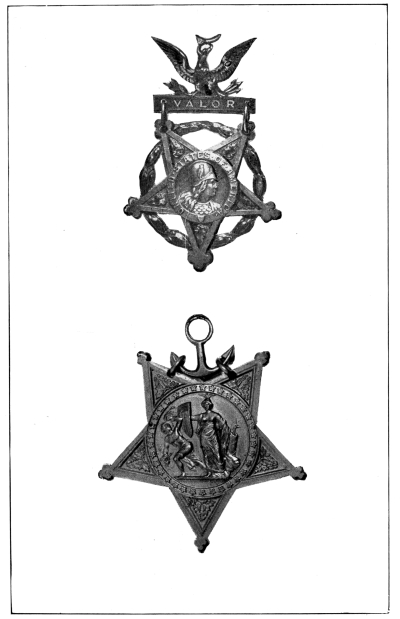
The Medal of Honor, U. S. Army
The Medal of Honor, U. S. Navy
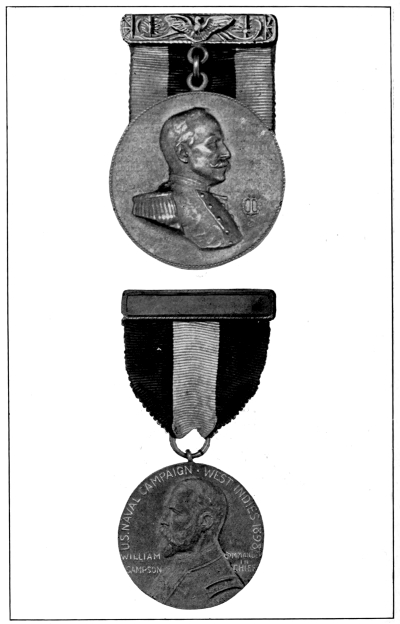
Medal Commemorating the Battle of Manila Bay,
May 1, 1898
Medal Commemorating the Naval Engagements in
the West Indies
during the War with Spain,
1898
[Pg 205]
The designs of the various medals and badges and the colors of their
distinctive ribbons are shown in the accompanying illustrations.
Laws have been passed authorizing the wearing of the badges of certain
societies composed of men who have served in the War of the Revolution,
the War of 1812, the Mexican War, the Civil War, the War with Spain,
the Philippine Insurrection and the China Relief Expedition, but the
regulations prohibit the wearing of these badges while in uniform when
medals and badges presented by the government are worn.
The Medal of Honor, U. S. Army.—The Medal of Honor for the Army
was first authorized by Act of Congress in 1861 and is awarded to
officers and enlisted men of the Army in the name of Congress for
particular deeds of most distinguished gallantry in action. In order
that an officer or enlisted man may receive a medal of honor he must
have performed in action a deed of most distinguished personal bravery
or self-sacrifice, above and beyond the call of duty, so conspicuous
as to clearly distinguish him for gallantry or intrepidity above his
comrades in arms, involving risk of life or the performance of more
than ordinarily hazardous service. This medal is of bronze with the
wreath in green enamel.
The Medal of Honor, U. S. Navy and Marine Corps. The Medal of Honor
for the Navy, including the Marine Corps, was authorized by Act of
Congress in 1862, which provided that enlisted men of the Naval Service
distinguishing themselves in battle, or by extraordinary heroism in the
[Pg 206]
line of their profession, may be promoted to forward warrant
officers, upon the recommendation of their commanding officer, approved
by the Flag Officer and the Secretary of the Navy; and that upon such
recommendation they shall receive a Medal of Honor and a gratuity of
one hundred dollars. This law provided the medal of honor and its
accompanying gratuity for enlisted men only, but the Act of Congress
of March 3, 1915, extended it to officers by the following proviso:
“The President of the United States is hereby empowered to prepare
a suitable Medal of Honor to be awarded to any officer of the Navy,
Marine Corps, or Coast Guard who shall distinguish himself in battle or
display extraordinary heroism in the line of his profession.” The Navy
Medal of Honor and the anchor from which it is suspended are of bronze.
Medals of Honor for both the Army and the Navy, being the highest
decorations awarded by the United States government, are worn suspended
from the neck by a ribbon of light blue studded with white stars so
that the medal will be at the center of the neck opening of the coat.
The Medal Commemorating the Battle of Manila Bay.—This medal,
popularly known as the “Dewey Medal,” was the next one authorized by
Congress after the Medal of Honor, and was struck in accordance with a
joint resolution of the Senate and House of Representatives approved by
the President on June 3, 1898, reading as follows:
“Resolved by the Senate and House of
Representatives of the United States of America in Congress assembled,
That the Secretary of the Navy be, and he hereby is, authorized to
present a sword of honor to Commodore George Dewey, and to cause to
be struck bronze medals commemorating the battle of Manilla Bay, and
to distribute such medals to the officers and men of the ships of the
Asiatic Squadron of the United States under command of Commodore George
Dewey on May first, eighteen hundred and ninety-eight.”
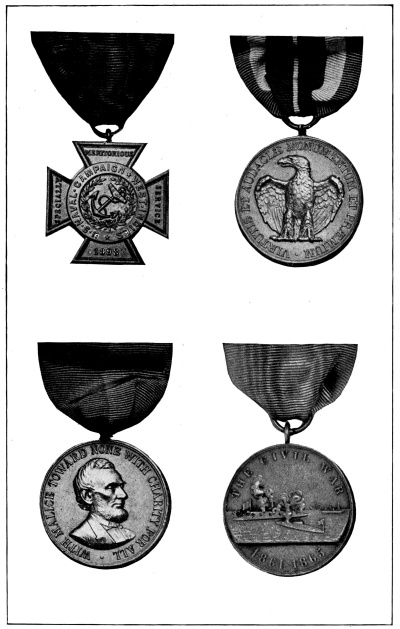
1. Medal for Meritorious Service
other than in battle,
U. S. Navy, 1898 |
2. Certificate of Merit Medal |
| 3. Civil War Medal, U. S. Army |
4. Civil War Medal, U. S. Navy |
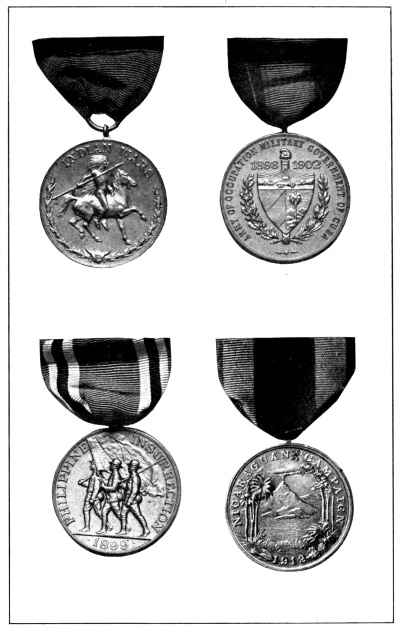
| 1. Indian Wars Campaign Medal |
2. Cuban Occupation Medal |
3. Congressional Medal for
Philippine Service, U. S. Army |
4. Nicaraguan Campaign Medal,
1912 |
[Pg 207]
The front or “obverse” of this medal bears the bust of Admiral Dewey in
low bas-relief and the legend, “The gift of the People of the United
States to the Officers and Men of the Asiatic Squadron under command of
Commodore George Dewey,” while the back, or “reverse,” bears the figure
of a sailor and a great gun with the inscription, “In Memory of the
Victory of Manila Bay, May 1, 1898,” and the name of the ship in which
the recipient served during the battle. The medal is suspended from a
bronze bar by three links of chain and is backed by its distinctive
ribbon, blue, yellow, blue.
The Medal Commemorating the Naval Engagements in the West Indies
during the War with Spain.—This medal, usually known to the service
as the “Sampson Medal,” was struck in accordance with a joint
resolution of Congress approved by the President on March 3, 1901,
reading as follows:
“Resolved by the Senate and House of
Representatives of the United States of America in Congress assembled,
That the Secretary of the Navy be, and he is hereby, authorized
to cause to be struck medals commemorative of the naval and other
engagements in the waters of the West Indies and on the shores of
Cuba during the War with Spain, and to distribute the same to the
officers and men of the Navy and Marine Corps who participated in any
of said engagements deemed by him of sufficient importance to desire
commemoration; Provided, That officers and men of the Navy or Marine
Corps who rendered specially meritorious service, otherwise than in
battle, may be rewarded in a like manner.”
[Pg 208]
The medal commemorating the Naval engagements in the West Indies is
of bronze, the obverse bears the bust of Rear Admiral Sampson in low
bas-relief and the inscription “U. S. Naval Campaign West Indies
1898. William T. Sampson Commander in Chief,” and the reverse bears a
representation of a gun’s crew in bas-relief; the medal is suspended by
its distinctive ribbon, red, blue, red, from a bronze bar bearing the
name of the engagement in which the recipient participated. In case the
recipient took part in more than one engagement an additional bar is
added for each engagement.
Special Meritorious Medal for Services in the War with Spain Other
than in Battle.—This medal was struck in accordance with the joint
resolution of Congress of March 3, 1901, quoted above, the portion of
that resolution authorizing it being as follows:
“Provided, That officers and men of the Navy or
Marine Corps who rendered specially meritorious service, otherwise than
in battle, may be rewarded in like manner.”
This medal is of bronze in the form of a maltese cross with a medallion
centerpiece. The centerpiece bears a foul anchor surrounded by a laurel
wreath and the inscription “U. S. Naval Campaign West Indies,” and the
arms of the cross bear the words “Specially Meritorious Service 1898,”
on the obverse side. On the reverse side is engraved the name of the
recipient and the act for which the medal was awarded.
The Certificate of Merit Medal.—This medal is conferred upon
enlisted men of the Army by executive order of the President in cases
where the recipient thereof has distinguished himself in the service of
the country and has been recommended therefor by the commander of his
regiment or the chief of the corps to which he belongs. It is of bronze
with a Roman eagle surrounded by the inscription “Virtutis et audaciae
monumentum et praemium” on the obverse side and on the reverse a
wreath with the words “United States Army” surrounding it and the
words “For Merit” enclosed in it. The ribbon has a narrow white stripe
through the center with red, white and blue stripes on each side.

U. S. Army Campaign Medals
| 1. War with Spain, 1898 |
2. China Relief Expedition |
| 3. Philippine Insurrection |
4. Cuban Pacification, 1906-1909 |

Copyright, Bailey, Banks & Biddle Co., Phila., Pa.
| 1. The Distinguished Service Cross, 1918. United States Army |
| 2. Mexican Service Campaign Medal, United States Army |
| 3. Mexican Service Campaign Medal, United States Navy |
[Pg 209]
The Distinguished Service Cross.—This decoration, authorized by the
President January 12, 1918, is awarded by him or in his name by the
commanding general of the American Expeditionary Forces to any person
serving with the Army for extraordinary heroism in connection with
military operations against an armed enemy after April 6, 1917, under
circumstances not justifying the award of the medal of honor. It is a
bronze cross surcharged with an eagle with a scroll below the eagle
bearing the words “For Valor.” The ribbon is blue with narrow stripes
of white and red at the edges.
The Distinguished Service Medal.—This bronze medal, authorized by
the President January 12, 1918, is awarded by him to any person serving
with the Army for exceptionally meritorious service in duty of great
responsibility or in military operations against an armed enemy. Its
obverse bears the coat of arms of the United States surrounded by the
words “For Distinguished Service.” The ribbon has a wide central stripe
of white with a narrow stripe of blue on each side of it and a red
stripe at each edge.
The distinguished service cross medal may be awarded posthumously to
persons killed in the performance of acts that merit the award or who
die prior to such award, the cross or medal being given to the nearest
relative of the deceased person.
[Pg 210]
A person who holds a distinguished service cross or distinguished
service modal is entitled to wear upon the ribbon for each additional
citation in War Department orders a bronze oak leaf and for citation
for gallantry by a general officer’s headquarters a silver star.
Congressional Medal for Philippine Service.—This bronze medal,
authorized by Act of Congress in 1899, was conferred upon officers
and men of the Army distinguishing themselves in action during the
Philippine Insurrection. On the obverse is a group of three soldiers
facing to the left, the central one bearing the colors and the other
two with rifles at the “shoulder,” surrounded by the inscription
“Philippine Insurrection, 1899.” On the reverse are the words “For
Patriotism, Fortitude and Loyalty” enclosed in a circle composed of
a branch of pine on the left and a branch of palm on the right. The
ribbon is blue with narrow bands of white, red, white near each edge.
Gold Life-Saving Medal.—This medal, established by Act of Congress,
June 20, 1874, is awarded to “those who by extreme and heroic daring
have endangered their lives in saving or endeavoring to save lives
from the perils of the sea.” The obverse has a design of a boat’s crew
rescuing a man from a stormy sea, surrounded by the inscription “United
States of America. Act of Congress, June 20, 1874.” The reverse bears a
scroll surmounted by an eagle and supported at the left by the figure
of Victory and at the right by an anchor and a ship’s sails, surrounded
by the inscription, “In testimony of heroic deeds in saving life from
the perils of the sea.” The medal is suspended from a clasp of gold
representing the head of an eagle and the clasp is suspended by a
scarlet silk ribbon.
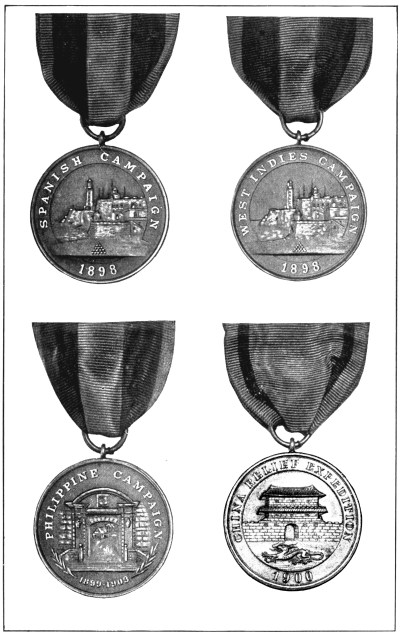
Campaign Medals.
U. S. Navy and Marine Corps
| 1. War with Spain, 1898 |
2. West Indies Campaign, 1898 |
| 3. Philippine Insurrection |
4. China Relief Expedition, 1900 |

| 1. Gold Life-Saving Medal (obverse) |
| 2. Gold Life-Saving Medal (reverse) |
| 3. Silver Life-Saving Medal (obverse) |
| 4. Silver Life-Saving Medal (reverse) |
[Pg 211]
Silver Life-Saving Medal.—This medal, established by Act of
Congress, June 20, 1874, is awarded to “those who have endangered their
lives in saving lives from the perils of the sea or in succoring the
shipwrecked.” The obverse bears an allegorical design of a rescue from
the sea, surrounded by the inscription “United States of America. Act
of Congress, June 20, 1874.” The reverse has a wreath surrounded by the
words, “In testimony of heroic deeds in saving life from the perils of
the sea.” The medal is suspended from a silver clasp representing the
head of an eagle, the clasp being suspended by a light blue silk ribbon.
Civil War Campaign Medal.—This is the first of the campaign medals
or badges. It is of bronze and was awarded to all officers and men who
participated with honor in the Civil War. The Army medal has on its
obverse side the head of Lincoln, nearly in profile, facing to the
right, surrounded by the inscription, “With malice toward none, with
charity for all,” and on the reverse a wreath of oak and olive branches
enclosing the words “The Civil War” and dates “1861-1865.” The Navy
medal bears on its obverse a scene from the battle of the Monitor and
the Merrimac and the inscription, “The Civil War, 1861-1865,” and
on the reverse an eagle perched on a foul anchor with the words “For
Service” below, the whole surrounded by a circle composed of a branch
of oak and a branch of olive leaves in the lower half and in the upper
half the words “United States Navy” or “United States Marine Corps,”
according to the service of the wearer. The ribbon is blue and gray.
The reverse side of all Navy campaign medals is the same as for the
Civil War medal; all Army campaign medals, with the exception of the
Civil War medal, have on the reverse a trophy composed of an eagle
[Pg 212]
perched on a cannon supported by five standards, rifles, an Indian
shield, spear and quiver of arrows, a Cuban machete and a Sulu kriss,
with the words “For Service” below, the whole surrounded by a circle of
the words “United States Army” in the upper half and thirteen stars in
the lower half.
Indian Campaign Medal.—This bronze medal was given to all officers
and men of the U. S. Army who participated with honor in the campaigns
against hostile Indians. Its obverse bears a mounted Indian, facing to
the right, with a spear in his right hand and wearing a war bonnet, all
surrounded by a circle composed of the words “Indian Wars” above and a
buffalo skull below with arrowheads completing the circle. The ribbon
is red with a narrow black band near each end.
Spanish War Campaign Medal.—This bronze medal was conferred upon
officers and men of the Army, Navy and Marine Corps who saw active and
honorable service in the War with Spain in 1898. The obverse of the
Army medal bears a conventional castle with two round corner towers
surrounded by a circle of the words “War with Spain” above and the
date 1898 below with a branch of tobacco plant to the left and stalk
of sugar cane to the right. The obverse of the Navy medal bears the
Morro Castle at Havana surrounded by the inscription “Spanish Campaign,
1898.” A medal of the same design but with the inscription “West
Indies Campaign, 1898,” was presented to officers and men of the Navy
and Marine Corps who participated in the naval operations in the West
Indies in 1898. The ribbon is blue, yellow, blue, with narrow yellow edges.
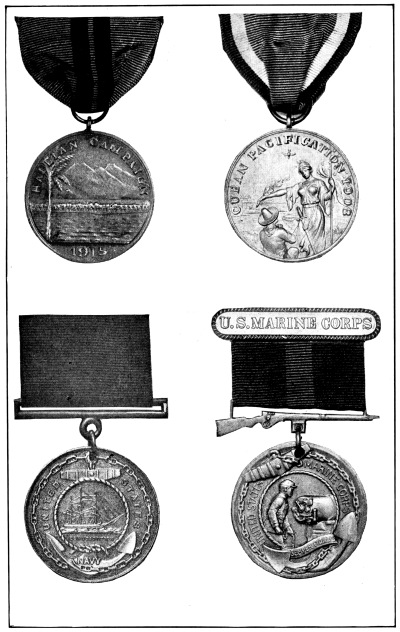
| 1. Haitian Campaign Medal, 1915 |
2. Cuban Pacification Medal,
U. S. Navy and Marine Corps |
| 3. Good-Conduct Medal, U. S. Navy |
| 4. Good-Conduct Medal, U. S. Marine Corps |
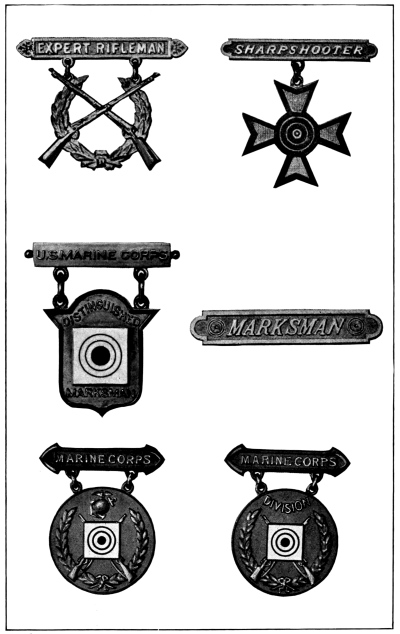
Medals and Badges for excellence in small arms firing
[Pg 213]
Philippine Insurrection Campaign Medal.—This bronze medal was given
to officers and men of the Army, Navy and Marine Corps who saw active
service in the Philippine Insurrection, 1899 to 1903. The obverse of
the Army medal bears a cocoa palm tree with a Roman lamp on the left
and balanced scales on the right, surrounded by the words “Philippine
Insurrection, 1899”; that of the Navy medal has the Santiago gate at
Manila surrounded by “Philippine Campaign, 1899-1903,” and two palm
branches. The ribbon is crimson, blue, crimson, with narrow blue edges.
Army of Cuban Occupation Medal.—This bronze medal was given to the
officers and men of the U. S. Army which occupied Cuba during the
U. S. Military Government from 1898 until the establishment of the
Cuban Republic in 1902. On the obverse is the coat of arms of the
Cuban Republic surrounded by the words “Army of Occupation Military
Government of Cuba,” with the dates 1898-1902 above the shield. The
ribbon is red, blue, red, with narrow blue edges, the central blue
stripe having narrow yellow edges.
China Relief Expedition Medal.—This bronze medal was given to
officers and men of the U. S. Army, Navy and Marine Corps who took part
in the defense of the legations at Peking, China, and their relief
in 1900. The obverse of the Army medal bears the Imperial Chinese
five-toed dragon surrounded by the words “China Relief Expedition,
1900-1901”; and that of the Navy medal bears the Chienmen, the main
gate of Peking, with a dragon below, all surrounded by the words “China
Relief Expedition, 1900.” The ribbon is yellow with blue edges.
Cuban Pacification Medal.—This bronze medal was given to officers
and men of the Army, Navy and Marine Corps who took part in the “second
intervention in Cuba,” 1906-1909. The obverse of the Army medal bears
[Pg 214]
the coat of arms of the Cuban Republic with the words “Cuban
Pacification” above and the dates 1906-1909 below it. The obverse of
the Navy medal bears an allegorical design representing “Columbia”
tendering the olive branch of peace to “Cuba.” The ribbon is olive-drab
edged with narrow stripes of red, white and blue.
Nicaraguan Campaign Medal.—This bronze medal was given to officers
and men of the Navy and Marine Corps in the expedition which
established stable government in Nicaragua in 1912. The obverse shows
Mount Momotombo, surrounded by the inscription “Nicaraguan Campaign,
1912.” The ribbon is blue, crimson, blue, with narrow crimson edges.
Mexican Service Campaign Medal.—This bronze medal was given to
officers and men of the military and naval services who participated
in the operations in Mexico, the Vera Cruz expedition of 1914, the
punitive expeditions of 1916-17, or who were between 1911 and 1917
present at engagements where there were casualties to U. S. troops. The
obverse of the Army medal bears the Mexican yucca plant in flower with
mountains in the background, surrounded by the inscription “Mexican
Service, 1911-1917.” The obverse of the Navy medal bears the castle of
San Juan de Ulloa at Vera Cruz, surrounded by the inscription “Mexican
Service, 1914.” The ribbon is yellow, blue, yellow, with narrow green edges.
Haitian Campaign Medal.—This bronze medal was given to officers
and men of the Navy and Marine Corps who took part in the operations
in Haiti between July 9 and December 6, 1915. The obverse shows Cape
Haitien with the sea in the foreground and mountains in the background
with a palm tree at the left; above the design encircling it are the
[Pg 215]
words “Haitian Campaign” while below the design is the date, 1915. The
distinctive ribbon is blue with two narrow red stripes through the center.
The Good-Conduct Medal, U. S. Navy.—This medal is bestowed upon
enlisted men of the Navy who have served a complete enlistment of
four years with such constant and especially meritorious attention to
duty and efficiency as to win the recommendations of their commanding
officers for “Good-Conduct.” It is of bronze, its obverse side showing
an anchor surmounted by a central medallion bearing a representation of
the U. S. S. Constitution and surrounded by an anchor chain and the
words “United States Navy.” It is suspended by a ribbon of crimson.
The Good-Conduct Medal, U. S. Marine Corps.—This medal is bestowed
upon enlisted men of that service under similar conditions to those
prescribed for the Navy. It is of bronze and its obverse side bears
an anchor surmounted by a central medallion showing a marine at the
breech of a rapid-fire gun and surrounded by an anchor chain and the
words “United States Marine Corps,” with the motto of the Marine Corps,
“Semper Fidelis,” on a scroll between the flukes of the anchor. It is
suspended by a miniature rifle from a bar by the distinctive ribbon of
red, blue, red; the bar bearing the inscription “U. S. Marine Corps.”
Wound Chevrons.—A gold chevron, each arm one-half inch wide and two
inches long, worn on the right sleeve below the elbow, is given to each
officer and enlisted man who is wounded in action or disabled by gas.
War Service Chevrons.—A similar chevron, to be worn on the left
sleeve below the elbow, is given for each six months of active service
in the zone of the advance in the present war.
[Pg 216]
CHAPTER XI
UNIFORMS AND INSIGNIA OF
FOREIGN ARMIES AND NAVIES
The uniforms and insignia of the armies and navies of foreign powers
present such a great variety in design, style and color as to preclude
the possibility of giving a detailed description of them within the
limits of this book.
However, in order that the rank of the officers and enlisted men of
these foreign services may be readily recognizable under the conditions
that ordinarily prevail on active service ashore or afloat, there is
included in this chapter a short description of the service uniforms
and insignia worn by the officers and enlisted men of the armies and
navies of Great Britain, France, Italy, Belgium, Japan, Russia, Germany
and Austria-Hungary.
It will be noted that the uniforms of the navies of the world bear more
similarity to each other than do those of the armies, thus the rank of
naval officers of all the great powers is indicated by stripes of braid
worn on the sleeves between the elbow and the lower edge of the cuff,
and in most cases by similar stripes or other insignia worn upon straps
placed on the shoulders between the base of the collar and the sleeve
at the shoulder seam.
In the different armies there is much more diversity in design and
color as well as in the method of indicating rank and corps; stripes
[Pg 217]
and various designs upon the cuffs, insignia and stripes upon shoulder
straps and insignia of many different designs upon the collar being the
most common means.
In one respect all of the naval and military services of the world
follow the same custom, medals and decorations awarded for especial
deeds of gallantry, for long and faithful service or to commemorate
some special event in war or peace are worn upon the left breast with
dress uniforms, almost always suspended from a ribbon of distinctive
color design, while a small section of this distinctive ribbon is
worn with undress uniform and service uniforms. As a special mark of
distinction the medals considered the highest in rank are frequently worn
on the right breast or suspended from a ribbon or chain around the neck.
A marked tendency toward simplification in design both of uniform and
insignia and toward the use of neutral or dull colors is also evident
in recent years. This is largely due to the necessity of making the
soldier as inconspicuous as possible when on the firing line, but also
to the great expense incurred in fitting out very large forces of men
in elaborate dress uniforms for which there is no use in the field.
Nevertheless it may be expected that when the world returns to a basis
of general peace time conditions the dress uniforms and bright insignia
and buttons that add so much to the brilliancy of military gatherings
will again be in evidence; especially since there is so much of the
tradition of the past associated with these uniforms and badges of rank
and corps.
Attractive uniforms induce a corresponding pride in the smartness
and neatness of the soldier or sailor and the distinctive badges of
regiments and corps with long histories of creditable achievement go
[Pg 218]
far to establish the esprit de corps which so surely makes for
efficiency and contentment.
UNIFORMS OF THE BRITISH NAVY
In Great Britain the Navy is known as “The Senior Service” as it was
organized as a regular service prior to the organization of a regular
national Army.
In general the uniforms of the British Navy correspond quite closely to
those of the United State Navy in composition and design and are worn
upon similar occasions, although they are somewhat more elaborate, but
the insignia are of different design.
Commissioned officers must provide themselves with full dress, ball
dress, frock coat dress, blue mess dress, white mess dress, blue
undress and white undress.
The full dress is very nearly the same in style and design to the
special full dress of the United States naval officer, the ball dress
is practically the same as the evening dress of the United States naval
officer and the frock coat dress and blue and white mess dress the same
as the corresponding United States naval uniforms. The blue undress
uniform of the British naval officer differs from the service dress
of the United States naval officer in that the coat worn with it is a
square cut, double-breasted sack coat with turn-down collar and rolling
lapels with two rows of four buttons each down the front. The white
undress of the British officer is the same as the white service dress
of the American officer.
The rank of British naval officers is shown by insignia of rank on the
tops of the epaulets with uniforms with which epaulets are worn, but
with all of the blue uniforms the rank is also indicated by stripes
of gold lace braid around the sleeves of the coat above the cuff.
The number and arrangements of these rank stripes are shown in the
accompanying illustration.
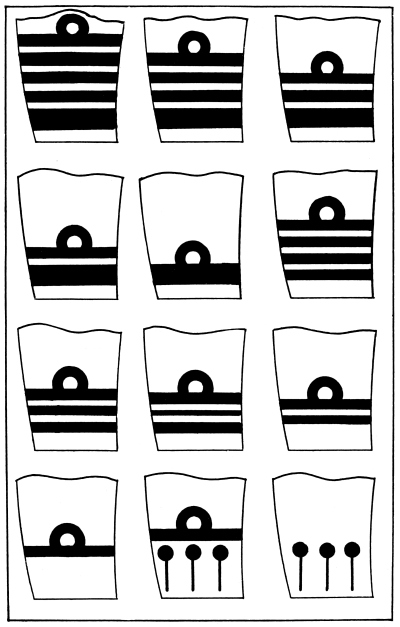
British Navy.
Officers’ sleeve decorations indicating rank
| 1. Admiral of the Fleet |
2. Admiral |
3. Vice Admiral |
| 4. Rear Admiral |
5. Commodore |
6. Captain |
| 7. Commander |
8. Lieutenant Commander |
9. Lieutenant |
| 10. Sub Lieutenant |
11. Chief Gunner and
Chief Boatswain |
12. Midshipman |
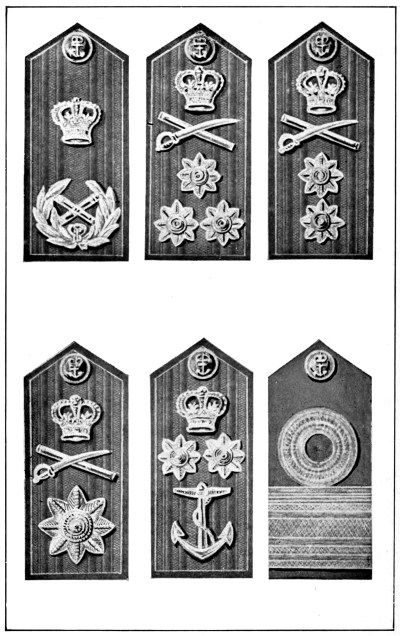
British Navy.
Officers’ shoulder straps
| 1. Admiral of the Fleet |
2. Admiral |
3. Vice Admiral |
| 4. Rear Admiral |
5. Commodore,
1st Class |
6. Commodore,
2nd Class |
[Pg 219]
With the white mess dress and the white undress the rank is indicated
by the stripes of gold braid or by other insignia of rank worn upon the
shoulder straps. These shoulder straps are also worn with the great
coat. There are no sleeve stripes on the white coats or the great coat.
The insignia of rank used on the shoulder straps of Flag Officers
and the stripes indicating rank used on the shoulder straps of
officers below the rank of Flag Officer are shown in the accompanying
illustrations.
The Corps or Branch of the service to which an officer belongs is shown
as follows on the sleeves and shoulder straps:—
| Officers of the Line |
By the circle or “curl” on the upper
stripe of gold lace braid. |
| Engineer Officers |
By the circle or “curl” as above with the addition of
stripes of purple cloth between the gold stripes. |
| Medical Officers |
The circle or “curl” is omitted and there are stripes
of scarlet cloth between the gold stripes. |
| Accountant or Pay Officers |
The circle or “curl” is omitted and there are stripes
of white cloth between the gold stripes. |
| Naval Instructors |
The circle or “curl” is omitted and there are stripes
of light blue cloth between the gold stripes. |
It will thus be seen that the system of stripes on the sleeves and
shoulder straps to indicate rank is practically the same in the British
and United States navies, the “curl” in the British navy being used for
[Pg 220]
the same purpose as the gold star in the United States navy, that is,
to show that the officer wearing it belongs to the Line, or the command
branch of the service.
The officers’ overcoat or “great coat” in the British navy is a double
breasted coat of ulster style reaching to just below the knees. It has
a rolling collar with notched lapels and is closed by two rows of gilt
service buttons down the front and has shoulder straps to indicate
the rank of the wearer but no stripes on the sleeves. In the back the
fulness is held in by a strap secured by two gilt buttons.
The service buttons of the British navy bear a raised design of a
vertical foul anchor surmounted by a royal crown, the edge being
surrounded by a raised rope design.
The caps and cocked hats of the British Navy are similar to those worn
by United States naval officers except that there is more bell to
the crown of the British cap. The cap insignia worn by commissioned
officers are embroidered on the front of the cap and consist of a
vertical foul anchor surrounded by a gilt wreath and surmounted by a
royal crown in gilt and scarlet; the anchor being silver in the case of
officers of the Line and gilt for officers of the Staff Corps.
The sword worn by British naval officers is much the same in general
appearance as that worn by American officers, the differences being
in the carved designs upon the hilt and blade of the sword and upon
the bands of the scabbard. This is due to the fact that the American
sword like the other parts of the American naval uniform was originally
adopted from the British Navy.
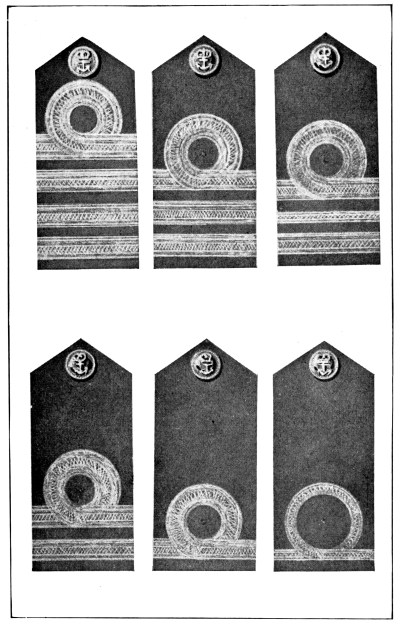
British Navy.
Officers’ shoulder straps
| 1. Captain |
2. Commander |
3. Lieutenant Commander |
| 4. Lieutenant |
5. Sub Lieutenant,
Chief Gunner and
Chief Boatswain |
6. Gunner and Boatswain |
[Pg 221]
The officers of the British Naval Air Service wear as a distinguishing
mark of their service a gilt spread eagle on each sleeve above the rank
stripes and a silver spread eagle in the center of the cap insignia in
place of the anchor worn there by other officers. Their service buttons
also have the spread eagle in place of the anchor for other officers.
Officers of the Royal Naval Division detailed for duty on shore wear a
uniform of khaki-colored cloth similar in design to the service uniform
of British Army officers; their sleeves bearing the rank stripes of the
same widths, number and arrangement as for other naval officers but
made of braid of a slightly different shade than the material of the
coat, and their shoulder straps bearing the same insignia of rank as
that worn by the corresponding grades in the army.
Officers of the British Royal Naval Reserve wear the same uniforms
as those prescribed for officers of the regular service, except that
the stripes on the cuffs and on the shoulder straps while of the same
number for the different grades are of a different design. The design
of these stripes represents a rope twisted of two strands and in place
of the “curl” above the upper stripe to indicate officers of the line
there is a star shaped design made up of two interlocked triangles of
narrow gold braid. The corps or branch of Staff officers of the Royal
Naval Reserve is indicated by stripes of cloth between the twisted
strand stripes, the distinctive colors for the different corps or
branches being the same for Staff officers of the regular navy.
Officers of the British Naval Volunteer Reserve wear the same
uniforms as those prescribed for the officers of the regular naval
establishment, except that the stripes on the sleeves and shoulder
straps to indicate rank, while being of the same number and arrangement
[Pg 222]
for the different grades, are laid on in waving lines instead of in
straight lines as in the case of the regular officers. The distinctive
color stripes to indicate the various corps or branches for Staff
Officers of the Royal Naval Volunteer Reserve are the same as for the
regular service.
Officers of the Royal Naval Reserve and of the Royal Naval Volunteer
Reserve attached to the Royal Naval Air Service wear their respective
uniforms with the addition of the spread eagle design above the rank
stripes on the sleeves and shoulder straps.
Officers of the British Colonial Naval Establishments maintained by the
greater colonial divisions of the British Empire wear distinctive marks
to indicate their especial service. These naval establishments comprise
the Royal Indian Marine, the Australian Navy and the Canadian.
The enlisted men of the British Navy wear uniforms very similar in
general design to those worn in the United States Navy with minor
differences in the dimensions and cut of the various garments. The
Chief Petty Officers wear uniforms of blue or white consisting of a
bell-crowned cap with a black mohair band, a black patent leather
visor and insignia consisting of two concentric circles surrounding a
vertical foul anchor surmounted by a British crown; a double-breasted
sack coat with two rows of gilt service buttons; and plain trousers.
Other petty officers and seamen wear the sailor cap, wide collared
shirt and bell-mouthed trousers common to the American service, the
collar having three rows of narrow white braid around the edges with
a black neckerchief knotted beneath it. The three rows of braid
commemorate Nelson’s three great victories—Copenhagen, the Nile and
Trafalgar—and the black neckerchief was first worn as a badge of
[Pg 223]
mourning for this great sea fighter. The cap has a black silk ribbon
around the band upon which is the name of the ship in gilt block
letters, thus,
H. M. S. DREADNOUGHT
the letters H.M.S. being the abbreviation of “His Majesty’s Ship.”
Rating badges to indicate the rank or rating of petty officers and men
on special duties are worn on the sleeves between the shoulder seam and
the elbow and are very numerous and complex, some of the principal ones
being, in red,
| Petty officer first class |
Two crossed foul anchors with
a crown above and three chevrons, points down, below. |
| Petty officer second class |
One vertical foul anchor with a crown
above and two chevrons, points down. |
| Petty officer third class |
The same, omitting the crown and with but one chevron. |
| Gunner’s Mate and Gunlayer first class |
Two crossed cannon with one star below
and a star and a crown above. |
| Gunner’s Mate |
The same, omitting the lower star. |
| Gunlayer first class |
Two crossed cannon with a star above and a star below. |
| Gunlayer second class |
The same omitting the lower star. |
| Gunlayer third class |
The same omitting the stars. |
| Seaman Gunner |
A horizontal cannon with a star above. |
| Torpedo Gunner’s Mate Higher Grade |
Two crossed torpedoes with a star and
a crown above and a star below. |
| Torpedo Gunner’s Mate
[Pg 224] |
The same omitting the lower star. |
| Torpedo Coxswain |
Two crossed torpedoes with a steering wheel above. |
| Leading Torpedoman |
Two crossed torpedoes with a star above. |
| Seaman Torpedoman |
A horizontal torpedo with a star above and
a star below. |
| Chief Signal Yeoman |
Two crossed flags with a star and a crown
above and two stars below. |
| Signal Yeoman |
The same omitting the crown. |
| Leading Signalman |
The same omitting one of the lower stars. |
| Signalman |
The same omitting the lower stars. |
| Ordinary signalman |
Two crossed flags. |
| Mechanician |
A propeller with one star and a crown above
and a star below. |
| Chief Stoker |
A propeller with a crown above and a star below. |
| Stoker petty officer |
A propeller with a star above and a star below. |
| Leading stoker |
The same omitting the lower star. |
| Stoker |
A propeller. |
| Chief Telegraphist |
A bar of forked lightning with wings
on each side and a crown below. |
| Leading Telegraphist |
The same design but with a star above
in place of the crown and a star below. |
| Telegraphist |
The same omitting the lower star. |
| Ordinary telegraphist |
The same design omitting stars. |
| Blacksmith, Plumber, and Painter, first class |
An axe and a hammer crossed with a star above. |
| Other Artisans |
The same design omitting the star.
[Pg 225] |
| Physical training instructor, first class |
Two crossed Indian clubs with star and a crown above and a star below. |
| Physical training instructor, second class |
The same design omitting the lower star. |
| Sick Bay attendants |
A Geneva cross surrounded by a circle. |
| Bugler |
A bugle horizontal. |
| Markmanship badge, first class |
Two crossed rifles with a star above. |
| Markmanship badge, second class |
The same without the star. |
| Markmanship badge, third class |
A rifle horizontal. |
Badges of other colors are:
| Cook |
A white star. |
| Schoolmaster |
A yellow star. |
| Steward |
A yellow star. |
| Good shooting badge, third class |
A yellow rifle horizontal. |
Uniforms of the British Royal Marines
The Royal Marines perform duties similar to those performed by the
United States Marines both afloat and ashore and hold a high record for
efficiency and loyalty. They are divided into two branches, the Royal
Marine Artillery and the Royal Marine Light Infantry, the former being
popularly known as the “Blue Marines” on account of the fact that their
dress coats are of blue cloth and the latter as the “Red Marines” since
their dress coats are of red cloth.
[Pg 226]
Both branches are also provided with khaki-colored uniforms for field
service ashore.
The rank of the officers is indicated by insignia of rank worn on the
shoulder straps, these insignia being the same for the various ranks as
those worn by officers of the British Army.
The titles for the different grades of rank of the officers are the
same as those for the British Army, namely, General, Lieutenant
General, Major General, Brigadier General, Colonel, Major, Captain,
Lieutenant and Second Lieutenant.
The ranks of the enlisted men are indicated by badges or chevrons worn
upon the sleeves between the shoulder seam and the elbow, as follows:
| Sergeant Major |
The coat of arms of Great Britain in gold,
red and white embroidery. |
| Quartermaster Sergeant of Infantry |
A British crown in gold and red embroidery. |
| Quartermaster Sergeant of Artillery |
Two crossed cannon in gold with a British crown
above them embroidered in gold and red. |
| Quartermaster Sergeant, Musketry Instructor |
Two crossed rifles in gold with the
crown in gold and red above them. |
| Sergeant |
A chevron of three stripes worn
with the points down. |
| Corporal |
A chevron of two stripes worn with the points down. |
| Lance Corporal |
A chevron of one stripe worn with the point down. |
| Private |
No distinctive badge. |
[Pg 227]
The Corps insignia of the Royal Marines are the eastern hemisphere
in silver surrounded by a gold laurel wreath, the insignia being
surmounted by two gold cannon crossed for the Marine Artillery and by
gold bugle trumpet for the Marine Light Infantry. These insignia are
commonly referred to in the British service as “The Globe and Laurel.”
Uniforms of the British Army
At the beginning of the present world war the Land Forces of the
British Empire embraced the regular troops commonly known as the
“Home Army” and the troops of her far-flung colonial possessions
and dependencies, such as the Indian Army, the Australian Army, the
Canadian Army, the South African Forces, the West Indian regiments,
the New Zealand troops, and the Police and Constabulary troops of many
minor colonies and possessions.
In the “Home Army” there were many varieties and colors in the uniforms
and when we add to this the distinctive uniforms of the various
Colonial Forces and the picturesque native uniforms of the Indian
forces the resultant assemblage is one which would require many volumes
to adequately describe.
In one respect however the clothing of the various units collected from
all over the vast British Empire to make up the great “New Army” of
Great Britain is practically the same,—the service or field uniform of
all is cut on the same lines and the insignia of rank worn with this
uniform are the same for all, the variations being in the corps and
regimental badges which indicate the portion of the empire from which
the regiments come and the arm of the service in which they are serving.
[Pg 228]
The British were the first to adopt the neutral brown shade known as
“khaki” for their field or service uniforms and its practicability and
serviceability became so evident to them that its use was extended to
all of their armed land forces, with the result that they now have a
uniform and equipment which for serviceability, efficiency, comfort and
smartness of appearance is excelled by no other nation.
The British Army officers’ uniform is made of a standard dark khaki
colored cloth or serge and consists of a single-breasted coat with
turn-down collar and rolling notched lapels, closed in front by a row
of four gilt buttons, cut to fit snugly at the waist, easy across the
breast and shoulders and with enough flare to the skirt to make it hang
well over the full breeches that are worn with it; breeches which lace
below the knee; tan leather strap puttees and shoes or tan leather
boots; a bell-crowned cap with a sharply sloping visor; and the “Sam
Browne” sword and pistol belt. Wrap puttees of khaki-colored cloth are
also worn for garrison and field service.
The coat has a pleated patch pocket on each breast closed by a buttoned
flap, and a large bellows patch pocket on each side below the waist
which is also closed by a buttoned flap, and cloth shoulder straps on
each shoulder secured by a small button at the collar end.
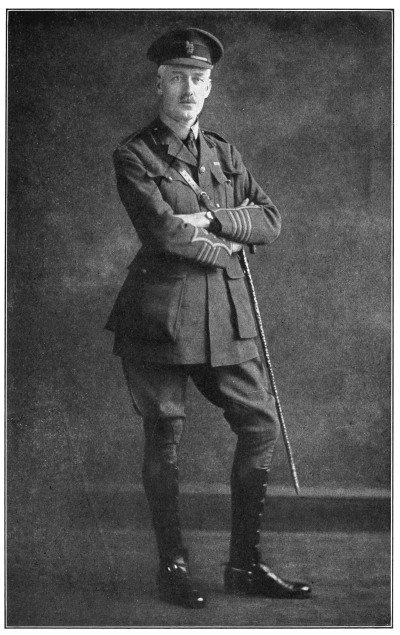
Photo. Harris & Ewing, Washington, D. C.
British Army. Officers’ service uniform
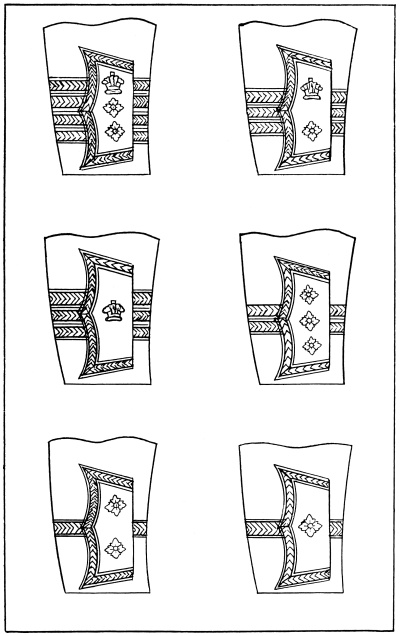
British Army.
Officers’ service uniform
sleeve decorations indicating rank
| 1. Colonel |
2. Lieutenant Colonel |
| 3. Major |
4. Captain |
| 5. Lieutenant |
6. Second Lieutenant |
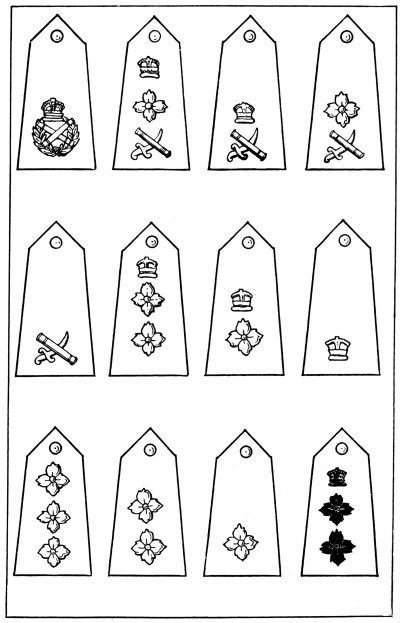
British Army.
Officers’ shoulder strap insignia
indicating rank
| 1. Field Marshal |
2. General |
| 3. Lieutenant General |
4. Major General |
| 5. Brigadier General |
6. Colonel |
| 7. Lieutenant Colonel |
8. Major |
| 9. Captain |
10. Lieutenant |
| 11. Second Lieutenant |
12. Chaplain, with rank of Colonel |
[Pg 229]
The rank of an officer in service uniform is indicated by metal
insignia of rank worn upon the shoulder straps and also (for officers
below the rank of Brigadier General) by stripes of worsted braid
around the sleeves just above the lower edge and by worsted insignia
of rank worn on a three-pointed strap which crosses the sleeve stripes
on the cuffs. These insignia of rank are shown in the accompanying
illustrations and are as follows for the various grades of rank:—
| Field Marshal |
Two crossed batons in red surrounded by a wreath of gold laurel
leaves and surmounted by a British crown in gold and red. |
| General |
A baton and sword crossed with a diamond shaped device
above it and a crown above the diamond, all in gold. |
| Lieutenant General |
A baton and sword crossed with a crown above it, all in gold. |
| Major General |
A baton and a sword crossed with the diamond above, all in gold. |
| Brigadier General |
The same omitting the diamond. |
| Colonel |
Two diamonds and a crown in a vertical line. |
| Lieutenant Colonel |
The same omitting one of the diamonds. |
| Major |
A crown. |
| Captain |
Three diamonds in a vertical line. |
| Lieutenant |
Two diamonds in a vertical line. |
|
|
| Second Lieutenant |
One diamond. |
The officers of the Scottish and Highland
regiments wear the stripes on the cuffs in a curve from the outer edge
of the sleeve to a higher point at the inner edge of the sleeve and the
insignia of rank beneath these stripes in a horizontal line instead
of in a vertical line as described and illustrated for the other officers.
The wearing of the insignia of rank upon the shoulder straps except by
officers of the rank of Brigadier General and higher has been suspended
when on actual duty in the field.
The insignia worn upon the front of the cap by a Field Marshal consists
of two crossed batons in red surrounded by a gold wreath and surmounted
by a gold and red crown above which is a gold British lion; for General
officers it is the same except that instead of the two batons there is
[Pg 230]
one baton and a sword crossed; permanent Staff officers wear the crown
and lion only on the cap; and a Field Marshal, General officers and
permanent Staff officers of field rank or above wear a scarlet band
around the cap.
For regimental officers the insignia worn on the front of the cap are
the distinctive “Regimental badges” adopted for the regiment. These
regimental badges present a great variety in design and often refer to
some historic battle in which the regiment has taken part or to some
distinctive feature of the county or colony from which the regiment comes.
In many cases the name by which the regiment is commonly known is
contained in the design, in others the number of the regiment in its
corps is given in the design, and not infrequently the regimental motto
has a prominent place.
Thus the regimental badge of the 4th Hussars, a famous cavalry
regiment, is a gold circle bearing the inscription “Queen’s Own
Hussars,” surmounted by a gold crown, and having on the center the
number of the regiment “IV,” and on a scroll beneath the motto “Mente
et Manu.”
The Irish Rifles have the Irish harp surmounted by a royal crown with a
scroll beneath bearing the motto “Quis Separabit,” all in green enamel.
The 17th Lancers have as their insignia a skull and cross bones with
the words “or Glory” on a scroll beneath, the motto of the regiment
being “Death or Glory.”
The 12th Canadian Infantry has a gold maple leaf bearing the number of
the regiment in silver and the word “Canada” also in silver.
The Grenadier Guards regiments have a gold spherical bursting shell.
[Pg 231]
Chaplains wear a Maltese cross surmounted by a crown in black enamel.
Officers of the Army Pay Corps wear the monogram “A.P.C.” surmounted by
a crown.
The insignia of the Royal Army Medical Corps consist of the rod of
Esculapius with a single serpent entwined about it surrounded by a
wreath and surmounted by a crown with the scroll beneath bearing the
inscription “Royal Army Medical Corps,” all in gold.
Both officers and enlisted men in the British Army habitually wear gilt
buttons and insignia on their service khaki-colored uniforms, although
when in the field these buttons and insignia are allowed to tarnish or
bronze, and in many cases leather buttons are used on field service in
place of the gilt buttons.
The overcoat, or great coat, worn by the officers of the British Army
is a double-breasted ulster quite similar in design to that worn by
officers of the United States Army, but having a lapel collar and
reaching only to the knee. It is made of cloth of the same color as the
service uniform and has shoulder straps upon which the insignia of rank
are worn.
The service uniform of the enlisted men of the British Army is of the
same khaki-colored cloth as the officers’ uniform and consists of a
cap similar to that worn by officers with a visor of tan leather or of
khaki-colored cloth upon the front of which the regimental or corps
insignia are worn; a single-breasted sack coat buttoning to the neck
with a standing turn-over collar, a patch pocket on each breast and a
bellows patch pocket on each side below the waist, and shoulder straps
upon which are worn, near the arm seam, the regimental badges; breeches
of the same color as the coat; wrap khaki-colored cloth puttees; and
[Pg 232]
heavy tan leather laced shoes. The overcoat is a short double-breasted
coat with rolling collar and back straps.
In hot weather khaki cotton drill uniforms of the same design are worn.
As variations of this general uniform, the Scottish and Highland troops
still wear the kilts as their winter uniform, although in hot weather
they also wear the full khaki summer uniform, the troops from Australia
and Canada to a great extent wear the wide brimmed felt hat common in
the American service, and the Indian troops wear their native turbans
and trousers although these are of the standard khaki color.
The rank of the noncommissioned officers is indicated in the British
Armies by badges worn upon the sleeves between the elbow and the
shoulder, as in the United States Army, many of these insignia being
nearly the same for the various grades, doubtless due to the fact that
the American insignia were originally taken from the British during the
revolutionary period.
The principal insignia of rank worn on the sleeves of noncommissioned
officers and enlisted men holding special assignments of duty are as
follows:
| Staff Sergeant Major, Army Service Corps |
A crown surrounded by a wreath. |
| Master Gunner 1st and 2nd class, Field Artillery |
A field gun with a crown above it. |
| Master Gunner 3rd class. Field Artillery |
The same without the crown. |
| Sergeant Major |
A crown. |
| Bandmaster
[Pg 233] |
A lyre with leaves at the base and a crown above it. |
| Cavalry Squadron Corporal Major |
A chevron of four stripes worn point
up with a crown above it. |
| Regimental Quartermaster Sergeant |
A chevron of four stripes worn point
up with a twelve pointed star above it. |
| Quartermaster Sergeant |
A chevron of four stripes worn point up. |
| Company Sergeant Major |
A chevron of three stripes worn point
down with a crown above it. |
| Color Sergeant |
A chevron of three stripes worn point down with
crossed flags and a crown above it. |
| Sergeant |
A chevron of three stripes worn points down. |
| Corporal |
A chevron of two stripes worn points down. |
| Lance Corporal |
A chevron of one stripe worn point down. |
| Infantry Pioneer |
Two axes crossed. |
| Roughrider of Cavalry |
A spur worn rowel up. |
| Scout Corporal |
A three-pointed lance head with a cross below it. |
| Squadron Scout, Cavalry |
A three-pointed lance head. |
| Bugler |
A horn bugle with cords. |
| Bugler of Rifle Regiments |
Two such bugles. |
| Sergeant Trumpeter |
Two straight trumpets crossed with a
three-pointed lance head vertical in the center. |
| Drummer |
A snare drum. |
| Machine Gunner |
The letters “M. G.” surrounded by a wreath. |
| Horseshoer |
A horseshoe worn toe up. |
| Saddler
[Pg 234] |
A horse’s bridle curb bit. |
| Wheelwright and Carpenter |
A wagon wheel. |
| Flight Sergeant of Royal Flying Corps |
Chevrons as for other sergeants with a four-bladed
propeller and a crown above it. |
| Sergeant of Royal Flying Corps |
The same without the crown. |
| Flying Corps Badge |
The words “Royal Flying Corps” on a blue ground. |
| Qualified Pilot, Flying Corps |
Two horizontally spread wings with a crown above and
the initials “R. F. C.” in the center. |
| Engineer Noncommissioned Officers |
The same chevrons as other noncommissioned
officers with a bursting bomb above. |
| Royal Army Medical Corps |
| enlisted men |
A scarlet Geneva cross in a yellow circle. |
Excellence in target practice with rifles and guns is indicated by
special badges worn on the sleeves between the elbow and the shoulder
as follows:
| Best rifle shot in Regiment |
Two rifles crossed surrounded by
a wreath with a crown above it. |
| Best shooting squadron or company in a Regiment |
The same without the wreath. |
| Best shot in squadron, company or band |
Two rifles crossed with a star above. |
| First Class Gunner, Artillery |
Two cannon crossed with a crown above. |
| Best swordsman in Regiment, Cavalry |
|
| Two sabers crossed with a crown above. |
|
| Best swordsman in Troop, Cavalry
[Pg 235] |
Two sabers crossed with a star above. |
| Best swordsman in every twenty men. Cavalry |
The same without the star. |
| First Prize Gunner, Artillery |
The letter “G” with a wreath beneath
and a crown above. |
| Second Prize Gunner, Artillery |
The same with a star instead of the crown. |
| Gun Layer, Artillery |
The letter “L” with a wreath beneath. |
A new type of distinguishing mark adopted during the present war
consists of pieces of cloth of various shapes worn in the center of
the back between the shoulders to enable officers to distinguish the
organization to which a man on the firing line belongs.
Uniforms of the French Army
Up to within a few years the uniform of the troops of the Line of the
French Army consisted of a dark blue coat and red trousers, with caps
of the kepi design and white gaiters or short leggings. This uniform
was decorated with gold and silver ornamentation and rank insignia and
as a variation in the headdress the cavalry wore helmets with plumes.
At the time of the Boer War in South Africa the question of a less
conspicuous uniform was agitated with the result that a coat of
mignonette green (or reseda as it was called in France) was adopted
although the red trousers were retained. With this uniform a helmet
of the same color as the coat was adopted. Some of the troops still
retained the dark blue coats however and discussion as to the uniform
to be finally adopted continued.
In 1912 a single-breasted sack coat of a light gray-blue color was
[Pg 236]
tried with the blue and red kepi, and red trousers which were worn
tight around the calves of the legs. The wrap puttee was also worn to
some extent.
Shortly after the beginning of the present war it was demonstrated by
service in the field that the red trousers and gold trimmings were too
conspicuous for modern field service, and as a result a uniform of
the light gray-blue color, known as “horizon blue,” was adopted for
both officers and enlisted men on field service, but the old dress
uniforms were not abolished though not worn during war. In this uniform
simplicity was sought and all bright buttons, insignia and trimmings
were reduced to a minimum with the object of securing a serviceable and
inconspicuous uniform.
The officers’ service uniform consists of a single-breasted sack coat
with a standing turn-down collar, shoulder straps and four outside
patch pockets similar to the service coat of United States Army
officers; breeches; tan leather strap puttees and shoes, or tan leather
boots, and a cap (kepi) of the same color as the coat and trousers.
The color of this uniform is a light blue-gray. The buttons are of
silver-bronze.
The cap, or kepi, has a sloping visor of black patent leather with
a band covered with gold lace for general officers and of distinctive
colored cloth with narrow gold stripes indicating rank for other
officers, and the top of the crown is slightly less in diameter than
the band. In the case of general officers the visor is ornamented with
gold decorations.
In the trenches when under fire a steel helmet is worn as a protection
against long range rifle bullets and pieces of shrapnel. This helmet is
of the same color as the service uniform and it has a distinctive corps
insignia on the front in metal of the same color.
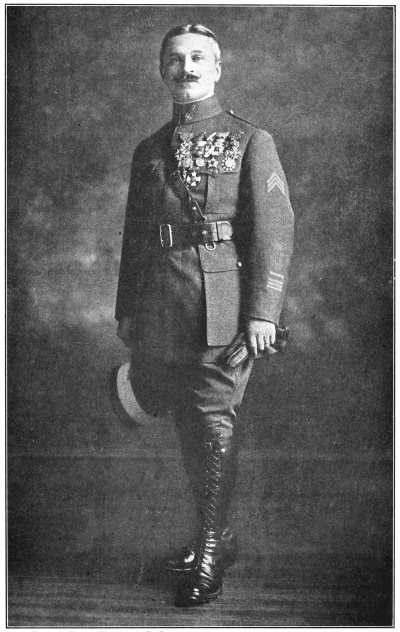
Photo. Harris & Ewing, Washington, D. C.
French Army. Officers’ service uniform
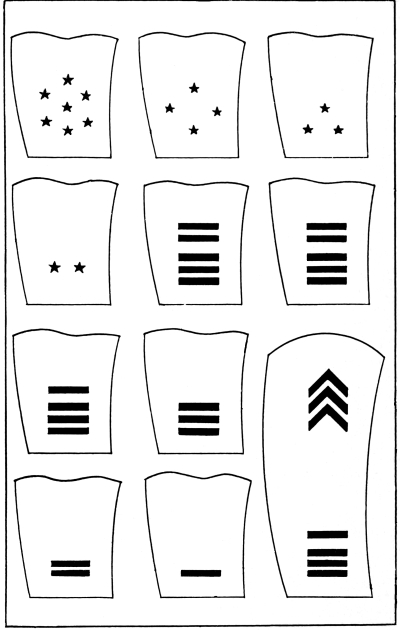
French Army.
Officers’ sleeve decorations indicating rank and service
All of the stripes are gold, except in the case of Lieutenant Colonel,
where the second and fourth are silver
| 1. Marshal of France |
2. General |
3. General of Division |
| 4. General of Brigade |
5. Colonel |
6. Lieutenant Colonel |
| 7. Major |
8. Captain |
9. First Lieutenant |
| 10. Second Lieutenant 11. War service chevron |
[Pg 237]
When on duty away from the actual battle front the dress cap of red or
blue (according to the corps) is frequently worn.
The rank of officers in the French Army was formerly indicated by stars
on the cuffs for General officers and by gold or silver stripes around
the cuffs of the coats for other officers, the widths, number and
arrangement of the stripes being practically the same as those worn by
officers of the same relative rank in the navy. These stripes proved
too conspicuous for field service and a small section of the stripes
showing on the front of the sleeve only was adopted for the service
coats. These short stripes or galons are of dull gold or silver
depending on the rank and are as shown in the accompanying illustration.
The insignia for the different grades of rank are as follows:
| Marshal of France |
Seven stars on each cuff, arranged in three
vertical rows, the center row having three stars and the outer rows
having two stars each. |
| General |
Four stars on each cuff, two placed horizontally
in the center and one above and one below. |
| General of Division |
Three stars on each cuff arranged
in a triangle with the point up. |
| General of Brigade |
Two stars placed on each cuff horizontally. |
| Colonel |
Five gold stripes, or galons, on each cuff. |
| Lieutenant Colonel |
The same as for Colonel except that the second
and fourth stripes are of silver. |
| Major |
Four gold stripes. |
| Captain |
Three gold stripes. |
| Lieutenant |
Two gold stripes. |
| Second Lieutenant |
One gold stripe. |
[Pg 238]
The corps or branch of the service is indicated in the French Army by
distinctive insignia or color patches worn on the collar at the front
on both sides of the neck opening.
A distinctive feature of the French Army uniforms for both the officers
and enlisted men is the “war service chevrons” worn on the right sleeve
between the elbow and the shoulder with the point of the chevron up. A
chevron of one stripe shows that the wearer has had one year’s active
service at the front during the present war and an additional stripe is
added to the chevron for each additional period of six months service
at the front. These service chevrons are of dull gold.
Officers of the Algerian Corps and of the Colonial Infanterie wear
winter service uniforms of khaki-colored cloth and hot weather uniforms
of khaki cotton material; the design of the garments being the same as
for those of the home troops except that the Algerians wear very loose
baggy trousers cut after the “Zouave” style.
Officers in the Aviation service also wear khaki-colored uniforms.
The officers’ overcoat is single-breasted reaching to about three
inches below the knees, closed with a single row of bronze buttons down
the center of the front, buttoning to the neck, with a wide falling
collar, and a large pocket on each side. Like the enlisted men’s
overcoat it is fitted to have the fronts of the skirt button back to
permit freedom of the legs in marching. The same stripes indicating
rank are worn upon the sleeves as upon the service coat.
In the French Army there is a rank called “Adjutant” which corresponds
to that of Warrant officer in the United States Navy and Marine Corps
[Pg 239]
but for which there is no corresponding rank in the United States Army.
His service uniform is similar to that worn by commissioned officers;
his cap bears no rank stripes, and his rank is indicated by a narrow
gold cuff stripe broken with sections of black.
The sword belt for officers is of tan leather with a cross strap over
the right shoulder and diagonally to the left side above the hip, very
similar to the British “Sam Browne” belt. It is worn by officers at all
times when on duty in service uniform.
The enlisted men of the French Army have service uniforms of the same
color as those for officers. The uniform consists of a single-breasted
sack coat, with standing collar and a patch pocket with buttoned flap
on each side below the waist, cut to fit easily; breeches cut full
above and close fitting below the knees; wrap puttees of cloth of the
same color as the coat and breeches; tan leather shoes; and a plain cap
of the kepi pattern with sloping visor.
The Algerian troops wear uniforms of the same design but of
khaki-colored cloth and very loose “Zouave” style breeches.
The Colonial Infantry wear service uniforms of the same design as those
for the home troops but of khaki-colored material.
Mounted troops and field artillery wear tan leather boots or tan
leather leggings and shoes.
The overcoat for enlisted men is single-breasted, reaching a little
below the knee, with side pockets, and fitted to have the skirts
buttoned back from the front so as not to interfere with the freedom of
the legs in marching. The overcoats are of the light blue-gray cloth.
The rank of noncommissioned officers is indicated by short stripes of
[Pg 240]
cloth worn diagonally across the outer side of the coat sleeves between
the elbow and the lower edge, as follows:
| Sergeant Major |
Three stripes of dull gold braid. |
| Sergeant |
Two stripes of dull gold braid. |
| Corporal |
Two stripes of cloth of the distinctive
color of the arm of the service. |
| First class private |
One stripe of cloth of the distinctive
color of the arm of the service. |
The arm of the service to which an enlisted
man belongs is shown by color patches upon the collar on both sides of
the front opening. These patches are of yellow for infantry, blue for
cavalry, red for artillery and black for engineers, and have the number
of the regiment upon them in black figures for infantry, white for
cavalry and artillery, and red for engineers. Aviators wear an insignia
consisting of two eagle’s wings upon each side of the collar.
The belts, belt suspender straps and cartridge boxes are of tan
leather, though webbing is also in use. The water bottle (canteen) is
covered with cloth of the same color as the uniform.
The buttons worn by enlisted men upon the service uniform coat and
overcoat are plain and of the same color as the material of the coats.
In some special corps of the French service there are variations from
the standard uniform above described, thus the Chasseurs Alpin wear a
uniform of dark blue cloth with a dark blue beret, a full-crowned
visorless hat something after the style of the tam-o-shanter, and the
Algerian troops wear a round turban of khaki-colored cloth with a
tassel in the center, after the style of the fez.
[Pg 241]
Uniforms of the French Navy
The uniforms of the officers and men of the French Navy, while
following in general the usual naval style present some variations
as to the combination of garments, the decorations, the number and
arrangements of the rank stripes on the sleeves and the designs of the
insignia of rank and corps.
Commissioned officers are provided with five separate uniforms, full
dress, No. 1 dress, No. 2 dress, No. 3 dress blue, and No. 3 dress white.
The full dress corresponds to the United States naval officer’s special
full dress uniform, and consists of a cocked hat, a dark blue double
breasted cutaway frock coat, gilt epaulets, dark blue cloth trousers
decorated with gold lace stripes down the outer seams.
No. 1 dress corresponds to the United States naval officer’s full dress
uniform and consists of a cocked hat, blue cap or white cap, a dark
blue double-breasted frock coat with epaulets, and plain dark blue or
white trousers.
No. 2 dress corresponds to the undress uniform of the United States
naval officer and consists of the blue or white cap, the dark blue
frock coat or the white tunic and dark blue or white trousers.
No. 3 dress, blue, corresponds to the blue service dress of the United
States naval officer and consists of the dark blue cap, dark blue frock
coat or dark blue tunic (sack coat) and dark blue or white trousers.
No. 3 dress, white, corresponds to the white service dress of the
United States naval officer and consists of the white cap, white tunic
and white trousers.
Black shoes are worn with all except white uniforms, with which white
shoes are worn.
[Pg 242]
The rank of commissioned officers is shown by means of insignia on the
tops of the epaulets, with uniforms of which epaulets form a part,
and by decorations on the cuffs of the sleeves of the frock coat
and service sack coat. These sleeve decorations are as shown by the
illustrations:—
| Admiral of France |
Two batons crossed in gold embroidery. |
| Vice Admiral |
Three silver stars. |
| Rear Admiral |
Two silver stars. |
| Captain |
Five stripes of gold braid. |
| Commander |
Five stripes of braid, the second and fourth
being silver and the other three gold. |
| Lieutenant Commander |
Four stripes of gold braid. |
| Lieutenant |
Three stripes of gold braid. |
| Lieutenant, Junior Grade |
Two stripes of gold braid. |
| Ensign |
One stripe of gold braid. |
| Midshipman |
One stripe of gold braid broken
by interwoven stripes of blue silk. |
The officers of the Line or Command branch wear the rank insignia on
the dark blue cloth of the coat sleeve; while the officers of the Staff
Corps have cuffs of distinctive color beneath the stripes, these colors
being for:—
| Engineer officers |
violet velvet. |
| Medical officers |
red velvet. |
| Constructors and Ordnance officers |
black velvet. |
| Paymasters |
brown velvet. |
On the white service tunic or coat the rank is indicated
by stripes upon shoulder straps, these stripes being similar to those worn on the
sleeves of the blue frock coat and tunic.
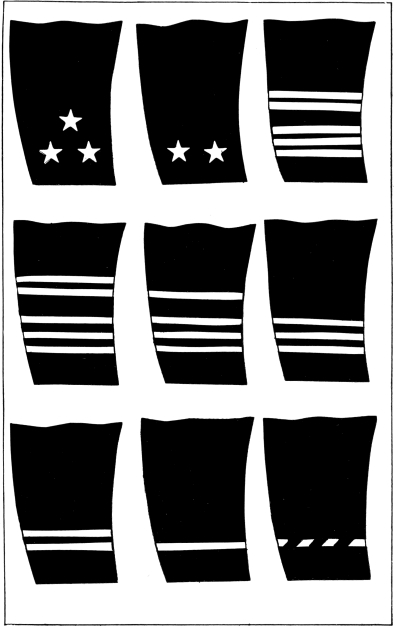
French Navy.
Officers’ sleeve decorations indicating rank
All of the stripes are gold with the exception of those for Commander,
in which case the second and fourth stripes are silver
| 1. Vice Admiral |
2. Rear Admiral |
3. Captain |
| 4. Commander |
5. Lieutenant Commander |
6. Lieutenant |
| 7. Lieutenant, Junior Grade |
8. Ensign |
9. Midshipman |
[Pg 243]
The cap for Flag Officers is of blue cloth with a patent leather visor
and a band of gold embroidery, and it has an insignia on the front
consisting of a gold anchor with various decorations of leaves for the
different grades and corps.
The cap for officers below the rank of Rear Admiral is of the same
design, with narrow stripes of gold braid around the band to indicate
the rank of the wearer. On ordinary service aboard ship a cap of the
same design with a band of black silk ribbon is worn. The device worn
on the front of the cap by these officers is a gold foul anchor placed
vertical.
Warrant officers wear dress uniforms similar to those worn by
commissioned officers; their cap has one narrow gold stripe around
the band and a gold anchor on the front, and their sleeves have three
narrow stripes, the upper one of gold one-quarter of an inch wide, the
middle one a twisted silver rope one-eighth of an inch wide and the
lower one of gold of the same rope design.
The enlisted men of the French Navy wear uniforms of dark blue cloth
for cold weather and of white for hot weather, those for the chief
petty officers consisting of a plain cap with black leather visor, a
sack coat with gilt buttons and plain trousers, and those for enlisted
men of lower ratings consisting of a flat sailor cap, overshirt and
trousers of a design similar to those worn in the British Navy. A
prominent feature of their uniform cap is a red pompon in the center of
the top of the crown.
The overcoats are of dark blue cloth of the design commonly styled
“pea jackets.”
The rating or rank of the petty officers is indicated by distinguishing
marks worn upon the sleeves; some of the principal ones being:—
[Pg 244]
| Chief Petty Officers. |
| Seaman Branch |
Two narrow gold stripes on each
sleeve above the cuff, and on the cap a gold anchor and a narrow
gold stripe around the band. |
| Commissary Branch |
The same except that the sleeve stripes are silver. |
| Musicians |
Two twisted gold stripes on the cuff and a gold lyre
on each side of the collar. |
| Petty Officers, First Class. |
| Seaman Branch |
One gold stripe on each sleeve above the cuff,
and a gold anchor on the cap. |
| Commissary Branch |
The same except that the sleeve stripe is silver. |
| Buglers and Drummers |
One gold stripe on each sleeve, worn diagonally. |
| Musicians |
One twisted gold stripe on each sleeve and a gold
anchor on each side of the collar. |
| Petty Officers, Second Class. |
| Seaman Branch |
Two stripes of red cloth on each sleeve between
the elbow and the cuff. |
| Yeoman Branch |
One broken gold stripe on each sleeve between
the elbow and the shoulder. |
| Musicians |
Two stripes of red cloth on each sleeve
between the elbow and the cuff. |
| Stewards |
Two stripes of orange colored cloth on
each sleeve between the elbow and the cuff. |
| Buglers and Drummers |
One diagonal gold stripe on each sleeve. |
[Pg 245]
All petty officers of the second class and also seamen wear two anchors
crossed on the upper part of the right sleeve.
There are also a number of specialty marks for such special ratings as
cook, tailor, shoemaker and armorer.
The distinctive mark of band musicians is a gold lyre worn on each side
of the collar, and that of the hospital corps is the red Geneva cross.
Uniforms of the Italian Army
In the Italian Army the peace time dress uniforms consist, as a rule,
of a dark blue braided coat, light gray trousers with stripes of
distinctive corps color down the outer seams, and black leather boots
for officers and leggings for enlisted men. The head dress varies with
the corps and arm of the service, the infantry wearing a dark blue cap
trimmed with colored braid, the cavalry a metal trimmed helmet or a fur
busby, the field artillery a black shako with bright brass ornaments,
and the Bersaglieri a black felt hat with a plume of feathers falling
over the left shoulder.
The field service uniform is of gray cloth having a greenish tinge and
is practically the same for all arms of the service and for all corps,
except that the Bersaglieri wear their regular uniform of dark blue
with red facings and their distinctive head dress.
The officers’ field uniform consists of a short sack coat with a
standing-falling collar and a patch pocket on each breast; breeches or
trousers cut to fit the legs tightly below the knee, black boots or tan
leather shoes and leggings, and a straight crowned cap with sloping
visor of black leather and a band of distinctive corps color. The coat
is closed by buttons down the front concealed by a fly or by concealed
hooks and eyes. On each side of the collar at the front is a silver
[Pg 246]
star with a circular disc in the center upon which are the insignia
indicating the corps or arm of the service to which the
officer belongs.
The rank is indicated by the shoulder straps and the insignia worn upon
them. The shoulder knots for General officers are covered with silver
and bear gold stars to indicate the rank, those for Field officers
having a narrow edging of silver braid and silver stars to indicate the
rank, and those for company officers having only the silver stars to
indicate the rank; as follows:—
| General |
Silver covered shoulder straps with three gold stars. |
| Lieutenant General |
Silver covered shoulder straps with two gold stars. |
| Major General |
Silver covered shoulder straps with one gold star. |
| Colonel |
Shoulder straps edged with silver braid and with three silver stars. |
| Lieutenant Colonel |
Shoulder straps edged with silver braid and with two silver stars. |
| Major |
Shoulder straps edged with silver braid and with one silver star. |
| Captain |
Plain shoulder straps with three silver stars. |
| First Lieutenant |
Plain shoulder straps with two silver stars. |
| Second Lieutenant |
Plain shoulder straps with one silver star. |
The rank of officers is also shown by the braid around the
cap; the cap for General officers having a red band embroidered in silver with bands
of narrow gold braid above it, three for general, two for lieutenant
general and one for major general; the cap for Field officers having
one wide silver stripe around the band with narrow stripes of silver
braid above it, three for colonel, two for lieutenant colonel and one
[Pg 247]
for major; and the cap for company officers having stripes of narrow
silver braid around it, three for captain, two for first lieutenant and
one for second lieutenant.
The corps of officers is shown by patches of distinctive color upon the
collar at each side of the neck opening and also by the insignia upon
the center of the silver star worn on each side of the collar.
The enlisted men wear service uniforms of the same color as that of the
officers, the coat and trousers being similar to that for officers and
the cap being a plain cloth kepi of the same color as the coat with
a sloping visor of black leather. The cavalry wear gray helmets, the
Bersaglieri wear their own distinctive plumed hat and all men on duty
in the trenches wear steel trench helmets similar to those worn by the
American, British and French soldiers.
The rank of noncommissioned officers is indicated by chevrons worn
points up on the sleeves between the elbow and the bottom edge of the
cuff, as follows:—
| Sergeant Major |
Chevron of four stripes in silver. |
| Sergeant |
Chevron of three stripes in white cloth. |
| Corporal |
Chevron of three stripes in red cloth. |
Distinctive badges are also worn on the sleeves to indicate special
duties or assignments of enlisted men.
The arms of the service and corps of an enlisted man is indicated
on his uniform by patches of the distinctive corps color upon the
collar at each side of the front opening, and the regiment is shown by
numerals on these color patches.
Uniforms of the Italian Navy
The uniforms for the officers and enlisted men of the Italian Navy are
made of dark blue cloth for dress uniforms and for undress uniforms for
[Pg 248]
winter wear and of white cotton duck or linen for wear in hot weather.
In general the design of the uniform is similar to those of the British
Navy with the exception of the undress coat which is similar to the
service coat for officers of the United States Navy.
Commissioned officers are required to have special full dress, full
dress, dress, blue undress and white undress uniforms.
The special full dress uniform consists of a cocked hat very similar to
that worn by American naval officers, a double-breasted cutaway frock
coat with turn-down collar and notched lapels buttoned down the front
with two rows of service gilt buttons; dark blue trousers with gold
lace braid stripes down the outer leg seams, and black shoes. Epaulets
similar to those worn in the United States Navy and a sword belt
covered with gold lace are worn with this uniform, and a blue silk sash
is worn from the right shoulder diagonally across the body to the left
side where it is knotted and the ends have tassels.
The full dress uniform consists of a double-breasted frock coat very
similar to that worn in the United States Navy; a bell-crowned cap
of dark blue cloth with a sloping visor; plain dark blue trousers,
and black shoes. Epaulets and the full dress belt are worn with this
uniform.
The dress uniform is the same as the full dress with the exceptions
that the epaulets are omitted and the sword belt is of black leather.
The blue undress uniform consists of the blue cap, a single-breasted
sack coat on the lines of that worn by officers of the United States
Navy with black braid trimming around the edges and collar and down the
front with which shoulder straps are worn.

Photo. Harris & Ewing, Washington, D. C.
Italian Army. Officers’ service uniform

Italian Navy, Officers’ sleeve decorations indicating rank
| 1. Admiral |
2. Vice Admiral |
3. Rear Admiral |
| 4. Captain |
5. Commander |
6. Lieutenant Commander |
| 7. Lieutenant |
8. Sub Lieutenant |
9. Midshipman |
[Pg 249]
The white undress uniform is of the same description as the blue
undress except that the material is white cotton or linen duck.
The rank of officers in the Italian Navy is indicated by gold braid
stripes around the sleeves above the cuffs as shown in the accompanying
illustration.
The corps or branch of the service to which an officer belongs is
indicated as follows:—
| Line officers |
By the “curl” in the upper rank stripe. |
| Engineer officers |
By stripes of black velvet between the rank stripes. |
| Naval Constructors |
By stripes of crimson velvet between the rank stripes. |
| Medical officers |
By stripes of light blue cloth between the rank stripes. |
| Paymasters |
By stripes of red cloth between the rank stripes. |
Officers of the Staff Corps do not have the “curl” in the upper rank stripe.
The insignia on the front of the cap consist of an oval medallion
surrounded by a gold wreath and surmounted by the Royal Crown of Italy
in gold on a blue ground. The medallion in the center shows the corps
or branch of the service, Line officers having a gold foul anchor on a
light blue ground, Engineer officers a gold three-bladed propeller on
a black ground. Medical officers a red Geneva cross on a white ground,
Naval Constructors a gold helmet on a red ground, and Paymasters a gold
star on a red ground.
The band of the cap is of the distinctive color of the corps or branch
of the officer and has sewn upon it gold stripes indicating the rank of
the wearer.
On the right side of the cocked hat there is a cockade of red, white
and green silk.
[Pg 250]
Chief Warrant officers wear uniforms similar to the commissioned
officers’ uniforms with one gold stripe broken by diagonal blocks of
blue silk with the corps mark above it on the cuffs. Their cap has
a black mohair braid band and insignia on the front like those of
commissioned officers except that the Royal crown is omitted.
Warrant officers wear the same uniform as Chief Warrant officers except
that the stripe of gold braid on the sleeve is omitted and the corps
insignia alone are worn on the sleeves above the elbow.
Enlisted men wear uniforms of dark blue cloth or white duck depending
upon the temperature, these uniforms being similar in general design to
those of the United States Navy.
The insignia of rank for Petty officers are as follows:—
| Chief Petty officers |
A gold chevron of one wide stripe and one narrow stripe on each sleeve
above the elbow with the branch mark above it. An additional chevron is
added after three years’ service in the grade. |
| Petty officers |
A red chevron of one wide stripe and one narrow one on each sleeve
above the elbow with the branch mark above it, in red. |
| Leading Seamen |
A chevron of one narrow red stripe with the branch mark above it, in red. |
| Able Seamen |
The branch mark in red on each sleeve above the elbow. |
| Ordinary Seamen |
The sleeves are plain. |
The specialty or branch marks for the different corps or branches of
the enlisted men are as follows:—
[Pg 251]
| The Line or Deck branch. |
A foul anchor. |
| Navigating branch |
A steering wheel. |
| Engineers |
A three-bladed propeller. |
| Firemen |
A two-bladed propeller. |
| Torpedo branch |
Two torpedoes crossed with a hammer below. |
| Gunnery branch |
Two cannon crossed. |
| Gunlayers |
Two cannon crossed with a bursting bomb in the center. |
| Electricians |
A device representing three branches of zig-zag
lightning with a hammer in the center. |
| Mining division |
A submarine mine case. |
| Divers |
A submarine mine case and a hammer. |
| Carpenters |
Two hatchets crossed. |
| Plumbers |
Two hatchets crossed with a flame in the center. |
| Joiners |
A saw. |
| Musician of the band |
Two anchors crossed with a harp in the center. |
| Radio operators |
Three branches of zig-zag lightning. |
| Hospital man |
A gold star with a red Geneva cross on white ground in the center. |
| Stewards |
A sheaf of wheat. |
| Buglers |
An anchor crossed by a trumpet. |
| Signalman |
A triangular pennant with vertical stripes. |
Enlisted men who have been promoted for gallantry in war service wear a
gold crown on the sleeves above the specialty marks.
Uniforms of the Belgian Army
Before 1914 the uniforms of the Belgian Army for home service were
very elaborate and decorated with gold and silver braid and ornaments,
[Pg 252]
although uniforms of cotton khaki were worn in hot weather on foreign
service; but the experience of the present war showed the necessity
of an inconspicuous dress for field service, and as a result the army
is now provided with a field uniform designed after the British Army
service uniform and made of dark khaki-colored woolen cloth.
The officers’ field service uniform consists of a coat similar to that
worn by British officers except that it has a standing collar; breeches
of the same material and color as the coat; a cap after the British
design, and tan leather boots, or tan leather shoes with khaki-colored
wrap puttees or tan leather strap puttees.
With this uniform the British “Sam Browne” tan leather belt and
shoulder strap is worn.
The corps or arm of the service to which an officer belongs is shown
by patches of colored cloth on the collar at each side of the neck
opening. The rank of officers is indicated by insignia upon these
collar patches, as follows:—
| Major General |
Three stars arranged to form an equilateral triangle with two vertical
bars in front of it and a device made up of the King’s monogram, wings,
a spear head and bolts of lightning, all in gold embroidery. |
| Brigadier General |
The same as for major general,
except there is but one vertical bar. |
| Colonel |
Three gold stars arranged in the form of an equilateral triangle
pointing down with a semicircular gold bar beneath it. |
| Lieutenant Colonel |
The same as for colonel except there are but two stars. |
| Major |
The same as for lieutenant colonel except there is but one star. |
| Commandant |
Three gold stars arranged in the form of an
equilateral triangle pointing down. |
| Captain |
The same as for commandant except that the lower star is silver. |
| First Lieutenant |
Two gold stars. |
| Second Lieutenant |
One gold star. |
| Adjutant |
One silver star. |
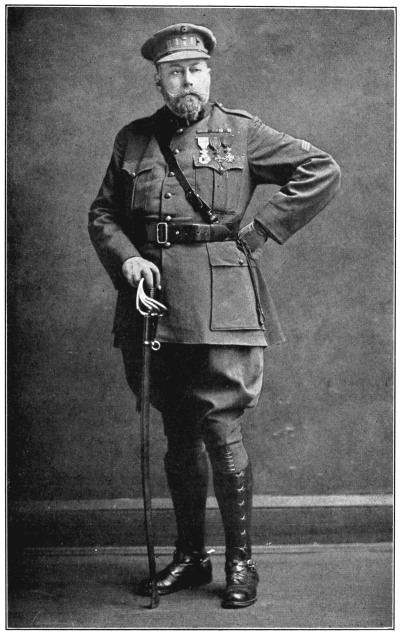
Photo. Harris & Ewing, Washington, D. C.
Belgian Army. Officers’ service uniform
[Pg 253]
The grade of Commandant has no corresponding one in the United States
Army; the rank is between those of Major and Captain.
The grade of Adjutant corresponds to that of a Warrant Officer in the
United States Navy and Marine Corps.
The service uniform of the enlisted men in the Belgian Army is similar
in design and color to that of the British soldier.
The rank of noncommissioned officers is indicated by stripes upon the
cuffs as follows:—
| Regimental Sergeant Major |
Three narrow stripes around the cuff parallel to the lower edge. |
| Sergeant Major |
Two stripes around the cuff with two diagonal stripes above them. |
| First Sergeant |
Two stripes around the cuff. |
| Quartermaster Sergeant |
One stripe around the cuff with one diagonal stripe above it. |
| Sergeant |
One stripe around the cuff. |
| Corporal |
One stripe around the cuff, narrower than that worn by a sergeant. |
Specialty marks are worn upon the sleeves above the elbow to mark men
assigned to special duties.
[Pg 254]
| Engineers |
A plumed helmet. |
| Aviator |
The King’s monogram with an eagle’s wing at each side. |
| Hospital Corps |
A caduceus surrounded by a wreath. |
| Cycle Corps |
A bicycle wheel. |
| Grenadiers |
A bursting bomb. |
| Bandsmen |
A lyre. |
The men wear tan leather belts and cartridge pouches.
Uniforms of the Russian Army
The officers and enlisted men of the Russian Army formerly had a
great variety in uniforms for the different corps and branches of the
service; the infantry of the regular Line wore uniforms of green cloth
with red facings; the hussars wore green jackets trimmed across the
front with white stripes and loops, red breeches and black high boots;
the guards wore green uniforms with yellow facings; the Don Cossacks
wore uniforms of dark gray, the coat being long and the breeches very
loose and the headdress being a black shako; and the Kuban cossacks
wore a uniform of similar design of reddish brown cloth.
During the Russo-Japanese War of 1904-5 an effort was made to
standardize the field service uniforms with the result that the present
service uniform is of cloth of a gray-brown shade. The Cossacks have to
some extent preserved their distinctive dress.
The service uniforms for officers consists of a single-breasted sack
coat with a standing collar, a pocket with flap on each breast and
closed by a row of gilt buttons down the front; breeches of the same
color with stripes down the outer leg seams of varying widths according
to rank and of different colors according to the corps or arm of the
service; a bell-crowned cap with sloping visor, and black boots.
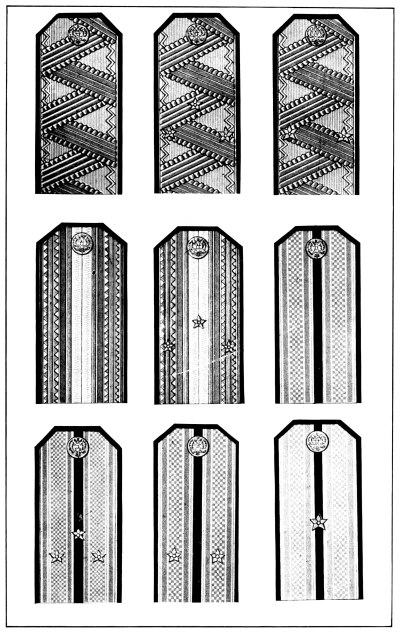
Russian Army. Officers’ shoulder straps indicating rank
The straps are of black cloth covered with gold or silver lace,
depending upon the rank and corps of the officer. Those for
General Officers are of gold lace with silver stars
| 1. General |
2. Lieutenant General |
3. Major General |
| 4. Colonel |
5. Lieutenant Colonel |
6. Senior Captain |
| 7. Junior Captain |
8. First Lieutenant |
9. Second Lieutenant |
[Pg 255]
The rank is indicated by the trimming and ornamentation of flat
shoulder straps, those for the various grades of rank being shown in
the accompanying illustration. It will be noted that
there are no grades of Brigadier General or Major in the Russian Army, but that
there are two grades of the rank of Captain, called First and Second or
Senior and Junior Captain. The duties of the Senior Captain correspond
in a measure to those of Major in the United States services. Line
officers of the rank of Colonel and below wear the number of their
regiment in the center of the shoulder strap.
The Russian officer’s service cap is similar to that worn by officers
of the United States Army except that the top of the crown is
relatively greater in diameter. The band is of the distinctive color of
the corps or arm of the service. A medallion made up of the national
colors is worn at the center of the band in front and the visor
and chin strap are of brown leather. In some of the regiments gray
sheepskin shakos are worn by both officers and men instead of the cap.
The arm of the service or corps is indicated by patches of colored
cloth on the front of the collar on each side of the neck opening.
The sword belt is of tan leather with a cross strap from the right
shoulder to the left side at the waist although in some corps the sword
is suspended from the diagonal cross strap only, the waist-belt not
being worn by officers.
The uniform of the enlisted men is of similar cut to that of the
officers except that the coats are looser and in some corps are closed
by a row of buttons down the right side.
The rank of the noncommissioned officers is indicated by stripes and
other insignia upon narrow flat shoulder straps worn from the base of
the collar to the top of the sleeve shoulder seam.
[Pg 256]
The Russian Army has an officer of Warrant rank, intermediate between
the commissioned officers and enlisted noncommissioned officers. These
Warrant officers wear one broad stripe across the shoulder strap near
the collar end.
The noncommissioned officers wear narrow stripes on their shoulder
straps in the same position; a sergeant major having three such
stripes, a sergeant two and a corporal one.
There have been various corps and specialty insignia but as these are
now in a process of being changed they cannot be given accurately.
The Russian noncommissioned officers wear swords suspended from tan
leather belts and the privates wear a tan leather belt with cartridge
boxes of the same material. All of the enlisted men carry their extra
clothing in a blanket roll over the right shoulder and diagonally
across the body to the left side at the belt.
Uniforms of the Russian Navy
The uniforms of the officers and enlisted men differ in many respects
from those which are common to the navies of the other principal powers.
The officers’ uniforms are as a rule made of a dark green cloth for
dress and winter wear and of white cotton or linen for hot weather.
The prescribed uniforms are full dress, dress, undress and service
(working) dress.
The full dress uniform consists of a cocked hat, tunic with standing
collar, epaulets, and trousers with gold lace braid on the outer leg seams.
The dress uniform consists of a cap, double-breasted frock coat, with
epaulets, and plain trousers.

Russian Navy. Officers’ sleeve decorations indicating rank
| 1. Admiral |
2. Vice Admiral |
3. Rear Admiral |
| 4. Captain |
5. Commander |
6. Lieutenant Commander |
| 7. Lieutenant |
8. Sub Lieutenant |
9. Warrant Officer |
[Pg 257]
The undress uniform is the same as the dress uniform without epaulets.
The service or working uniform consists of a cap, a short single
breasted tunic of dark blue cloth and plain trousers.
In hot weather a similar uniform of white cotton or linen material is worn.
An overcoat of black cloth and a heavier one of gray cloth with a fur
collar are worn by officers.
In May, 1917, the shoulder straps and the insignia of rank formerly
worn upon them were abolished and stripes on the sleeves above the cuff
to indicate rank with distinctive colors to indicate the Staff corps,
were adopted for all uniform coats and the overcoat.
These stripes for the different grades of rank are as shown by the
accompanying illustrations.
Officers of the Line and of the Engineer Corps wear gold stripes,
and officers of the Medical Corps, Naval Constructor Corps, Judge
Advocate’s Corps, and Paymasters wear silver stripes, with the stripes
edged with cloth of a distinctive color for each corps.
These distinctive colors are:
| Medical officers |
White. |
| Naval Constructors |
Red. |
| Judges Advocate |
Crimson. |
Paymasters wear silver stripes without the “curl” and without edgings
of colored cloth.
Officers wear a sword on all occasions of dress and ceremony, but on
occasions of ordinary duty they wear a short dirk in place of the sword.
The warrant officers of the Russian Navy wear uniforms similar to those
[Pg 258]
worn by commissioned officers, the distinguishing mark being a narrow
gold stripe around the sleeves above the cuff.
Enlisted men wear black cloth trousers, a jersey with blue and white
horizontal stripes and a blue jumper.
The caps are similar to those worn by enlisted men of the British Navy.
The name of the ship is given on the cap ribbon as in other navies,
this ribbon being tied at the back so that it hangs down in streamers.
White duck uniforms of the same pattern as the blue ones are worn in
hot weather.
The ratings of petty officers are indicated by badges worn on the
sleeves above the elbow; these badges are at present being revised and
hence cannot be accurately given.
All enlisted men are provided with short overcoats of gray cloth.
Uniforms of the Japanese Army
Previous to the Russo-Japanese war of 1904-5 the officers and enlisted
men of the Japanese Army wore uniforms of dark blue or red cloth with
facings of distinctive colors for the various arms, but this proved so
conspicuous on the battlefields of that war that a service uniform of
khaki-colored cloth for winter and khaki cotton drill for summer was
adopted. The officers, however, retained for their dress uniforms the
old dress uniforms of dark blue and red cloth with heavy decorations of
gold lace.
The dress uniform of the officers consists of a dark blue double
breasted frock coat with standing collar; trousers of dark blue cloth
with stripes of the corps color down the outer leg seams for all arms
except the cavalry in which the officers wear red breeches; black boots;
[Pg 259]
and a kepi style cap decorated with gold lace and having a red and
white standing plume at the front, this cap being of red cloth for the
cavalry and of blue cloth for the other arms.
The collar of the dress coat is covered with gold lace; the buttons
are gilt with a design of chrysanthemums and cherry blossoms; shoulder
knots of plaited gold cord and a sash belt of gold and red stripes
with heavy tassels at the left side are worn with it, and the rank is
indicated by sleeve decorations consisting of a knot made up of narrow
stripes of gold braid of the same design as that worn by officers of
the United States Army. This sleeve knot is made of one stripe for
Second Lieutenant and one additional stripe for each step up in grade
through the ranks of First Lieutenant, Captain, Major, Lieutenant
Colonel, Colonel, Major General, Lieutenant General and Field Marshal,
the latter having a knot of nine stripes.
The distinctive colors for the different arms of the service are
red for infantry, green for cavalry, yellow for artillery, crimson
for pioneers, gray for the quartermaster corps, and black for the
gendarmerie (national police).
The service uniforms for both officers and enlisted men consist of a
single-breasted sack coat of khaki-colored woolen cloth for winter and
cotton drill for summer; trousers or breeches of the same materials,
and a bell-crowned cap with sloping visor of tan leather and a band of
the distinctive color of the arm of the service.
The service coat has a standing collar with a patch of the distinctive
color for the arm of the service on each side of the neck opening, a
pocket with buttoned flap on each side of the breast and a plain pocket
on each side below the waist.
[Pg 260]
Officers wear breeches and boots when mounted and tan leather leggings
or khaki-colored wrap puttees for dismounted service. The shoes worn by both
officers and enlisted men with the service uniform are of tan leather.
The rank of the officers is indicated by shoulder straps worn
transversely across the shoulders next to the shoulder seams of the
sleeves, after the style of the shoulder strap worn by officers of the
United States Army with their blue dress coats. These are the only two
great armies in which this form of shoulder strap is worn by officers
to indicate rank.
These shoulder straps are covered with cloth of the distinctive color
of the arm of the service with stripes of gold braid running lengthwise
of them on the same scheme as that used on the shoulder straps worn by
Japanese naval officers as illustrated, namely, for General officers
one wide stripe, for field officers two narrow stripes and for company
officers one narrow stripe. On the gold stripes silver stars are worn
for the different grades of rank in each class. The number of stripes
and stars for each grade is as follows:
| General Officers. |
| General |
Three stars on one wide gold stripe. |
| Lieutenant General |
Two stars on one wide gold stripe. |
| Major General |
One star on one wide gold stripe. |
Field Officers. |
| Colonel |
Three stars on two narrow gold stripes. |
| Lieutenant Colonel |
Two stars on two narrow gold stripes. |
| Major |
One star on two narrow gold stripes. |
Company Officers. |
| Captain |
Three stars on one narrow gold stripe. |
| First Lieutenant |
Two stars on one narrow gold stripe. |
| Second Lieutenant |
One star on one narrow gold stripe. |
[Pg 261]
The rank of noncommissioned officers is shown by narrow stripes around
the cuffs, and for all enlisted men the arm of the service is indicated
by the color patches on each side of the collar and the regimental
number is worn upon these collar patches, Arabic figures being used for
the regular service, Roman numerals for the militia and Arabic figures
on one side of the collar and Roman on the other for the reserves.
The overcoat for officers is a double-breasted ulster similar to that
worn by American officers, and that for enlisted men is single-breasted
and short. The overcoats are of khaki-colored cloth.
The service belts for both officers and men are of tan leather.
Uniforms of the Japanese Navy
When Japan began to build and man her modern navy she derived much
early training and experience from the British Navy, which was then as
now, the largest of the world’s navies.
As a result the uniforms of both the officers and men of the Japanese
Navy are similar in most respects to those of the British Navy. The
principal difference is that the Japanese naval officers’ undress or
service uniform coat is a single-breasted blouse with standing collar
similar to that worn by officers of the United States Navy, the collar
and edges being trimmed with black braid.
In the insignia of the Japanese Navy the cherry blossom usually takes
the place where the crown appears in the British naval insignia, as may
be seen by reference to the illustrations.
[Pg 262]
The uniforms for both officers and enlisted men are of dark blue cloth
for full dress and dress uniforms, the undress or service uniform being
of dark blue cloth for winter wear and of white cotton duck or linen
for wear in hot weather.
The rank of officers is indicated by stripes around the sleeves above
the cuff on the blue uniforms and by shoulder straps on the white
service uniform.
The sleeve stripes are of gold lace braid for full dress and dress
coats and of black braid for the blue service coat.
The number, width and arrangement of the sleeve stripes for the
different ranks are as shown in the accompanying illustration.
The corps or branch of the service to which an officer belongs is
shown by the circular curl above the upper stripe for officers of the
Line, and by stripes of colored cloth between the rank stripes for the
officers of the Staff Corps, the distinctive colors for the various
corps being as follows:—
| Engineer Corps |
Purple. |
(The officers of the Engineer Corps
also wear the curl above the upper rank stripe, officers
of the other Staff Corps do not wear the curl.) |
|
| Medical Corps |
Red. |
| Engineer Constructors |
Brown. |
| Ordnance Constructors |
Maroon. |
| Paymaster Corps |
White. |
| Hydrographic Corps |
Light blue. |
| Chief Carpenter (warrant officers) |
Green. |
| Bandmasters (warrant officers) |
Gray. |
These distinctive colors for officers
of the different Staff Corps are also worn around the bands of the caps.
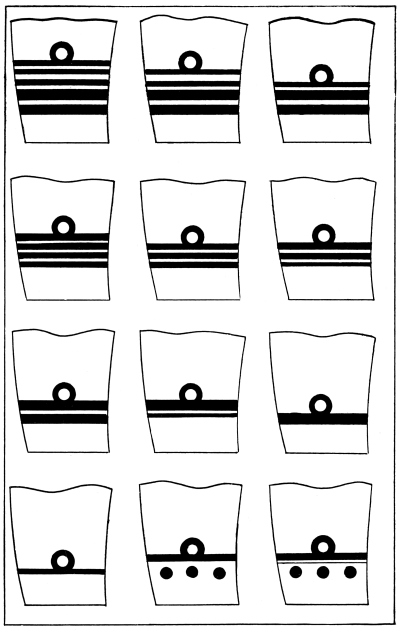
Japanese Navy. Officers’ sleeve decorations indicating rank
| 1. Admiral |
2. Vice Admiral |
3. Rear Admiral |
| 4. Captain |
5. Commander |
6. Lt. Commander |
| 7. Lieutenant |
8. Sub Lt., 1st Class |
9. Sub Lt., 2nd Class |
| 10. Midshipman |
11. Warrant Officer, Line |
12. Warrant Officer, Engineers |
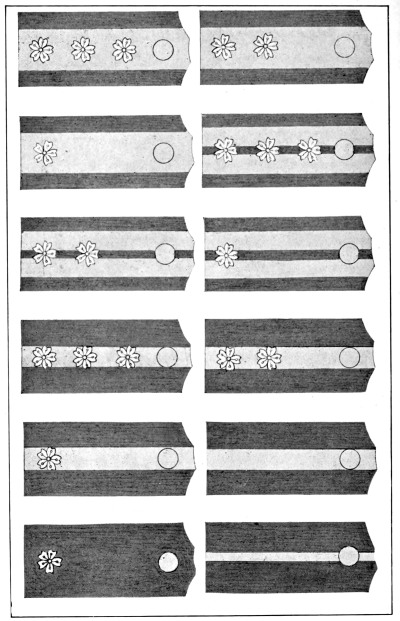
Japanese Navy. Officers’ shoulder straps showing rank,
summer service uniform
| 1. Admiral |
2. Vice Admiral |
| 3. Rear Admiral |
4. Captain |
| 5. Commander |
6. Lt. Commander |
| 7. Lieutenant |
8. Sub Lt., 1st Class |
| 9. Sub Lt., 2nd Class |
10. Chief Warrant Officer |
| 11. Warrant Officer |
12. Midshipman |
[Pg 263]
The rank or rating of enlisted men who are petty officers or who are
assigned to special duties is shown by distinctive marks worn on the
left sleeve of the coat or overshirt; the principal ones being:—
| Seaman |
An anchor. |
| Writers |
A writing brush. |
| Hospital Corps |
A pair of forceps. |
| Firemen |
A double pipe spanner. |
| Carpenter’s Mate |
An axe. |
| Stewards |
A key. |
| Musicians |
A lyre. |
Uniforms of the Austrian Army
The Army of Austria-Hungary is made up of so many different races
and peoples each of whom have preserved something of their original
national dress or uniform in their modern dress uniforms that the
varieties in color, design and ornamentation are greater than in any
other country.
The field service uniform of all however is nearly the same and is made
of light gray cloth.
The officers’ service uniform consists of a single-breasted sack coat
with a standing collar, closed by a row of buttons down the front
concealed beneath a flap and having shoulder straps, patch pockets with
button flaps, one on each breast and one on each side below the waist;
breeches of the same color as the coat; leather puttees and shoes; and
a cap of gray cloth, cylindrical in shape with a soft top to the crown
and side flaps which are folded up around the band and secured by two
buttons in front, and having a sloping visor covered with the gray
cloth of the cap. This cap, known as a tschapka, is a distinguishing
feature of the Austrian uniform.
[Pg 264]
As variations of the field uniform the Hungarian regiments do not wear
leggings but have the trousers tight below the knees; the Alpine troops
wear heavy tan colored stockings instead of leggings and the Bosnia
troops wear a Turkish fez instead of the gray cap.
The rank of officers is indicated by insignia worn upon each side of
the collar. A Field Marshal has gold embroidery on the collar at each
side of the neck opening and two wide red stripes down the outer leg
seams of the trousers. General officers wear similar gold braid on the
collar with the grade of rank indicated by silver stars thereon as
follows:—
| General |
Three silver stars. |
| Lieutenant General |
Two silver stars. |
| Major General |
One silver star. |
Field officers have gold or silver braid on the collar according to
whether their buttons are of silver or gold. On gold braid they wear
silver stars and on silver braid gold stars to indicate the grade of
rank, as follows:—
| Colonel |
Three stars. |
| Lieutenant Colonel |
Two stars. |
| Major |
One star. |
Company officers have the collar decorated with cloth on each side of
the neck opening, the color being the distinctive color of their arm of
the service or regiment. The grade of rank is indicated by stars worn
on this colored cloth, the stars being of silver or gold to match the
gold or silver buttons worn according to the regiment:
| Captain |
Three stars. |
| First Lieutenant |
Two stars. |
| Second Lieutenant |
One star. |
[Pg 265]
The arm of the service is indicated by the color of the facings or
decorations on the uniform. The infantry have no regimental numbers
on their uniforms but a distinctive color for each group of four
regiments, each such group of the regular army having two Austrian and
two Hungarian regiments, the Austrian regiments wearing silver buttons
and the Hungarian regiments gilt buttons.
Chasseur regiments wear green facings or trimming and have the number
of the regiment on the buttons.
Dragoon regiments have distinguishing colors worn on the collars for
each two regiments, one regiment of each color wearing silver buttons
and the other gilt buttons.
Hussar and Uhlan regiments of cavalry have distinctive colors for each
two regiments as in the case of dragoon regiments but these colors are
also worn on the caps and the number of the regiment also appears on
the cap.
Artillery regiments have red facings and the buttons bear a gun
and a shell.
In the Austrian Reserves the infantry have green facings and trimmings
on their uniforms and the number of the regiment on the buttons and
shoulder straps, and the cavalry regiments have the regimental number
on the buttons only.
In the Hungarian Reserves the infantry regiments wear the regimental
number in dark gray cloth on the sides of the cap and the cavalry
regiments wear their number in yellow cloth on the cap.
The rank of noncommissioned officers is indicated by white stars of
celluloid worn on the distinctive color patches of the collar, as
follows:—
[Pg 266]
| Sergeant Major |
Three white stars. |
| Sergeant |
Two white stars. |
| Corporal |
One white star. |
With service uniform officers wear tan leather belts with suspender
straps across one or both shoulders and the enlisted men wear belts and
cartridge boxes of tan leather. General and Staff officers wear the sword
slung from a belt beneath the coat and a sash of gold and black silk.
The overcoat for officers is a double-breasted ulster with gilt or
silver buttons the same as worn on the service coat and collar patches
and pipings of the distinctive corps or regimental color; or a long
circular cape cloak with a turn-over collar upon which the color
patches are worn.
The overcoat of the enlisted man is a double-breasted long ulster with
standing-falling collar, buttons of silver or gilt to match those worn
on the service coat and color patches on the collar.
Enlisted men wear the trousers tucked into the tops of the shoes or in
the case of the Alpine troops into the tops of heavy woolen socks of
khaki color.
A distinctive feature of the Alpine troops is a small plume of eagle’s
feathers worn on the left side of the cap.
Various insignia to indicate special duties or assignments are worn by
enlisted men upon the left sleeve, some of them being:—
| Telegraphist |
A wreath surrounding a device representing three bolts
of lightning crossed with a crown above them. |
| Medical Corps |
A circle surrounding a Geneva cross in red. |
| Gun pointer |
Two cannon crossed surmounted by a crown surrounded by a wreath. |
| Pioneer |
A medallion bearing a pick and two spades crossed. |
| Wagon driver |
A wreath surrounding two horses’ heads. |
[Pg 267]
In the trenches steel trench helmets of the German pattern are worn by
both officers and enlisted men.
In very cold weather fur coats are worn and in the snows of the
mountains white coats are worn to make the troops less conspicuous.
Enlisted men wear on the left sleeve a triangle of yellow braid to show
long service, one stripe for four years, two stripes for seven years
and three stripes for nine years.
Uniforms of the Austrian Navy
The uniforms of the officers and enlisted men of the Austrian Navy are
of dark blue cloth for winter wear and of white duck for hot weather
and are generally similar to those worn in the British Navy.
Commissioned officers are provided with special full dress, full dress,
undress, blue service, white service and white mess uniforms.
The special full dress uniform (gala dress) consists of a cocked
hat of the same shape as the one worn in the United States Navy but
having more gold braid on it; a short double-breasted frock coat with
a standing collar; epaulets; dark blue trousers with gold stripes
down the outer leg seams; a sash belt of black cloth with interwoven
horizontal gilt stripes and a knot and tassels of gold on the right
hip; and black shoes. The collar of the coat and the cuffs are trimmed
with gold lace braid, the sword is worn suspended by slings from a belt
worn beneath the coat, and the rank of the officer is indicated by
insignia worn upon the collar and upon the tops of the epaulets.
[Pg 268]
The full dress consists of the cocked hat; a double-breasted frock coat
with turn-down collar and notched lapels; epaulets; trousers the same
as for the special full dress; and black shoes. The sash belt is also
worn with this uniform.
The undress uniform consists of a bell-crowned cap of dark blue cloth
with a black mohair braid band, sloping visor of black patent leather,
gold chin strap above the visor and the rank indicated by narrow gold
stripes around the black band; the frock coat worn without epaulets;
plain dark blue trousers and black shoes. White trousers and a cap with
the upper portion of the crown white are some times worn with this
uniform. The sash belt is not worn with this uniform, the sword being
suspended by slings from a belt worn beneath the coat.
The blue service dress consists of the blue or white cap; a square cut
double-breasted sack coat similar to that worn in the British Navy;
plain trousers of dark blue cloth or white duck, and black shoes. When
on duty with troops ashore the sword belt is worn outside of this coat.
The white service uniform consists of a white cap or white helmet; a
white coat with shoulder straps of the same design as the white service
coat worn by the United States naval officer except that there is a
patch pocket with flap and button on each side below the waist. When
under arms the sword is worn suspended by slings from a belt beneath
the coat and the gold and black sash belt is worn outside of the coat.
The mess uniform consists of a white mess jacket upon which the
shoulder straps are worn; a white waistcoat; dark blue plain trousers,
and black shoes. There is no blue mess jacket and no evening dress coat.
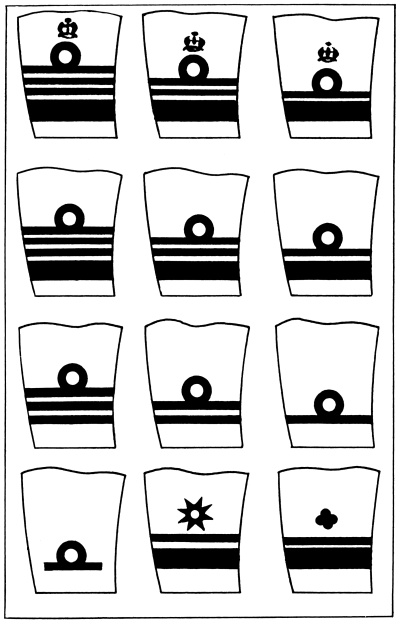
Austrian Navy. Officers’ sleeve decorations indicating rank
| 1. Admiral |
2. Vice Admiral |
3. Rear Admiral |
| 4. Captain |
5. Commander |
6. Senior Lieutenant |
| 7. Lieutenant |
8. Sub Lieutenant |
9. Midshipman |
| 10. Naval Cadet 11. Surgeon General |
| 12. Staff Officer with rank of Rear Admiral |
[Pg 269]
With the frock coat uniforms a plain black silk necktie is worn tied in
a flat double-bow knot.
The rank is indicated on the frock coat and upon the blue service coat
by stripes of gold lace upon the sleeves above the cuff. In the case of
officers of flag rank a gold Austrian Imperial crown is worn above the
stripes. These stripes for the different grades of rank are shown in
the accompanying illustration.
On the white service coat the rank is indicated by stripes upon the
shoulder straps in the same manner as in the United States Navy, these
stripes being of the same number, widths and arrangements as upon the
sleeves of the frock and service coats.
The corps or branch of the service to which an officer belongs is
indicated by the “curl” in the upper stripe of the rank stripes upon
the sleeve and shoulder strap, and by stripes of colored silk between
the gold rank stripes for the different Staff corps. These distinctive
colors for the different corps or branches are:—
| Engineers |
Gray. |
| Medical officers |
Black. |
| Naval Constructors |
Crimson. |
| Paymasters |
Light blue. |
| Professors |
Dark blue. |
White gloves are prescribed for all uniforms. |
Medical officers of flag rank wear an eight-pointed gold star above
the rank stripes on the sleeves, other Staff officers of flag rank
wear a four-circle rosette there, and Medical officers wear as a
distinctive device on the shoulder strap over the rank stripes the rod
of Esculapius entwined with a serpent in silver.
Midshipmen at the Naval Academy wear a dark blue double-breasted
[Pg 270]
round-about jacket with a turn-down collar and two rows of gilt buttons
down the front, a straight visored blue cap, dark blue trousers and
black shoes, for dress and a uniform similar to that worn by the
seamen, for work and drills.
Chief Warrant officers and Warrant officers wear dress and service
uniforms like those of commissioned officers, and Chief Petty officers
wear similar uniforms to those of Warrant officers except that the
specialty or branch marks are worn on the sleeves between the elbow
and the shoulder. The rank of Chief Warrant officers, Warrant officers
and Chief Petty officers is indicated by gold stripes upon the sleeves
above the cuffs as follows:—
| Chief Warrant officer |
Three one-half inch stripes. |
| Warrant officer |
Two one-half inch stripes. |
| Chief Petty officer |
One stripe three-sixteenths of an inch wide. |
The uniforms of the enlisted men are of the usual sailor cut common
to the navies of most naval powers. The blue uniform consists of a
dark blue flat cap with the name of the ship in gilt upon a cap ribbon
around the band; a loose jumper worn over a tight jersey, and trousers
of the sailor cut with wide spring at the bottoms of the legs. The
white uniforms consist of a white flat cap, white duck jumper and white
trousers.
The rating is indicated by stars in the corners of the wide collar.
These stars are of a material resembling celluloid and first class
petty officers wear three such stars in each corner of the collar,
second class petty officers two stars and first class seamen one star.
The branch of the service or the special duty detail of an enlisted man
is indicated by a specialty mark worn on the left sleeve midway between
[Pg 271]
the elbow and the shoulder, petty officers wearing a crown above the
specialty mark, these marks being as follows:—
| Deck force |
A vertical foul anchor. |
| Engineroom and Fireroom force |
A three-bladed propeller. |
| Quartermasters (Wheelmen) |
An anchor with a steering wheel on the shank. |
| Writers |
Two swords crossed. |
| Torpedomen |
An anchor with a bursting bomb on the shank. |
| Gunnery force |
An anchor with two cannon crossed on the shank. |
| Radio men |
An anchor with bars of zig-zag lightning across the shank. |
| Mining force |
A ship’s anchor with a mine anchor crossing it. |
| Band musicians |
A lyre. |
| Hospital attendants |
A Geneva cross. |
| Cooks and stewards |
Two blades of wheat crossed. |
For Chief Petty officers these specialty marks are in gold embroidery
and for others in yellow for blue coats and jumper shirts and for all
ratings they are in black for white coats and jumpers.
Aviation pilots, both officers and men, wear the aviation insignia on
the right breast. This insignia is of silver and consists of a wreath
of leaves surmounted by an Imperial crown with a spread eagle across
the wreath.
Uniforms of the German Navy
The uniforms of the officers and men of the German Navy are made of
dark blue cloth for winter wear and of white duck for hot weather as in
other navies and in general they follow the lines of other navies, but
[Pg 272]
there are several distinctive features. The officers have no special
full dress coat with the cutaway skirts or swallow-tail effect, a frock
coat taking its place; and the enlisted men have in addition to the
ordinary sailor shirts with the wide falling collar a dress jacket
reaching to the waist line and roached over the hips like the jackets
of the American midshipmen. This jacket has a row of small buttons down
each side of the front and also on each cuff and is worn unbuttoned
with the falling collar of the shirt outside of it.
The commissioned officers have full dress, dress, blue service and
white service uniforms.
The full dress uniform consists of a cocked hat similar to that worn
by British naval officers; a long double-breasted frock coat; trousers
with gold lace stripes down the outer leg seams; black shoes; a sword
belt covered with silver and gold lace with a wide red stripe running
through it, and epaulets or shoulder knots depending upon the rank and
corps of the officer. A distinctive feature of this full dress frock
coat is that while it has a standing collar trimmed with gold lace, the
front is provided with wide triangular lapels covered with color facing
indicating the corps or branch of the service to which the wearer
belongs.
The dress uniform consists of a bell-crowned cap of dark blue cloth
with a braid of the distinctive corps around the band and a distinctive
insignia on the front; a frock coat like that of the British or
American naval officer; with which shoulder knots are worn; plain dark
blue trousers, and black shoes. With this uniform the same sword belt
is worn as with the full dress but instead of the sword a short sword
or dirk is worn. As a variation of this uniform the cocked hat is
sometimes worn with it for special occasions.
[Pg 273]
The blue service uniform consists of the blue cap; a double-breasted
square cut sack like that worn by British officers; plain dark blue
trousers, and black shoes. A plain black double-bow knot tie is worn
with this uniform.
The white service uniform consists of a white cap of the same design
as the blue cap but with a black band and black visor as in the United
States and British navies; a white single-breasted sack coat with
standing collar, a patch pocket on the left breast and a patch pocket
on each side below the waist; white trousers, and black or white
shoes depending upon the occasion. The dirk is worn with this uniform
suspended from a black leather belt worn beneath the coat. Shoulder
straps showing the rank are worn on the white service coat.
The overcoat is a long double-breasted coat cut to fit the figure,
buttoning to the neck, with a wide falling collar and an outside pocket
with flap on each side below the waist. It is closed by gilt buttons,
one row down each side.
Following the universal military custom, the rank of German naval
officers is indicated on the blue uniforms by stripes worn upon
the sleeves of the coat just above the cuff. The number, width and
arrangement of these stripes are shown in the accompanying
illustration.
On the full dress coat sleeves there is a vertical three-pointed strap
on the outside over the rank stripes, its color being the distinctive
color for the corps to which the wearer belongs.
The rank is also indicated by insignia upon the tops of the epaulets
and shoulder knots. The tops of the epaulets are of the distinctive
colors of the corps except those for officers of the Line which are of
gold. The lower grade in each branch has no fringe of bullion on the epaulets.
[Pg 274]
The stripes indicating the rank of officers of the Line are sewn
directly upon the cloth of the coat sleeves and have a German Imperial
crown above the upper stripe. Officers of the Staff corps do not wear
the crown above their rank stripes. The corps or branch of the service
to which officers of the Staff corps belong is indicated by stripes of
colored cloth worn between the stripes indicating the rank, and the
distinctive colors are:—
| Engineer officers |
Black. |
| Gunnery officers |
Dark gray. |
| Torpedo officers |
Dark gray. |
| Medical officers |
Dark blue. |
| Naval Constructors |
Black. |
| Paymasters |
Light blue. |
| Legal Department officers |
Red. |
| Pilot officers |
Light gray. |
| Dockyard Construction officers |
Black. |
The insignia worn upon the cap for commissioned officers is a gold
wreath surrounding a circular emblem made up of concentric circles of
red, white and black (from the center out) and surmounted by the German
Imperial crown. This medallion is also worn upon the center of the
front of the enlisted men’s flat caps.
These distinctive corps colors are also worn as the “facings” on the
full dress uniforms, that is on the lapels of the coat and on the
three-pointed straps on the cuffs, and around the band of the service
cap, blue and white, except that pilots wear a gold band on the cap.
Warrant officers in the German Navy wear a dress uniform and a
service uniform both blue and white similar in design to that worn
by commissioned officers, with their distinctive rank stripes on the
sleeves and on the shoulder straps.
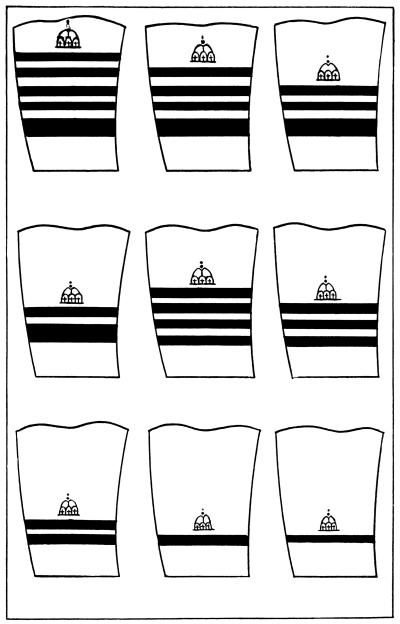
German Navy. Officers’ sleeve decorations indicating rank
| 1. Grand Admiral |
2. Admiral |
3. Vice Admiral |
| 4. Rear Admiral |
5. Captain |
6. Commander |
| 7. Senior Lieutenant |
8. Junior Lieutenant |
9. Sub Lieutenant |
[Pg 275]
In the German Navy there is a rank intermediate between that of Warrant
officers and Chief Petty officers which has no counterpart in the
American Navy. This is called Feldwebel. His dress uniform is a blue
cap; a short dark blue jacket with rolling lapel collar and a row of
small gilt buttons down each side of the front; a blue waistcoat with
gilt buttons, and plain dark blue trousers; and his service uniforms,
both blue and white, are similar to those of other officers. On the
cuffs of the dress jacket he has three narrow gold stripes around the
sleeve close together and below them three similar stripes around the
sleeve and continuing down the outer seam to the bottom edge of the
sleeve, with a vertical strap of dark blue cloth across the stripes
with six small gilt buttons on it.
The Bandmaster is a Warrant officer and the distinctive mark of his
rank is a gold lyre on the center of his shoulder straps.
The uniforms of the enlisted men are the dress or “parade” uniform, the
service uniform and the white uniform.
The dress uniform consists of a sailor flat cap; a white sailor shirt
with wide dark blue falling collar; the dark blue dress jacket worn
with the collar of the shirt outside of it, and dark blue trousers, the
trousers being cut without the wide “spring” or flare at the bottom of
the legs so common in other navies.
The blue cap is similar to that worn in other navies but the crown is
higher in the front than in the back, which tends to give it a military
appearance. The name of the ship or station is worn upon a cap ribbon
around the band of the cap, the ends of the ribbon being tied at the
back and allowed to fall down the back in streamers. Upon the front of
[Pg 276]
the crown at the center is the red, white and black medallion, the
colors of Germany.
The collar of the shirt has three rows of narrow white braid around the
edges as in the American and British navies.
The service uniform consists of the blue cap; a dark blue shirt similar
to that worn in the American Navy, and dark blue trousers.
The white service uniform is of the same design but of white duck
instead of dark blue cloth or flannel.
The rank or rating and the branch of specialty is indicated by
distinctive marks worn upon the left sleeve between the elbow and the
shoulder. Some of the principal of these marks are:—
| Feldwebel |
A vertical gold anchor with a gold crown above it. |
| Chief Quartermaster |
Two gold anchors crossed with a crown above them.
(If certified he wears a red chevron of one stripe below the mark.) |
| Quartermaster |
Two gold anchors crossed. |
| Chief Boatswain’s Mate |
A vertical gold foul anchor with a crown above it. |
| Boatswain’s Mate |
The same without the crown. |
| Chief Gunner’s Mate |
A vertical foul anchor with two cannon crossed
upon it surmounted by a crown, in gold. |
| Gunner’s Mate |
The same without the crown. |
| Chief Machinist’s Mate |
A vertical anchor with a cog wheel
on the shank and a crown above it, in silver. |
| Machinist’s Mate |
The same without the crown. |
| Chief Stoker’s Mate
[Pg 277] |
A vertical anchor with two shovels crossed on the
shank and a crown above it, in silver. |
| Stoker’s Mate |
The same without the crown. |
| Chief Torpedoist’s Mate |
An anchor and a mine crossed with a crown above it, in gold. |
| Torpedoist’s Mate |
The same without the crown. |
| Chief Radio Operator |
A vertical anchor with a crown above it, in gold, with a
zig-zag of lightning in red across the shank of the anchor. |
| Radio Operator |
The same without the crown. |
| Telegraphist |
Two bars of forked lightning crossed, in gold. |
| Chief Signal Mate |
A vertical anchor with a crown above it, in gold, and two
signal flags in red crossed on the shank of the anchor. |
| Signal Mate |
The same without the crown. |
| Drill Sergeant |
A vertical anchor with two rifles
crossed on the shank and a crown above it, in gold. |
| Drill Corporal |
The same without the crown. |
| Leading Seaman |
A yellow chevron of one stripe, point down. |
| Bandsman, first class |
A chevron of two stripes with a curl at the point of the upper
stripe and an anchor surcharged by a lyre above it, in gold. |
| Second Leader of Band |
The same with a crown above it. |
| Gun Captain, first class |
A flaming shell above a chevron of three stripes, point down, in red. |
| Gun Captain, second class |
The same but with two stripes in the chevron. |
| Gun Captain, third class |
The same but with one stripe in the chevron. |
| Machine Gun Captain |
The same without the chevron. |
| Range Finder |
A triangle with a flaming shell in the center and a
range finding instrument above it, in red. |
| Submarine Mine Planter |
A submarine mine in red. |
(The Gun Captains, Range Finders, and Mine Planters
of the Marine Artillery, who man the coast defense
guns, wear the same rating marks in yellow. In
Germany the coast defenses, forts and batteries are
manned by the Navy and not by the Army as in the United States.) |
[Pg 278]
The overcoat worn by enlisted men of the German Navy is a short double
breasted pilot coat with turn-down lapel collar and a double row of
gilt service buttons down the front.
For service ashore in landing parties and when on duty at the coast
forts in hot weather or tropics, a khaki helmet is worn instead of the
white hat with white uniforms and khaki canvas leggings are also worn.
For landing parties as infantry or artillery black leather boots are
worn with the blue uniforms, the trousers being tucked inside of the boots.
Uniforms of German Marines
The German Marines are a part of the Navy and are divided into Marine
Infantry and Marine Field Artillery. They perform duties similar in
many respects to the duties of the United States Marine Corps.
The full dress uniform of the officers consists of a black shako with
a large red plume which falls over the front down to the visor; a blue
single-breasted tunic with standing collar; epaulets without bullion
fringes; breeches of the same color, and black boots. The front edges
of the coat and the tops and bottoms of the collar are piped with white
cloth and the cuffs are of white cloth with a vertical strap.
The service uniform is of gray cloth and consists of a bell-crowned cap
with a white band and sloping visor of black leather; a single-breasted
coat with a standing turn-over collar closed by buttons down the front
[Pg 279]
concealed by a fly; breeches, and leggings and shoes of tan leather.
The coat has a pocket with flap on each side below the waist. Shoulder
straps are worn with the service coat.
The rank of the officer is indicated by insignia worn upon the epaulets
and shoulder straps, the insignia being the same as for the German Army
officers.
For hot weather a uniform of khaki cotton drill is provided, the
general style being the same as for the cloth service uniform except
that the head dress is a khaki-colored helmet.
The dress uniform of the enlisted men is similar in color and design
to that worn by the officers, the epaulets being replaced by shoulder
straps of white cloth. The service uniform of the enlisted men is of
the same design as that for officers except that the coat is closed by
a single row of gilt buttons and the cap has no visor.
Uniforms of the German Army
The peace time uniforms of the various corps and arms of the German
Army present a great variety, the traditions of the services of the
former separate kingdoms and political divisions that are now united
to form the German Empire being preserved in many instances in the
color and design of the uniform or in the bright metal decorations and
insignia.
Many of these uniforms are gaudy in color and richly decorated with
gold, silver and colored cloth and braid ornaments.
The facings colors worn upon the collars and cuffs and as pipings on
the coats and trousers often vary with the individual regiments, and
the headdress is in many shapes and colors.
[Pg 280]
The Line Infantry wear a black helmet with brass spike, Prussian eagle
and scale chin strap; a blue single-breasted tunic with gilt buttons,
and dark gray trousers; the facings and piping being red, but the
infantry regiments of Saxony, Bavaria, Wurttemburg and some other
states have variations from this in both color and design.
The Uhlans wear the Czapka helmet; a blue double-breasted tunic with
a red plastron front and red facings; and dark gray trousers; the
Prussian Hussars wear a black fur busby with heavy gilt decorations
and a bag of the distinctive color of the facings, a single-breasted
blue tunic heavily decorated with white braid, loops and frogs; a blue
pelisse with white braid decorations slung from the left shoulder; dark
gray tight fitting breeches with white braid decorations, and black
Hessian boots with embroidered tops.
The Prussian Cuirassiers wear white uniforms with black hip boots and
cuirasses of brass or iron, the iron being black for some regiments and
bright for others.
The Saxon Jager regiments wear uniforms of green cloth and a cap with a
feather plume.
The Prussian Dragoon regiments wear helmets with drooping white plumes,
light blue jackets, dark gray breeches.
The Field Artillery regiments usually wear black helmets with a spike
ending in a brass ball; dark blue coats with gilt buttons, dark gray
breeches and black boots.
There are many other distinctive uniforms and the varied colors,
bright trappings and decorations and waving plumes made a peace time
assemblage of German troops of all arms a most imposing sight; but
early in the present century the leaders realized that while all this
gaudy panoply and pomp added to the attractiveness of the service, kept
[Pg 281]
alive the traditions of the past, and aided in holding the esprit de
corps, it would not do for service on the modern battlefield, where the
troops must be as inconspicuous as possible to avoid annihilation under
the drum fire of artillery and the rapid fire of machine guns.
As a result a field service uniform of a dull gray color was adopted
for all arms but it was not generally issued to the troops until just
before the opening of the present world war.
The German officer’s field service uniform consists of a gray single
breasted sack coat with a standing turn-over collar; breeches of the
same color and black or tan leather boots. With this uniform the
old bright helmets are worn with a gray cover to make them less
conspicuous, or in many cases a gray cap with sloping visor is worn.
The buttons are of gilt allowed to become dull in the field, in some
cases of leather or bone, and in other cases the coat is closed by
buttons concealed beneath a fly.
The corps and regimental colors are worn in small patches on the collar
at each side of the neck opening and also as cuff stripes in some corps.
In some corps the distinctive color is also worn around the cap band.
The rank of the German officer is indicated by the braid and insignia
on flat shoulder straps covered with braided cord. The shoulder strap
for Field Marshal and for General officers is covered with a plaited
knot made up of five loops of sets of three cords, the two outer
cords being gold and the central cord being silver interwoven with
the imperial colors in silk. The shoulder straps for Field officers
(Colonels, Lieutenant Colonels and Majors) are of the same design
except that the cords are in sets of two, both of silver interwoven
[Pg 282]
with the silk colors. The shoulder straps of the company officers are
covered with parallel rows of silver cord interwoven with the silk colors.
The insignia of rank worn upon the shoulder straps on top of the cord
decorations are diamond shaped ornaments of gilt metal, and although
they do not have the conventional shape of a star they are called stars
in the German service.
These insignias are as follows for the various grades of rank:—
| Field Marshal |
Two gold batons crossed. |
| Colonel General |
Three stars. |
| General |
Two stars. |
| Lieutenant General |
One star. |
| Major General |
No insignia, the shoulder strap knot being plain. |
| Colonel |
Two stars. |
| Lieutenant Colonel |
One star. |
| Major |
No insignia. |
| Captain |
Two stars. |
| First Lieutenant |
One star. |
| Second Lieutenant |
No insignia. |
There is no corresponding rank in the armies of other nations for the
German rank of Colonel General, and in the German Army there is no rank
of Brigadier General.
In the German Army a Feldwebel is an officer between the commissioned
officers and the enlisted men, his rank corresponds to that of the
Warrant Officers in the United States Navy and Marine Corps. He wears
a double cord upon the shoulders and his rank insignia is a circular
medallion with a Prussian eagle on each side of the collar.
The German officer’s overcoat is a heavy ulster of the same gray color
as the field uniform; it is double-breasted and the rank of the wearer
is indicated by the shoulder straps as in the case of the service coat.
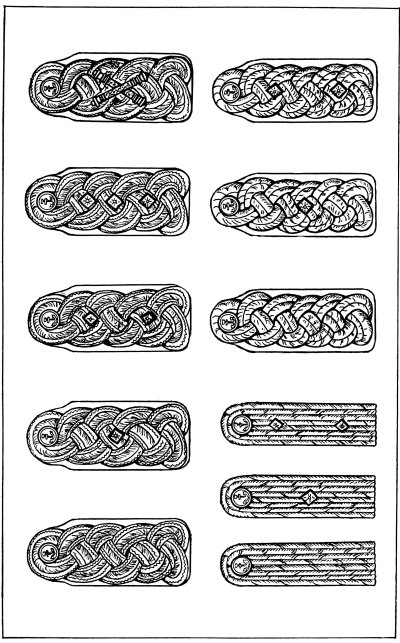
German Army. Officers’ shoulder strap insignia indicating rank
| 1. Field Marshal |
6. Colonel |
| 2. Colonel General |
7. Lieutenant Colonel |
| 3. General |
8. Major |
| 4. Lieutenant General |
9. Captain |
| 5. Major General |
10. First Lieutenant |
| |
11. Second Lieutenant |
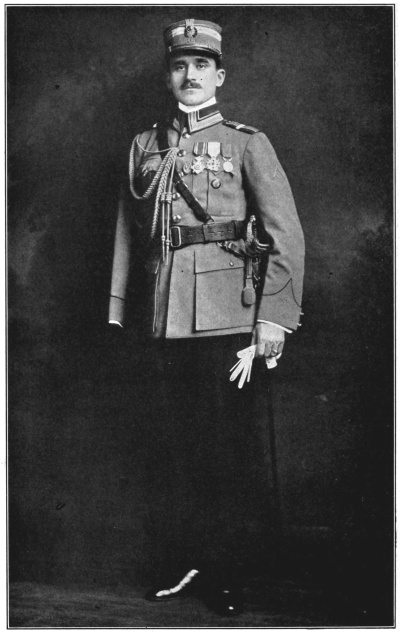
Photo. Harris & Ewing, Washington, D. C.
Roumanian Army. Officers’ service uniform
[Pg 283]
The enlisted men of the German Army wear a service uniform of the same
color and general design as that of the officers. The ordinary field
cap is a round loose crowned cap without visor, the coat is a single
breasted sack with a standing turn-over collar, and the trousers are of
the same gray cloth as the coat. Boots of black or tan leather are worn.
Noncommissioned officers wear a stripe of braid around the cuff and
the front edges of the collar at the neck opening and for a short
distance along the top of the collar back from the neck opening. A
Sergeant Major wears a stripe of narrow braid above the noncommissioned
officer’s sleeve stripe.
The enlisted men’s overcoat is a heavy ulster buttoning to the neck
with a standing-falling collar, the rank of noncommissioned officers
being indicated by the sleeve braid as for the service coat and by
patches of color at the front of the collar.
Steel trench helmets are worn in the trenches by both officers and
men, this helmet being larger than that worn by the American, British
and French troops and having a flaring extension at the rear for the
protection of the neck.
Uniforms of the Roumanian Army
The dress and service uniforms of the Roumanian Army are very similar
to those of the Austrian Army and the field uniform is of khaki-colored
cloth with the facings, pipings and rank insignia of the dress uniforms added.
[Pg 284]
Foreign War Decorations and Medals
The multiplicity of medals and decorations in all foreign countries
makes it very difficult to distinguish one from another, especially
since the designs and ribbons used by different countries are
frequently quite similar. To describe all of these decorations is not
practicable within the scope of this volume, but a few of the ones
which are classed as distinctively war decorations are included as they
are the ones most commonly seen and talked about.
French War Medals.—The French decorations given for war service are
the Legion d’honneur (Legion of Honor), the Medaille Militaire
(Military Medal) and the Croix de Guerre (War Cross).
The Legion of Honor was inaugurated by Napoleon I at Les Invalides
on July 15, 1804, and the medals and ribbons were bestowed upon both
soldiers and civilians. The medal consists of a white star with five
double rays; the center of the star, surrounded by a wreath of oak and
laurel, bearing on the obverse the head of the Republic surrounded
by the words, “République Française, 1870,” and on the reverse two
tri-colored flags with the words, “Honneur et Patrie.” Above the star
is a small gold wreath and the ribbon is red.
The Medaille Militaire, created by Prince Louis Napoleon in January,
1852, may be bestowed upon Generals and Admirals who have been
ministers of the state cabinet or commanders in chief, commanders of
Army Corps who have presided over the Superior Council of War and the
greatest of the war leaders of France. It is of silver, twenty-eight
millimeters in diameter, surmounted by a trophy of arms in silver and
[Pg 285]
suspended by a yellow ribbon with green stripes at the edges. The
obverse of the medal bears the head of the Republic surrounded by the
words, “République Française, 1870,” and the reverse the words, “Valeur
et Discipline.”
The Croix de Guerre, established by law on April 8, 1915, is awarded
to soldiers and sailors of all ranks in the service of France and her
Allies who perform individual acts of gallantry in operations against
the enemy during the present war and are mentioned for such acts in
official despatches. The cross is of Florentine bronze, four-armed
with two crossed swords between the arms, and is surcharged at the
center with a medallion bearing the head of the Republic surrounded by
the inscription “République Française” on the obverse and the dates
“1914-1915” on the reverse side. The ribbon is green with seven narrow
red stripes.
British War Medals.—In Great Britain there are three orders which
may be bestowed upon officers by the King—the Order of the Bath, the
Order of St. Michael and St. George and the Distinguished Service
Order; five crosses or medals which may be awarded to officers or
enlisted men of the land forces—the Victoria Cross, the Military
Cross, the Distinguished Conduct Medal, the Military Medal and the
Meritorious Service Medal; and four crosses or medals which may
be bestowed upon officers and enlisted men of the sea forces—the
Victoria Cross, the Distinguished Service Cross (corresponding to the
Military Cross), the Conspicuous Gallantry Medal (corresponding to
the Distinguished Conduct Medal), and the Distinguished Service Medal
(corresponding to the Military Medal).
Of all of these the one most highly prized by officers and enlisted
men alike both on sea and land is the Victoria Cross, which is awarded
[Pg 286]
individually to an officer or enlisted man of the Navy or Army for some
signal act of valor and devotion to his country in the presence of the
enemy and during action. Whenever it is possible to do so the V. C. is
presented in person by the sovereign.
The Victoria Cross.—This decoration consists of a bronze cross
pattée with raised edges and it was instituted by Queen Victoria in
1856 during the Crimean War. On the obverse of the cross at the center
it is surcharged with a Royal crown surmounted by a lion passant
gardant and below the crown there is a semicircular scroll bearing
the words, “For Valour.” On the reverse side is engraved the date of
its bestowal. The cross is suspended from a ribbon by means of a bar
clasp ornamented with laurel leaves and a link in the shape of the
letter “V,” and the name, rank and regiment or ship of the recipient is
engraved on the reverse side of the clasp. The ribbon is red for the
Army and blue for the Navy.
The Distinguished Service Order.—This order was established in 1886
to reward officers of the military and naval services for meritorious
or distinguished service in the field before the enemy. It is a gold
cross pattée convexed, enamelled white and edged with bright gold.
At the center on one side is a wreath of laurel enamelled in green
surrounding the Imperial crown enamelled in red, and on the other side
at the center a similar wreath surrounding the Royal cypher “G.R.” The
ribbon is red edged with blue.
The Distinguished Service Cross.—This is a plain silver cross pattée
convexed. On the obverse at the center enclosed within a raised circle
is the Imperial cypher “G.R.I.” surmounted by the crown, while the
reverse side is plain. The ribbon is blue, white, blue.
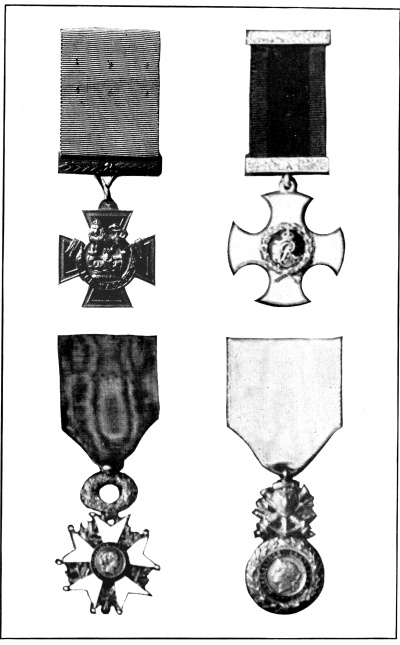
Copyright, Bailey, Banks & Biddle Co., Phila., Pa.
FOREIGN DECORATIONS AND MEDALS
| 1. Victoria Cross, Great Britain |
| 2. Distinguished Service Order, Great Britain |
| 3. Legion of Honor, France |
| 4. Military Medal, France |
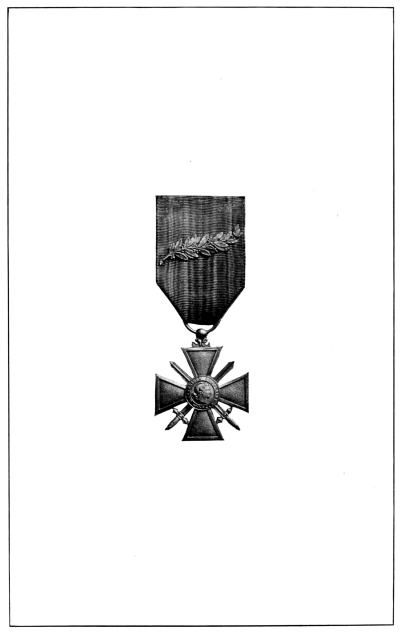
Croix de Guerre (War Cross), France
[Pg 287]
The Conspicuous Gallantry Medal.—The medal, established during the
Crimean War, is of silver, with the effigy of the reigning sovereign
on one side and a laurel wreath encircling the words, “For Conspicuous
Gallantry,” surmounted by a crown on the other side. It is awarded to
Warrant Officers, Midshipmen, Naval Cadets and Clerks in the Royal Navy
for conspicuous gallantry in the presence of the enemy. The ribbon is
blue, white, blue.
The Distinguished Service Medal.—This medal was established October
14, 1914, to reward petty officers and men of the Royal Navy and
noncommissioned officers and men of the Royal Marines for courageous
service in action during the present war. It is of silver and the
obverse bears the effigy of King George V., while the reverse bears a
wreath encircling the words, “For Distinguished Service,” surmounted by
a crown. The ribbon is blue with two narrow white stripes through the
center.
The Military Cross.—This decoration was established in December,
1914, to reward captains, lieutenants and warrant officers of the Army
for deeds of valor or distinguished services in the present war. The
cross is of silver and each arm bears the Imperial crown while at the
center the Imperial cypher “G.R.I.” appears. The ribbon is white, blue,
white.
The Military Medal.—This silver medal was authorized by the King
in March, 1916, to be awarded to officers and enlisted men of the
Army for conspicuous bravery in the field after recommendation by the
commanding general in the field. Its obverse bears the Royal effigy and
the reverse a wreath encircling the words, “For Bravery in the Field,”
[Pg 288]
surmounted by a crown. The ribbon is blue, white, blue, with two narrow
rod stripes through the central white stripe.
Belgian War Medals.—The decorations and medals awarded in Belgium
for war service embrace the Order of Leopold, the Croix Militaire
(Military Cross), the Medaille Militaire (Military Medal), the Ordre
de la Courenne (Order of the Crown), the Order of Leopold II., the
Belgian War Cross and the Medal of Queen Elizabeth.
The Order of Leopold.—This order was instituted by King Leopold
I. in 1832, to “reward services rendered to the country.” It is only
bestowed upon officers of high rank except in very exceptional cases.
It consists of a white enamelled Maltese cross resting upon a green
wreath of oak and laurel, surmounted by two crossed swords and a Royal
crown. On the obverse at the center is a gold lion rampant on a black
circular ground surrounded by the words, “L’Union fait la force.” The
color of the ribbon is Royal purple.
The Belgian War Cross.—This cross is made of bronze and is modelled
after the French Croix de Guerre. It is bestowed upon officers
and men who are mentioned in General Orders for conspicuous acts of
gallantry in the field during the present war. It was established
October 25, 1915.
The Medal of Queen Elizabeth.—This medal, founded by resolution of
September 9, 1916, is bestowed in the name of the Queen upon Belgians
or foreigners who have devoted themselves to war work in Belgium.
Italian War Medals.—In Italy there are four Orders, the Order of
Annunziata, the Order of St. Maurice and St. Lazarus, the Military
Order of Savoy, and the Order of the Crown of Italy; and a number of
[Pg 289]
military and naval medals, including the Sardinian Medal of the Crimea,
the Order of the Thousand of Garibaldi fame, the Medal Commemorating
the Unity of Italy, the Medal of the African Campaign, the Medal of the
Extreme Orient and the Messina Medal, the latter given to those who
distinguished themselves at the time of the Messina earthquake in 1908.
The Order of Savoy.—This military order was founded by Victor
Emmanuel I. in 1815, to reward services in war on land and sea, and its
cross is highly prized. It consists of a white enamelled cross resting
upon an enamelled wreath and surmounted by a gold trophy of arms and
flags. At the center is a cross surrounded by the words, “Al Merito
Militare.” The ribbon is dark blue with a broad red stripe.
The Order of the Crown of Italy.—This order was created in 1868
by Victor Emmanuel II. to reward Italians and foreigners who render
conspicuous services to Italy. The cross is of white enamel resting on
gold scrolls and bears at the center an iron crown. It is awarded to
officers of high rank for services in war.
The Medal for Military Valor.—This medal of two classes, gold and
silver, corresponds to the French Croix de Guerre, and is awarded to
soldiers and sailors for conspicuous acts of gallantry in action in the
presence of the enemy. The gold medal is very rarely bestowed except as
an honor to the memory of a soldier or sailor who has lost his life in
the execution of the deed which the medal commemorates. The ribbon is blue.
Japanese War Medals.—Japan has several orders, the first and best
known one being the Order of the Rising Sun, created in 1876. It is the
great national Japanese order and is divided into eight classes, being
awarded to officials, officers and rarely to civilians. In the military
[Pg 290]
and naval services the first six classes are awarded to officers and
the last two to enlisted men. The decoration consists of a medallion
enshrined a cabochon garnet, placed in the center of eight white
enamelled rays bezelled in gold and silver, and it is suspended from a
gold paulownia leaf. The ribbon is white with narrow red edges.
The Order of the Golden Kite.—This order was founded by Emperor
Mutsuhito in 1891, to reward acts of especial bravery in battle on land
or sea. The decoration consists of a blue enamelled cross surrounded by
clustered rays of red enamel, surcharged upon a silver sword from the
guard of which rises a golden kite. The ribbon is green with a narrow
white stripe near each edge.
In addition to the decorations of the orders there are a number of war
medals in bronze awarded to officers and men for participation in the
campaigns of the war with China and the war with Russia.
War Medals of Germany.—Germany has many orders and medals but the
one best known as a war medal is the Iron Cross, founded in 1813, to
be given to both soldiers and civilians for services to the country.
It was revived in 1870, during the Franco-Prussian War. The decoration
consists of a black iron cross pattée with a silver edge. At the center
is the letter “W”, on the upper arm a crown and on the lower arm the
date 1870 for the crosses awarded in that year and 1914 for those
awarded in the present war. There are three classes in the order, the
size of the cross varying with the class. The ribbon is black with
white stripes near each edge for medals awarded to soldiers or sailors
and the reverse for those awarded to civilians. The Iron Cross has been
lavishly bestowed upon soldiers and sailors in the present war.
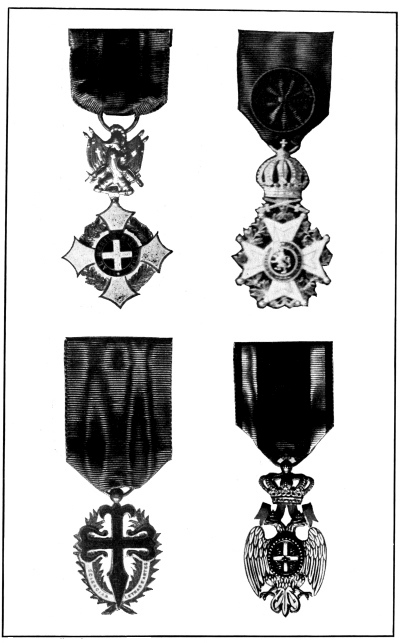
Copyright, Bailey, Banks & Biddle Co., Phila., Pa.
FOREIGN DECORATIONS AND MEDALS
| 1. Military Order of Savoy, Italy |
| 2. Order of Leopold, Belgium |
| 3. Order of St. James of the Sword, Portugal |
| 4. Order of the White Eagle, Serbia |
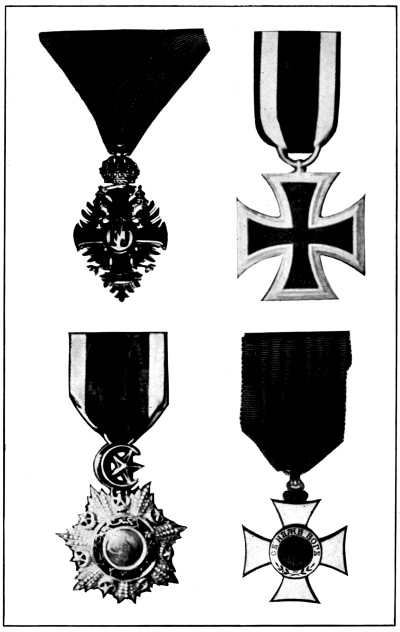
Copyright, Bailey, Banks & Biddle Co., Phila., Pa.
FOREIGN DECORATIONS AND MEDALS
| 1. Order of Francis Joseph, Austria |
| 2. Iron Cross, Germany |
| 3. Order of Medjidie, Turkey |
| 4. Order of St. Alexander, Bulgaria |
[Pg 291]
Austrian War Medals.—Austria has many orders and decorations, the
Order of Francis Joseph being frequently conferred upon high officers
for conspicuous service in war. In addition there are distinguished
service medals of gold, silver and bronze, according to the importance
of the service rewarded, gold and silver medals for bravery in action,
and, for services in war alone, the War Decoration for officers and the
War Medal for enlisted men.
Turkish War Medals.—Turkey has awarded many decorations and medals
upon her own soldiers and sailors as well as upon those of her allies
in different wars and upon citizens of other nations in peace time. The
best known of her orders are the Order of the Medjidie and the Order of
Osmanieh.
The Order of the Medjidie.—The decoration of this order consists of
a seven-pointed star of cut silver, each point being composed of five
rays. Between the points there are seven small crescents and stars and
at the center on a gold background is the Sultan’s cypher surrounded by
a circle of red enamel bearing an inscription in Turkish.
[Pg 292]

SEAL OF THE AMERICAN RED CROSS
CHAPTER XII
UNIFORMS AND INSIGNIA OF
THE AMERICAN RED CROSS
By the terms of the Geneva Convention held at Geneva, Switzerland, in
1864, all hospitals, hospital ships, surgeons, members of the hospital
corps, nurses, chaplains and all persons engaged exclusively with the
removal, transportation and treatment of the sick and wounded in war
are rendered neutral. The emblem used to mark hospitals and ambulances
is the white flag with the red Greek cross in the center as described
on page 62.
Following this Convention Red Cross Societies were established in
[Pg 293]
several countries, taking their name from the red cross on the hospital
flag. The movement has been extended throughout the world and to-day
every civilized country has its Red Cross Society, an International Red
Cross Committee at Geneva being the means of intercommunication between
the different national bodies.
The National Red Cross was founded at Washington, D. C., on October
1, 1881, incorporated under the laws of the District of Columbia and
reincorporated April 17, 1893. Under the name of the American Red Cross
it was finally incorporated in 1905. The original founder was Miss
Clara Barton.
As at present constituted the American Red Cross is officered by a
President, Vice President, Treasurer, Counselor, Secretary-General,
General Manager, and Comptroller; the President being the President
of the United States. There is a Central Committee, consisting of
a Chairman, Vice-Chairman, and one representative from each of the
Departments of State, Treasury, War, Navy and Justice, appointed by the
President; six members elected by the Board of Incorporators, and six
members elected by Delegates. There is an Executive Committee elected
by the Central Committee and a War Council of seven members appointed
by the President.
The War Council announces that the present work of the Red Cross should
contribute to the following aims:—
1. To be ready to care for our soldiers and sailors on duty
wherever and whenever that care may be needed.
2. To shorten the War—by strengthening the morale of the allied
peoples and their armies, by alleviating their sufferings in the period
which must elapse until the American army can become fully effective abroad.
[Pg 294]
3. To lay foundation for an enduring peace—by extending a message
of practical relief and sympathy to the civilian population among
our Allies, carrying to them an expression of the finest side of the
American character.
The war work is divided into two main parts, the principal
purposes of which are summarized by the Council as follows:—
The Work in the United States.—
1. To take such measures as are necessary, in cooperation with the
Army and Navy, for the protection of the health and welfare of soldiers
in camps and cantonments, and of civilians whose welfare is involved in
war conditions.
2. To stimulate and guide the volunteer work of women in the
manufacture of supplies and comforts needed by troops and civilians
abroad and by men in training in this country.
3. To co-operate with the Government and with all relief agencies
in caring for the dependent families of men in the military and naval
service, and to relieve suffering caused by any disaster.
4. To maintain at the lowest cost consistent with efficiency,
machinery to assure the uninterrupted performance of these duties and
of the relief work in Europe.
The Work in Europe.—
1. To do everything possible to assist our Army and Navy in insuring
the health and comfort of American soldiers and sailors abroad.
2. To relieve suffering among the armies and destitution among the
needy civilian populations of our Allies.
The cooperation of the American Red Cross with the medical service
of the Army and Navy consists of recruiting, organizing and equipping
base hospital and other hospital and ambulance units to be called into
service when required by the Army or Navy Medical Corps; handling
special problems of health and sanitation in connection with the
cantonments, camps and naval stations; stimulating the manufacture of
surgical dressings and hospital supplies of all kinds; and promoting
the comfort and welfare of the men in training or en route from their
homes to camps and training stations.
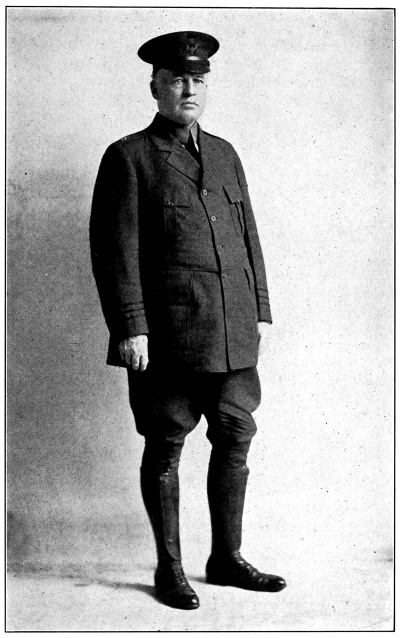
Photo. Harris & Ewing, Washington, D. C.
American Red Cross. Officers’ service uniform
[Pg 295]
When base hospitals and other organizations recruited, equipped and
trained by the Red Cross are taken over by the Army or Navy for active
service they become a part of such service and wear the uniform
thereof; but officials of the Red Cross assigned to duty with the
military establishments to perform such duties as are assigned to them
under the orders of the Secretary of War are required to wear the
regulation uniform and insignia of the American Red Cross as approved
by the War Department. Such officials have the status of officers
in the Army while so serving at the camps and stations and they are
accredited to the Division Commander and are subject to his authority
and to military laws and regulations.
UNIFORMS AND INSIGNIA OF MEMBERS OF
THE AMERICAN RED CROSS FIELD SERVICE
The authorized uniform for the members of the American Red Cross Field
Service is made of cloth or serge of the same color as that used by the
U. S. Marine Corps for winter field uniforms, the shade being a grayish
olive green known as “forestry-green.”
For the officers, Division Directors of Military Relief and Assistants,
Field Directors of Camp Service, Assistant Field Directors of Camp
Service, Associate Field Directors, Hospital Service, Associate Field
[Pg 296]
Directors, Home Service, and other Assistants, the uniform consists
of an overcoat, Norfolk jacket, riding breeches, flannel shirt, black
necktie, field hat or cap, grey gloves, and tan leather shoes and
leggings or tan leather field boots.
The coat is a single-breasted, four-buttoned plain Norfolk jacket, of
forestry-green cloth, having a notch collar and soft lapels, the skirts
extending half way from the point of the hip to the bend of the knee,
with a two-inch belt of the same material as the jacket stitched around
the waist and a vent in the center of the back extending from the belt
to the lower edge of the skirt. The jacket has four outside patch
pockets with a two-inch box pleat down the center and a three-pointed
flap fastened at the center by a small button. On each shoulder there
is a strap of the same material as the jacket, let in at the top of the
sleeve seam and reaching to the edge of the collar where it is buttoned
with a small button, the dimensions of the strap being two inches in
width at the shoulder seam and one inch in width at the collar end,
the collar end being rounded. On each shoulder strap is worn a Greek
cross of red cloth or silk embroidery, the cross being three-quarters
of an inch over all and placed with its center one and one-eighth
inches above the shoulder seam. All of the buttons are plain flat green
buttons matching the color of the jacket. The initials A. R. C. in
plain block letters of bronze are worn on each side of the collar one
inch above the notch in the lapel. The various grades of officers are
shown by stripes of black mohair braid sewn around the lower part of
each sleeve of the jacket.
The breeches are of forestry-green cloth cut loose in the thigh and
tight from the knee down, laced or buttoned below the knee with laces
[Pg 297]
or buttons of the same color as the cloth of the breeches, with strappings
of the same material or of buckskin of a color to match on the inside of
the leg and knee.
The cap is of forestry-green cloth and of the same style and
dimensions as the regulation cap for officers of the U. S. Army, the
band covered with green mohair braid to match the color of the cap, the
visor and chin strap being of dark tan leather and the buttons of plain
bronze. A Greek cross of red enamel is worn on the center of the front
of the cap.
The field hat is the same as that worn by officers of the U. S. Army
and with it the officers of the American Red Cross wear a plain black
hat cord.
The flannel shirt is of the same design as that worn by officers of
the U. S. Army but the color is forestry-green. When the shirt is worn
without the jacket the initials A. R. C. in bronze block letters and a
small enamel red cross are worn on each side of the shirt collar, the
letters being in front. A light weight shirt of madras or cotton of the
same color and style as the flannel shirt may be worn.
The overcoat for officers is a double-breasted sack overcoat of knee
length made of forestry-green cloth. It has a turn-down notched collar
with soft lapels, two horizontal side pockets with straight flaps, and
shoulder straps similar to those on the jacket but slightly larger. On
each of these shoulder straps is worn a Greek cross of red cloth or
silk embroidery. The buttons of the overcoat are plain bone buttons of
a color to match the coat. On each side of the collar one inch above
the notch in the lapel the initials A. R. C. in plain bronze block
letters are worn. The various grades of officers are indicated by stripes
of black mohair braid around the sleeves as in the case of the jacket.
[Pg 298]
The tan leather shoes, leggings and field boots are the same as those
prescribed for the officers of the U. S. Army.
Insignia of Rank.—The grade or rank of the officers of the American
Red Cross is indicated by stripes of black mohair braid on the lower
part of the sleeves of the jacket, overcoat and field shirt. The
stripes on the sleeves of the overcoat and jacket are each one-quarter
of an inch wide, set one-half of an inch apart, extend entirely around
the sleeve and the lower stripe is two inches from the lower edge of
the cuff. The stripes on the sleeves of the field shirt are of the same
width and are set at the same distance apart but instead of encircling the
sleeve they are two inches long and sewn on the outer side of the sleeve.
The number of stripes for the different grades is as follows:—
| Division Director of Military Relief |
4 stripes. |
| 1st Assistant Division Director of Military Relief |
3 stripes. |
| 2nd Assistant Division Director of Military Relief |
2 stripes. |
| 3rd Assistant Division Director of Military Relief |
1 stripe. |
| Field Director of Camp Service |
3 stripes. |
| Assistant Field Director of Camp Service |
2 stripes. |
| Associate Field Director, Hospital Service |
2 stripes. |
| Associate Field Director, Home Service |
2 stripes. |
| Other Assistants |
1 stripe. |
The uniform for personnel of the American Red Cross other than Field
Directors and Assistants consists of an overcoat, Norfolk jacket,
breeches, flannel shirt, black necktie, field hat, sweater, tan leather
shoes, canvas leggings and grey leather or knit gloves. The overcoat,
jacket, breeches and flannel shirt are made of forestry-green after the
same style and design as those already described for the officers, the
sweaters are knit from forestry-green wool, the canvas leggings are
green in color to match the breeches and the field hat is the same as
that prescribed for officers except that no hat cord is worn.
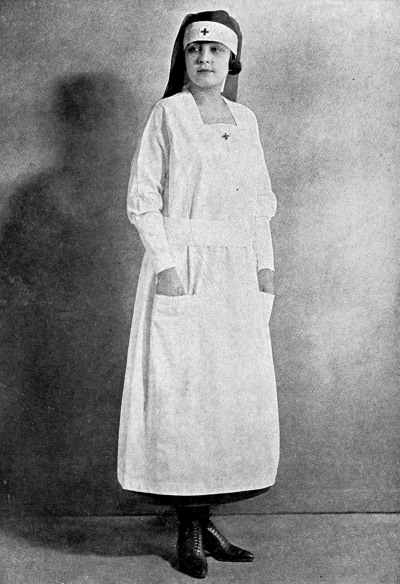
American Red Cross. Workroom uniform with colored veil
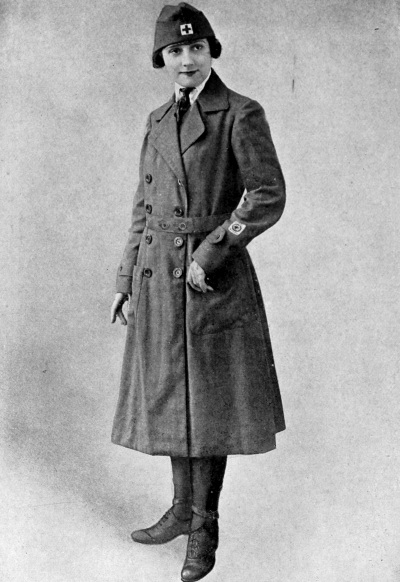
American Red Cross. Motor service uniform
[Pg 299]
A Greek cross of red cloth is worn on both sleeves of the jacket,
overcoat and shirt four and one-half inches above the lower edge of
the cuff, the cross on the jacket and overcoat being one and one-half
inches over all and that on the shirt one inch over all.
The initials A. R. C. in bronze block letters are worn on both sides
of the collars of the jacket and overcoat and the same initials and
a small enamel red cross are worn on both sides of the collar of the
field shirt when it is worn without the jacket, the initials being
placed in front of the red cross.
UNIFORMS AND INSIGNIA FOR RED CROSS WOMEN WORKERS
IN THE UNITED STATES
The American Red Cross has authorized the wearing of distinctive
uniforms by the women workers engaged in the various Red Cross Chapter
activities, other than nursing and hospital service, in order that
these workers may be readily recognized as such throughout the United
States and also for protective and hygienic reasons. The wearing of
these uniforms is optional on the part of any member entitled to wear
them, but as the right to wear them carries with it the assumption of
responsibility for the organization both efficiency and esprit de
corps should be greatly aided by the use of the uniforms.
Permission to wear these uniforms is granted by the executive committee
of each Red Cross Chapter. No person under eighteen years of age is
[Pg 300]
granted permission to wear the Workroom uniform, in the Motor and
Clerical service the minimum age is twenty-one years and in the Canteen
service it is twenty-three years. Everyone before being granted a
permit to wear any of the official Red Cross uniforms is required to
take the Oath of Allegiance to the United States.
DESCRIPTION OF UNIFORMS
Elaborate uniforms have been avoided and as far as possible variety has
been eliminated. To distinguish the different corps of workers an apron
and a “coif” or headdress of different colors have been prescribed. For
workrooms the apron is white, for the canteen service it is blue, and
for the clerical service grey, all being of the same pattern.
Workroom Uniform.—For all workers on surgical dressings,
garments and knitted articles. If it is found desirable to distinguish
the workers in different workrooms, a white arm band or a sash marked
in blue letters “Garments,” “Surgical Dressings,” “Knitting” or
“Comforts” may be worn.
Apron.—A large white apron fastening in the back, with sleeves to
the wrist and a V or square neck. The belt is three inches wide and
there are two pockets in the skirt. A red cross, two inches square, may
be worn in front at the center of the base of the neck.
Coif.—A veil of batiste or similar material, cut one yard long and
one yard wide, with a lower hem one inch broad and a hem at the top two
inches broad and turned back on the outside. The color of the veil is
red, white or dark blue. A band of some stiffer material extends around
the head one-half inch from the front hem and a red cross is worn in
the center of the forehead band.
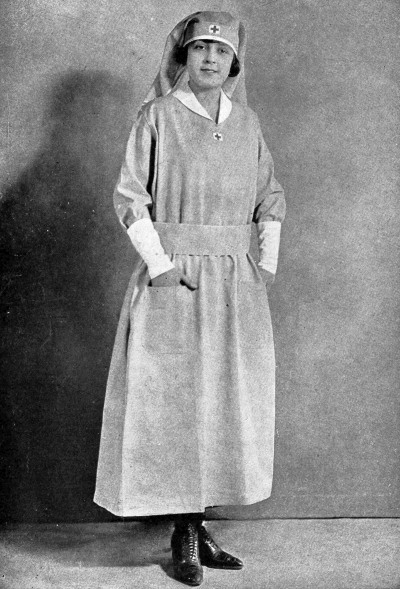
American Red Cross.
Bureau of Information and clerical service uniform
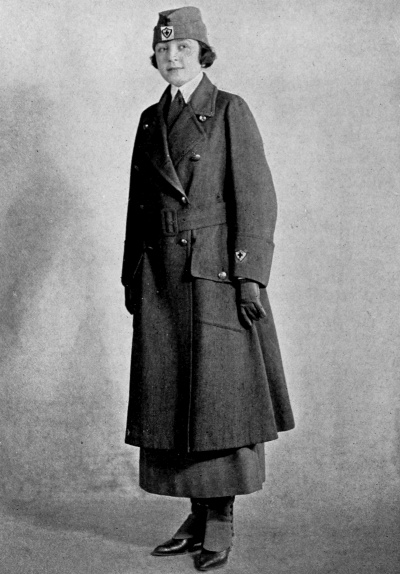
American Red Cross.
Canteen service, outdoor uniform
[Pg 301]
Instructors on active duty in workrooms wear either a red veil or a
white veil with red band; heads of workrooms wear either a blue veil
or a white veil with dark blue band, and all other workers wear a white
veil with white band. They all wear the customary white apron and red crosses.
Motor Service Uniform.—For workers in the Motor Service
the uniform consists of a long gray double-breasted coat of whipcord or
Oxford cloth, with falling collar and notched lapels, an inverted box
pleat in the back, a belt of the same material and flat buttons to
match; a close fitting hat of the same material as the coat with a
small red cross in the front; a short skirt of the same material as the
coat; tan leather leggings and tan leather shoes. The insignia of the
service is worn on the sleeve of the coat between the elbow and the
cuff. It consists of a white square bearing a motor wheel with a red
cross at the center.
Canteen Service Uniform.—The indoor uniform consists of an
apron of the same style as the workroom apron, of horizon blue color,
with a two-inch red cross at the base of the neck; white collar, white
cuffs bearing a special insignia for these workers, and a veil of
horizon blue bearing the same insignia on the front of the head band.
This special insignia for the Canteen Workers is a woven white shield
with a red cross at the center surrounded by the lettering “A.
R. C. Canteen Worker.” The shield on the head band is two and
one-quarter inches in size and that for the cuff one and one-half inches.
For outdoor work in winter the Canteen Service is provided with a gray
[Pg 302]
whipcord overcoat and a close fitting gray cloth cap of the Royal
Flying Corps type, the prescribed insignia being worn on the cuffs of
the coat and on the front of the cap, as shown in the illustration.
In summer a plain dark blue or black sailor hat with the insignia on the
front of the band is worn either with or without the veil.
The special insignia for the Canteen Workers is necessary at all times
in order that the wearers may be quickly recognized by commanders of
troop trains and camp organizations.
Bureau of Information and Clerical Service Uniform.—This
uniform consists of an apron of the same pattern as that for the
workroom uniform of gray material and a gray veil. White collar and
cuffs and the red cross on the apron and veil are worn with this
uniform as shown by the illustration.
Uniforms for Ushers and Others.—Ushers and other active
personnel of the Red Cross, such as those engaged in membership
campaigns, are allowed to wear a white badge on which is a red cross or
they may wear a white sash with a red cross on the front.
Nurses’ Uniforms.—The uniforms for female nurses in the Red
Cross hospitals are similar to those worn by such nurses in the Army
and Navy, but the nurses in the base hospitals and other military
hospitals in France are required to wear uniforms of gray material.
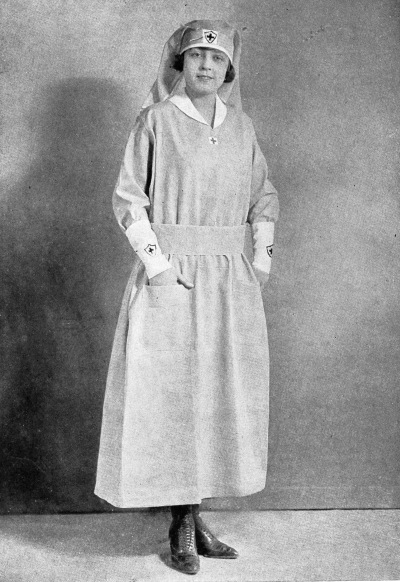
American Red Cross.
Canteen service, indoor uniform
[Pg 303]
CHAPTER XIII
UNIFORMS AND INSIGNIA OF THE WAR WORKERS OF
THE YOUNG MEN’S CHRISTIAN ASSOCIATION
The War Work department of the Young Men’s Christian Association has
established branches at the principal U. S. Army and Navy camps and
stations at home and abroad for the benefit of the enlisted men. At
these stations everything practicable is done for the comfort and
entertainment of the soldiers, sailors and marines who may be in the
vicinity; lectures, music and moving pictures are provided, books,
magazines and papers are furnished and facilities for writing letters
are supplied.
These Y. M. C. A. stations, or “huts” as they are frequently styled,
are conducted by war workers detailed by the Association. In order that
these war workers may be readily recognized at all times by officers
and enlisted men a distinctive uniform has been authorized for them.
This uniform is made of forestry-green cloth and consists of a sack
coat, breeches, tan leather shoes, tan leather leggings, cap or field
hat, flannel shirt, four-in-hand tie, and an overcoat.
The coat is single-breasted, with a rolling collar and notched
lapels, closed down the front by a single row of bronze buttons, shaped
to the figure, the skirt extending to about ten inches below the waist.
[Pg 304]
On each shoulder there is a shoulder strap sewn into the sleeve
shoulder seam and attached at the collar end by a small bronze button.
On each breast there is a patch pocket and on each side below the waist
a patch pocket of the bellows type, each pocket being closed at the top
by a shield shaped flap secured by a small bronze button. Around the
waist is sewn a belt of the same material as the coat. The insignia of
the Y. M. C. A. are worn upon the cuffs.
The breeches are of the same material as the coat and of the same
style as those prescribed for officers of the U. S. Army.
The cap is of the same style and dimensions as that prescribed for
officers of the U. S. Army, and is made of forestry-green cloth with a
black mohair band, and visor and chin strap of black patent leather.
The insignia of the Y. M. C. A. are worn at the center of the front of
the cap.
The field hat is of the U. S. Army regulation pattern and color with
hat cord of red and blue braided strands.
The overcoat is a double-breasted ulster of forestry-green cloth,
with two rows of bronze buttons down the front, buttons to the throat
and has a stand and fall collar of the same style as the U. S. Army
regulation overcoat. On the back at the waist line there are two straps
of the same material as the coat let into the side seams and secured
together by two bronze buttons. On each side below the waist there is
a pocket with a horizontal opening covered by a rectangular flap. The
skirts of the overcoat extend to about ten inches below the knee when
the wearer is standing. The Y. M. C. A. insignia are worn upon the cuffs.
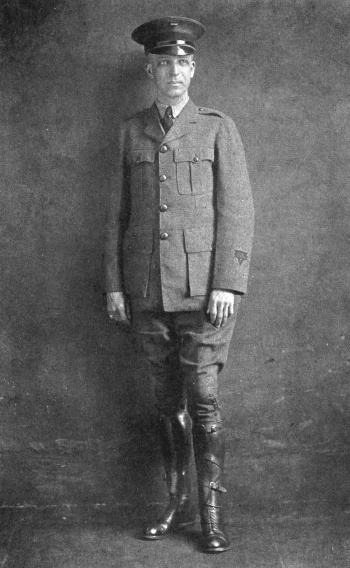
Photo. by Harris & Ewing, Washington, D. C.
Y. M. C. A. War worker in service uniform
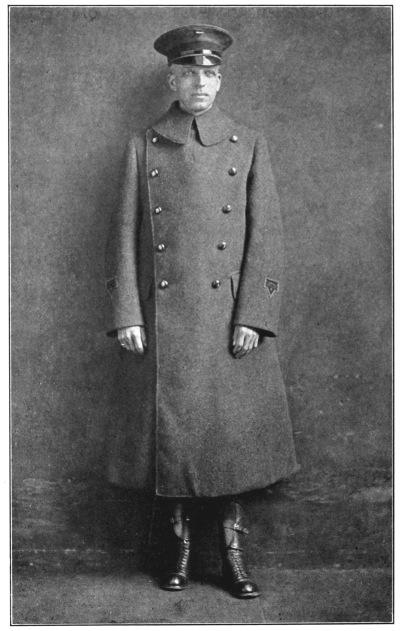
Photo. by Harris & Ewing, Washington, D. C.
Y. M. C. A. War worker in service dress.
Uniform and overcoat
[Pg 305]
The insignia of the Y. M. C. A. war workers consist of a red
equilateral triangle, worn with one of the angles pointing down, and
having horizontally across the center of the triangle a rectangular
strip of blue upon which are the letters “Y. M. C. A.” in red. These
insignia are worn upon the fronts of the caps and upon the outer side
of the cuffs of the coat and overcoat sleeves.
The buttons are of dark bronze and bear the insignia of the Y. M. C. A.
[Pg 306]
CHAPTER XIV
CUSTOMS OF THE SERVICES
The rules which govern official and social intercourse among members
of the military and naval services are based upon the well established
customs which prevail in all walks of life, modified only to such
extent as may be required by the peculiar conditions of the services in
order to secure the greatest degree of efficiency and discipline.
In a military sense discipline may be defined as the cheerful,
unquestioned and implicit obedience to the orders from higher authority
in such manner as to secure systematic action and the cooperation of
all of the component parts of a military force whatever its size may
be. This requires a close acquaintance between officers and men, a
mutual respect and confidence between them, and combined with this the
long hours of drill that tend to make obedience second nature and that
harden all physically and bring the whole machine to that high state of
discipline and training that may be termed “the fighting edge.”
To secure the desired end requires such a degree of mutual respect
among all of the personnel that there will never be the slightest
lack of confidence nor hesitation in complying with an order. To many
civilians the military hand salute appears unnecessary and it has even
been proposed in some quarters to abolish such salutes by enactment of
[Pg 307]
law on the ground that they are not in accord with the spirit of
American institutions. Yet the soldier knows that the salute is but the
outward and visible sign of discipline, that it denotes smartness and
esprit, that it is the patent evidence of alertness and cohesion and
the very antithesis of slouchiness and disaffection.
The regulations of the services are insistent that discipline shall be
enforced with firmness and decision but at the same time with constant
consideration of the rights and feelings of others, whatever their rank
or station may be. Courtesy and politeness are demanded at all times
in the services of the United States and no enforcement of authority
through the “rule of fear” is tolerated.
Strict attention to personal bearing and appearance is an index of
character no less in the military services than in other walks of life,
as the soldier who is not neat and clean when it is possible for him
to be so can rarely be depended upon in a pinch. The best soldiers and
sailors get their “clean shave” every morning when soap and water are
obtainable whether in the security of peace or the stress of wartime.
As one fine soldier expressed it, “We try to live clean, fight clean,
and if need be we’ll die clean.”
Salutes.—On shore salutes are exchanged between officers and between
officers and enlisted men not in military formation, nor at drill,
work, games or mess, on every occasion of their meeting, passing near
or being addressed, the officer who is junior in rank or the enlisted
man always saluting first and the senior always promptly returning the
salute.
Upon the entry of an officer into a room where there are several
enlisted men some one of them who sees him calls “Attention,” whereupon
[Pg 308]
all rise and stand at attention until the officer leaves the room or
orders otherwise. If at meals enlisted men stop eating and remain
seated and quiet. Officers and enlisted men if seated, rise upon the
approach of a senior officer, face toward him and salute, and if
standing they face toward the senior and salute. Soldiers do not stop
work upon the approach of an officer unless addressed by the officer.
Before addressing an officer an enlisted man salutes and also salutes
again after receiving the reply of the officer.
No salutes are rendered by men on guard duty over prisoners if it will
interfere with the execution of their duty.
Officers or enlisted men passing the uncased colors always salute.
No salutes are rendered when troops are marching in double time or at
the trot or gallop when mounted.
When an officer or enlisted man is mounted and has a communication to
make to a senior who is dismounted the junior dismounts before saluting
and delivering his message, except during field maneuvers or campaigns
where time might be lost in doing so.
It should be noted that in all cases both the junior and the senior
salute, but that military courtesy requires the junior to salute first.
No salutes are exchanged between enlisted men but it is customary for
enlisted men to stand at attention when addressed officially by other
enlisted men who are their seniors in rank.
If an enlisted man is in a military formation and is personally
addressed by an officer he does not salute, but if not already standing
at attention he comes to that position at once.
[Pg 309]
The distance within which salutes are rendered, known as “saluting
distance,” is taken to be that within which the uniform and insignia
of an officer is readily distinguishable, normally about thirty paces,
one pace being thirty inches, and salutes are generally exchanged at a
distance of about six feet.
In railway trains, street cars, theaters and public buildings where
salutes would be manifestly inappropriate or where the observance of
the rules regarding saluting would be apt to interfere with civilians
present salutes are usually not rendered.
Officers and enlisted men in civilian clothing exchange salutes in the
same manner as if wearing uniform, but no officer in civilian clothes
is saluted with cannon or has a guard of honor turned out and paraded
in his honor.
The same salutes are given by all officers and enlisted men of the
military and naval forces to officers of foreign armies and navies.
On board ships of the Navy officers and enlisted men while on board
their own ship salute their captain on every occasion of meeting,
passing near or being addressed by him. They salute all officers who
are their senior in rank on the occasion of their first daily meeting
or passing near and upon being addressed by the senior officer, and at
other times during the day they stand at attention instead of saluting.
Officers from other ships are saluted on each occasion of meeting or
passing near.
When in uniform officers and enlisted men should salute ladies with the
military hand salute and the headdress should not be removed for this
purpose when out of doors.
[Pg 310]
The Navy Regulations require that all boats
from men-of-war shall exchange salutes when passing each other in
accordance with the following table, which covers all of the various
conditions likely to arise.
BOAT SALUTES.
| |
Rank or rate of the senior in the saluting boat. |
Rank of the senior officer in the boat to be saluted. |
Flag or general officer (with flag flying). |
Commanding officer above rank of lieutenant (with pennant flying). |
Other commissioned officer. |
Midshipman or warrant officer. |
Flag or general officer. |
Junior salutes with hand. |
|
|
|
Commanding officer above rank of lieutenant (with pennant flying). |
Stops engine, lays on oars, and salutes with hand. |
Junior salutes with hand. |
|
|
Other naval officer below flag rank and above rank of lieutenant,
and marine officers of corresponding rank. |
Stops engine, lays on oars, and salutes with hand. |
When meeting a senior commanding officer, or immediate
commanding officer, stops engine, lays on oars, and salutes with hand. |
Junior salutes with hand. |
|
Other commissioned officers. |
Stops engine, tosses or trails oars, and salutes with hand. |
Stops engine, lays on oars, and salutes with hand. |
Junior salutes with hand. |
|
Midshipman or warrant officer. |
Stops engine, tosses or trails oars, and salutes with hand. |
Stops engine, lays on oars, and salutes with hand. |
Salutes with hand. |
Junior salutes with hand. |
Officer and coxswain in loaded or towing boat or boat under sail. |
Salutes with hand. |
Salutes with hand. |
Junior salutes with hand. |
Junior salutes with hand. |
Coxswain. |
Stops engine, tosses or trails oars, stands, and salutes with hand. |
Stops engine, lays on oars, stands, and salutes with hand. |
Stands and salutes with hand. |
Salutes with hand. |
| |
The starboard gangway ladder is used habitually by officers and their
visitors when going on board of a man-of-war or departing therefrom,
and the port gangway is used by all other persons. In other words the
starboard gangway may be considered the “front door” of a ship. Yet
whenever circumstances render it advisable or necessary an exception
may be made to this rule by the commanding officer’s order.
[Pg 311]
Upon reaching the quarterdeck from a boat, from a gangway or from
the shore, or from any other part of the ship, officers and men face
the colors, stand at attention and salute the colors; and the same
procedure is followed upon leaving the quarterdeck.
After saluting the colors upon arriving on the quarterdeck and just
before saluting the colors upon leaving the quarterdeck, officers and
enlisted men salute the officer of the deck, and the officer of the
deck returns both the salute to the colors and the salute to him.
Officers coming on board usually, after saluting the officer of the
deck, say, “I request permission to come aboard, sir,” and briefly
state their business; and after saluting the officer of the deck upon
leaving the ship they say, “I request permission to leave the ship,
sir.” The same procedure should be followed by civilians visiting a
ship except that no salutes to the officer of the deck are required.
Strict observance of military custom demands that an officer in uniform
and under arms, that is carrying the weapon with which he is armed or
wearing his belt and sword, should not remove his headdress either out
of doors or within doors; but in deference to the universal custom
among civilians it is considered proper for officers in uniform and
wearing their swords sheathed to remove their headdress when entering
a room, especially in case there are ladies present. Under such
circumstances the headdress is carried under the left arm, leaving the
right hand free to shake hands. With the sword drawn and in hand the
headdress should not be removed from the head.
The pedantic observance of so-called military customs is both
[Pg 312]
unnecessary and objectionable, and the safest course is follow the
rules of deportment which distinguish the gentleman the world over.
Following the universal custom the right side is considered the
position of honor and hence when two or more officers are walking or
riding in company the senior walks or rides on the right, and likewise
the senior occupies the seat at the right side in a carriage or other
conveyance.
Visits and Courtesies.—An officer arriving at the headquarters of
a military command calls upon the commander as soon as practicable
and registers his name, address and probable length of stay. If the
visiting officer is senior in rank to the commander he may send his
card and address, in which case it becomes the duty of the commander
to make the first call. When an Army officer arrives at Washington, D.
C., he reports at the office of the Adjutant General of the Army, and
registers his name, local address and business in Washington. Naval
officers under similar circumstances register at the Navy Department
and Marine officers at the Headquarters of the Marine Corps.
After reporting for duty at a station on shore or aboard ship an
officer makes a social call upon the commanding officer who returns
the call promptly. In the case of other officers at the post it is
the custom for all of those already at the station to call upon the
late arrival, thus following the American and not the European custom
in this respect. In addition to the social call upon the commanding
officer the arriving officer also makes a call upon any officer at
the station or on board of the ship who is senior to the commanding
officer, as in the case of a general officer at an Army station or a
flag officer on board of a ship.
[Pg 313]
In the case of the arrival of a ship in a foreign port calls are
interchanged according to well established international rules between
the senior officer of the ship or ships arriving and those already
stationed at the port. The general rule is that if the two officers are
of the same grade the latest arrival makes the first call, but if they
are of different grades the junior makes the first call. The arriving
officer, however, always makes the first call upon the highest civil
official ashore at a foreign port.
Upon the arrival of a United States fleet, squadron or single ship at a
foreign port, the senior naval officer exchanges calls with diplomatic
and consular officers who may be stationed there according to the
following rules:—
A flag officer or commodore pays the first visit to diplomatic officers
of or above the rank of chargé d’affaires and receives the first
visit from consular officers.
A commanding officer pays the first visit to diplomatic officers of
or above the rank of chargé d’affaires and to a consul general and
receives the first visit from all other consular officers.
It will readily be seen that all of these rules and conventions are
devised for the purpose of avoiding friction or misunderstanding and to
secure efficiency and smoothness in the official and social relations
between officers and officials of different services and nationalities.
[Pg 314]
CHAPTER XV
HONORS AND DISTINCTIONS
The honors and distinctions shown to the National Flag, to the
President and other high Government officials, to the National Anthem
and to the officers of the various ranks in the different services
composing the Armed Forces of the United States are prescribed in the
U. S. Army Regulations and the U. S. Navy Regulations, which are issued
by the Secretaries of War and the Navy by authority of the President of
the United States.
At Army Posts and Stations the National Flag is hoisted at sunrise and
lowered at sunset and on board ships of the Navy the National Flag is
hoisted at 8 a. m. and lowered at sunset, these occasions being known
as “Morning Colors” and “Evening Colors.”
While the National Flag is being hoisted and lowered all officers and
enlisted men stand at attention facing the flag, if in uniform and
covered they stand at the salute during the hoisting or lowering of
the flag and if in civilian dress covered, they uncover and hold the
headdress opposite the left shoulder. The latter form of salute is the
correct one for all civilians who desire to so honor the flag of their
country.
When passing the National Flag flown at an Army post or on board a
ship of the Navy, the flag is saluted with the “right hand salute” or
if arms are carried in hand, with the prescribed salute for the arm
[Pg 315]
carried. The same honor is accorded to the flag when it is carried past
by any organization of the military or naval forces. The same honor
is accorded by members of the military and naval forces of the United
States to the flags of other nations under like circumstances.
When a band is present at morning or evening colors the National Anthem
is played during the hoisting and lowering of the colors, and when
ships of the navies of other nations are in the same port the national
anthem of those nations is also played by the bands of ships of the
United States Navy.
The National Anthem of the United States of America is the
composition consisting of the words and music known as “The Star
Spangled Banner,” which was officially designated as such by the
President of the United States on August 23, 1916.
For many years of its existence as a nation the United States of
America had no officially recognized national anthem although various
national songs and airs attained widespread popularity. During the
Revolution “Yankee Doodle” and “The World Turned Upside Down” were
popular military airs and the former still survives to some extent as a
national song.
In 1832 the Reverend Samuel Francis Smith, a Baptist minister of
Boston, wrote the song entitled “My Country, ’Tis of Thee” and it was
set to the music of the British National Anthem, “God Save the King,”
and widely published in prayer books as the American National Hymn.
This has led many people to believe that it was the official National
anthem; however this is not the case, as it never received any official
recognition as such.
During the Civil War, 1861 to 1865, there were a number of airs that
[Pg 316]
reached great popularity among the soldiers and sailors of both sides,
the most stirring of these airs being “The Battle Hymn of the Republic”
in the North and “Dixie” in the South.
The Navy Regulations of 1890 prescribed that “The Star Spangled Banner”
should be played by the bands at morning colors and “Hail, Columbia” at
evening colors, thus giving an official standing to both airs.
In the Navy Regulations of 1893 and the Army Regulations of 1895 “The
Star Spangled Banner” was prescribed for use at colors and came to
be officially recognized as the National Air, but it was not until
the President’s order of August 23, 1916, that it became the official
National Anthem.
By the order of the President the honors shown to the National Anthem
are prescribed in the U. S. Army Regulations as follows:
Whenever the National Anthem is played at any place when persons
belonging to the military services are present, all officers and
enlisted men not in formation shall stand at attention facing toward
the music (except at retreat, when they shall face toward the flag). If
in uniform, covered, they shall salute at the first note of the anthem,
retaining the position of salute until the last note of the anthem. If
not in uniform and covered, they shall uncover at the first note of the
anthem, holding the headdress opposite the left shoulder and so remain
until its close, except that in inclement weather the headdress may be
held slightly raised.
The same rules apply when “To the Color” or “To the Standard” is
sounded as when the National Anthem is played.
When played by an Army band, the National Anthem shall be played
through without repetition of any part not required to be repeated to
make it complete.
The same marks of respect prescribed for observance during the
playing of the National Anthem of the United States shall be shown
toward the National Anthem of any other country when played upon
official occasions.
[Pg 317]
The U. S. Navy Regulations prescribe the same honors whenever the
National Anthem is played on board a vessel of the Navy, at a Naval
Station or at any place where persons belonging to the naval service
are present.
Civilians wishing to pay the proper honor to the National Anthem should
stand at attention whenever present at any place where the National
Anthem is played and if covered they should remove the headdress and
hold it opposite the left shoulder while standing at attention during
the playing of the music.
When the President of the United States visits a Fort or Station of the
United States Army he is received with the command formed in line under
arms, the national colors and regimental standards being carried by the
troops, officers and men saluting with the “Present arms,” the band
playing the National Anthem followed by four ruffles of the drums and
four flourishes of the bugles.
An ex-President and Vice President of the United States are received
with the same honors except that the band plays a march instead of the
National Anthem.
The President of a foreign republic or the sovereign or a member of the
royal family of a foreign country is received with the same honors as
the President of the United States except that the National Anthem of
his country will be played by the band.
Members of the President’s Cabinet, the Chief Justice, the President
pro tempore of the Senate, the Speaker of the House of Representatives,
American and foreign Ambassadors and Governors (within their respective
[Pg 318]
states or territories) are received with the same honors as the Vice
President except that the number of ruffles and flourishes is three.
General Officers of the Army or Marine Corps and Flag Officers of the
Navy are received with the national colors and regimental standards,
officers and men saluting with the “Present arms,” the band playing a
march followed by ruffles and flourishes of the drums and bugles, the
number of ruffles and flourishes depending upon the rank of the officer
being received, as follows:
General or Admiral—four ruffles and flourishes.
Lieutenant General or Vice Admiral—three ruffles and flourishes.
Major General or Rear Admiral—two ruffles and flourishes.
Brigadier General or Commodore—one ruffle and flourish.
In addition to the above honors salutes with cannon are fired upon the
arrival and departure of the President of the United States and the
president or sovereign or a member of the royal family of a foreign
country; and upon the arrival of other officials and military and naval
officers in accordance with their rank as follows:
The President of the United States, or the President or sovereign
or member of the royal family of a foreign country |
21 guns |
An ex-President of the United States or the Vice President |
21 guns |
Ambassadors, members of the Cabinet and the president pro tempore of the Senate |
19 guns |
The Chief Justice, the Speaker of the House of Representatives, a
Committee of Congress, Governors within their respective states or
territories, a Governor General and the Governor of the Philippine Islands |
17 guns
[Pg 319] |
The Assistant Secretary of War, the Assistant Secretary of the Navy,
the Vice-Governor of the Philippine Islands, an Envoy Extraordinary or
Minister Plenipotentiary |
15 guns |
A Minister Resident |
13 guns |
A Charge d’Affaires |
11 guns |
A Consul-General to the United States |
11 guns |
Admiral of the Navy |
19 guns |
General or Admiral |
17 guns |
Lieutenant General or Vice Admiral |
15 guns |
Major General or Rear Admiral |
13 guns |
Brigadier General or Commodore |
11 guns |
Officers of foreign armies and navies are received with the same honors
as those tendered to officers of like rank in our own services.
At every Army post provided with suitable artillery a cannon salute
of twenty-one guns, known as a “National salute,” is fired at noon on
Washington’s Birthday, February 22nd, and on Memorial Day, May 30th,
and on Independence Day, July 4th, a salute of one gun for each state
in the Union is fired.
The honors and ceremonies to be observed when the President of the
United States or the president or sovereign of another country, or a
lesser official entitled to such honor visits a ship of the U. S. Navy
are given in the following table from the U. S. Navy Regulations.
These honors are decided by international custom and are practically
the same in all of the navies of the world and a strict observance
of them is necessary to avoid any occasion for international
misunderstanding that might arise from an omission of any customary
honor or salute.
In addition to the gun salutes described in the above table a National
salute, twenty-one guns, is fired by every ship in the Navy at noon on
Independence Day, July 4th, Washington’s Birthday, February 22nd, and
Memorial Day, May 30th.
[Pg 320]
| |
| Rank |
Uniform |
Salute |
Guns |
Ruffles |
Guard |
Music |
Side
honors |
Flag |
| Arrival |
Departure |
| President |
S.F.D. |
1 |
1 |
21 |
4 |
Full |
National
Anthem. |
Yards or rail mannned and 8 S. boys. |
President’s, at main, during visit.
National, at main, during visit
National, at main during salute. |
President of foreign Republic or a foreign sovereign |
do. |
1 |
1 |
21> |
4 |
do. |
do. |
Member of royal family |
do. |
1 |
1 |
21 |
4 |
do. |
March. |
| Ex-President |
do. |
1 |
1 |
21 |
4 |
do. |
March. |
8 S. boys. |
National, at main, during salute in foreign countries. |
| Vice President |
do. |
|
1 |
19 |
4 |
do. |
do. |
do. |
National, at fore, during salute. |
| Ambassador |
do. |
|
1 |
19 |
4 |
do. |
National
Anthem. |
do. |
Do. |
Secretary of the Navy |
Dress |
1 |
1 |
19 |
4 |
do. |
March. |
do. |
Secretary’s, at main, during visit. |
Assistant Secretary of the Navy |
Dress |
1 |
1 |
17 |
4 |
do. |
do. |
do. |
Asst. Secretary’s, at main, during visit. |
| Cabinet officer |
do. |
|
1 |
19 |
4 |
do. |
do. |
do. |
National, at fore, during salute. |
| Chief Justice |
do. |
|
1 |
17 |
4 |
do. |
do. |
do. |
Do. |
Governor general, United States islands |
do. |
|
1 |
17 |
4 |
do. |
do. |
do. |
Do. |
Governor of State, Territory or U. S. islands |
do. |
|
1 |
17 |
4 |
do. |
do. |
do. |
Do. |
President pro tempore of the Senate |
do. |
|
1 |
19 |
4 |
do. |
do. |
do. |
Do. |
Speaker of the House of Representatives |
do. |
|
1 |
17 |
4 |
do. |
do. |
do. |
Do. |
| Committee of Congress |
do. |
|
1 |
17 |
4 |
do. |
do. |
do. |
Do. |
| Envoy extraordinary |
do. |
|
1 |
15 |
3 |
do. |
do. |
do. |
Do.[Pg 321] |
Minister resident or “diplomatic representative” |
do. |
|
1 |
13 |
2 |
do. |
do. |
6 S. boys. |
Do. |
| Charge d’affaires |
do. |
|
1 |
11 |
1 |
do. |
do. |
do. |
Do. |
| Consul general |
Of the day |
|
1 |
11 |
|
Day |
|
do. |
Do. |
First secretaries of embassies or legations |
do. |
|
|
|
|
|
|
4 S. boys. |
Do. |
| Consul |
do. |
|
1 |
7 |
|
Day |
|
do. |
Do. |
Vice consul or consular agent (where he is the
only representative of the United States) |
do. |
|
1 |
5 |
|
do. |
|
do. |
Do. |
| Admiral of the Navy |
Dress |
|
1 |
19 |
4 |
Full |
March |
8 S. boys. |
In case of foreign officers, national,
at fore, during salute. |
| Admiral |
do. |
|
1 |
17 |
4 |
do. |
do. |
do. |
| General |
| Vice admiral |
do. |
|
1 |
15 |
3 |
do. |
do. |
do. |
| Lieutenant general |
| Rear admiral |
do. |
|
1 |
13 |
2 |
do. |
do. |
6 S. boys. |
Major general (Army or Marine Corps) |
| Commodore |
do. |
|
1 |
11 |
1 |
do. |
do. |
do. |
Brigadier general (Army or Marine Corps) |
Chief of staff, if not a flag or general officer |
Of the
day |
|
|
|
|
Day |
|
4 S. boys. |
| Captain |
If
commanding
officers |
Of the day |
|
|
|
|
Day |
|
4 S. boys. |
| Colonel |
| Commander |
Lieutenant
Colonel |
Lieutenant
commander |
do. |
|
|
|
|
do. |
|
2 S. boys. |
| Major |
All other commissioned officers below
lieutenant commander and major |
do. |
|
|
|
|
|
|
do. |
| |
Abbreviations.
S. F. D.—Special Full dress.
S. boys.—Side boys who stand at either side of
the head of the gangway or ladder by which the official comes aboard of
the ship.
[Pg 322]
When a ship of the Navy is in a port of a foreign country upon the
National holiday of that country a salute of twenty-one guns is fired
at noon on that day.
In accordance with established military courtesy salutes are exchanged
between officers and between officers and enlisted men not in a
military formation, nor at drills, at work, engaged in playing athletic
games or at meals, on every occasion of their meeting or passing or
being addressed by a senior, the officer who is junior in rank or the
enlisted man saluting first, and the officer senior in rank returning
the salute.
When the officer or enlisted man is not bearing arms of any kind in his
hands he salutes with the right hand by bringing the hand smartly up to
the visor of the cap above the right eye, fingers closed, hand, wrist
and forearm straight, palm of the hand to the left and right forearm at
an angle of forty-five degrees, and then dropping the arms to the side.
The distance within which salutes are required is that within which
recognition is easy, usually considered to be about thirty paces
(twenty-five yards).
When troops of the Army, Navy and Marine Corps are reviewed by the
President of the United States or by any official or officer entitled
to review them, they march past the reviewing officer with the bands
playing a suitable march, the colors and standards saluting, officers
and enlisted men rendering the marching salute and the drummers and
buglers sounding the ruffles and flourishes appropriate to the rank of
the reviewing officer.
The salute with the colors and standards is made by drooping them to
the front. The marching salute for officers and enlisted men is made by
[Pg 323]
turning the head and eyes toward the person to be saluted and is known
as “eyes right” or “eyes left,” depending upon whether the position
of the reviewing officer is to the right or left of the column as it
passes in review, officers also salute with the sword by bringing it up
and to the front until the hand grasping the hilt is opposite the chin
and then sweeping the hand and sword down and to the right.
Many of the regiments of the Army have distinctive marches which are
played when passing in review but no distinctive march has ever been
adopted for the Army as a whole.
The march usually played by the bands of the sailor regiments of the
Navy when passing in review is “A Life on the Ocean Wave,” and that
played by the bands of the Marine Corps under the same circumstances is
“Semper Fidelis,” the title of the march being the motto of the Marine Corps.
THE NATIONAL ANTHEM
“THE STAR SPANGLED BANNER”
Written by Francis Scott Key while a prisoner on board the British Ship
Surprise during the bombardment of Fort McHenry near Baltimore during
the War of 1812.
Oh, say, can you see, by the dawn’s early light,
What so proudly we hailed at the twilight’s last gleaming.
Whose broad stripes and bright stars, thro’ the perilous fight,
O’er the ramparts we watched, were so gallantly streaming?
And the rockets’ red glare, the bombs bursting in air,
Gave proof thro’ the night that our flag was still there.
Oh, say, does that star-spangled banner yet wave
O’er the land of the free and the home of the brave?
[Pg 324]
On the shore dimly seen thro’ the mists of the deep,
Where the foe’s haughty host in dread silence reposes.
What is that which the breeze, o’er the towering steep,
As it fitfully blows, half conceals, half discloses?
Now it catches the gleam of the morning’s first beam.
In full glory reflected now shines on the stream;
’Tis the star-spangled banner; oh, long may it wave
O’er the land of the free and the home of the brave!
And where is the band who so vauntingly swore
That the havoc of war and the battle’s confusion
A home and a country should leave us no more?
Their blood has washed out their foul footsteps’ pollution.
No refuge could save the hireling and slave
From the terror of flight or the gloom of the grave:
And the star-spangled banner in triumph doth wave
O’er the land of the free and the home of the brave.
Oh, thus be it ever when freemen shall stand
Between their loved home and wild war’s desolation;
Blest with vict’ry and peace, may the heaven-rescued land
Praise the Power that hath made and preserved us a nation.
Then conquer we must when our cause it is just,
And this be our motto: “In God is our Trust!”
And the star-spangled banner in triumph shall wave
O’er the land of the free and the home of the brave.
THE END
[Pg 325]
INDEX
- Acting Assistant Surgeon, U. S. Public Health Service, insignia of rank, 196
- Address, style of, for officers, 27
- Admiral, U. S. Navy, insignia of rank, 122
- Admirals’ flags:
- Austria-Hungary, 60
- Belgium, 56
- France, 54
- Germany, 60
- Great Britain, 54
- Italy, 56
- Japan, 58
- Russia, 56
- United States, 52
- Aiguilettes, U. S. Navy, 129
- Aircraft distinguishing marks, 62
- American Red Cross, uniforms and insignia, 292
- Appointed officers, definition, 27
- Army of Cuban Occupation Medal, 213
- Cuban Pacification Medal, 213
- Army, U. S., grades of officers and enlisted men, 30
- Assistant Engineer, U. S. Lightship, insignia of rank, 186
- Surgeon General, U. S. Public Health Service, insignia of rank, 195
- Austrian Array, uniforms and insignia, 263
- Navy, uniforms and insignia, 267
- Austrian war medals, 291
- Aviation Corps, insignia, U. S. Navy, 115
- insignia enlisted men, U. S. Navy, 146
- Aviation insignia, U. S. Army, 103, 104
- uniform, U. S. Navy, officers, 115
- Bandsmen’s uniforms, U. S. Navy, 138
- Bathing trunks, U. S. Navy, 137
- Belgian Army, uniforms and insignia, 251
- Belgian war medals, 288
- Belts, full dress, U. S. Army, officers, 78
- Boat cloak, U. S. Navy, officers, 117
- Boatswain, U. S. Coast Guard, insignia, 177
- U. S. Navy, insignia, 124
- “Boxer” Campaign Medal, China, 1900, 212
- Branch marks, U. S. Coast Guard, 180
- U. S. Navy, 142
- Brassards, 105
- Brigadier General, U. S. Army, insignia of rank, 80
- U. S. Marine Corps, insignia of rank, 156, 157
- British Army, uniforms and insignia, 227
- Marines, uniforms and insignia, 225
[Pg 326]
- Navy, uniforms and insignia, 218
- British war medals, 285
- Buttons, U. S. Army, 78, 84, 106
- U. S. Coast Guard, 180
- U. S. Lighthouse Service, 187
- U. S. Marine Corps, 161
- U. S. Navy, 128
- U. S. Public Health Service, 197
- Cadets, West Point, insignia of rank, 86
- organization, 85
- uniforms, 88
- Campaign hat, origin of, 3
- Cap ribbons, U. S. Coast Guard, 181
- U. S. Naval Militia, 144
- U. S. Naval Reserve Force, 144
- U. S. Navy, 135
- Cape, U. S. Army, officers, 77
- U. S. Marine Corps, officers, 155
- U. S. Navy, officers, 117
- Caps, U. S. Coast Guard, officers, 176
- U. S. Marine Corps, officers, 152
- U. S. Navy, officers, 117, 118
- Captain, U. S. Army, insignia of rank, 80, 81
- U. S. Coast Guard, insignia of rank, 173, 175
- U. S. Lighthouse Service, insignia of rank, 183
- U. S. Marine Corps, insignia of rank, 156, 157
- U. S. Navy, insignia of rank, 122
- Captain Commandant, U. S. Coast Guard, insignia of rank, 173, 175
- Carpenter, U. S. Coast Guard, insignia, 177
- U. S. Navy, insignia, 124
- Certificate of Merit Medal, 209
- Civil Engineers, U. S. Navy, corps insignia, 120, 121
- Civil War Campaign Medal, 211
- Chaplain, U. S. Navy, corps insignia, 121
- Chaplain. U. S. Public Health Service, insignia of rank, 196
- Chevrons, origin of, 96
- for wounds, 215
- U. S. Army, 95-100
- U. S. Marine Corps, 164, 165
- U. S. Navy, 139
- War service, 215
- Chief Boatswain, U. S. Navy, insignia, 124
- Carpenter, U. S. Navy, insignia, 124
- Engineer, U. S. Lighthouse Service, insignia, 183
- Gunner, U. S. Navy, insignia, 124
- Machinist, U. S. Navy, insignia, 124
- of Staff, U. S. Army, flag, 60
- Pay Clerk, U. S. Navy, insignia, 124
- Petty Officers’ uniforms, U. S. Navy, 134, 135
- Pharmacist, U. S. Navy, insignia, 124
- Sailmaker, U. S. Navy, insignia, 124
- China Relief Expedition Medal, 213
- Citizens’ Training Camps, 107
- Clerk, U. S. Public Health Service, insignia, 197
- Clerks, Field, U. S. Army, uniforms, 90
- Cloak, U. S. Coast Guard, officers, 177
- U. S. Marine Corps, officers, 155
- U. S. Navy, officers, 117
- Coast and Geodetic Survey, U. S., uniforms, 187
- Coast Guard, U. S., grades of officers and enlisted men, 41
- insignia, 174
[Pg 327]
- Coast Guard, U. S., officers, rank and corps insignia, 173, 177
- organization, 25
- uniforms and insignia, 170
- Cocked hat, origin of, 3
- Cocked hats, U. S. Navy, officers, 117
- Colonel, U. S. Army, insignia of rank, 80
- U. S. Marine Corps, insignia of rank, 156, 157
- Command appropriate to different grades:
- U. S. Army, 44
- U. S. Coast Guard, 51
- U. S. Marine Corps, 49
- U. S. Navy, 46
- Commander, U. S. Navy, insignia of rank, 122
- Commission pennant, 55
- Commissioned officers, definition, 26
- Congressional Medal for Philippine Service, 210
- Conspicuous Gallantry Medal, Great Britain, 287
- Constructors, U. S. Coast Guard, insignia of rank and corps, 173-175
- Corps and rank insignia, U. S. Navy, officers, 118-128
- Corps insignia, U. S. Army, 101-104
- U. S. Army, officers, 81-83
- U. S. Marine Corps, 158
- Corps, service and rank, 17
- Croix de Guerre, France, 285
- Cuban Occupation Medal, 213
- Cuban Pacification Medal, 213
- Customs of the Services, 306
- Decorations and medals, foreign, 284
- Dental officers, U. S. Navy, corps insignia, 121
- Departmental insignia, U. S. Army, officers, 81-83
- U. S. Marine Corps, 158, 159
- Dewey Medal, 207
- Distinguished Service Cross, Great Britain, 286
- Distinguished Service Cross, U. S., 209
- Distinguished Service Medal, Austria, 291
- Distinguished Service Medal, Great Britain, 287
- Distinguished Service Medal, U. S., 209
- Distinguished Service Order, Great Britain, 286
- District superintendent, U. S. Coast Guard, insignia of rank and corps, 173, 175
- Dress uniform, U. S. Army, enlisted men, 96
- U. S. Army, officers, 70
- U. S. Coast Guard, 174
- U. S. Marine Corps, enlisted men, 162
- U. S. Navy, enlisted men, 134, 135
- Dungarees, U. S. Navy, 137
- Engineer officers, U. S. Coast Guard, insignia of rank, 173, 175
- Engineer of Lighthouse Tender insignia of rank, 184
- U. S. Lightship, 186
- Enlisted men’s uniforms and insignia, U. S. Army, 92
- U. S. Coast Guard, 178-181
- U. S. Marine Corps, 162-169
- U. S. Navy, 133-144
- Enlisted men’s uniforms and insignia, U. S. Public Health Service, 198, 199
- Enrolled women, U. S. Naval Reserve Force, 146
- Ensign, U. S. Navy, insignia of rank, 122, 123
- Ensigns, flags and pennants, 53
- Epaulets, U. S. Army, General Officers, 78
- Evening dress uniform, U. S. Army, officers, 76
- U. S. Navy, officers, 113
[Pg 328]
- Facings, U. S. Army, 81, 83
- Fatigue uniform, enlisted men, U. S. Army, 92
- Field Clerks’ brassard, U. S. Engineers, 105
- U. S. Army, uniforms, 90
- Field uniform, U. S. Marine Corps, enlisted men, 162
- U. S. Marine Corps, officers, 153, 154
- Finger prints, U. S. Navy and Marine Corps, 146
- First Assistant Engineer of Lighthouse Tender, insignia of rank, 184
- First Lieutenant, U. S. Army, insignia of rank, 80, 81
- U. S. Coast Guard, insignia of rank, 173, 175
- U. S. Marine Corps, insignia of rank, 156, 157
- First Mate, U. S. Lightship, insignia of rank, 185
- First Officer of Lighthouse Tender, insignia of rank, 184
- Flag officers, definition of, 56
- Flag of the United States, 53
- Flags, ensigns and pennants, 53
- Flagship, 55
- Fleet, composition of, 21
- Foreign Armies and Navies, uniforms and insignia, 216
- Foreign decorations and medals, 284
- French Army, uniforms and insignia, 235
- French Navy, uniforms and insignia, 241
- French war medals, 284
- Full dress uniform, U. S. Army, enlisted men, 95
- U. S. Army, officers, 73
- U. S. Coast Guard, 172
- U. S. Marine Corps, officers, 150
- U. S. Navy, officers, 113
- U. S. Public Health Service, 192
- General, U. S. Army, insignia of rank, 80
- Geneva Cross flag, 62
- German Army, uniforms and insignia, 279
- Marines, uniforms and insignia, 278
- Navy, uniforms and insignia, 272
- German war medals, 290
- Good-Conduct Medal, U. S. Marine Corps, 215
- U. S. Navy, 215
- Guidons, 61
- Gunner, U.S. Coast Guard, insignia, 177
- U. S. Navy, insignia, 124
- Haitian Campaign Medal, 214
- History and origin of uniform, 1
- Honors and distinctions, U. S. Army and Navy, 314
- Hospital flag, 62
- Identification tag, U. S. Army, 106
- U. S. Marine Corps, 169
- U. S. Navy, 145
- Indian Campaign Medal, 212
- Interne, U. S. Public Health Service, insignia of rank, 196
- Insignia of corps and departments, U. S. Army, 101-104
- of rank, U. S. Army, enlisted men, 95-100
- U. S. Army officers, 81, 83
- Insignia of rank, U. S. Army officers, 79, 80, 81
- West Point Cadets, 86
- Iron Cross, the, Germany, 290
- Italian Army, uniforms and insignia, 245
- Navy, uniforms and insignia, 247
- Italian war medals, 288
[Pg 329]
- Japanese Army, uniforms and insignia, 258
- Navy, uniforms and insignia, 261
- Japanese war medals, 289
- Keeper, U. S. Coast Guard, insignia, 177
- Keepers, U. S. Lighthouses, insignia, 186
- Khaki, origin of, 11, 12
- Land forces, U. S., 17
- Leggings, U. S. Army, 93
- U. S. Navy, 143
- Legion of Honor, France, 284
- Lieutenant, U. S. Navy, insignia of rank, 122, 123
- Junior grade, U. S. Navy, insignia of rank, 122, 123
- Lieutenant Colonel, U. S. Army, insignia of rank, 80, 81
- U. S. Marine Corps, insignia of rank, 156, 157
- Lieutenant Commander, U. S. Navy, insignia of rank, 122
- Lieutenant General, U. S. Army, insignia of rank, 80
- Life-Saving Medal, Gold, 210, Silver, 210
- Lighthouse Service, duties of, 25
- U. S., grades of officers and enlisted men, 43
- U. S., uniforms and insignia, 182
- Line officers, U. S. Navy, corps insignia, 120, 121
- Machinist, U. S. Coast Guard, insignia, 177
- U. S. Navy, insignia, 124
- Major General, U. S. Army, insignia of rank, 80
- U. S. Marine Corps, insignia of rank, 156
- Major, U. S. Army, insignia of rank, 80, 81
- Major, U. S. Marine Corps, insignia of rank, 156, 157
- Manila Bay Medal, 207
- Marine Band, uniforms, 167-169
- Marine Corps, U. S. insignia, 158
- U. S. swords, 160
- U. S. uniforms and insignia, 147
- U. S., grades of officers and enlisted men, 40
- U. S., organization and duties, 23
- Marine Gunner, U. S. Marine Corps, insignia of rank, 156, 157
- Master of Lighthouse Tender, insignia of rank, 184
- U. S. Lightship, insignia of rank, 185
- Master’s Mate, U. S. Coast Guard, insignia, 177
- Mate, U. S. Navy, insignia, 125
- Medaille Militaire, France, 284
- Medal commemorating Battle of Manila Bay, 207
- commemorating naval engagements in West Indies during Spanish War, 207
- for Haitian Campaign, 214
- of Honor, U. S. Army, 205
- of Honor, U. S. Navy, 206
- Medals and badges of the U. S. Government, list of, 204
- Medals and decorations, foreign, 284
- Medals, badges and ribbons, U. S. Government, 201
- Medical officers, U. S. Army, corps insignia, 102
- U. S. Navy, corps insignia, 120, 121
- Mess uniform, U. S. Army, officers, 76
- U. S. Marine Corps, officers, 152
[Pg 330]
- Mexican Service Campaign Medal, 214
- Midshipman, U. S. Navy, insignia of rank, 122
- uniform and insignia, 130-133
- Military Cross, Great Britain, 287
- Military Medal, Great Britain, 287
- Military Valor Medal, Italy, 289
- National Anthem of the United States, 285, 293
- Naval Constructors, U. S. Navy, corps insignia, 120, 121
- Militia, flag, 57
- Militia, uniforms of enlisted men, 143, 144
- Reserve, flag, 56
- Reserve uniforms, U. S., 144
- uniforms and insignia, U. S., 108
- Navy, U. S., grades of officers and enlisted men, 31
- Neckerchief, U. S. Navy, 143
- Nicaraguan Campaign Medal, 214
- Noncommissioned officers, definition, 27
- U. S. Army, chevrons, 95-100
- insignia of rank. U. S. Marine Corps, 164, 165
- Nurses’ uniform and insignia, 200
- Olive-drab service uniform, U. S. Army, officers, 68
- U. S. Coast Guard, 178
- Order of Crown of Italy, 289
- Order of Francis Joseph, Austria, 291
- Order of Leopold, Belgium, 288
- Order of Osmanieh, Turkey, 291
- Order of Savoy, Italy, 289
- Order of the Golden Kite, Japan, 290
- Order of the Medjidie, Turkey, 291
- Order of the Rising Sun, Japan, 289
- Origin and history of uniform, 1
- Overcoat, U. S. Army, enlisted men, 95
- U. S. Army, officers, 76
- U. S. Coast Guard, officers, 177
- U. S. Marine Corps, enlisted men, 164, 168
- U. S. Marine Corps, officers, 154
- U. S. Navy, enlisted men, 138
- U. S. Navy, officers, 116
- U. S. Public Health Service, officers, 195
- West Point Cadets, 89
- Pajamas, U. S. Marine Corps, 164
- U. S. Navy, 137
- Passed Assistant Surgeon, U. S. Public Health Service, insignia of rank, 196
- Pay Clerk, U. S. Navy, insignia, 125
- Pay Officers, U. S. Navy, corps insignia, 120, 121
- Pennants, ensigns and flags, 53
- Petty officers, definition, 27
- insignia, U. S. Navy, 139, 142
- Pharmacist, U. S, Navy, insignia, 125
- U. S. Public Health Service, insignia of rank, 196
- Philippine Insurrection Campaign Medal, 212
- Professor, U. S. Public Health Service, insignia of rank, 196
- Professors of Mathematics, U. S. Navy, corps insignia, 120, 121
- Public Health Service, U. S. uniforms and insignia, 188
[Pg 331]
- Quarantine Inspector, U. S. Public Health Service, insignia of rank, 196
- Quartermaster Clerk, U. S. Marine Corps, rank insignia, 156, 157
- Corps, U. S. Army, insignia, 82
- Queen Elizabeth Medal, Belgium, 288
- Rank, corps and service, 17
- Rank insignia, U. S. Army, officers, 79, 80, 81
- U. S. Marine Corps, officers, 155-157
- U. S. Navy, officers, 118-128
- Rank, title and precedence, 26
- Rear Admiral, U. S. Navy, insignia of rank, 122
- Red Cross, American, uniforms and insignia, 292
- Red Cross brassard, 105 flag, 62
- Regimental standards, 58, 59
- Relative rank of officers of U. S. Army, Navy, Marine Corps,
- Coast Guard and Public Health Service, 29
- Reserve officers’ training corps, 107
- Ribbons, cap, U. S. Coast Guard, 181
- U. S. Naval Militia, 144
- U. S. Naval Reserve Force, 144
- U. S. Navy, 135
- Roumanian Army, uniforms, 283
- Russian Army, uniforms and insignia, 254
- Navy, uniforms and insignia, 256
- Saber knot, U. S. Army, officers, 79
- Sailmaker, U. S. Navy, insignia, 125
- Salutes and honors for high officials, 320, 321
- for the National Anthem, 316, 317
- to the flag, 314
- Sampson Medal, 207
- Santiago Medal, 207
- Sashes, General Officers, U. S. Army, 78
- Sea forces, U. S., 20
- Second Assistant Engineer of Lighthouse Tender, insignia of rank, 184
- Second Lieutenant, U. S. Army, insignia of rank, 80, 81
- U. S. Coast Guard, insignia of rank, 173, 175
- U. S. Marine Corps, insignia of rank, 156, 157
- Second Mate, U. S. Lightship, insignia of rank, 186
- Senior Captain, U. S. Coast Guard, insignia of rank, 173, 175
- Senior Surgeon, U. S. Public Health Service, insignia of rank, 196
- Service, corps and rank, 17
- Service stripes. U. S. Army, 105
- U. S. Coast Guard, 180
- Service stripes, U. S. Marine Corps, 166
- U. S. Navy, 143
- Service uniform, U. S. Army, enlisted men, 92
- U. S. Army, officers, 68
- U. S. Coast Guard, 175, 176
- U. S. Navy, officers, 114
- U. S. Public Health Service, officers, 194
- Shipping Board flag, 57
- Shoulder knots, U. S. Army, officers, 78
- Shoulder marks, U. S. Navy, officers, 125-128
- U. S. Coast Guard, officers, 176
- Sleeve braid, U. S. Army, officers, 80, 81
- U. S. Coast Guard, officers, 173
- U. S. Lighthouse Service, officers, 183-186
[Pg 332]
- U. S. Marine Corps, officers, 156
- Sleeve braid, U. S. Navy, officers, 110
- U. S. Public Health Service, officers, 103
- Spanish War Campaign Medal, 212
- Naval Medal, service other than in battle, 208
- Special full dress uniform, U. S. Marine Corps, officers, 148
- U. S. Navy, officers, 113
- Special meritorious Modal, service other than battle, Spanish War, 208
- Specialty marks, U. S. Coast Guard, 170, 180
- U. S. Navy, 130-142
- Surgeon, U. S. Public Health Service, insignia of rank, 196
- Surgeon General, U. S. Public Health Service, insignia of rank, 195
- Sword, U. S. Army, 79
- U. S. Coast Guard, 177
- U. S. Marine Corps, 160
- U. S. Navy, 144
- U. S. Public Health Service, 197
- Sword knot, U. S. Army, 79
- U. S. Coast Guard, 177
- U. S. Marine Corps, 160
- U. S. Navy, 129
- Table of occasions, U. S. Army, enlisted men’s uniforms, 91
- U. S. Army, officers’ uniforms, 65
- U. S. Coast Guard, officers’ uniforms, 171, 172
- U. S. Navy and Marine Corps, enlisted men’s uniforms, 133
- U. S. Navy and Marine Corps, officers’ uniforms, 109-113
- Table of relative rank, U. S. Services, 28
- Third Lieutenant, U. S. Coast Guard, insignia of rank, 173, 175
- Third Officer of Lighthouse Tender, insignia of rank, 184
- Title, definition, 27
- Undress uniforms, U. S. Navy, officers, 114
- U. S. Marine Corps, officers, 151
- Uniforms, origin and history, 1
- Union Jack, U. S., 55
- U. S. Army, enlisted men’s uniforms, occasions for wearing, 91
- grades of officers and enlisted men, 30
- officers’ uniforms, occasions for wearing, 65
- uniforms and insignia, 64
- U. S. Coast and Geodetic Survey, uniforms, 187
- U. S. Coast Guard, grades of officers and enlisted men, 41
- U. S. Coast Guard, officers’ uniforms,
- occasions for wearing, 171, 172
- uniforms and insignia, 170
- U. S. Guards, 107
- U. S. Lighthouse Service, grades of officers and enlisted men, 43
- uniforms and insignia, 182
- U. S. Marine Corps, grades of officers and enlisted men, 40
- uniforms and insignia, 147
- U. S. Navy and Marine Corps, officers’ uniforms, occasions for wearing, 109-113
- U. S. Navy, grades of officers and enlisted men, 31
- uniforms and insignia, 108
- U. S. Public Health Service, grades of officers and enlisted men, 190
- uniforms and insignia, 188
[Pg 333]
- Vice Admiral, U. S. Navy, insignia of rank, 122
- Victoria Cross, British, 286
- War Cross, France, 285
- War Cross, Belgium, 288
- War Cross (Distinguished Service Cross), U. S., 209
- War Medal, Austria, 291
- War service chevrons, 215
- Warrant officers’ uniforms, U. S. Coast Guard, 177, 178
- U. S. Marine Corps, 155
- U. S. Navy, 124
- U. S. Public Health Service, 198
- Watchmen, U. S. Lighthouse Service, insignia, 186
- West Point Cadets, insignia of rank, 86
- organization, 85
- uniforms, 88
- White uniform, U. S. Army, officers, 75
- U. S. Coast Guard, officers, 176
- U. S. Marine Corps, officers, 151
- U. S. Navy, officers, 114
- Winter service uniforms, U. S. Navy, 136
- Women enrolled in U. S. Naval Reserve Force, 146
- Women War Workers, American Red Cross, uniforms, 299
- Wound chevrons, 215
- Working uniform, enlisted men, U. S. Navy, 136
- Young Men’s Christian Association, uniforms for war workers, 303
- Zouave, uniform, 6
Transcriber’s Notes:
The illustrations have been moved so that they do not break up
paragraphs and so that they are next to the text they illustrate.
Typographical errors have been silently corrected.
End of the Project Gutenberg EBook of Army and Navy Uniforms and Insignia, by
Dion Williams
*** END OF THIS PROJECT GUTENBERG EBOOK ARMY AND NAVY UNIFORMS ***
***** This file should be named 62909-h.htm or 62909-h.zip *****
This and all associated files of various formats will be found in:
http://www.gutenberg.org/6/2/9/0/62909/
Produced by deaurider, Paul Marshall and the Online
Distributed Proofreading Team at https://www.pgdp.net (This
file was produced from images generously made available
by The Internet Archive and HathiTrust Digital Library.)
Updated editions will replace the previous one--the old editions will
be renamed.
Creating the works from print editions not protected by U.S. copyright
law means that no one owns a United States copyright in these works,
so the Foundation (and you!) can copy and distribute it in the United
States without permission and without paying copyright
royalties. Special rules, set forth in the General Terms of Use part
of this license, apply to copying and distributing Project
Gutenberg-tm electronic works to protect the PROJECT GUTENBERG-tm
concept and trademark. Project Gutenberg is a registered trademark,
and may not be used if you charge for the eBooks, unless you receive
specific permission. If you do not charge anything for copies of this
eBook, complying with the rules is very easy. You may use this eBook
for nearly any purpose such as creation of derivative works, reports,
performances and research. They may be modified and printed and given
away--you may do practically ANYTHING in the United States with eBooks
not protected by U.S. copyright law. Redistribution is subject to the
trademark license, especially commercial redistribution.
START: FULL LICENSE
THE FULL PROJECT GUTENBERG LICENSE
PLEASE READ THIS BEFORE YOU DISTRIBUTE OR USE THIS WORK
To protect the Project Gutenberg-tm mission of promoting the free
distribution of electronic works, by using or distributing this work
(or any other work associated in any way with the phrase "Project
Gutenberg"), you agree to comply with all the terms of the Full
Project Gutenberg-tm License available with this file or online at
www.gutenberg.org/license.
Section 1. General Terms of Use and Redistributing Project
Gutenberg-tm electronic works
1.A. By reading or using any part of this Project Gutenberg-tm
electronic work, you indicate that you have read, understand, agree to
and accept all the terms of this license and intellectual property
(trademark/copyright) agreement. If you do not agree to abide by all
the terms of this agreement, you must cease using and return or
destroy all copies of Project Gutenberg-tm electronic works in your
possession. If you paid a fee for obtaining a copy of or access to a
Project Gutenberg-tm electronic work and you do not agree to be bound
by the terms of this agreement, you may obtain a refund from the
person or entity to whom you paid the fee as set forth in paragraph
1.E.8.
1.B. "Project Gutenberg" is a registered trademark. It may only be
used on or associated in any way with an electronic work by people who
agree to be bound by the terms of this agreement. There are a few
things that you can do with most Project Gutenberg-tm electronic works
even without complying with the full terms of this agreement. See
paragraph 1.C below. There are a lot of things you can do with Project
Gutenberg-tm electronic works if you follow the terms of this
agreement and help preserve free future access to Project Gutenberg-tm
electronic works. See paragraph 1.E below.
1.C. The Project Gutenberg Literary Archive Foundation ("the
Foundation" or PGLAF), owns a compilation copyright in the collection
of Project Gutenberg-tm electronic works. Nearly all the individual
works in the collection are in the public domain in the United
States. If an individual work is unprotected by copyright law in the
United States and you are located in the United States, we do not
claim a right to prevent you from copying, distributing, performing,
displaying or creating derivative works based on the work as long as
all references to Project Gutenberg are removed. Of course, we hope
that you will support the Project Gutenberg-tm mission of promoting
free access to electronic works by freely sharing Project Gutenberg-tm
works in compliance with the terms of this agreement for keeping the
Project Gutenberg-tm name associated with the work. You can easily
comply with the terms of this agreement by keeping this work in the
same format with its attached full Project Gutenberg-tm License when
you share it without charge with others.
1.D. The copyright laws of the place where you are located also govern
what you can do with this work. Copyright laws in most countries are
in a constant state of change. If you are outside the United States,
check the laws of your country in addition to the terms of this
agreement before downloading, copying, displaying, performing,
distributing or creating derivative works based on this work or any
other Project Gutenberg-tm work. The Foundation makes no
representations concerning the copyright status of any work in any
country outside the United States.
1.E. Unless you have removed all references to Project Gutenberg:
1.E.1. The following sentence, with active links to, or other
immediate access to, the full Project Gutenberg-tm License must appear
prominently whenever any copy of a Project Gutenberg-tm work (any work
on which the phrase "Project Gutenberg" appears, or with which the
phrase "Project Gutenberg" is associated) is accessed, displayed,
performed, viewed, copied or distributed:
This eBook is for the use of anyone anywhere in the United States and
most other parts of the world at no cost and with almost no
restrictions whatsoever. You may copy it, give it away or re-use it
under the terms of the Project Gutenberg License included with this
eBook or online at www.gutenberg.org. If you are not located in the
United States, you'll have to check the laws of the country where you
are located before using this ebook.
1.E.2. If an individual Project Gutenberg-tm electronic work is
derived from texts not protected by U.S. copyright law (does not
contain a notice indicating that it is posted with permission of the
copyright holder), the work can be copied and distributed to anyone in
the United States without paying any fees or charges. If you are
redistributing or providing access to a work with the phrase "Project
Gutenberg" associated with or appearing on the work, you must comply
either with the requirements of paragraphs 1.E.1 through 1.E.7 or
obtain permission for the use of the work and the Project Gutenberg-tm
trademark as set forth in paragraphs 1.E.8 or 1.E.9.
1.E.3. If an individual Project Gutenberg-tm electronic work is posted
with the permission of the copyright holder, your use and distribution
must comply with both paragraphs 1.E.1 through 1.E.7 and any
additional terms imposed by the copyright holder. Additional terms
will be linked to the Project Gutenberg-tm License for all works
posted with the permission of the copyright holder found at the
beginning of this work.
1.E.4. Do not unlink or detach or remove the full Project Gutenberg-tm
License terms from this work, or any files containing a part of this
work or any other work associated with Project Gutenberg-tm.
1.E.5. Do not copy, display, perform, distribute or redistribute this
electronic work, or any part of this electronic work, without
prominently displaying the sentence set forth in paragraph 1.E.1 with
active links or immediate access to the full terms of the Project
Gutenberg-tm License.
1.E.6. You may convert to and distribute this work in any binary,
compressed, marked up, nonproprietary or proprietary form, including
any word processing or hypertext form. However, if you provide access
to or distribute copies of a Project Gutenberg-tm work in a format
other than "Plain Vanilla ASCII" or other format used in the official
version posted on the official Project Gutenberg-tm web site
(www.gutenberg.org), you must, at no additional cost, fee or expense
to the user, provide a copy, a means of exporting a copy, or a means
of obtaining a copy upon request, of the work in its original "Plain
Vanilla ASCII" or other form. Any alternate format must include the
full Project Gutenberg-tm License as specified in paragraph 1.E.1.
1.E.7. Do not charge a fee for access to, viewing, displaying,
performing, copying or distributing any Project Gutenberg-tm works
unless you comply with paragraph 1.E.8 or 1.E.9.
1.E.8. You may charge a reasonable fee for copies of or providing
access to or distributing Project Gutenberg-tm electronic works
provided that
* You pay a royalty fee of 20% of the gross profits you derive from
the use of Project Gutenberg-tm works calculated using the method
you already use to calculate your applicable taxes. The fee is owed
to the owner of the Project Gutenberg-tm trademark, but he has
agreed to donate royalties under this paragraph to the Project
Gutenberg Literary Archive Foundation. Royalty payments must be paid
within 60 days following each date on which you prepare (or are
legally required to prepare) your periodic tax returns. Royalty
payments should be clearly marked as such and sent to the Project
Gutenberg Literary Archive Foundation at the address specified in
Section 4, "Information about donations to the Project Gutenberg
Literary Archive Foundation."
* You provide a full refund of any money paid by a user who notifies
you in writing (or by e-mail) within 30 days of receipt that s/he
does not agree to the terms of the full Project Gutenberg-tm
License. You must require such a user to return or destroy all
copies of the works possessed in a physical medium and discontinue
all use of and all access to other copies of Project Gutenberg-tm
works.
* You provide, in accordance with paragraph 1.F.3, a full refund of
any money paid for a work or a replacement copy, if a defect in the
electronic work is discovered and reported to you within 90 days of
receipt of the work.
* You comply with all other terms of this agreement for free
distribution of Project Gutenberg-tm works.
1.E.9. If you wish to charge a fee or distribute a Project
Gutenberg-tm electronic work or group of works on different terms than
are set forth in this agreement, you must obtain permission in writing
from both the Project Gutenberg Literary Archive Foundation and The
Project Gutenberg Trademark LLC, the owner of the Project Gutenberg-tm
trademark. Contact the Foundation as set forth in Section 3 below.
1.F.
1.F.1. Project Gutenberg volunteers and employees expend considerable
effort to identify, do copyright research on, transcribe and proofread
works not protected by U.S. copyright law in creating the Project
Gutenberg-tm collection. Despite these efforts, Project Gutenberg-tm
electronic works, and the medium on which they may be stored, may
contain "Defects," such as, but not limited to, incomplete, inaccurate
or corrupt data, transcription errors, a copyright or other
intellectual property infringement, a defective or damaged disk or
other medium, a computer virus, or computer codes that damage or
cannot be read by your equipment.
1.F.2. LIMITED WARRANTY, DISCLAIMER OF DAMAGES - Except for the "Right
of Replacement or Refund" described in paragraph 1.F.3, the Project
Gutenberg Literary Archive Foundation, the owner of the Project
Gutenberg-tm trademark, and any other party distributing a Project
Gutenberg-tm electronic work under this agreement, disclaim all
liability to you for damages, costs and expenses, including legal
fees. YOU AGREE THAT YOU HAVE NO REMEDIES FOR NEGLIGENCE, STRICT
LIABILITY, BREACH OF WARRANTY OR BREACH OF CONTRACT EXCEPT THOSE
PROVIDED IN PARAGRAPH 1.F.3. YOU AGREE THAT THE FOUNDATION, THE
TRADEMARK OWNER, AND ANY DISTRIBUTOR UNDER THIS AGREEMENT WILL NOT BE
LIABLE TO YOU FOR ACTUAL, DIRECT, INDIRECT, CONSEQUENTIAL, PUNITIVE OR
INCIDENTAL DAMAGES EVEN IF YOU GIVE NOTICE OF THE POSSIBILITY OF SUCH
DAMAGE.
1.F.3. LIMITED RIGHT OF REPLACEMENT OR REFUND - If you discover a
defect in this electronic work within 90 days of receiving it, you can
receive a refund of the money (if any) you paid for it by sending a
written explanation to the person you received the work from. If you
received the work on a physical medium, you must return the medium
with your written explanation. The person or entity that provided you
with the defective work may elect to provide a replacement copy in
lieu of a refund. If you received the work electronically, the person
or entity providing it to you may choose to give you a second
opportunity to receive the work electronically in lieu of a refund. If
the second copy is also defective, you may demand a refund in writing
without further opportunities to fix the problem.
1.F.4. Except for the limited right of replacement or refund set forth
in paragraph 1.F.3, this work is provided to you 'AS-IS', WITH NO
OTHER WARRANTIES OF ANY KIND, EXPRESS OR IMPLIED, INCLUDING BUT NOT
LIMITED TO WARRANTIES OF MERCHANTABILITY OR FITNESS FOR ANY PURPOSE.
1.F.5. Some states do not allow disclaimers of certain implied
warranties or the exclusion or limitation of certain types of
damages. If any disclaimer or limitation set forth in this agreement
violates the law of the state applicable to this agreement, the
agreement shall be interpreted to make the maximum disclaimer or
limitation permitted by the applicable state law. The invalidity or
unenforceability of any provision of this agreement shall not void the
remaining provisions.
1.F.6. INDEMNITY - You agree to indemnify and hold the Foundation, the
trademark owner, any agent or employee of the Foundation, anyone
providing copies of Project Gutenberg-tm electronic works in
accordance with this agreement, and any volunteers associated with the
production, promotion and distribution of Project Gutenberg-tm
electronic works, harmless from all liability, costs and expenses,
including legal fees, that arise directly or indirectly from any of
the following which you do or cause to occur: (a) distribution of this
or any Project Gutenberg-tm work, (b) alteration, modification, or
additions or deletions to any Project Gutenberg-tm work, and (c) any
Defect you cause.
Section 2. Information about the Mission of Project Gutenberg-tm
Project Gutenberg-tm is synonymous with the free distribution of
electronic works in formats readable by the widest variety of
computers including obsolete, old, middle-aged and new computers. It
exists because of the efforts of hundreds of volunteers and donations
from people in all walks of life.
Volunteers and financial support to provide volunteers with the
assistance they need are critical to reaching Project Gutenberg-tm's
goals and ensuring that the Project Gutenberg-tm collection will
remain freely available for generations to come. In 2001, the Project
Gutenberg Literary Archive Foundation was created to provide a secure
and permanent future for Project Gutenberg-tm and future
generations. To learn more about the Project Gutenberg Literary
Archive Foundation and how your efforts and donations can help, see
Sections 3 and 4 and the Foundation information page at
www.gutenberg.org Section 3. Information about the Project Gutenberg
Literary Archive Foundation
The Project Gutenberg Literary Archive Foundation is a non profit
501(c)(3) educational corporation organized under the laws of the
state of Mississippi and granted tax exempt status by the Internal
Revenue Service. The Foundation's EIN or federal tax identification
number is 64-6221541. Contributions to the Project Gutenberg Literary
Archive Foundation are tax deductible to the full extent permitted by
U.S. federal laws and your state's laws.
The Foundation's principal office is in Fairbanks, Alaska, with the
mailing address: PO Box 750175, Fairbanks, AK 99775, but its
volunteers and employees are scattered throughout numerous
locations. Its business office is located at 809 North 1500 West, Salt
Lake City, UT 84116, (801) 596-1887. Email contact links and up to
date contact information can be found at the Foundation's web site and
official page at www.gutenberg.org/contact
For additional contact information:
Dr. Gregory B. Newby
Chief Executive and Director
gbnewby@pglaf.org
Section 4. Information about Donations to the Project Gutenberg
Literary Archive Foundation
Project Gutenberg-tm depends upon and cannot survive without wide
spread public support and donations to carry out its mission of
increasing the number of public domain and licensed works that can be
freely distributed in machine readable form accessible by the widest
array of equipment including outdated equipment. Many small donations
($1 to $5,000) are particularly important to maintaining tax exempt
status with the IRS.
The Foundation is committed to complying with the laws regulating
charities and charitable donations in all 50 states of the United
States. Compliance requirements are not uniform and it takes a
considerable effort, much paperwork and many fees to meet and keep up
with these requirements. We do not solicit donations in locations
where we have not received written confirmation of compliance. To SEND
DONATIONS or determine the status of compliance for any particular
state visit www.gutenberg.org/donate
While we cannot and do not solicit contributions from states where we
have not met the solicitation requirements, we know of no prohibition
against accepting unsolicited donations from donors in such states who
approach us with offers to donate.
International donations are gratefully accepted, but we cannot make
any statements concerning tax treatment of donations received from
outside the United States. U.S. laws alone swamp our small staff.
Please check the Project Gutenberg Web pages for current donation
methods and addresses. Donations are accepted in a number of other
ways including checks, online payments and credit card donations. To
donate, please visit: www.gutenberg.org/donate
Section 5. General Information About Project Gutenberg-tm electronic works.
Professor Michael S. Hart was the originator of the Project
Gutenberg-tm concept of a library of electronic works that could be
freely shared with anyone. For forty years, he produced and
distributed Project Gutenberg-tm eBooks with only a loose network of
volunteer support.
Project Gutenberg-tm eBooks are often created from several printed
editions, all of which are confirmed as not protected by copyright in
the U.S. unless a copyright notice is included. Thus, we do not
necessarily keep eBooks in compliance with any particular paper
edition.
Most people start at our Web site which has the main PG search
facility: www.gutenberg.org
This Web site includes information about Project Gutenberg-tm,
including how to make donations to the Project Gutenberg Literary
Archive Foundation, how to help produce our new eBooks, and how to
subscribe to our email newsletter to hear about new eBooks.

